D Link SR500NA1 SMB Wireless N Gigabit VPN Router User Manual DLink DSR User Manual
D Link Corporation SMB Wireless N Gigabit VPN Router DLink DSR User Manual
D Link >
User Manual
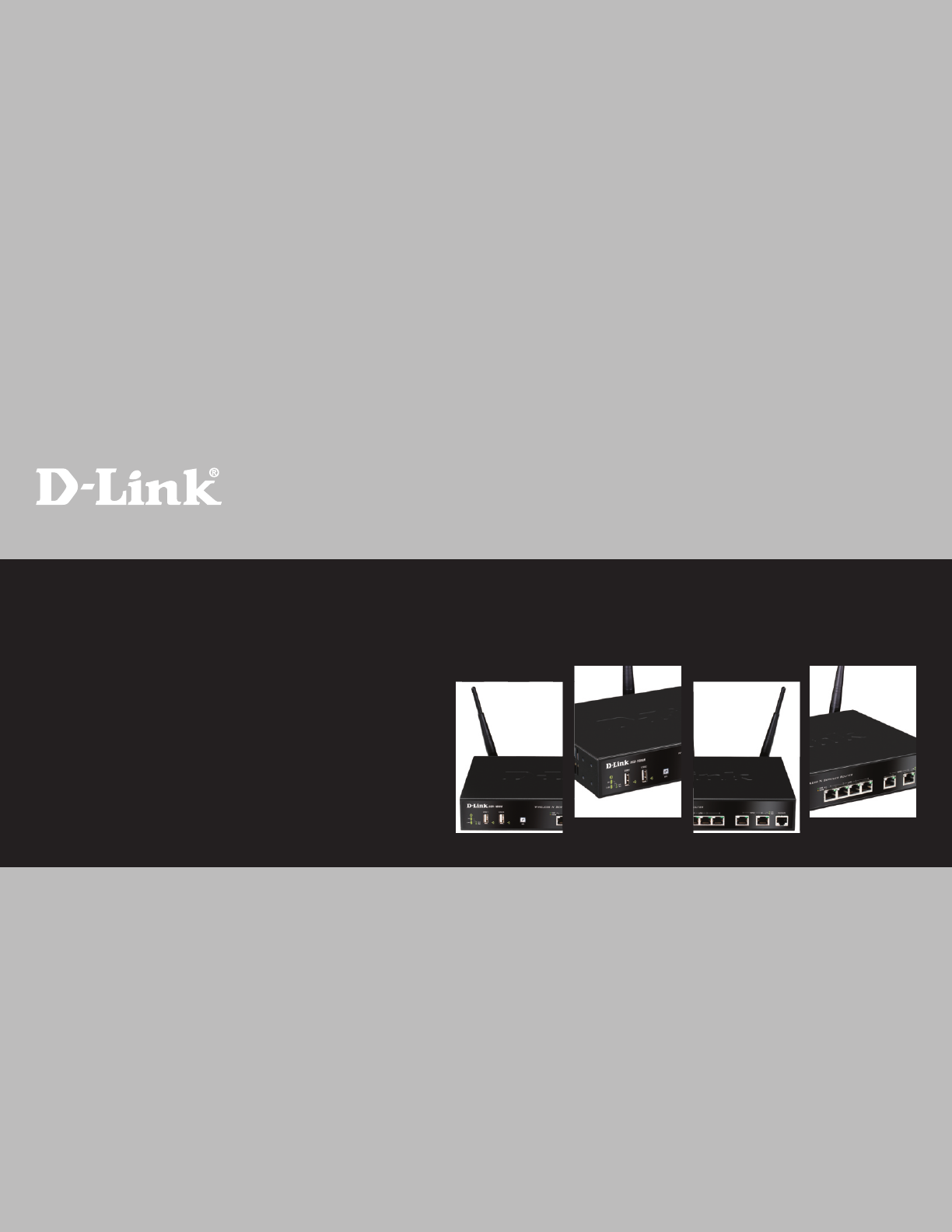
Unified Services Router
User Manual
DSR-500N/1000N
Release 1.01
http://www.dlink.com
Building Networks for People

User Manual
Unified Services Router
D-Link Corporation
Copyright © 2010.
http://www.dlink.com

Unified Services Router User Manual
1
User Manual
DSR-500N/1000N
Unified Services Router
Version 1.0
Copyright © 2010
Copyright Notice
This publication, including all photographs, illustrations and software, is protected under
international copyright laws, with all rights reserved. Neither this manual, nor any of the
material contained herein, may be reproduced without written consent of the author.
Disclaimer
The information in this document is subject to change without notice. The manufacturer makes
no representations or warranties with respect to the contents hereof and specifically disclaim
any implied warranties of merchantability or fitness for any particular purpose. The
manufacturer reserves the right to revise this publication and to make changes from time to
time in the content hereof without obligation of the manufacturer to notify any person of such
revision or changes.
Limitations of Liability
UNDER NO CIRCUMSTANCES SHALL D-LINK OR ITS SUPPLIERS BE LIABLE FOR
DAMAGES OF ANY CHARACTER (E.G. DAMAGES FOR LOSS OF PROFIT, SOFTWARE
RESTORATION, WORK STOPPAGE, LOSS OF SAVED DATA OR ANY OTHER
COMMERCIAL DAMAGES OR LOSSES) RESULTING FROM THE APPLICATION OR
IMPROPER USE OF THE D-LINK PRODUCT OR FAILURE OF THE PRODUCT, EVEN IF
D-LINK IS INFORMED OF THE POSSIBILITY OF SUCH DAMAGES. FURTHERMORE, D-
LINK WILL NOT BE LIABLE FOR THIRD-PARTY CLAIMS AGAINST CUSTOMER FOR
LOSSES OR DAMAGES. D-LINK WILL IN NO EVENT BE LIABLE FOR ANY DAMAGES
IN EXCESS OF THE AMOUNT D-LINK RECEIVED FROM THE END-USER FOR THE
PRODUCT.

Unified Services Router User Manual
2
Table of Contents
Chapter 1. Introduction ............................................................................................................................. 8
1.1 About this User Manual ............................................................................................ 8
1.2 Typographical Conventions ..................................................................................... 8
Chapter 2. Configuring Your Network: LAN Setup ............................................................................... 9
2.1 LAN Configuration ..................................................................................................... 9
2.1.1 LAN Configuration in an IPv6 Network ................................................................ 11
2.1.2 Configuring IPv6 Router Advertisements ............................................................ 14
2.2 VLAN Configuration ................................................................................................ 17
2.2.1 Associating VLANs to ports ................................................................................... 18
2.3 Configurable Port: DMZ Setup .............................................................................. 20
2.4 Universal Plug and Play (UPnP) ........................................................................... 21
Chapter 3. Connecting to the Internet: WAN Setup ........................................................................... 23
3.1 Internet Setup Wizard ............................................................................................. 23
3.2 WAN Configuration ................................................................................................. 24
3.2.1 WAN Port IP address ............................................................................................. 25
3.2.2 WAN DNS Servers ................................................................................................. 25
3.2.3 DHCP WAN ............................................................................................................. 25
3.2.4 PPPoE Profiles ........................................................................................................ 27
3.2.5 WAN Configuration in an IPv6 Network ............................................................... 28
3.2.6 Checking WAN Status ............................................................................................ 29
3.3 Bandwidth Controls ................................................................................................. 32
3.4 Features with Multiple WAN Links ........................................................................ 34
3.4.1 Auto Failover ............................................................................................................ 34
3.4.2 Load Balancing ........................................................................................................ 35
3.4.3 Protocol Bindings .................................................................................................... 36
3.5 Routing Configuration ............................................................................................. 37
3.5.1 Routing Mode .......................................................................................................... 37
3.5.2 Dynamic Routing (RIP) .......................................................................................... 39
3.5.3 Static Routing .......................................................................................................... 40
3.6 Configurable Port - WAN Option .......................................................................... 42
3.7 WAN Port Settings .................................................................................................. 44
Chapter 4. Wireless Access Point Setup ............................................................................................. 46
4.1 Wireless Settings Wizard ....................................................................................... 46
4.1.1 Wireless Network Setup Wizard ........................................................................... 47
4.1.2 Add Wireless Device with WPS ............................................................................ 47
4.1.3 Manual Wireless Network Setup .......................................................................... 48
4.2 Wireless Profiles ..................................................................................................... 48
4.2.1 WEP Security .......................................................................................................... 49
4.2.2 WPA or WPA2 with PSK ........................................................................................ 50
4.2.3 RADIUS Authentication .......................................................................................... 51
4.3 Creating and Using Access Points ....................................................................... 52
4.3.1 Primary benefits of Virtual APs: ............................................................................ 54
4.4 Tuning Radio Specific Settings ............................................................................. 55
4.5 Advanced Wireless Settings .................................................................................. 56

Unified Services Router User Manual
3
4.6 Wi-Fi Protected Setup (WPS) ............................................................................... 56
Chapter 5. Securing the Private Network ............................................................................................ 59
5.1 Firewall Rules .......................................................................................................... 59
5.2 Defining Rule Schedules ....................................................................................... 60
5.3 Configuring Firewall Rules ..................................................................................... 61
5.3.1 Firewall Rule Configuration Examples ................................................................. 65
5.4 Security on Custom Services ................................................................................ 68
5.5 ALG support ............................................................................................................. 69
5.6 VPN Passthrough for Firewall ............................................................................... 70
5.7 Application Rules .................................................................................................... 71
5.8 Web Content Filtering ............................................................................................. 72
5.9 IP/MAC Binding ....................................................................................................... 75
5.10 Intrusion Prevention (IPS)...................................................................................... 76
5.10.1 Protecting from Internet Attacks ........................................................................... 77
Chapter 6. IPSec / PPTP / L2TP VPN ................................................................................................. 79
6.1 VPN Wizard ............................................................................................................. 79
6.2 Configuring IPSec Policies .................................................................................... 82
6.2.1 Extended Authentication (XAUTH) ....................................................................... 85
6.3 Configuring VPN clients ......................................................................................... 85
6.4 PPTP / L2TP Tunnels ............................................................................................. 86
6.4.1 PPTP Tunnel Support ............................................................................................ 86
6.4.2 L2TP Tunnel Support ............................................................................................. 87
Chapter 7. SSL VPN ............................................................................................................................... 89
7.1 Users, Groups, and Domains ................................................................................ 89
7.1.1 User Types and Passwords .................................................................................. 90
7.2 Using SSL VPN Policies ........................................................................................ 92
7.2.1 Using Network Resources ..................................................................................... 94
7.3 Application Port Forwarding .................................................................................. 95
7.4 SSL VPN Client Configuration .............................................................................. 96
7.5 User Portal ............................................................................................................... 98
7.5.1 Creating Portal Layouts ......................................................................................... 99
Chapter 8. Advanced Configuration Tools ......................................................................................... 101
8.1 USB Device Setup ................................................................................................ 101
8.2 Authentication Certificates ................................................................................... 101
Chapter 9. Administration & Management ......................................................................................... 103
9.1 Configuration Access Control .............................................................................. 103
9.1.1 Remote Management ........................................................................................... 103
9.1.2 CLI Access ............................................................................................................. 104
9.2 SNMP Configuration ............................................................................................. 104
9.3 Configuring Time Zone and NTP ........................................................................ 106
9.4 Log Configuration .................................................................................................. 107
9.4.1 Defining What to Log ............................................................................................ 107

Unified Services Router User Manual
4
9.4.2 Sending Logs to E-mail or Syslog ...................................................................... 111
9.4.3 Event Log Viewer in GUI ..................................................................................... 113
9.5 Backing up and Restoring Configuration Settings ........................................... 114
9.6 Upgrading Router Firmware ................................................................................ 115
9.7 Dynamic DNS Setup ............................................................................................. 116
9.8 Using Diagnostic Tools ........................................................................................ 117
9.8.1 Ping ......................................................................................................................... 118
9.8.2 Trace Route ........................................................................................................... 118
9.8.3 DNS Lookup .......................................................................................................... 119
9.8.4 Router Options ...................................................................................................... 119
Chapter 10. Router Status and Statistics ............................................................................................. 120
10.1 System Overview .................................................................................................. 120
10.1.1 Device Status ........................................................................................................ 120
10.1.2 Resource Utilization .............................................................................................. 122
10.2 Traffic Statistics ..................................................................................................... 126
10.2.1 Wired Port Statistics ............................................................................................. 126
10.2.2 Wireless Statistics ................................................................................................. 127
10.3 Active Connections ............................................................................................... 128
10.3.1 Sessions through the Router ............................................................................... 128
10.3.2 Wireless Clients..................................................................................................... 130
10.3.3 LAN Clients ............................................................................................................ 130
10.3.4 Active VPN Tunnels .............................................................................................. 131
Chapter 11. Trouble Shooting ................................................................................................................ 133
11.1 Internet connection ............................................................................................... 133
11.2 Date and time ........................................................................................................ 135
11.3 Pinging to Test LAN Connectivity ....................................................................... 135
11.3.1 Testing the LAN path from your PC to your router .......................................... 135
11.3.2 Testing the LAN path from your PC to a remote device ................................. 136
11.4 Restoring factory-default configuration settings ............................................... 137
Chapter 12. Credits ................................................................................................................................. 139
Appendix A. Glossary .............................................................................................................................. 140
Appendix B. Factory Default Settings ................................................................................................... 143
Appendix C. Standard Services Available for Port Forwarding & Firewall Configuration .............. 144
Appendix D. Log Output Reference ....................................................................................................... 145

Unified Services Router User Manual
5
List of Figures
Figure 1: Setup page for LAN TCP/IP settings ...................................................................................... 11
Figure 2: IPv6 LAN and DHCPv6 configuration ..................................................................................... 13
Figure 3: Configuring the Router Advertisement Daemon ................................................................... 16
Figure 4: IPv6 Advertisement Prefix settings ......................................................................................... 17
Figure 5: Adding VLAN memberships to the LAN ................................................................................. 18
Figure 6: Port VLAN list ............................................................................................................................. 19
Figure 7: Configuring VLAN membership for a port .............................................................................. 20
Figure 8: DMZ configuration ..................................................................................................................... 21
Figure 9: UPnP Configuration ................................................................................................................... 22
Figure 10: Internet Connection Setup Wizard ........................................................................................ 23
Figure 11: Manual WAN configuration .................................................................................................... 26
Figure 12: List of configured PPPoE profiles .......................................................................................... 27
Figure 13: PPPoE profile configuration ................................................................................................... 28
Figure 14: IPv6 WAN Setup page ............................................................................................................ 29
Figure 15: Connection Status information for both WAN ports ............................................................ 31
Figure 16: List of Configured Bandwidth Profiles ................................................................................... 32
Figure 17: Bandwidth Profile Configuration page .................................................................................. 33
Figure 18: Traffic Selector Configuration ................................................................................................ 34
Figure 19: Load Balancing is available when multiple WAN ports are configured and Protocol
Bindings have been defined ................................................................................................... 36
Figure 20: Protocol binding setup to associate a service and/or LAN source to a WAN and/or
destination network .................................................................................................................. 37
Figure 21: Routing Mode is used to configure traffic routing between WAN and LAN, as well as
Dynamic routing (RIP) ............................................................................................................. 39
Figure 22: Static route configuration fields ............................................................................................. 42
Figure 23: WAN2 configuration for 3G internet (part 1) ........................................................................ 43
Figure 24: WAN2 configuration for 3G internet (part 2) ........................................................................ 44
Figure 25: Physical WAN port settings .................................................................................................... 45
Figure 26: Wireless Network Setup Wizards .......................................................................................... 47
Figure 27: List of Available Profiles shows the variety of options available to secure the wireless
link .............................................................................................................................................. 49
Figure 28: Profile configuration to set network security ........................................................................ 50
Figure 29: RADIUS server (External Authentication) configuration .................................................... 52
Figure 30: Virtual AP configuration .......................................................................................................... 53
Figure 31: List of configured access points (Virtual APs) shows one enabled access point on the
radio, broadcasting its SSID ................................................................................................... 54

Unified Services Router User Manual
6
Figure 32: Radio card configuration options ........................................................................................... 55
Figure 33: Advanced Wireless communication settings ....................................................................... 56
Figure 34: WPS configuration for an AP with WPA/WPA2 profile ....................................................... 57
Figure 35: List of Available Firewall Rules .............................................................................................. 60
Figure 36: List of Available Schedules to bind to a firewall rule .......................................................... 61
Figure 37: The firewall rule configuration page allows you to define the To/From zone, service,
action, schedules, and specify source/destination IP addresses as needed. ................. 64
Figure 38: Schedule configuration for the above example. .................................................................. 67
Figure 39: List of user defined services. ................................................................................................. 69
Figure 40: Available ALG support on the router..................................................................................... 70
Figure 41: Passthrough options for VPN tunnels ................................................................................... 71
Figure 42: List of Available Application Rules showing 4 unique rules .............................................. 72
Figure 43: Content Filtering used to block access to proxy servers and prevent ActiveX controls
from being downloaded ........................................................................................................... 73
Figure 44: Two trusted domains added to the Approved URLs List ................................................... 74
Figure 45: Two keywords added to the block list ................................................................................... 75
Figure 46: The above example of IP/MAC Binding binds a LAN host’s MAC Address to an IP
address. If there is an IP/MAC Binding violation, the violating packet will be dropped
and logs will be captured ........................................................................................................ 76
Figure 47: Intrusion Prevention features on the router ......................................................................... 77
Figure 48: Protecting the router and LAN from internet attacks .......................................................... 78
Figure 49: VPN Wizard launch screen .................................................................................................... 80
Figure 50: IPSec policy configuration ...................................................................................................... 83
Figure 51: IPSec policy configuration continued (Auto policy via IKE) ............................................... 84
Figure 52: IPSec policy configuration continued (Auto / Manual Phase 2) ........................................ 85
Figure 53: PPTP tunnel configuration – PPTP Server .......................................................................... 87
Figure 54: L2TP tunnel configuration – L2TP Server ............................................................................ 87
Figure 55: Available Users with login status and associated Group/Domain .................................... 90
Figure 56: User configuration options ...................................................................................................... 92
Figure 57: List of SSL VPN polices (Global filter) .................................................................................. 93
Figure 58: SSL VPN policy configuration ................................................................................................ 94
Figure 59: List of configured resources, which are available to assign to SSL VPN policies ......... 95
Figure 60: List of Available Applications for SSL Port Forwarding ...................................................... 96
Figure 61: SSL VPN client adapter and access configuration ............................................................. 97
Figure 62: Configured client routes only apply in split tunnel mode.................................................... 98
Figure 63: List of configured SSL VPN portals. The configured portal can then be associated with
an authentication domain ........................................................................................................ 99

Unified Services Router User Manual
7
Figure 64: SSL VPN Portal configuration .............................................................................................. 100
Figure 65: USB device configuration ..................................................................................................... 101
Figure 66: Certificate summary for IPSec and HTTPS management ............................................... 102
Figure 67: User Login policy configuration ........................................................................................... 103
Figure 68: Remote Management from the WAN.................................................................................. 104
Figure 69: SNMP Users, Traps, and Access Control .......................................................................... 105
Figure 70: SNMP system information for this router ........................................................................... 106
Figure 71: Date, Time, and NTP server setup ..................................................................................... 107
Figure 72: Facility settings for Logging .................................................................................................. 109
Figure 73: Log configuration options for traffic through router ........................................................... 111
Figure 74: E-mail configuration as a Remote Logging option ............................................................ 112
Figure 75: Syslog server configuration for Remote Logging (continued) ......................................... 113
Figure 76: VPN logs displayed in GUI event viewer ............................................................................ 114
Figure 77: Restoring configuration from a saved file will result in the current configuration being
overwritten and a reboot ....................................................................................................... 115
Figure 78: Firmware version information and upgrade option ........................................................... 116
Figure 79: Dynamic DNS configuration ................................................................................................. 117
Figure 80: Router diagnostics tools available in the GUI .................................................................... 118
Figure 81: Sample traceroute output ..................................................................................................... 119
Figure 82: Device Status display ............................................................................................................ 121
Figure 83: Device Status display (continued) ....................................................................................... 122
Figure 84: Resource Utilization statistics .............................................................................................. 123
Figure 85: Resource Utilization data (continued) ................................................................................. 125
Figure 86: Resource Utilization data (continued) ................................................................................. 126
Figure 87: Physical port statistics ........................................................................................................... 127
Figure 88: AP specific statistics .............................................................................................................. 128
Figure 89: List of current Active Firewall Sessions .............................................................................. 129
Figure 90: List of connected 802.11 clients per AP ............................................................................. 130
Figure 91: List of LAN hosts .................................................................................................................... 131
Figure 92: List of current Active VPN Sessions ................................................................................... 132

Unified Services Router User Manual
8
Chapter 1. Introduction
The D-Link Unified Services Routers are enterprise grade security gateway solutions
with Firewall, VPN and in some cases 802.11n Access Point capabilities. These devices
have wizards to allow for quick and easy configuration for internet access, VPN
tunnels, and wireless networks. The GUI provides all the capabilities for novice and
advanced users to administer this secure and feature rich router.
1.1 About this User Manual
This document is a high level manual to allow new D-Link Unified Services Router
users to configure connectivity, setup VPN tunnels, establish firewall rules and
perform general administrative tasks. Typical deployment and use case scenarios are
described in each section. For more detailed setup instructions and explanations of
each configuration parameter, refer to the online help that can be accessed from each
page in the router GUI.
1.2 Typographical Conventions
The following is a list of the various terms, followed by an example of how that term
is represented in this document:
• Product Name – D-Link Unified Services Router.
• Model numbers DSR-500/500N/1000/1000N
• GUI Menu Path/GUI Navigation – Monitoring > Router Status
• User input – Text
• Important note –

Chapter 2. Configuring Your Network:
LAN Setup
It is assumed that the user has a machine for management connected to the LAN to the
router. The LAN connection may be through the wired Ethernet ports available on the
router, or once the initial setup is complete, the device may also be managed through its
wireless interface as it is bridged with the LAN. Access the router’s graphical user
interface (GUI) for management by using any web browser, such as Microsoft Internet
Explorer or Mozilla Firefox:
• Go to http://192.168.10.1 (default IP address) to display the router’s management
login screen.
• Default login credentials for the management GUI:
• Username: admin
• Password: admin
If the router’s LAN IP address was changed, use that IP address in the navigation
bar of the browser to access the router’s management UI.
2.1 LAN Configuration
Setup > Network Settings > LAN Configuration
By default, the router functions as a Dynamic Host Configuration Protocol (DHCP)
server to the hosts on the WLAN or LAN network. With DHCP, PCs and other LAN
devices can be assigned IP addresses as well as addresses for DNS servers, Windows
Internet Name Service (WINS) servers, and the default gateway. With the DHCP
server enabled the router’s IP address serves as the gateway address for LAN and
WLAN clients. The PCs in the LAN are assigned IP addresses from a pool of
addresses specified in this procedure. Each pool address is tested before it is assigned
to avoid duplicate addresses on the LAN.
For most applications the default DHCP and TCP/IP settings are satisfactory. If you
want another PC on your network to be the DHCP server or if you are manually
configuring the network settings of all of your PCs, set the DHCP mode to ‘none’.
DHCP relay can be used to forward DHCP lease information from another LAN
device that is the network’s DHCP server; this is particularly useful for wireless
clients.
Instead of using a DNS server, you can use a Windows Internet Naming Service
(WINS) server. A WINS server is the equivalent of a DNS server but uses the
NetBIOS protocol to resolve hostnames. The router includes the WINS server IP
address in the DHCP configuration when acknowledging a DHCP request from a
DHCP client.
You can also enable DNS proxy for the LAN. When this is enabled the router then as
a proxy for all DNS requests and communicates with the ISP’s DNS servers. When
disabled all DHCP clients receive the DNS IP addresses of the ISP.

Unified Services Router User Manual
10
To configure LAN Connectivity, please follow the steps below:
1. In the LAN Setup page, enter the following information for your router:
• IP address (factory default: 192.168.10.1).
If you change the IP address and click Save Settings, the GUI will not respond.
Open a new connection to the new IP address and log in again. Be sure the LAN
host (the machine used to manage the router) has obtained IP address from newly
assigned pool (or has a static IP address in the router’s LAN subnet) before
accessing the router via changed IP address.
• Subnet mask (factory default: 255.255.255.0).
2. In the DHCP section, select the DHCP mode:
• None: the router’s DHCP server is disabled for the LAN
• DHCP Server. With this option the router assigns an IP address within the specified
range plus additional specified information to any LAN device that requests DHCP
served addresses.
• DHCP Relay: With this option enabled, DHCP clients on the LAN can receive IP
address leases and corresponding information from a DHCP server on a different
subnet. Specify the Relay Gateway, and when LAN clients make a DHCP request it
will be passed along to the server accessible via the Relay Gateway IP address.
• If DHCP is being enabled, enter the following DHCP server parameters:
• Starting and Ending IP Addresses: Enter the first and last continuous
addresses in the IP address pool. Any new DHCP client joining the LAN is
assigned an IP address in this range. The default starting address is
192.168.10.2. The default ending address is 192.168.10.100. These
addresses should be in the same IP address subnet as the router’s LAN IP
address. You may wish to save part of the subnet range for devices with
statically assigned IP addresses in the LAN.
• Primary and Secondary DNS servers: If configured domain name system
(DNS) servers are available on the LAN enter their IP addresses here.
• WINS Server (optional): Enter the IP address for the WINS server or, if
present in your network, the Windows NetBios server.
• Lease Time: Enter the time, in hours, for which IP addresses are leased to
clients.
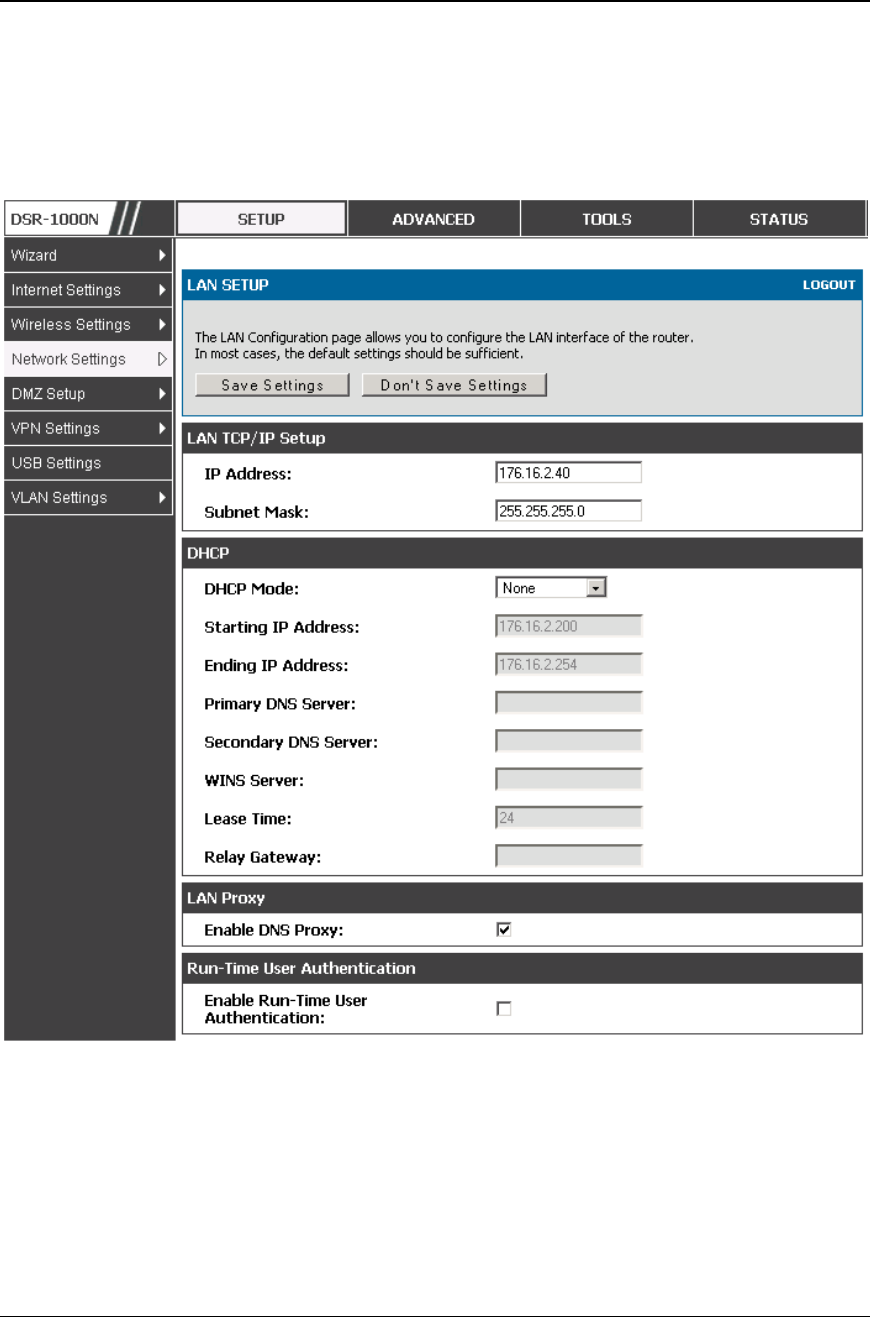
Unified Services Router User Manual
11
• Enable DNS Proxy: To enable the router to act as a proxy for all DNS requests and
communicate with the ISP’s DNS servers, click the checkbox.
3. Click Save Settings to apply all changes.
Figure 1: Setup page for LAN TCP/IP settings
2.1.1 LAN Configuration in an IPv6 Network
Advanced > IPv6 > IPv6 LAN > IPv6 LAN Config
In IPv6 mode, the LAN DHCP server is enabled by default (similar to IPv4 mode).
The DHCPv6 server will serve IPv6 addresses from configured address pools with
the IPv6 Prefix Length assigned to the LAN.

Unified Services Router User Manual
12
IPv4 / IPv6 mode must be enabled in the Advanced > IPv6 > IP mode to enable
IPv6 configuration options.
LAN Settings
The default IPv6 LAN address for the router is fec0::1. You can change this 128 bit
IPv6 address based on your network requirements. The other field that defines the
LAN settings for the router is the prefix length. The IPv6 network (subnet) is
identified by the initial bits of the address called the prefix. By default this is 64
bits long. All hosts in the network have common initial bits for their IPv6 address;
the number of common initial bits in the network’s addresses is set by the prefix
length field.
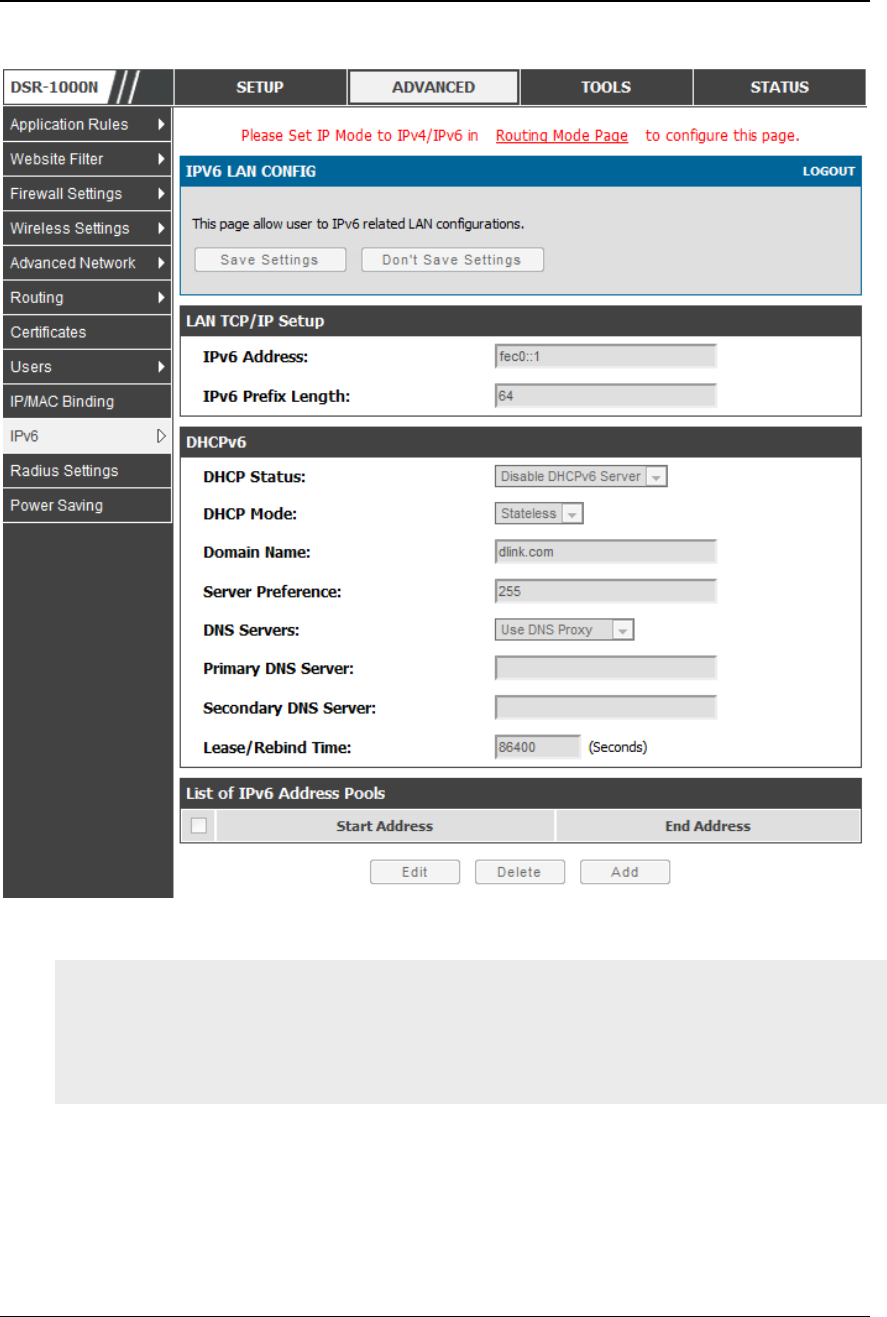
Unified Services Router User Manual
13
Figure 2: IPv6 LAN and DHCPv6 configuration
If you change the IP address and click Save Settings, the GUI will not respond.
Open a new connection to the new IP address and log in again. Be sure the LAN
host (the machine used to manage the router) has obtained IP address from newly
assigned pool (or has a static IP address in the router’s LAN subnet) before
accessing the router via changed IP address.
As with an IPv4 LAN network, the router has a DHCPv6 server. If enabled, the
router assigns an IP address within the specified range plus additional specified
information to any LAN PC that requests DHCP served addresses.
The following settings are used to configure the DHCPv6 server:

Unified Services Router User Manual
14
• DHCP Mode: The IPv6 DHCP server is either stateless or stateful. If
stateless is selected an external IPv6 DHCP server is not required as the
IPv6 LAN hosts are auto-configured by this router. In this case the router
advertisement daemon (RADVD) must be configured on this device and
ICMPv6 router discovery messages are used by the host for auto-
configuration. There are no managed addresses to serve the LAN nodes. If
stateful is selected the IPv6 LAN host will rely on an external DHCPv6
server to provide required configuration settings
• The domain name of the DHCPv6 server is an optional setting
• Server Preference is used to indicate the preference level of this DHCP
server. DHCP advertise messages with the highest server preference value to
a LAN host are preferred over other DHCP server advertise messages. The
default is 255.
• The DNS server details can be manually entered here (primary/secondary
options. An alternative is to allow the LAN DHCP client to receive the DNS
server details from the ISP directly. By selecting Use DNS proxy, this router
acts as a proxy for all DNS requests and communicate with the ISP’s DNS
servers (a WAN configuration parameter).
• Primary and Secondary DNS servers: If there are configured domain name
system (DNS) servers available on the LAN enter the IP addresses here.
• Lease/Rebind time sets the duration of the DHCPv6 lease from this router to
the LAN client.
IPv6 Address Pools
This feature allows you to define the IPv6 delegation prefix for a range of IP
addresses to be served by the gateway’s DHCPv6 server. Using a delegation prefix
you can automate the process of informing other networking equipment on the LAN
of DHCP information specific for the assigned prefix.
2.1.2 Configuring IPv6 Router Advertisements
Router Advertisements are analogous to IPv4 DHCP assignments for LAN clients, in
that the router will assign an IP address and supporting network information to
devices that are configured to accept such details. Router Advertisement is required
in an IPv6 network is required for stateless auto configuration of the IPv6 LAN. By
configuring the Router Advertisement Daemon on this router, the device will listen
on the LAN for router solicitations and respond to these LAN hosts with router
advisements.

Unified Services Router User Manual
15
RADVD
Advanced > IPv6 > IPv6 LAN > Router Advertisement
To support stateless IPv6 auto configuration on the LAN, set the RADVD status to
Enable. The following settings are used to configure RADVD:
• Advertise Mode: Select Unsolicited Multicast to send router advertisements
(RA’s) to all interfaces in the multicast group. To restrict RA’s to well
known IPv6 addresses on the LAN, and thereby reduce overall network
traffic, select Unicast only.
• Advertise Interval: When advertisements are unsolicited multicast packets,
this interval sets the maximum time between advertisements from the
interface. The actual duration between advertisements is a random value
between one third of this field and this field. The default is 30 seconds.
• RA Flags: The router advertisements (RA’s) can be sent with one or both of
these flags. Chose Managed to use the administered /stateful protocol for
address auto configuration. If the Other flag is selected the host uses
administered/stateful protocol for non-address auto configuration.
• Router Preference: this low/medium/high parameter determines the
preference associated with the RADVD process of the router. This is useful
if there are other RADVD enabled devices on the LAN as it helps avoid
conflicts for IPv6 clients.
• MTU: The router advertisement will set this maximum transmission unit
(MTU) value for all nodes in the LAN that are autoconfigured by the router.
The default is 1500.
• Router Lifetime: This value is present in RA’s and indicates the usefulness
of this router as a default router for the interface. The default is 3600
seconds. Upon expiration of this value, a new RADVD exchange must take
place between the host and this router.
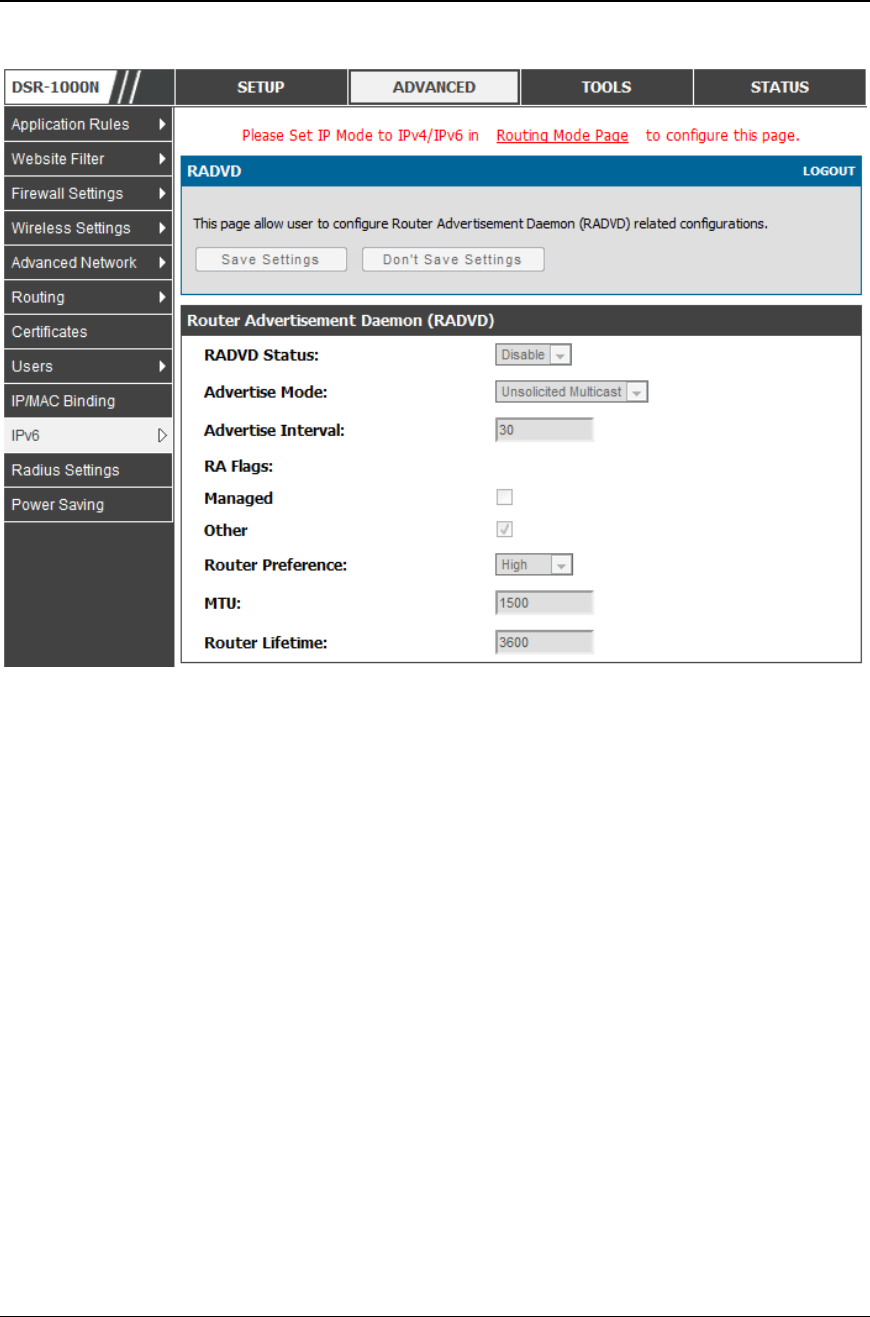
Unified Services Router User Manual
16
Figure 3: Configuring the Router Advertisement Daemon
Advertisement Prefixes
Advanced > IPv6 > IPv6 LAN > Advertisement Prefixes
The router advertisements configured with advertisement prefixes allow this router
to inform hosts how to perform stateless address auto configuration. Router
advertisements contain a list of subnet prefixes that allow the router to determine
neighbors and whether the host is on the same link as the router.
The following prefix options are available for the router advertisements:
• IPv6 Prefix Type: To ensure hosts support IPv6 to IPv4 tunnel select the
6to4 prefix type. Selecting Global/Local/ISATAP will allow the nodes to
support all other IPv6 routing options
• SLA ID: The SLA ID (Site-Level Aggregation Identifier) is available when
6to4 Prefixes are selected. This should be the interface ID of the router’s
LAN interface used for router advertisements.
• IPv6 Prefix: When using Global/Local/ISATAP prefixes, this field is used to
define the IPv6 network advertised by this router.
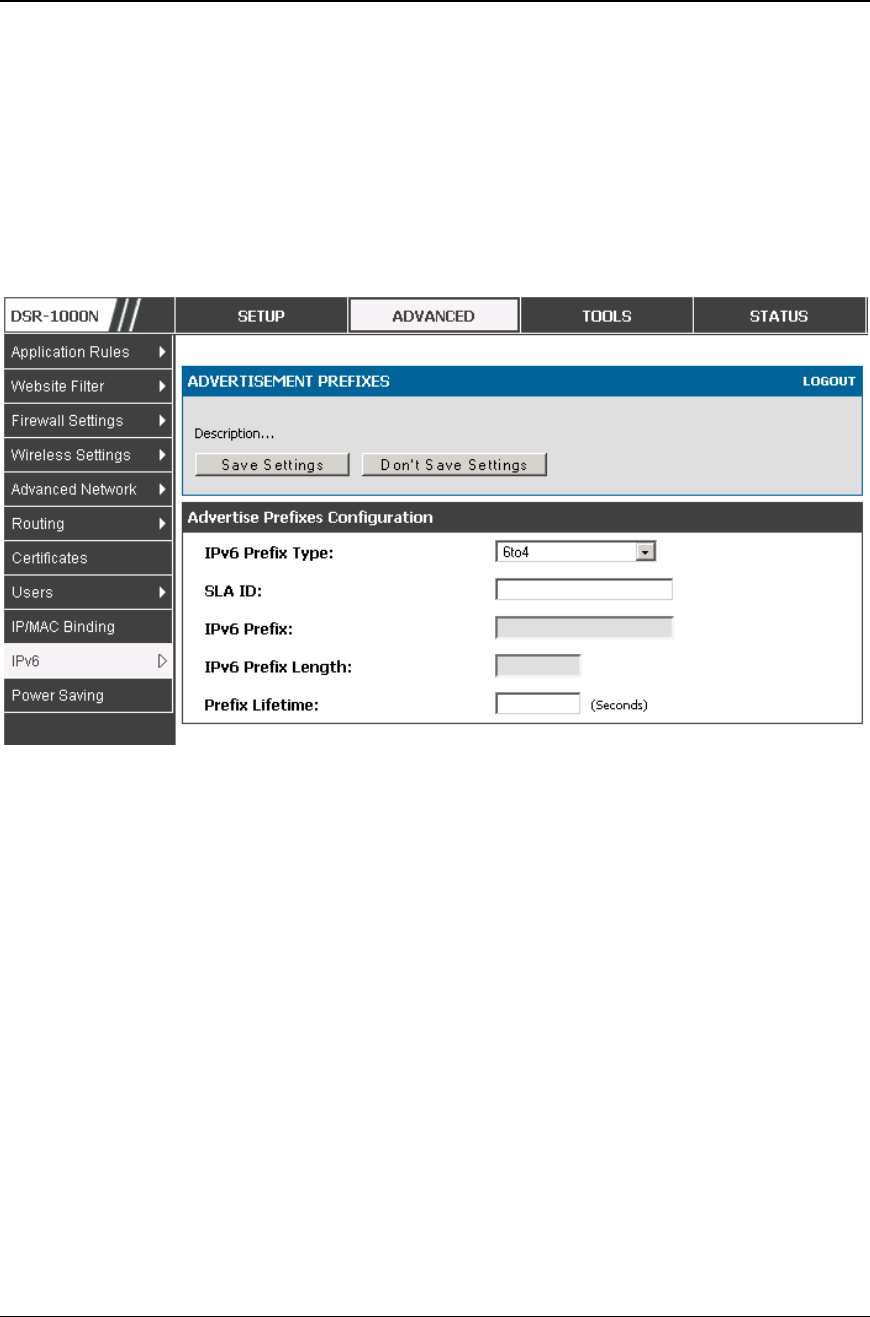
Unified Services Router User Manual
17
• IPv6 Prefix Length: This value indicates the number contiguous, higher
order bits of the IPv6 address that define up the network portion of the
address. Typically this is 64.
• Prefix Lifetime: This defines the duration (in seconds) that the requesting
node is allowed to use the advertised prefix. It is analogous to DHCP lease
time in an IPv4 network.
Figure 4: IPv6 Advertisement Prefix settings
2.2 VLAN Configuration
The router supports virtual network isolation on the LAN with the use of VLANs.
LAN devices can be configured to communicate in a subnetwork defined by VLAN
identifiers. LAN ports can be assigned unique VLAN IDs so that traffic to and from
that physical port can be isolated from the general LAN. VLAN filtering is
particularly useful to limit broadcast packets of a device in a large network
VLAN support is disabled by default in the router. In the VLAN Configuration page,
enable VLAN support on the router and then proceed to the next section to define the
virtual network.
Setup > VLAN Settings > Available VLAN
The Available VLAN page shows a list of configured VLANs by name and VLAN ID.
A VLAN membership can be created by clicking the Add button below the List of
Available VLANs.
A VLAN membership entry consists of a VLAN identifier and the numerical VLAN
ID which is assigned to the VLAN membership. The VLAN ID value can be any
number from 2 to 4091. VLAN ID 1 is reserved for the default VLAN, which is used
for untagged frames received on the interface. By enabling Inter VLAN Routing, you
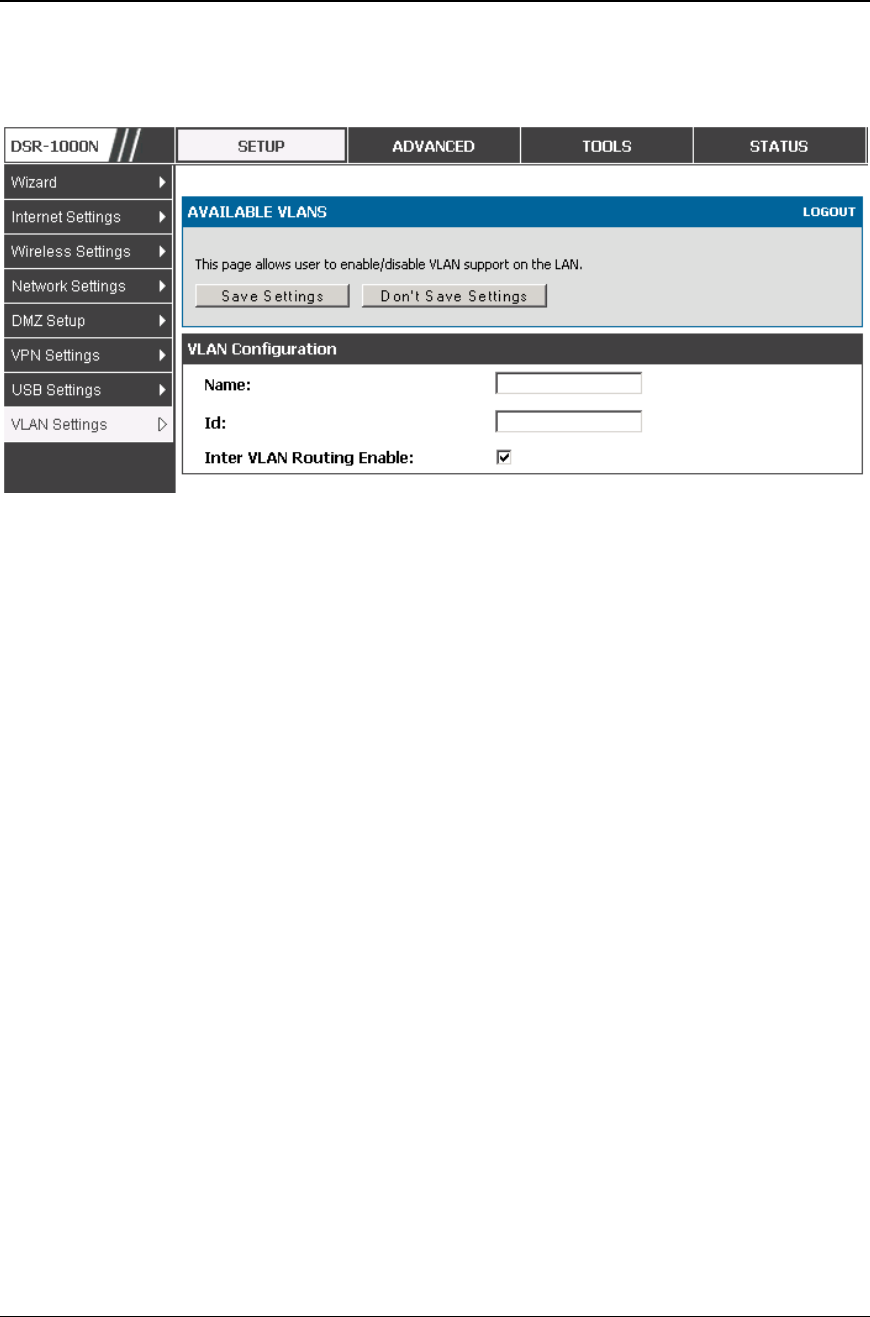
Unified Services Router User Manual
18
will allow traffic from LAN hosts belonging to this VLAN ID to pass through to other
configured VLAN IDs that have Inter VLAN Routing enabled.
Figure 5: Adding VLAN memberships to the LAN
2.2.1 Associating VLANs to ports
In order to tag all traffic through a specific LAN port with a VLAN ID, you can
associate a VLAN to a physical port.
Setup > VLAN Settings > Port VLAN
VLAN membership properties for the LAN and wireless LAN are listed on this page.
The VLAN Port table displays the port identifier, the mode setting for that port and
VLAN membership information. The configuration page is accessed by selecting
one of the four physical ports or a configured access point and clicking Edit.
The edit page offers the following configuration options:
• Mode: The mode of this VLAN can be General, Access, or Trunk. The
default is access.
• In General mode the port is a member of a user selectable set of VLANs.
The port sends and receives data that is tagged or untagged with a VLAN
ID. If the data into the port is untagged, it is assigned the defined PVID. In
the configuration from Figure 4, Port 3 is a General port with PVID 3, so
untagged data into Port 3 will be assigned PVID 3. All tagged data sent out
of the port with the same PVID will be untagged. This is mode is typically
used with IP Phones that have dual Ethernet ports. Data coming from phone
to the switch port on the router will be tagged. Data passing through the
phone from a connected device will be untagged.
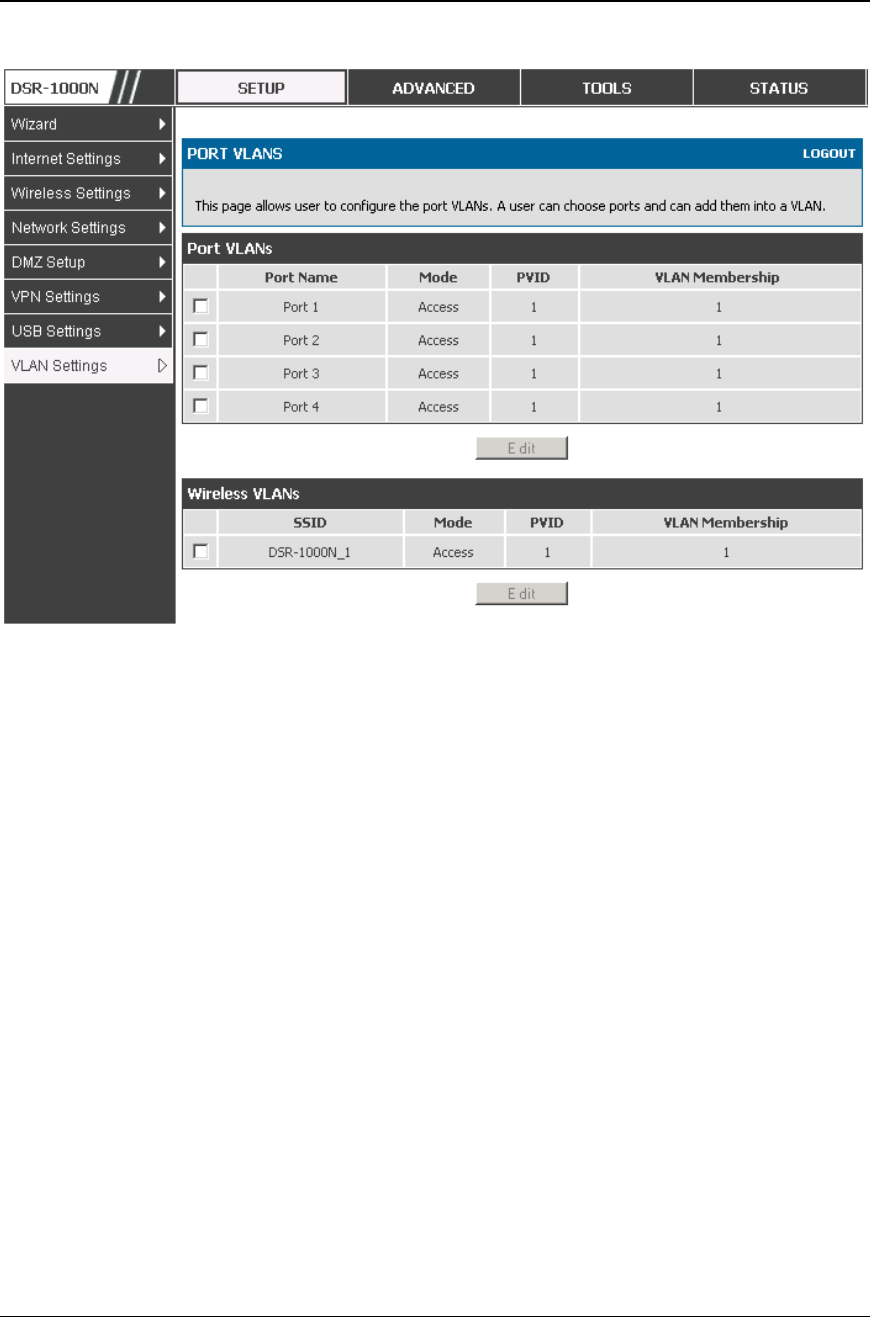
Unified Services Router User Manual
19
Figure 6: Port VLAN list
• In Access mode the port is a member of a single VLAN (and only one). All
data going into and out of the port is untagged. Traffic through a port in
access mode looks like any other Ethernet frame.
• In Trunk mode the port is a member of a user selectable set of VLANs. All
data going into and out of the port is tagged. Untagged coming into the port
is not forwarded, except for the default VLAN with PVID=1, which is
untagged. Trunk ports multiplex traffic for multiple VLANs over the same
physical link.
• Select PVID for the port when the General mode is selected.
• Configured VLAN memberships will be displayed on the VLAN
Membership Configuration for the port. By selecting one more VLAN
membership options for a General or Trunk port, traffic can be routed
between the selected VLAN membership IDs
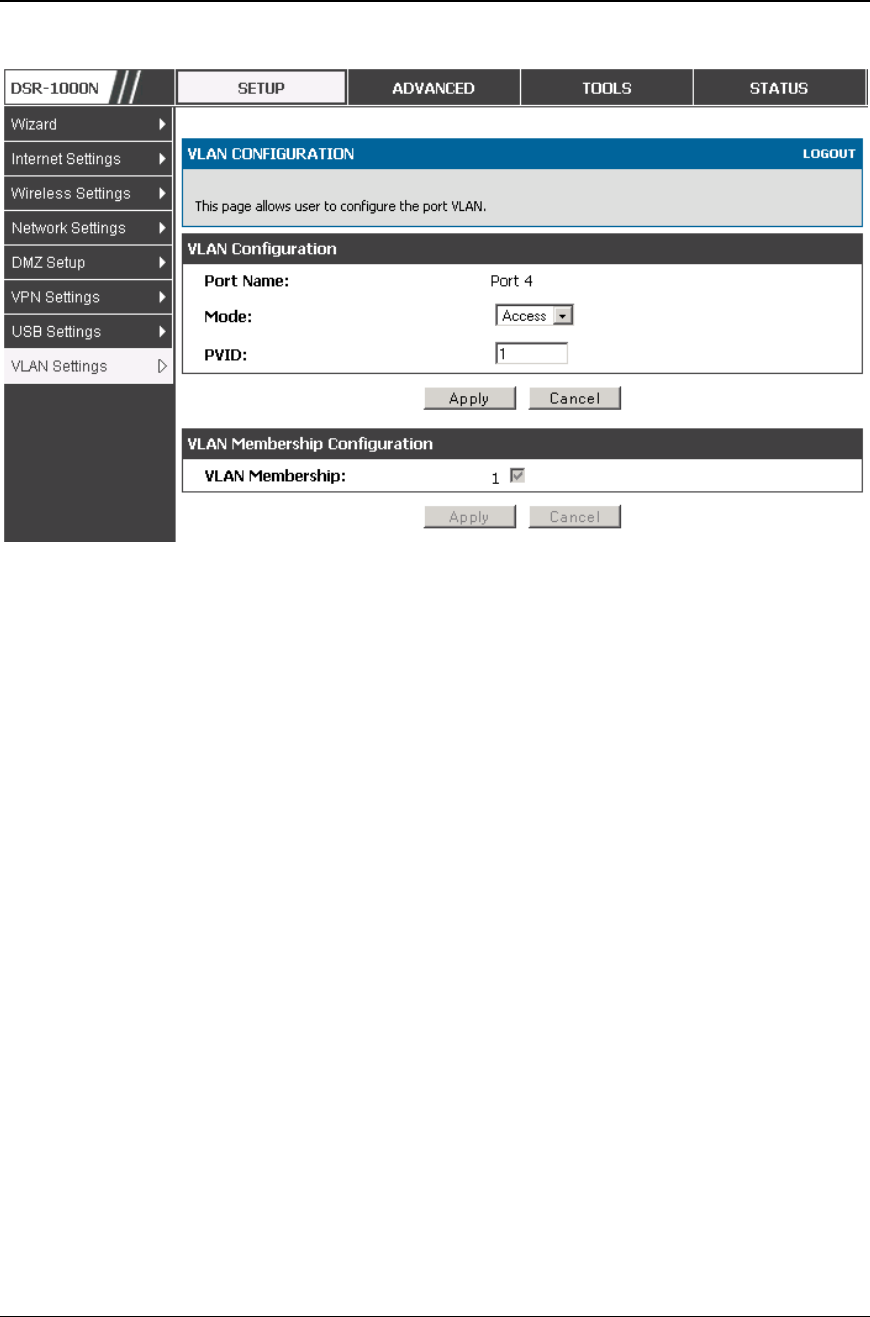
Unified Services Router User Manual
20
Figure 7: Configuring VLAN membership for a port
2.3 Configurable Port: DMZ Setup
This router supports one of the physical ports to be configured as a secondary WAN
Ethernet port or a dedicated DMZ port. A DMZ is a subnetwork that is open to the
public but behind the firewall. The DMZ adds an additional layer of security to the
LAN, as specific services/ports that are exposed to the internet on the DMZ do not
have to be exposed on the LAN. It is recommended that hosts that must be exposed to
the internet (such as web or email servers) be placed in the DMZ network. Firewall
rules can be allowed to permit access specific services/ports to the DMZ from both
the LAN or WAN. In the event of an attack to any of the DMZ nodes, the LAN is not
necessarily vulnerable as well.
Setup > DMZ Setup > DMZ Setup Configuration
DMZ configuration is identical to the LAN configuration. There are no restrictions on
the IP address or subnet assigned to the DMZ port, other than the fact that it cannot
be identical to the IP address given to the LAN interface of this gateway.
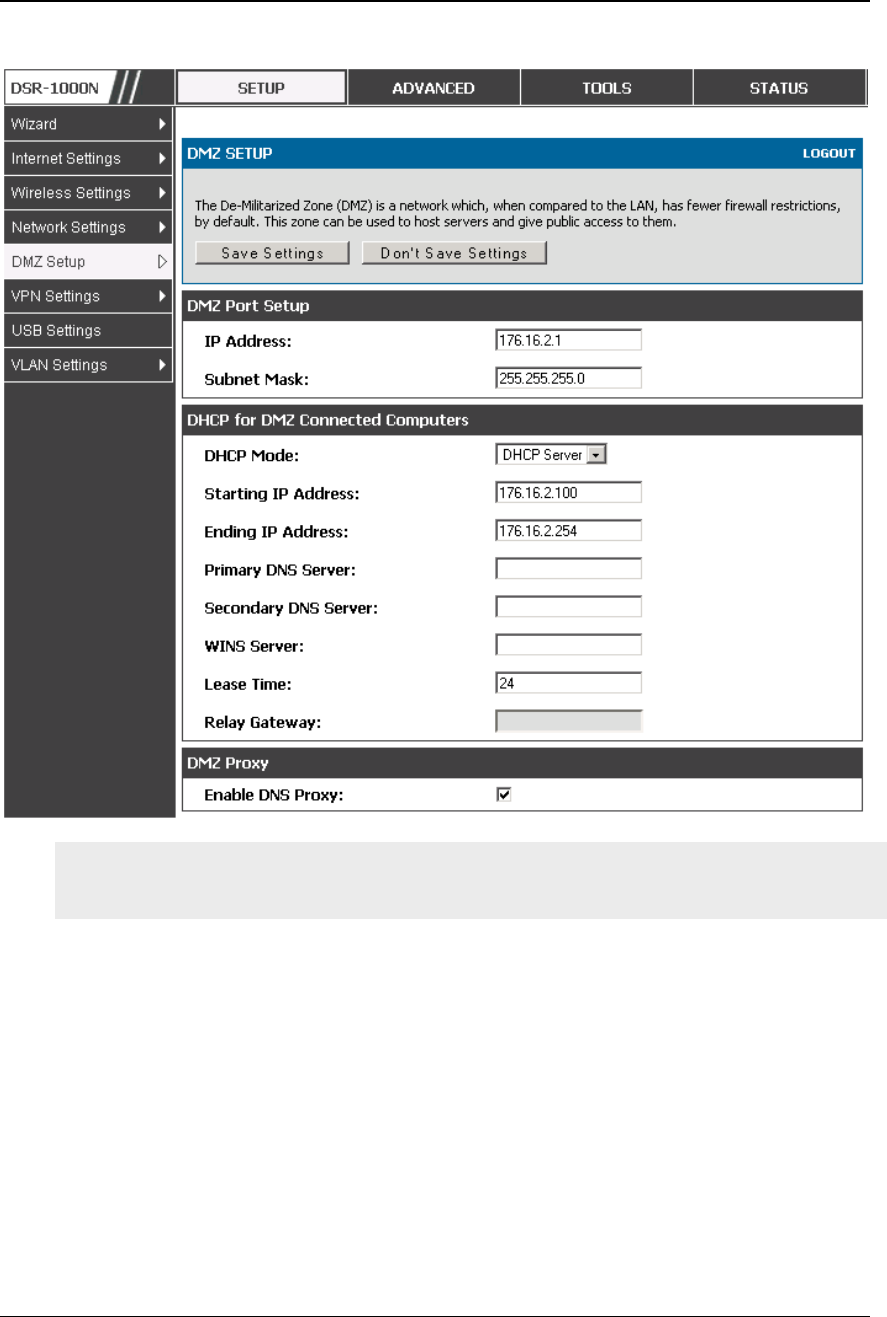
Unified Services Router User Manual
21
Figure 8: DMZ configuration
In order to configure a DMZ port, the router’s configurable port must be set to
DMZ in the Setup > Internet Settings > Configurable Port page.
2.4 Universal Plug and Play (UPnP)
Advanced > Advanced Network > UPnP
Universal Plug and Play (UPnP) is a feature that allows the router to discovery
devices on the network that can communicate with the router and allow for auto
configuration. If a network device is detected by UPnP, the router can open internal
or external ports for the traffic protocol required by that network device.
Once UPnP is enabled, you can configure the router to detect UPnP-supporting
devices on the LAN (or a configured VLAN). If disabled, the router will not allow for
automatic device configuration.
Configure the following settings to use UPnP:
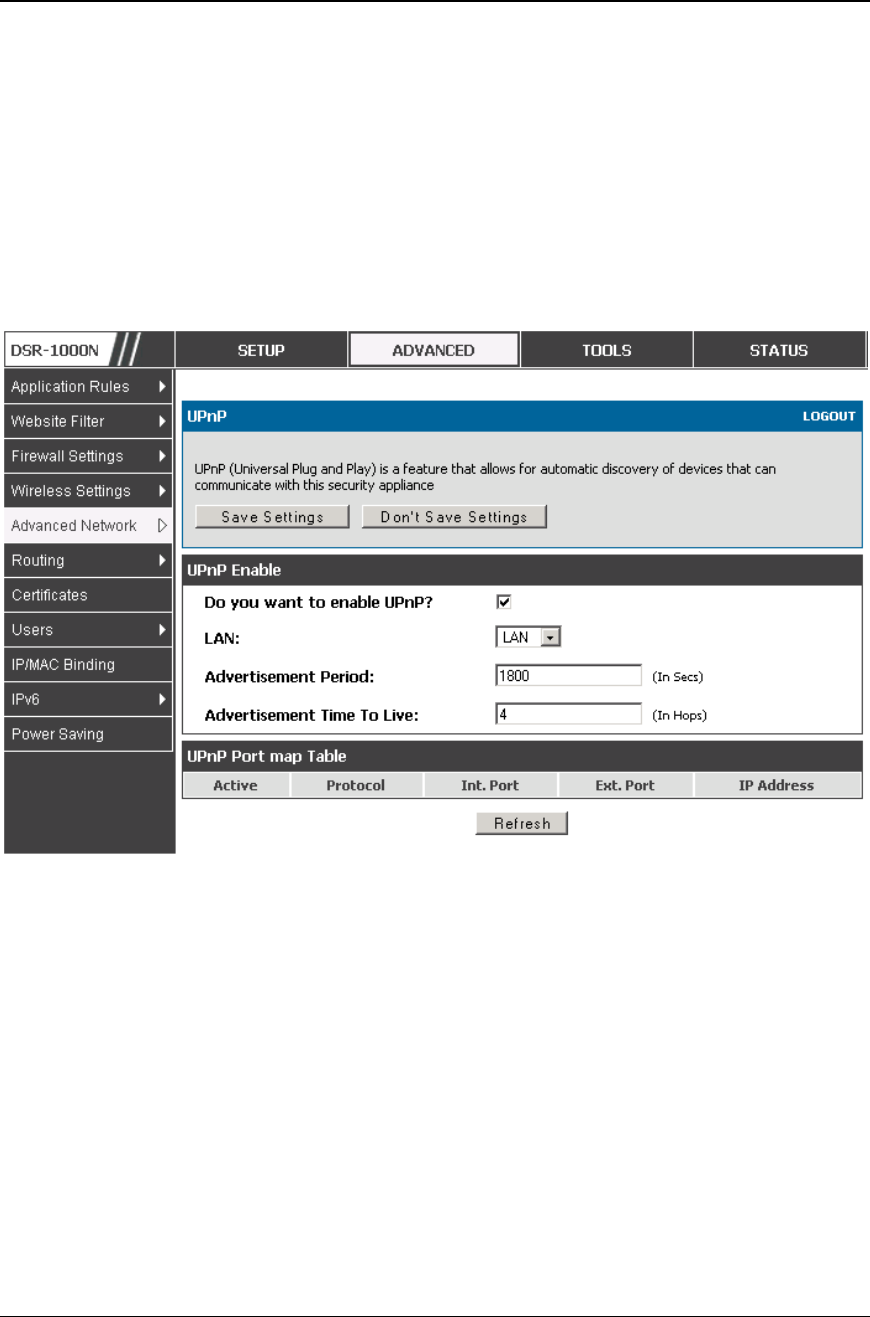
Unified Services Router User Manual
22
• Advertisement Period: This is the frequency that the router broadcasts UPnP
information over the network. A large value will minimize network traffic but
cause delays in identifying new UPnP devices to the network.
• Advertisement Time to Live: This is expressed in hops for each UPnP packet. This
is the number of steps a packet is allowed to propagate before being discarded.
Small values will limit the UPnP broadcast range. A default of 4 is typical for
networks with few switches.
Figure 9: UPnP Configuration
UPnP Port map Table
The UPnP Port map Table has the details of UPnP devices that respond to the router’s
advertisements. The following information is displayed for each detected device:
• Active: A yes/no indicating whether the port of the UPnP device that established a
connection is currently active
• Protocol: The network protocol (i.e. HTTP, FTP, etc.) used by the device
• Int. Port (Internal Port): The internal ports opened by UPnP (if any)
• Ext. Port (External Port): The external ports opened by UPnP (if any)
• IP Address: The IP address of the UPnP device detected by this router
Click Refresh to refresh the portmap table and search for any new UPnP devices.
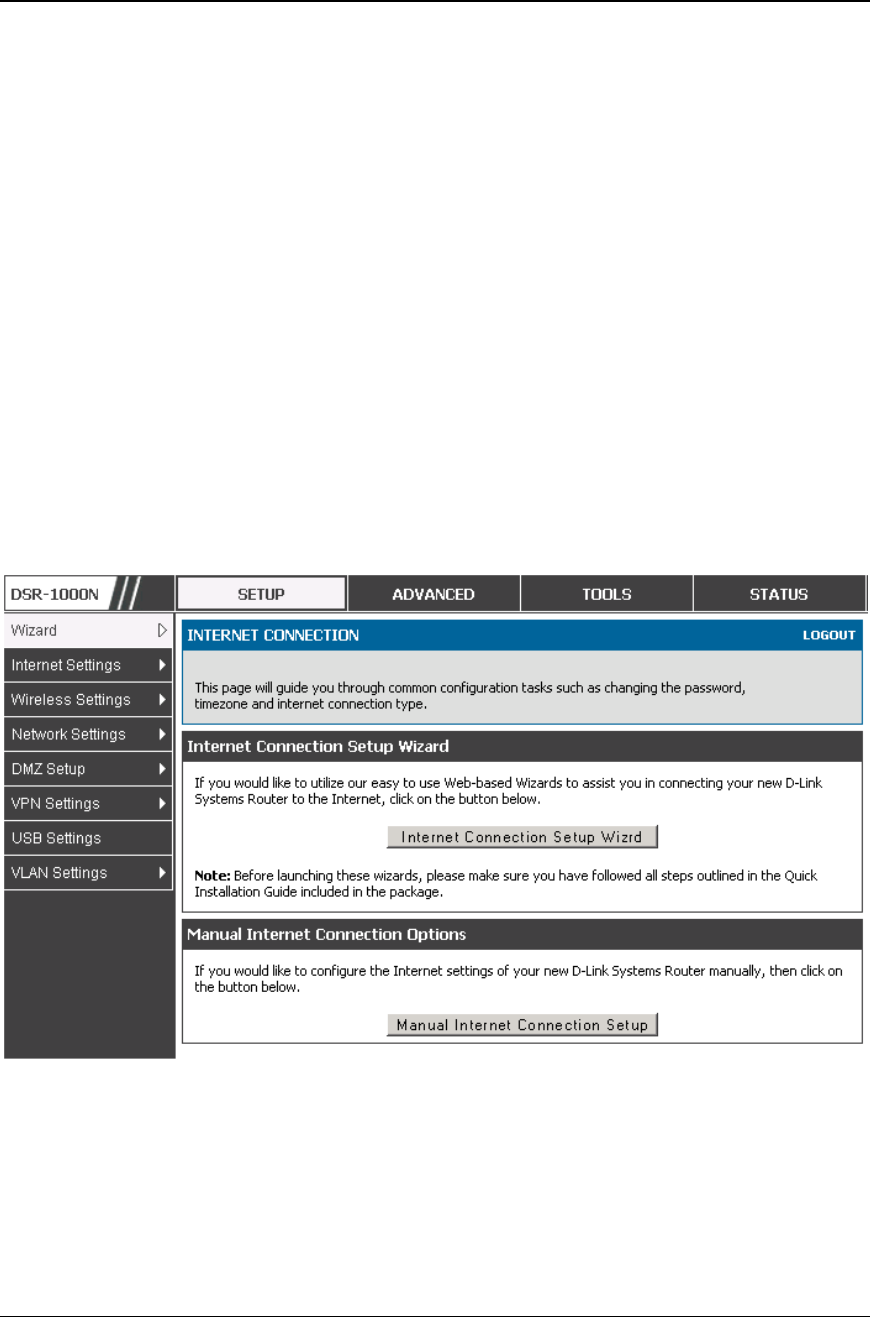
Unified Services Router User Manual
23
Chapter 3. Connecting to the Internet:
WAN Setup
This router has two WAN ports that can be used to establish a connection to the
internet. The following ISP connection types are supported: DHCP, Static, PPPoE,
PPTP, L2TP, 3G Internet (via USB modem).
It is assumed that you have arranged for internet service with your Internet Service
Provider (ISP). Please contact your ISP or network administrator for the configuration
information that will be required to setup the router.
3.1 Internet Setup Wizard
Setup > Wizard > Internet
The Internet Connection Setup Wizard is available for users new to networking. By
going through a few straightforward configuration pages you can take the information
provided by your ISP to get your WAN connection up and enable internet access for
your network.
Figure 10: Internet Connection Setup Wizard
You can start using the Wizard by logging in with the administrator password for the
router. Once authenticated set the time zone that you are located in, and then choose
the type of ISP connection type: DHCP, Static, PPPoE, PPTP, L2TP. Depending on
the connection type a username/password may be required to register this router with
the ISP. In most cases the default settings can be used if the ISP did not specify that
parameter. The last step in the Wizard is to click the Connect button, which confirms
the settings by establishing a link with the ISP. Once connected, you can move on and
configure other features in this router.

Unified Services Router User Manual
24
3G Internet access with a USB modem is supported on the secondary WAN port
(WAN2). The Internet Connection Setup Wizard assists with the primary WAN port
(WAN1) configuration only.
3.2 WAN Configuration
Setup > Internet Settings > WAN1 Setup
You must either allow the router to detect WAN connection type automatically or
configure manually the following basic settings to enable Internet connectivity:
• ISP Connection type: Based on the ISP you have selected for the primary WAN link
for this router, choose Static IP address, DHCP client, Point-to-Point Tunneling
Protocol (PPTP), Point-to-Point Protocol over Ethernet (PPPoE), Layer 2 Tunneling
Protocol (L2TP). Required fields for the selected ISP type become highlighted.
Enter the following information as needed and as provided by your ISP:
• PPPoE Profile Name. This menu lists configured PPPoE profiles, particularly
useful when configuring multiple PPPoE connections (i.e. for Japan ISPs that have
multiple PPPoE support).
• ISP login information. This is required for PPTP and L2TP ISPs.
• User Name
• Password
• Secret (required for L2TP only)
• MPPE Encryption: For PPTP links, your ISP may require you to enable Microsoft
Point-to-Point Encryption (MPPE).
• Split Tunnel (supported for PPTP and L2TP connection). This setting allows your
LAN hosts to access internet sites over this WAN link while still permitting VPN
traffic to be directed to a VPN configured on this WAN port.
With split tunneling enabled users can bypass content filtering and other firewall
settings. Disable split tunneling on the WAN interface for highest gateway security
measures.
• Connectivity Type. To keep the connection always on, click Keep Connected. To
log out after the connection is idle for a period of time (useful if your ISP costs are
based on logon times), click Idle Timeout and enter the time, in minutes, to wait
before disconnecting in the Idle Time field.
• My IP Address: Enter the IP address assigned to you by the ISP.

Unified Services Router User Manual
25
• Server IP Address: Enter the IP address of the PPTP or L2TP server.
3.2.1 WAN Port IP address
Your ISP assigns you an IP address that is either dynamic (newly generated each
time you log in) or static (permanent). The IP Address Source option allows you to
define whether the address is statically provided by the ISP or should be received
dynamically at each login. If static, enter your IP address, IPv4 subnet mask, and the
ISP gateway’s IP address. PPTP and L2TP ISPs also can provide a static IP address
and subnet to configure, however the default is to receive that information
dynamically from the ISP.
3.2.2 WAN DNS Servers
The IP Addresses of WAN Domain Name Servers (DNS) are typically provided
dynamically from the ISP but in some cases you can define the static IP addresses of
the DNS servers. DNS servers map Internet domain names (example:
www.google.com) to IP addresses. Click to indicate whether to get DNS server
addresses automatically from your ISP or to use ISP-specified addresses. If the
latter, enter addresses for the primary and secondary DNS servers. To avoid
connectivity problems, ensure that you enter the addresses correctly.
3.2.3 DHCP WAN
For DHCP client connections, you can choose the MAC address of the router to
register with the ISP. In some cases you may need to clone the LAN host’s MAC
address if the ISP is registered with that LAN host.
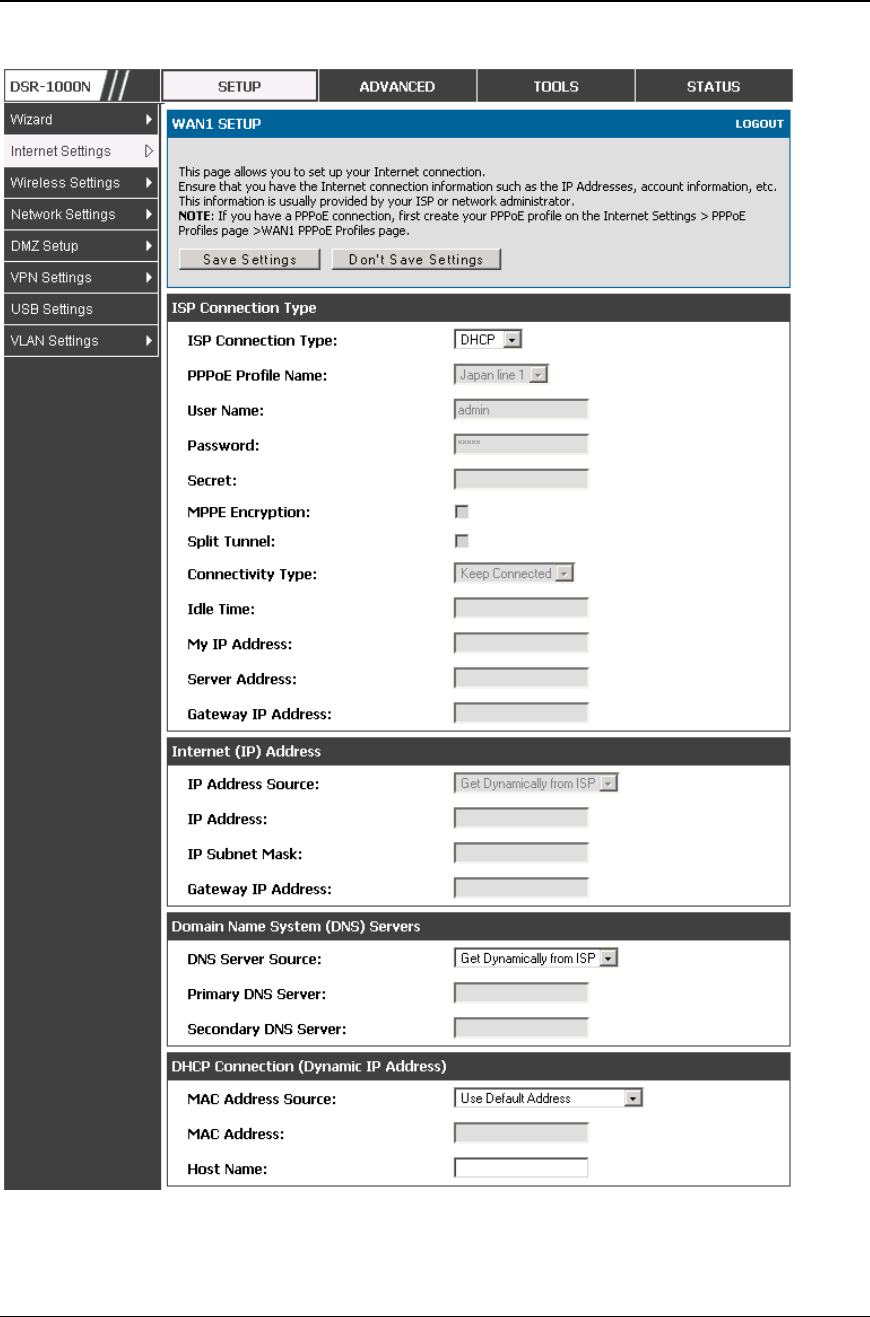
Unified Services Router User Manual
26
Figure 11: Manual WAN configuration
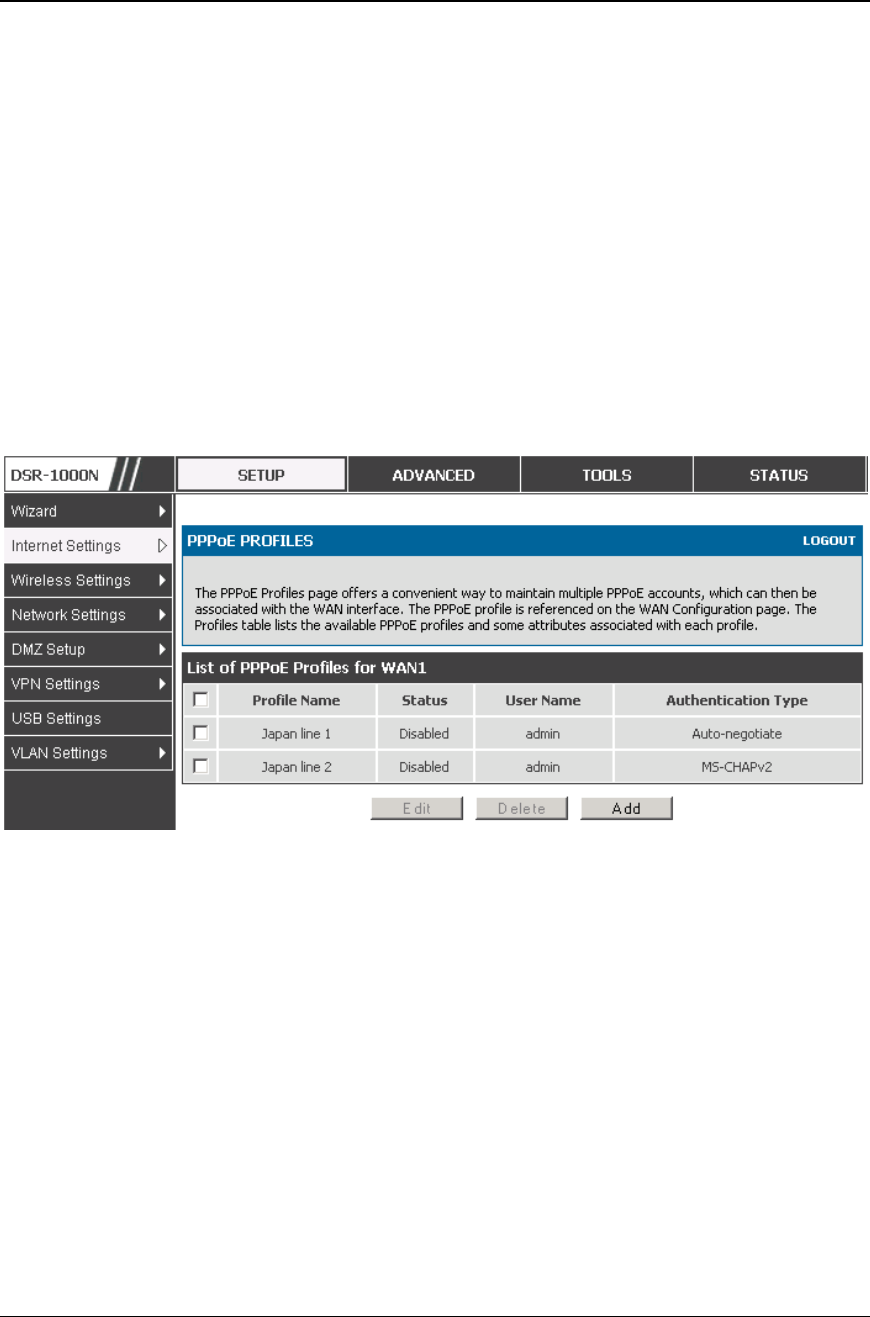
Unified Services Router User Manual
27
3.2.4 PPPoE Profiles
Setup > Internet Settings > PPPoE Profiles > WAN1 PPPoE Profiles
Some ISP’s allow for multiple concurrent PPPoE sessions (it is most common in
Japan). Each connection can have its own specific authentication requirements and
will provide unique IP, gateway, and DNS address parameters to the associated
WAN port.
The PPPoE Profiles page offers a convenient way to maintain multiple PPPoE
accounts, which can then be associated with one of the available WAN interfaces.
Once configured, a PPPoE profile name can be selected on the WAN configuration
page to reduce the configuration requirements for that WAN port.
The PPPoE profile is referenced on the WAN Configuration page. The List of
PPPoE profiles for a particular WAN (see figure below) outlines the available
profile and their status and authentication type.
Figure 12: List of configured PPPoE profiles
To create a new PPPoE profile, select Add in the PPPoE Profile page. Each profile
is associated to one of the two WAN ports. Similar to the PPPoE configuration
options in the WAN configuration page, you need to define the ISP logon
credentials, authentication type, and connectivity settings for the PPPoE session.
This information will be provided by the ISP that offers multiple PPPoE session
support.
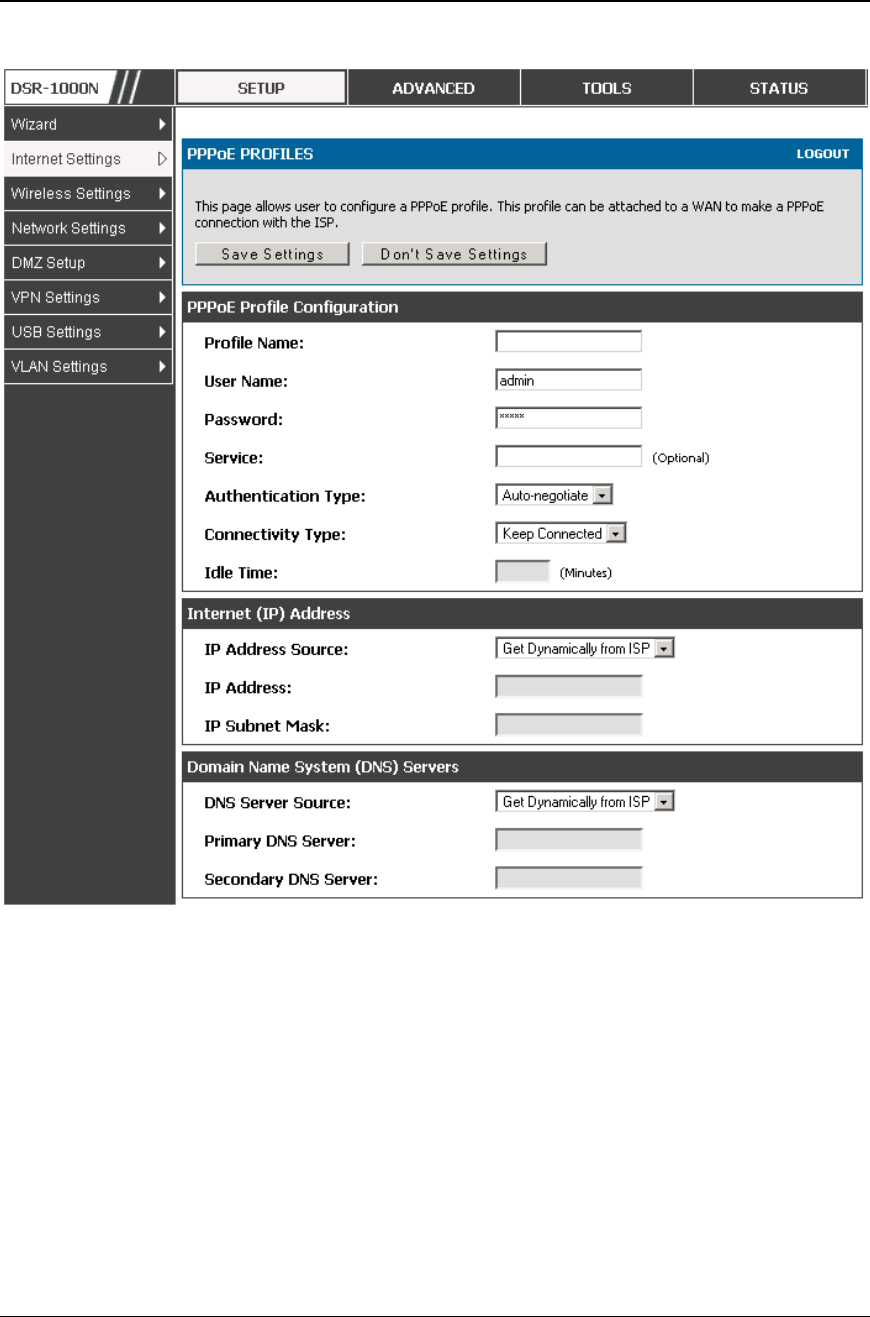
Unified Services Router User Manual
28
Figure 13: PPPoE profile configuration
3.2.5 WAN Configuration in an IPv6 Network
Setup > IPv6 > IPv6 WAN1 Config
For IPv6 WAN connections, this router can have a static IPv6 address or receive
connection information when configured as a DHCPv6 client. In the case where the
ISP assigns you a fixed address to access the internet, the static configuration
settings must be completed. In addition to the IPv6 address assigned to your router,
the IPv6 prefix length defined by the ISP is needed. The default IPv6 Gateway
address is the server at the ISP that this router will connect to for accessing the
internet. The primary and secondary DNS servers on the ISP’s IPv6 network are
used for resolving internet addresses, and these are provided along with the static IP
address and prefix length from the ISP.
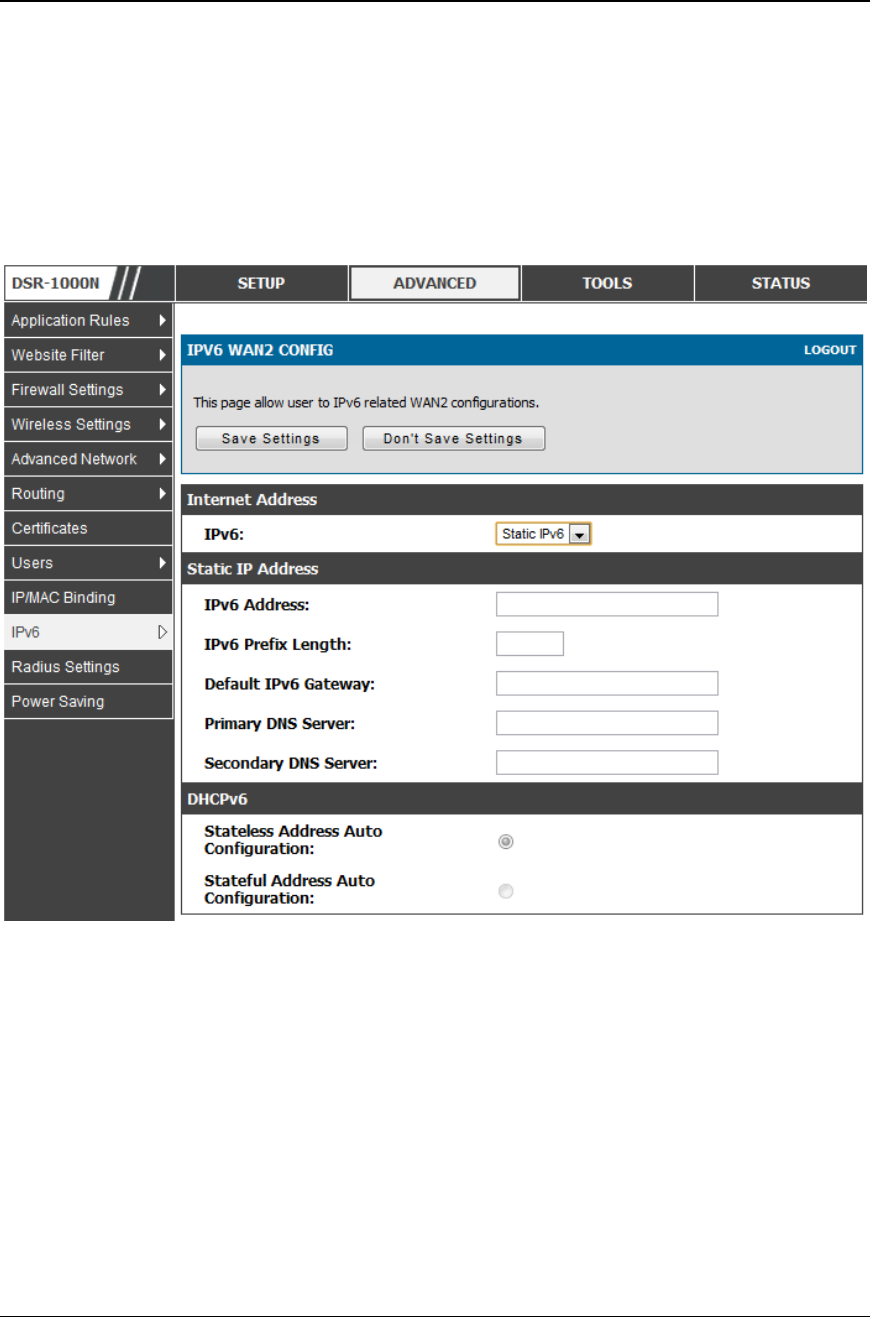
Unified Services Router User Manual
29
When the ISP allows you to obtain the WAN IP settings via DHCP, you need to
provide details for the DHCPv6 client configuration. The DHCPv6 client on the
gateway can be either stateless or stateful. If a stateful client is selected the gateway
will connect to the ISP’s DHCPv6 server for a leased address. For stateless DHCP
there need not be a DHCPv6 server available at the ISP, rather ICMPv6 discover
messages will originate from this gateway and will be used for auto configuration. A
third option to specify the IP address and prefix length of a preferred DHCPv6
server is available as well.
Figure 14: IPv6 WAN Setup page
3.2.6 Checking WAN Status
Setup > Internet Settings > WAN Status
The status and summary of configured settings for both WAN1 and WAN2 are
available on the WAN Status page. You can view the following key connection
status information for each WAN port:
• Connection time
• Connection type: dynamic IP or static IP

Unified Services Router User Manual
30
• Connection state: This is whether the WAN is connected or disconnected to
an ISP. The Link State is whether the physical WAN connection in place;
the Link State can be UP (i.e. cable inserted) while the WAN Connection
State is down.
• IP address / subnet mask
• Gateway IP address
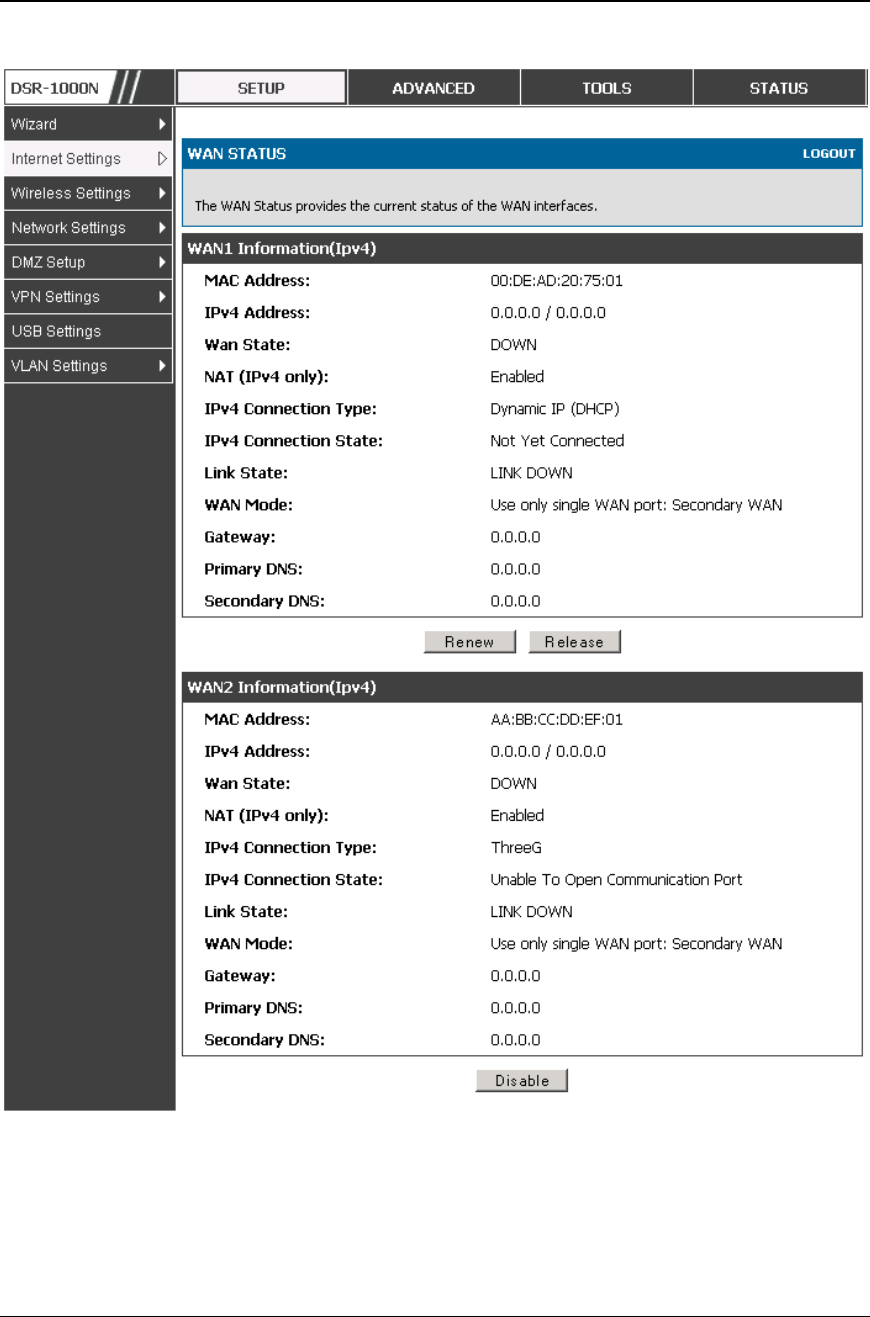
Unified Services Router User Manual
31
Figure 15: Connection Status information for both WAN ports
The WAN status page allows you to Enable or Disable static WAN links. For WAN
settings that are dynamically received from the ISP, you can Renew or Release the
link parameters if required.
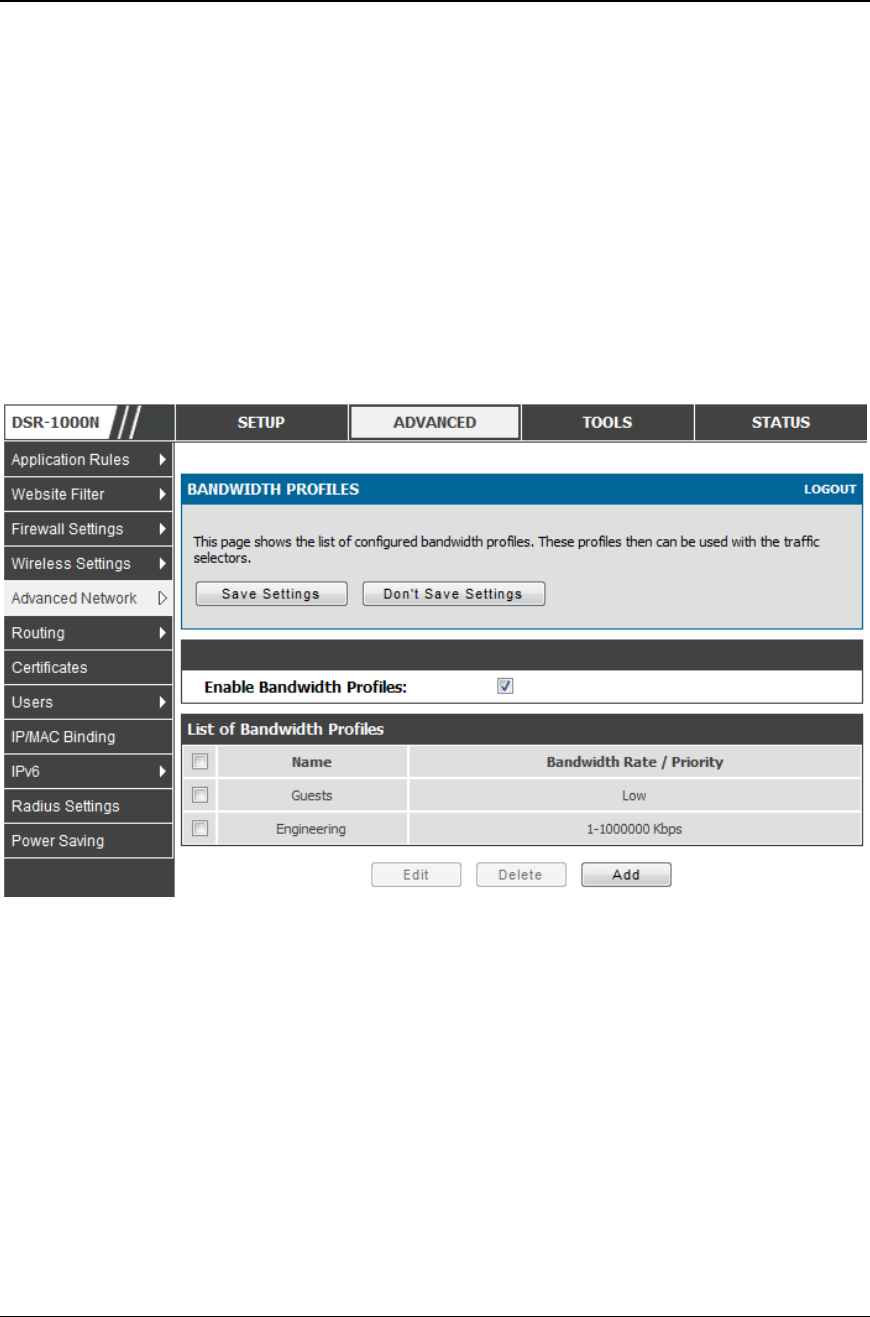
Unified Services Router User Manual
32
3.3 Bandwidth Controls
Advanced > Advanced Network > Traffic Management > Bandwidth Profiles
Bandwidth profiles allow you to regulate the traffic flow from the LAN to WAN 1 or
WAN 2. This is useful to ensure that low priority LAN users (like guests or HTTP
service) do not monopolize the available WAN’s bandwidth for cost-savings or
bandwidth-priority-allocation purposes.
Bandwidth profiles configuration consists of enabling the bandwidth control feature
from the GUI and adding a profile which defines the control parameters. The profile
can then be associated with a traffic selector, so that bandwidth profile can be applied
to the traffic matching the selectors. Selectors are elements like IP addresses or
services that would trigger the configured bandwidth regulation.
Figure 16: List of Configured Bandwidth Profiles
To create a new bandwidth profile, click Add in the List of Bandwidth Profiles. The
following configuration parameters are used to define a bandwidth profile:
• Profile Name: This identifier is used to associate the configured profile to the
traffic selector
• You can choose to limit the bandwidth either using priority or rate.
• If using priority “Low”, “High”, “Medium” can be selected. If there is a low
priority profile associated with traffic selector A and a high priority profile
associated with traffic selector B, then the WAN bandwidth allocation
preference will be to traffic selector B packets.
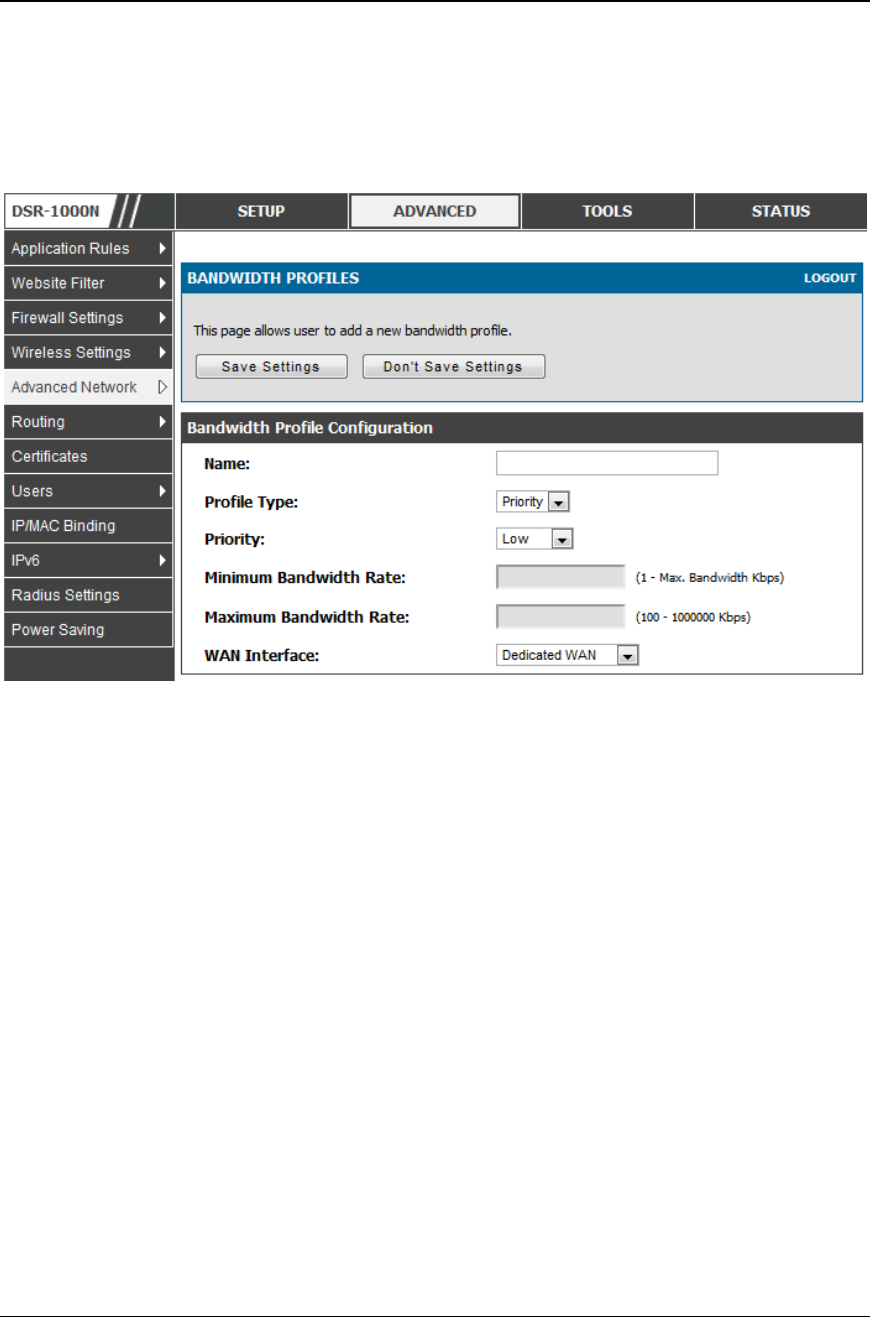
Unified Services Router User Manual
33
• For finer control, the Rate profile type can be used. With this option the
minimum and maximum bandwidth allowed by this profile can be limited.
• Choose the WAN interface that the profile should be associated with
Figure 17: Bandwidth Profile Configuration page
Advanced > Advanced Network > Traffic Management > Traffic Selectors
Once a profile has been created it can then be associated with a traffic flow from the
LAN to WAN. To create a traffic selector, click Add on the Traffic Selectors page.
Traffic selector configuration binds a bandwidth profile to a type or source of LAN
traffic with the following settings:
• Available profiles: Assign one of the defined bandwidth profiles
• Service: You can have the selected bandwidth regulation apply to a specific service
(i.e. FTP) from the LAN. If you do not see a service that you want, you can
configure a custom service through the Advanced > Firewall Settings > Custom
Services page. To have the profile apply to all services, select ANY.
• Traffic Selector Match Type: this defines the parameter to filter against when
applying the bandwidth profile. A specific machine on the LAN can be identified
via IP address or MAC address, or the profile can apply to a LAN port or VLAN
group. As well a wireless network can be selected by its BSSID for bandwidth
shaping.
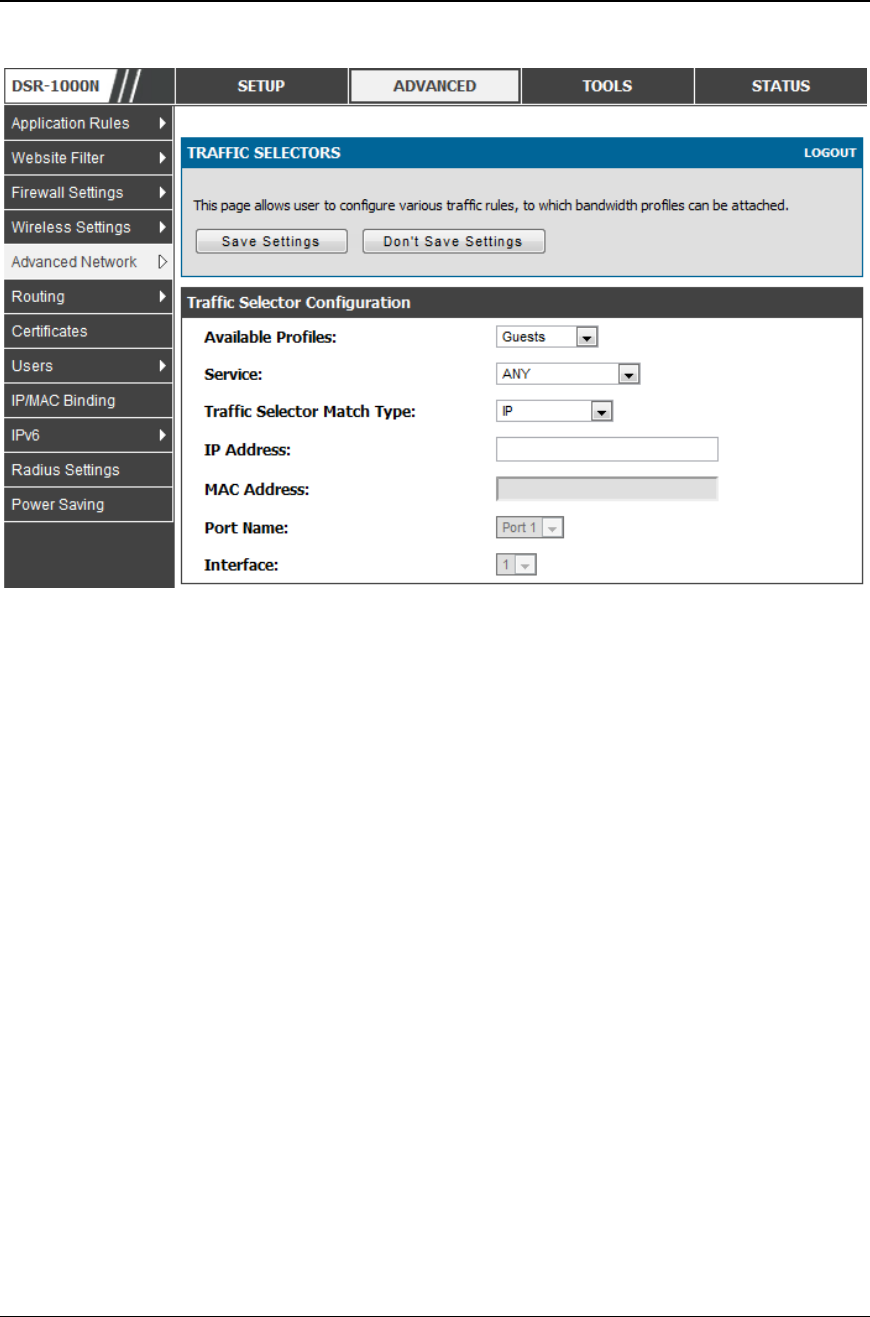
Unified Services Router User Manual
34
Figure 18: Traffic Selector Configuration
3.4 Features with Multiple WAN Links
This router supports multiple WAN links. This allows you to take advantage of
failover and load balancing features to ensure certain internet dependent services are
prioritized in the event of unstable WAN connectivity on one of the ports.
Setup > Internet Settings > WAN Mode
To use Auto Failover or Load Balancing, WAN link failure detection must be
configured. This involves accessing DNS servers on the internet or ping to an internet
address (user defined). If required, you can configure the number of retry attempts
when the link seems to be disconnected or the threshold of failures that determines if
a WAN port is down.
3.4.1 Auto Failover
In this case one of your WAN ports is assigned as the primary internet link for all
internet traffic. The secondary WAN port is used for redundancy in case the primary
link goes down for any reason. Both WAN ports (primary and secondary) must be
configured to connect to the respective ISP’s before enabling this feature. The
secondary WAN port will remain unconnected until a failure is detected on the
primary link (either port can be assigned as the primary). In the event of a failure on
the primary port, all internet traffic will be rolled over to the backup port. When
configured in Auto Failover mode, the link status of the primary WAN port is
checked at regular intervals as defined by the failure detection settings.

Unified Services Router User Manual
35
3.4.2 Load Balancing
This feature allows you to use multiple WAN links (and presumably multiple ISP’s)
simultaneously. After configuring more than one WAN port, the load balancing
option is available to carry traffic over more than one link. Protocol bindings are
used to segregate and assign services over one WAN port in order to manage
internet flow. The configured failure detection method is used at regular intervals on
all configured WAN ports when in Load Balancing mode.
Load balancing is particularly useful when the connection speed of one WAN port
greatly differs from another. In this case you can define protocol bindings to route
low-latency services (such as VOIP) over the higher-speed link and let low-volume
background traffic (such as SMPT) go over the lower speed link.
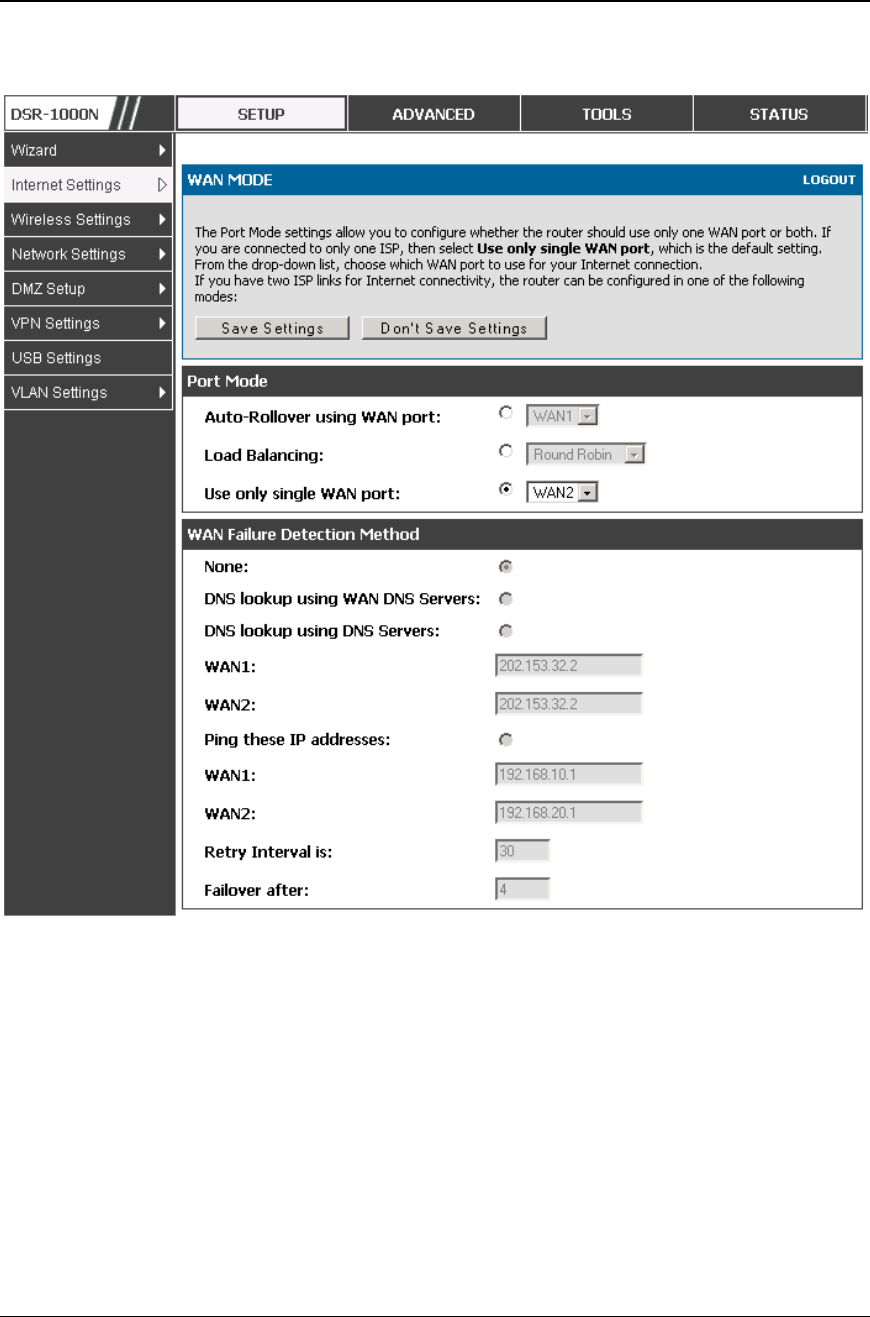
Unified Services Router User Manual
36
Figure 19: Load Balancing is available when multiple WAN ports are
configured and Protocol Bindings have been defined
3.4.3 Protocol Bindings
Advanced > Routing > Protocol Bindings
Protocol bindings are required when the Load Balancing feature is in use. Choosing
from a list of configured services or any of the user-defined services, the type of
traffic can be assigned to go over only one of the available WAN ports. For
increased flexibility the source network or machines can be specified as well as the
destination network or machines. For example the VOIP traffic for a set of LAN IP
addresses can be assigned to one WAN and any VIOP traffic from the remaining IP
addresses can be assigned to the other WAN link. Protocol bindings are only
applicable when load balancing mode is enabled and more than one WAN is
configured.
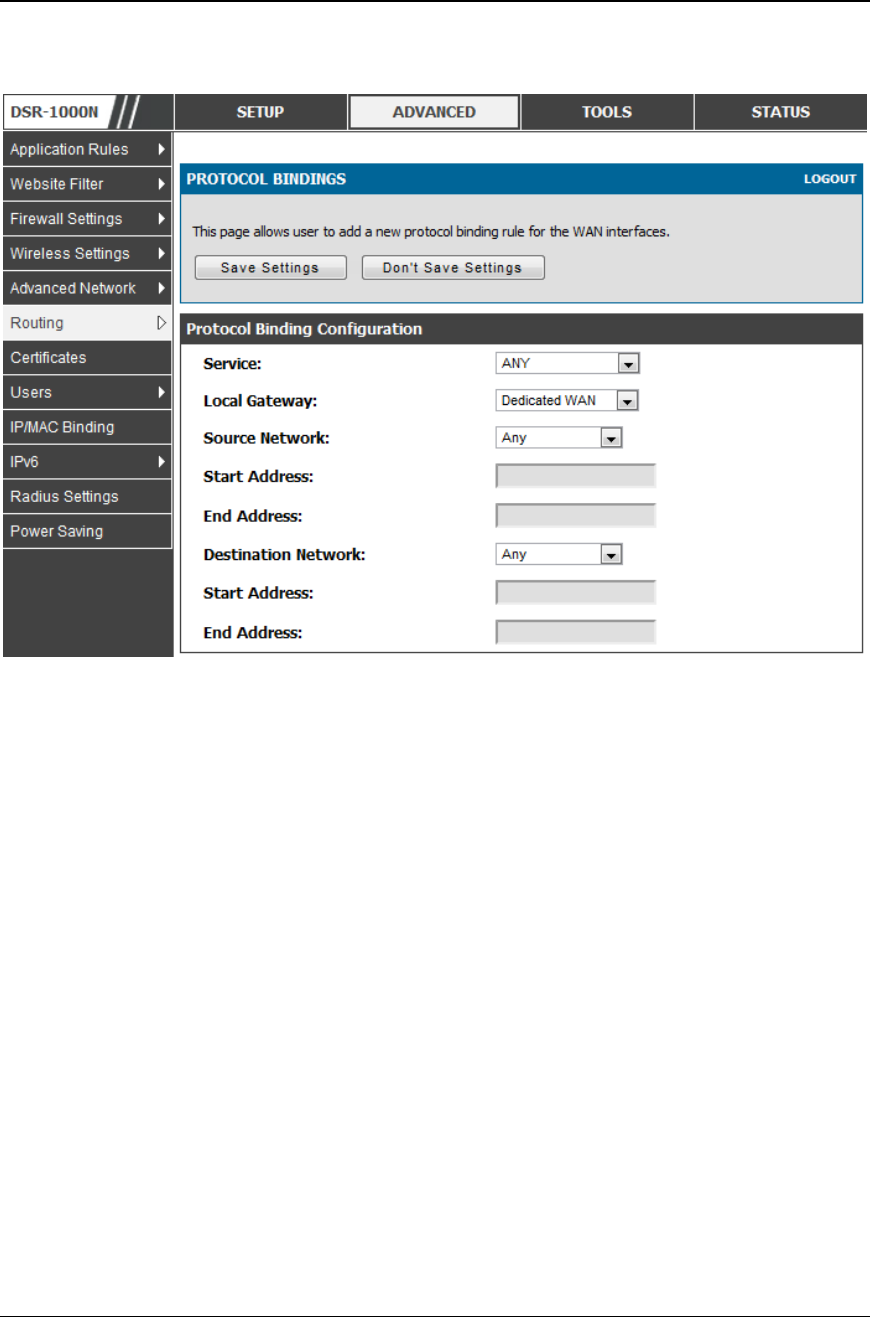
Unified Services Router User Manual
37
Figure 20: Protocol binding setup to associate a service and/or LAN
source to a WAN and/or destination network
3.5 Routing Configuration
Routing between the LAN and WAN will impact the way this router handles traffic
that is received on any of its physical interfaces. The routing mode of the gateway is
core to the behavior of the traffic flow between the secure LAN and the internet.
3.5.1 Routing Mode
Setup > Internet Settings > Routing Mode
This device supports classical routing, network address translation (NAT), and
transport mode routing.
• With classical routing, devices on the LAN can be directly accessed from
the internet by their public IP addresses (assuming appropriate firewall
settings). If your ISP has assigned an IP address for each of the computers
that you use, select Classic Routing.
• NAT is a technique which allows several computers on a LAN to share an
Internet connection. The computers on the LAN use a "private" IP address
range while the WAN port on the router is configured with a single "public"

Unified Services Router User Manual
38
IP address. Along with connection sharing, NAT also hides internal IP
addresses from the computers on the Internet. NAT is required if your ISP
has assigned only one IP address to you. The computers that connect
through the router will need to be assigned IP addresses from a private
subnet.
• Transparent mode routing between the LAN and WAN does not perform
NAT. Broadcast and multicast packets that arrive on the LAN interface are
switched to the WAN and vice versa, if they do not get filtered by firewall
or VPN policies. If the LAN and WAN are in the same broadcast domain,
select Transparent mode.
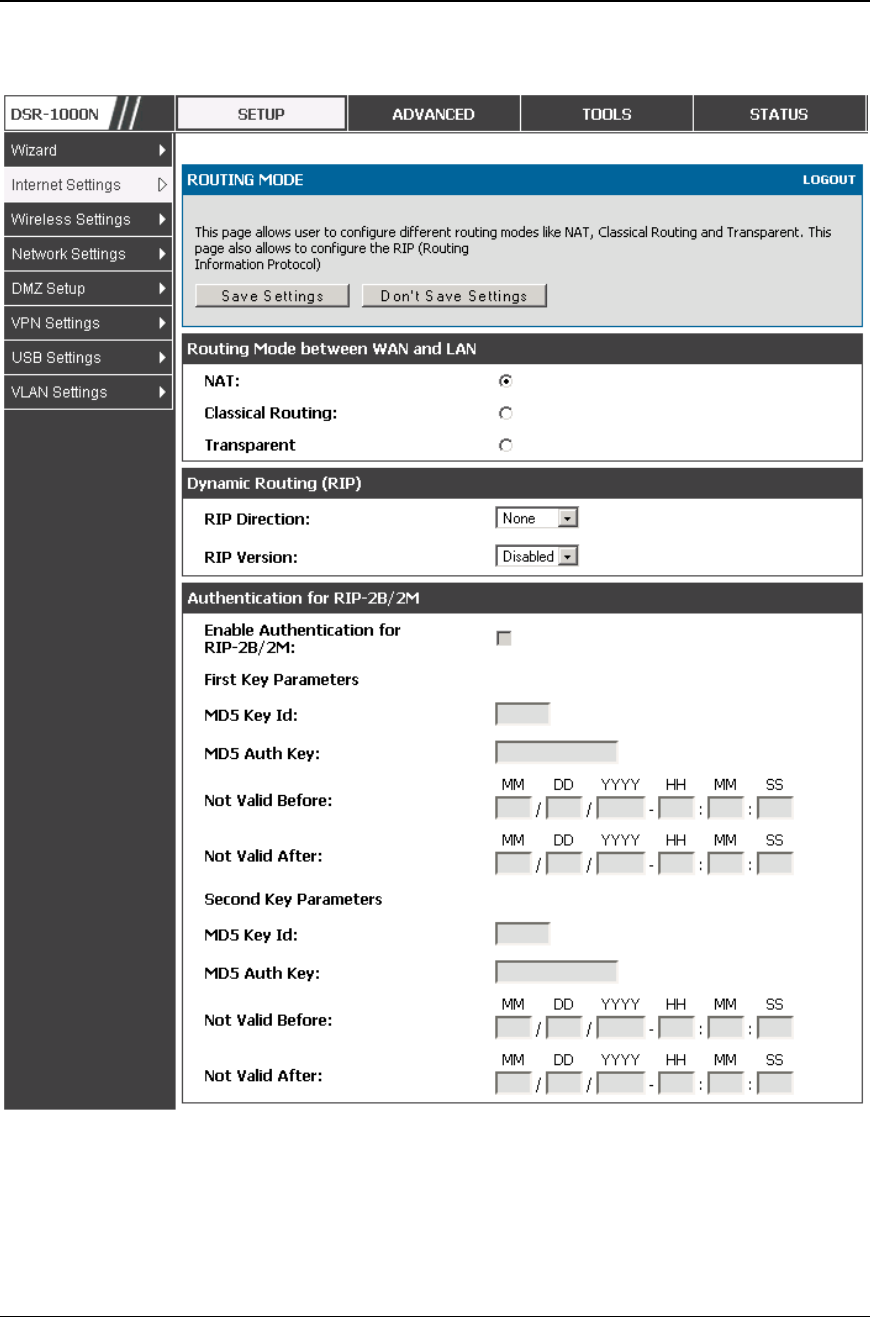
Unified Services Router User Manual
39
Figure 21: Routing Mode is used to configure traffic routing between
WAN and LAN, as well as Dynamic routing (RIP)
3.5.2 Dynamic Routing (RIP)
Setup > Internet Settings > Routing Mode

Unified Services Router User Manual
40
Dynamic routing using the Routing Information Protocol (RIP) is an Interior
Gateway Protocol (IGP) that is common in LANs. With RIP this router can exchange
routing information with other supported routers in the LAN and allow for dynamic
adjustment of routing tables in order to adapt to modifications in the LAN without
interrupting traffic flow.
The RIP direction will define how this router sends and receives RIP packets.
Choose between:
• Both: The router both broadcasts its routing table and also processes RIP
information received from other routers. This is the recommended setting in
order to fully utilize RIP capabilities.
• Out Only: The router broadcasts its routing table periodically but does not
accept RIP information from other routers.
• In Only: The router accepts RIP information from other routers, but does not
broadcast its routing table.
• None: The router neither broadcasts its route table nor does it accept any
RIP packets from other routers. This effectively disables RIP.
The RIP version is dependent on the RIP support of other routing devices in the
LAN.
• Disabled: This is the setting when RIP is disabled.
• RIP-1 is a class-based routing version that does not include subnet
information. This is the most commonly supported version.
• RIP-2 includes all the functionality of RIPv1 plus it supports subnet
information. Though the data is sent in RIP-2 format for both RIP-2B and
RIP-2M, the mode in which packets are sent is different. RIP-2B broadcasts
data in the entire subnet while RIP-2M sends data to multicast addresses.
If RIP-2B or RIP-2M is the selected version, authentication between this router and
other routers (configured with the same RIP version) is required. MD5
authentication is used in a first/second key exchange process. The authentication
key validity lifetimes are configurable to ensure that the routing information
exchange is with current and supported routers detected on the LAN.
3.5.3 Static Routing
Advanced > Routing > Static Routing
Advanced > IPv6 > IPv6 Static Routing
Manually adding static routes to this device allows you to define the path selection
of traffic from one interface to another. There is no communication between this
router and other devices to account for changes in the path; once configured the
static route will be active and effective until the network changes.

Unified Services Router User Manual
41
The List of Static Routes displays all routes that have been added manually by an
administrator and allows several operations on the static routes. The List of IPv4
Static Routes and List of IPv6 Static Routes share the same fields (with one
exception):
• Name: Name of the route, for identification and management.
• Active: Determines whether the route is active or inactive. A route can be
added to the table and made inactive, if not needed. This allows routes to be
used as needed without deleting and re-adding the entry. An inactive route is
not broadcast if RIP is enabled.
• Private: Determines whether the route can be shared with other routers when
RIP is enabled. If the route is made private, then the route will not be shared
in a RIP broadcast or multicast. This is only applicable for IPv4 static
routes.
• Destination: the route will lead to this destination host or IP address.
• IP Subnet Mask: This is valid for IPv4 networks only, and identifies the
subnet that is affected by this static route
• Interface: The physical network interface (WAN1, WAN2, DMZ or LAN),
through which this route is accessible.
• Gateway: IP address of the gateway through which the destination host or
network can be reached.
• Metric: Determines the priority of the route. If multiple routes to the same
destination exist, the route with the lowest metric is chosen.
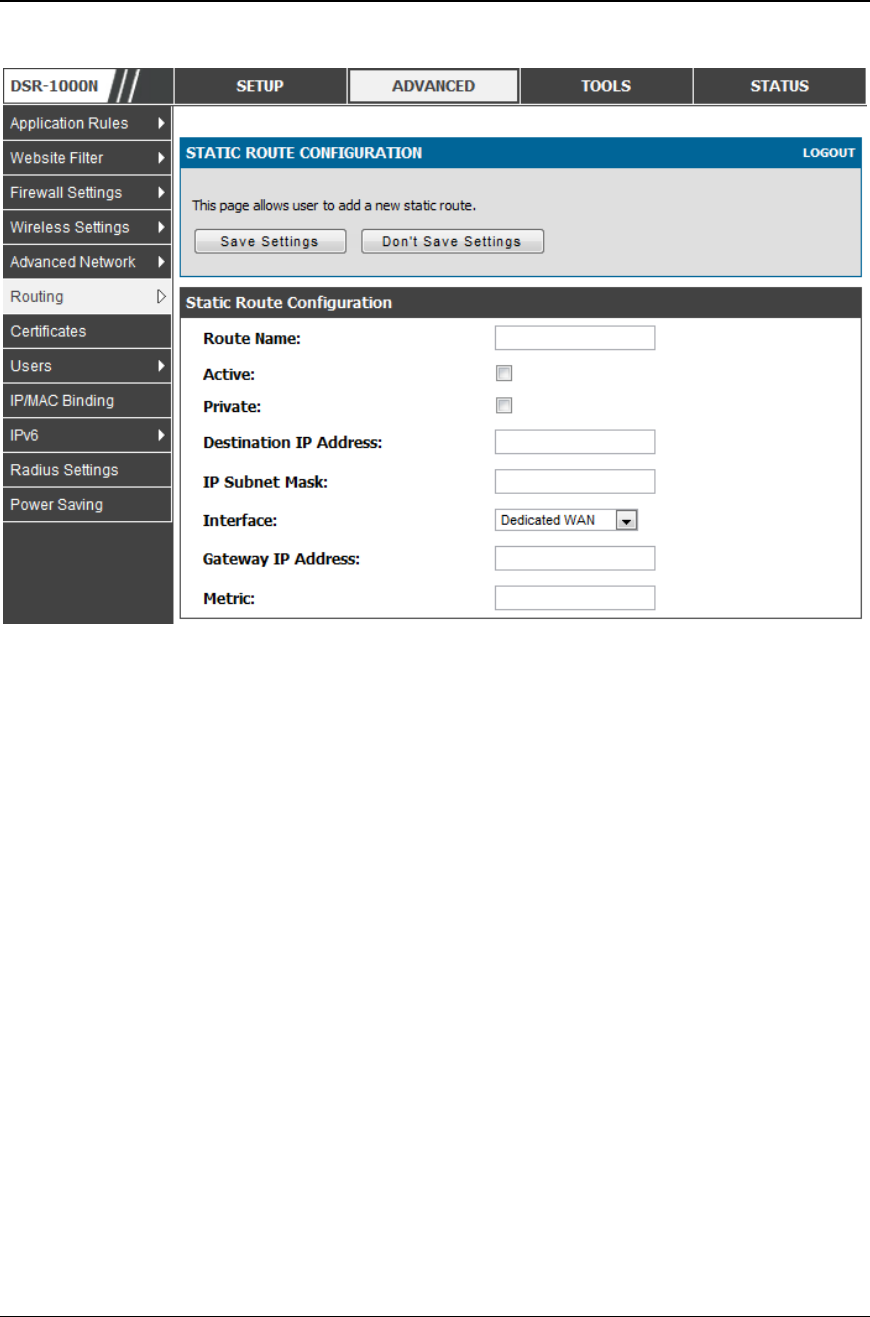
Unified Services Router User Manual
42
Figure 22: Static route configuration fields
3.6 Configurable Port - WAN Option
This router supports one of the physical ports to be configured as a secondary WAN
Ethernet port or a dedicated DMZ port. If the port is selected to be a secondary WAN
interface, all configuration pages relating to WAN2 are enabled.
Setup > Internet Settings > WAN2 Setup
WAN2 configuration is identical to the WAN1 configuration with one significant
exception: configuration for the 3G USB modem is available only on WAN2.
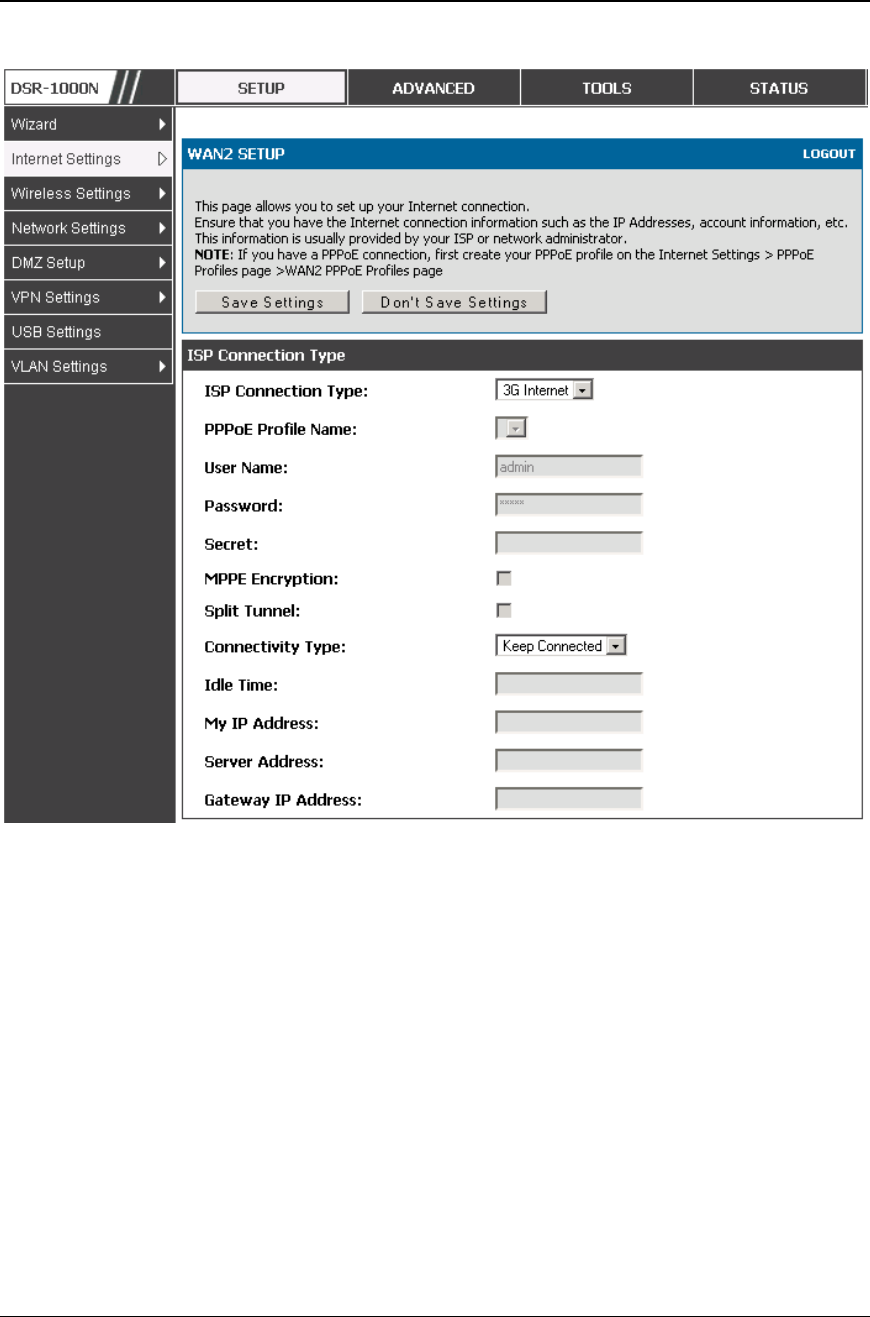
Unified Services Router User Manual
43
Figure 23: WAN2 configuration for 3G internet (part 1)
Cellular 3G internet access is available on WAN2 via a USB modem. The cellular ISP
that provides the 3G data plan will provide the authentication requirements to
establish a connection. The dial Number and APN are specific to the cellular carriers.
Once the connection type settings are configured and saved, navigate to the WAN
status page (Setup > Internet Settings > WAN Status) and Enable the WAN2 link
to establish the 3G connection.
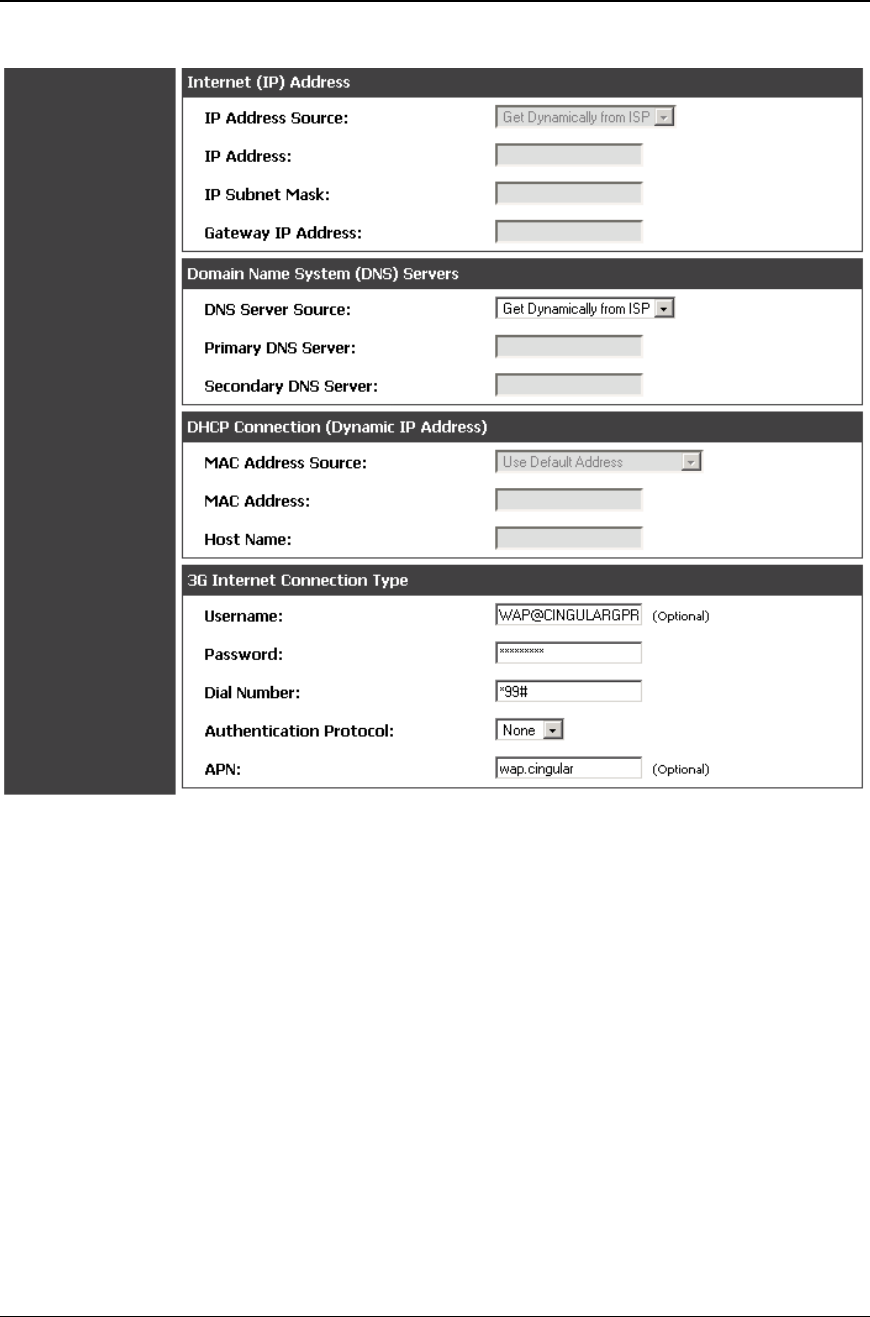
Unified Services Router User Manual
44
Figure 24: WAN2 configuration for 3G internet (part 2)
3.7 WAN Port Settings
Advanced > Advanced Network > WAN Port Setup
The physical port settings for each WAN link can be defined here. If your ISP account
defines the WAN port speed or is associated with a MAC address, this information is
required by the router to ensure a smooth connection with the network.
The default MTU size supported by all ports is 1500. This is the largest packet size
that can pass through the interface without fragmentation. This size can be increased,
however large packets can introduce network lag and bring down the interface speed.
Note that a 1500 byte size packet is the largest allowed by the Ethernet protocol at the
network layer.
The port speed can be sensed by the router when Auto is selected. With this option the
optimal port settings are determined by the router and network. The duplex (half or
full) can be defined based on the port support, as well as one of three port speeds: 10
Mbps, 100 Mbps and 1000 Mbps (i.e. 1 Gbps). The default setting is 100 Mbps for all
ports.
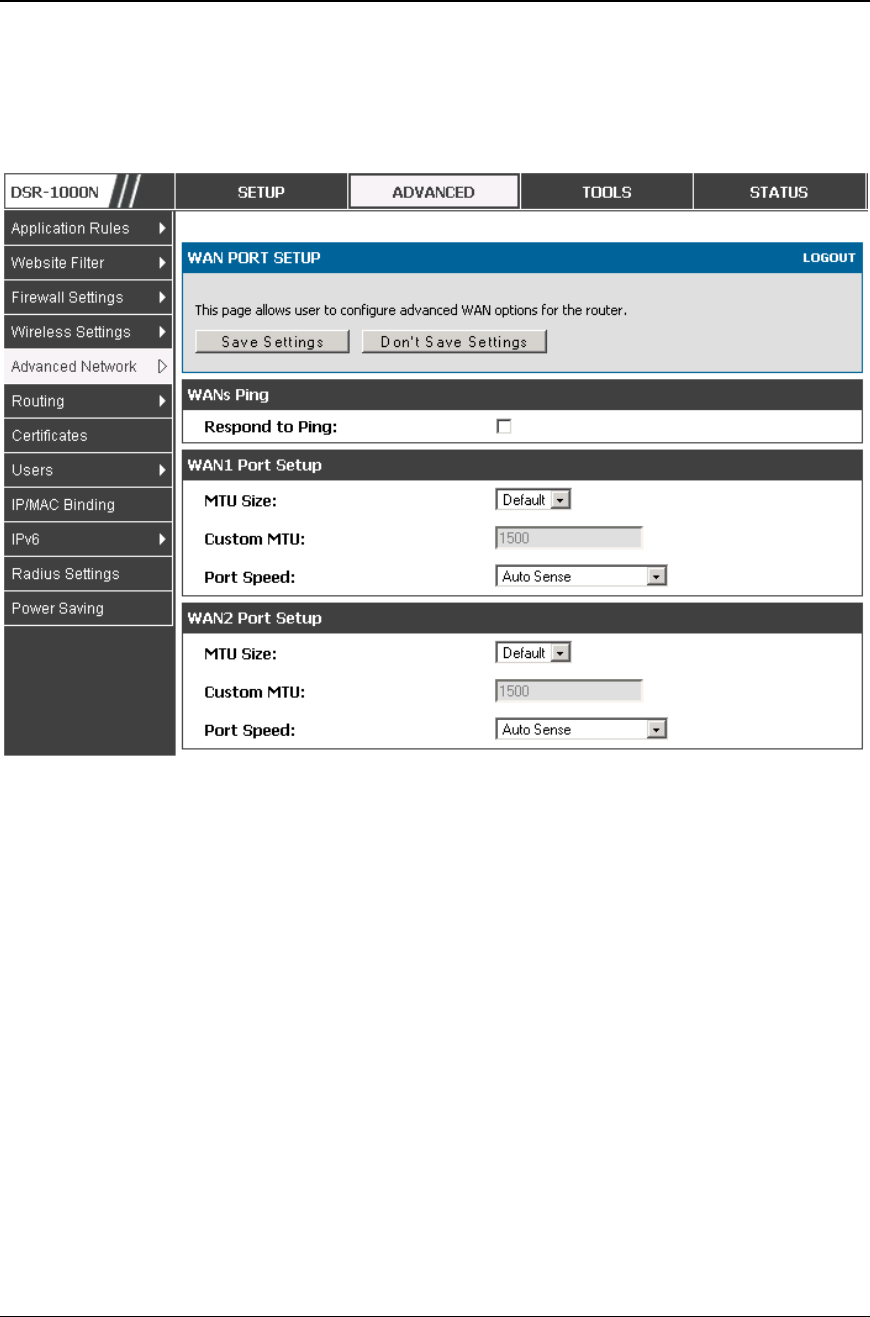
Unified Services Router User Manual
45
The default MAC address is defined during the manufacturing process for the
interfaces, and can uniquely identify this router. You can customize each WAN port’s
MAC address as needed, either by letting the WAN port assume the current LAN
host’s MAC address or by entering a MAC address manually.
Figure 25: Physical WAN port settings

Unified Services Router User Manual
46
Chapter 4. Wireless Access Point
Setup
This router has an integrated 802.11n radio that allows you to create an access point for
wireless LAN clients. The security/encryption/authentication options are grouped in a
wireless Profile, and each configured profile will be available for selection in the AP
configuration menu. The profile defines various parameters for the AP, including the
security between the wireless client and the AP, and can be shared between multiple
APs instances on the same device when needed.
Up to four unique wireless networks can be created by configuring multiple “virtual”
APs. Each such virtual AP appears as an independent AP (unique SSID) to supported
clients in the environment, but is actually running on the same physical radio integrated
with this router.
You will need the following information to configure your wireless network:
• Types of devices expected to access the wireless network and their supported Wi-
Fi™ modes
• The router’s geographical region
• The security settings to use for securing the wireless network.
Profiles may be thought of as a grouping of AP parameters that can then be applied
to not just one but multiple AP instances (SSIDs), thus avoiding duplication if the
same parameters are to be used on multiple AP instances or SSIDs.
4.1 Wireless Settings Wizard
Setup > Wizard > Wireless Settings
The Wireless Network Setup Wizard is available for users new to networking. By
going through a few straightforward configuration pages you can enable a Wi-Fi™
network on your LAN and allow supported 802.11 clients to connect to the configured
Access Point.
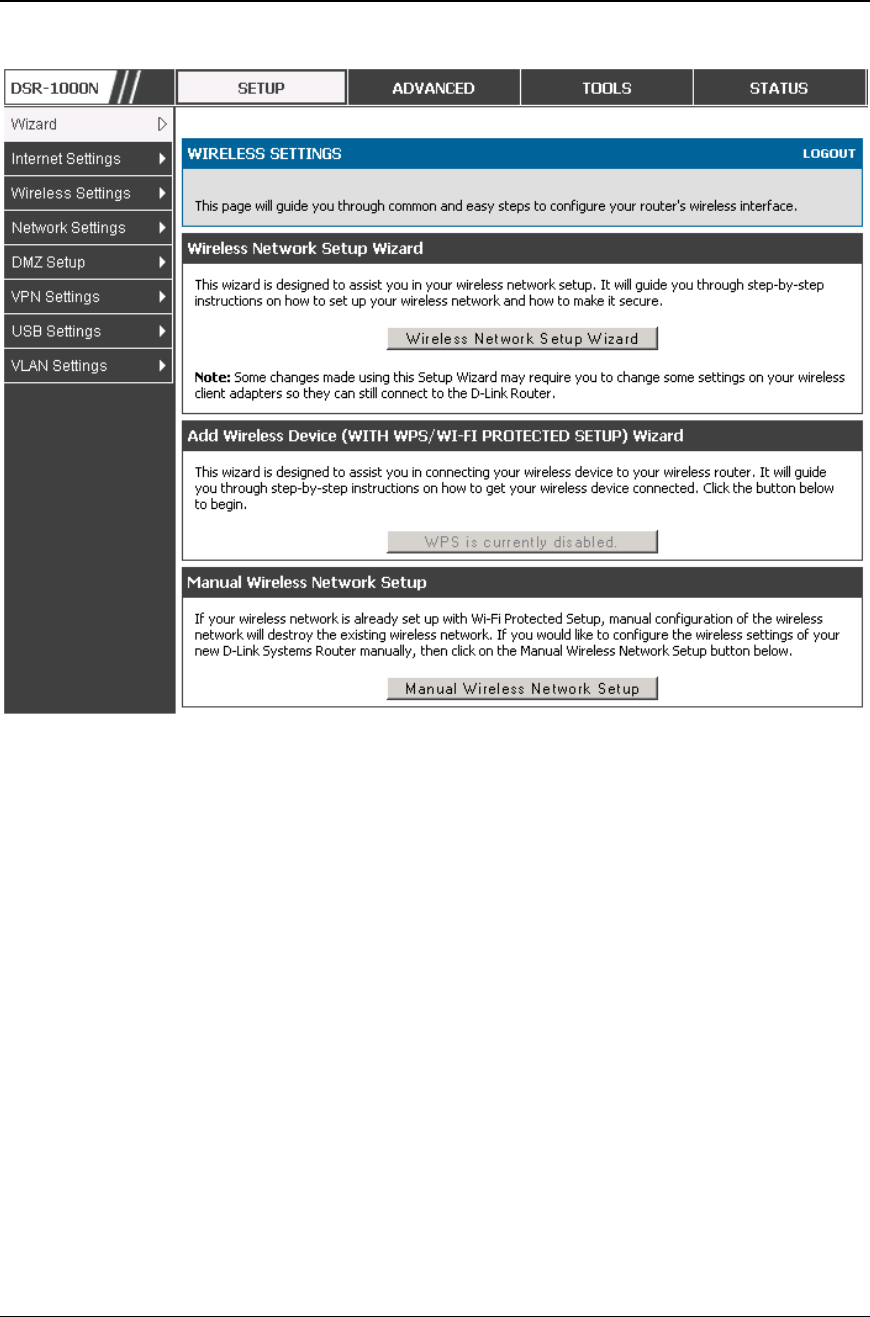
Unified Services Router User Manual
47
Figure 26: Wireless Network Setup Wizards
4.1.1 Wireless Network Setup Wizard
This wizard provides a step-by-step guide to create and secure a new access point on
the router. The network name (SSID) is the AP identifier that will be detected by
supported clients. The Wizard uses a TKIP+AES cipher for WPA / WPA2 security;
depending on support on the client side, devices associate with this AP using either
WPA or WPA2 security with the same pre-shared key.
The wizard has the option to automatically generate a network key for the AP. This
key is the pre-shared key for WPA or WPA2 type security. Supported clients that
have been given this PSK can associate with this AP. The default (auto-assigned)
PSK is “passphrase”.
The last step in the Wizard is to click the Connect button, which confirms the
settings and enables this AP to broadcast its availability in the LAN.
4.1.2 Add Wireless Device with WPS
With WPS enabled on your router, the selected access point allows supported WPS
clients to join the network very easily. When the Auto option for connecting a
wireless device is chose, you will be presented with two common WPS setup
options:

Unified Services Router User Manual
48
• Personal Identification Number (PIN): The wireless device that supports
WPS may have an alphanumeric PIN, and if entered in this field the AP will
establish a link to the client. Click Connect to complete setup and connect to
the client.
• Push Button Configuration (PBC): for wireless devices that support PBC,
press and hold down on this button and within 2 minutes, click the PBC
connect button. The AP will detect the wireless device and establish a link
to the client.
You need to enable at least one AP with WPA/WPA2 security and also enable WPS
in the Advanced > Wireless Settings > WPS page to use the WPS wizard.
4.1.3 Manual Wireless Network Setup
This button on the Wizard page will link to the Setup> Wireless Settings> Access
Points page. The manual options allow you to create new APs or modify the
parameters of APs created by the Wizard.
4.2 Wireless Profiles
Setup > Wireless Settings > Profiles
The profile allows you to assign the security type, encryption and authentication to
use when connecting the AP to a wireless client. The default mode is “open”, i.e. no
security. This mode is insecure as it allows any compatible wireless clients to connect
to an AP configured with this security profile.
To create a new profile, use a unique profile name to identify the combination of
settings. Configure a unique SSID that will be the identifier used by the clients to
communicate to the AP using this profile. By choosing to broadcast the SSID,
compatible wireless clients within range of the AP can detect this profile’s
availability.
The AP offers all advanced 802.11 security modes, including WEP, WPA, WPA2 and
WPA+WPA2 options. The security of the Access point is configured by the Wireless
Security Type section:
• Open: select this option to create a public “open” network to allow unauthenticated
devices to access this wireless gateway.
• WEP (Wired Equivalent Privacy): this option requires a static (pre-shared) key to
be shared between the AP and wireless client. Note that WEP does not support
802.11n data rates; is it appropriate for legacy 802.11 connections.
• WPA (Wi-Fi Protected Access): For stronger wireless security than WEP, choose
this option. The encryption for WPA will use TKIP and also CCMP if required. The
authentication can be a pre-shared key (PSK), Enterprise mode with RADIUS
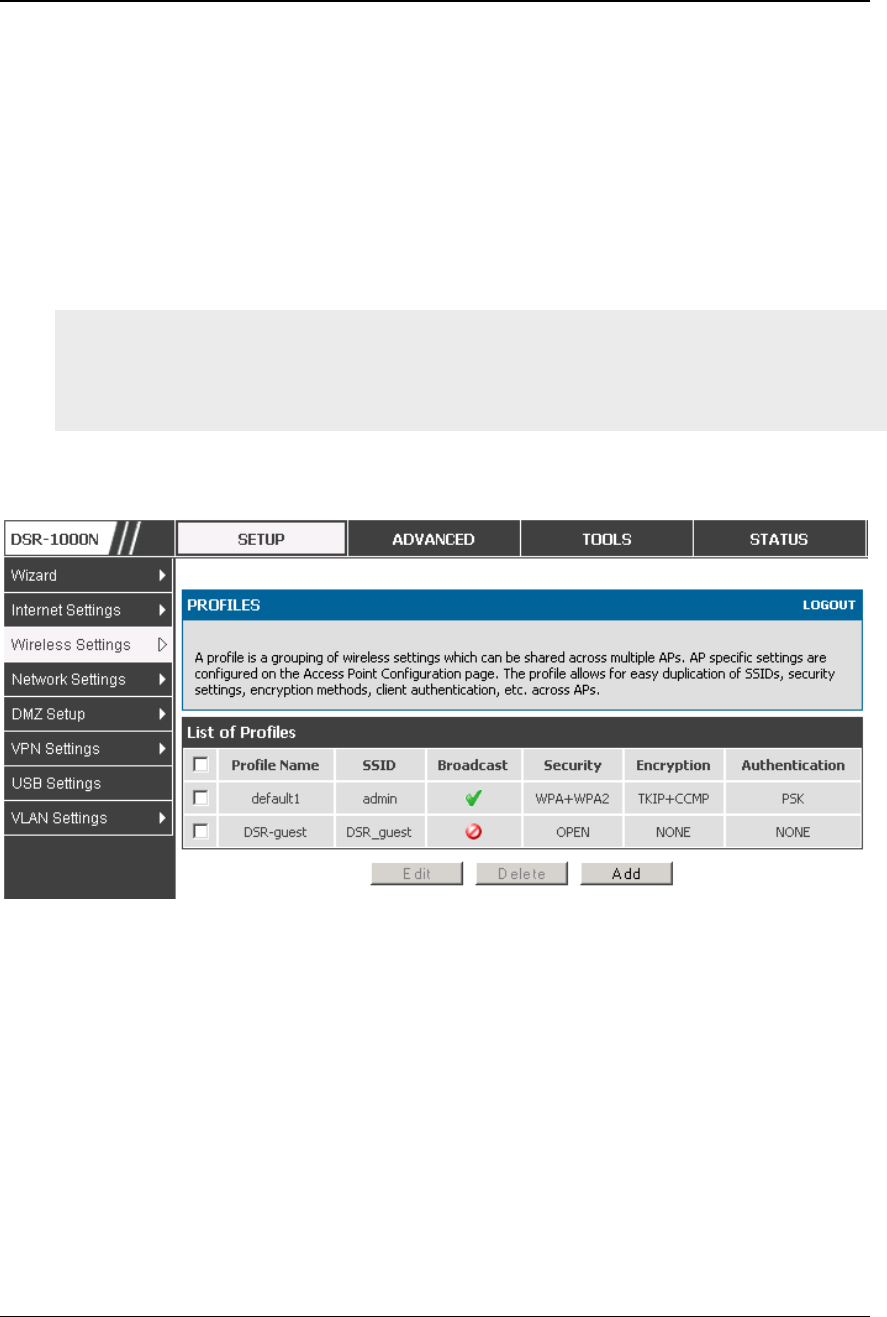
Unified Services Router User Manual
49
server, or both. Note that WPA does not support 802.11n data rates; is it
appropriate for legacy 802.11 connections.
• WPA2: this security type uses CCMP encryption (and the option to add TKIP
encryption) on either PSK (pre-shared key) or Enterprise (RADIUS Server)
authentication.
• WPA + WPA2: this uses both encryption algorithms, TKIP and CCMP. WPA
clients will use TKIP and WPA2 clients will use CCMP encryption algorithms.
“WPA+WPA2” is a security option that allows devices to connect to an AP using
the strongest security that it supports. This mode allows legacy devices that only
support WPA2 keys (such as an older wireless printer) to connect to a secure AP
where all the other wireless clients are using WPA2.
Figure 27: List of Available Profiles shows the variety of options
available to secure the wireless link
4.2.1 WEP Security
If WEP is the chosen security option, you must set a unique static key to be shared
with clients that wish to access this secured wireless network. This static key can be
generated from an easy-to-remember passphrase and the selected encryption length.
• Authentication: select between Open System, or Shared Key schemes
• Encryption: select the encryption key size -- 64 bit WEP or 128 bit WEP.
The larger size keys provide stronger encryption, thus making the key more
difficult to crack
• WEP Passphrase: enter a alphanumeric phrase and click Generate Key to
generate 4 unique WEP keys with length determined by the encryption key
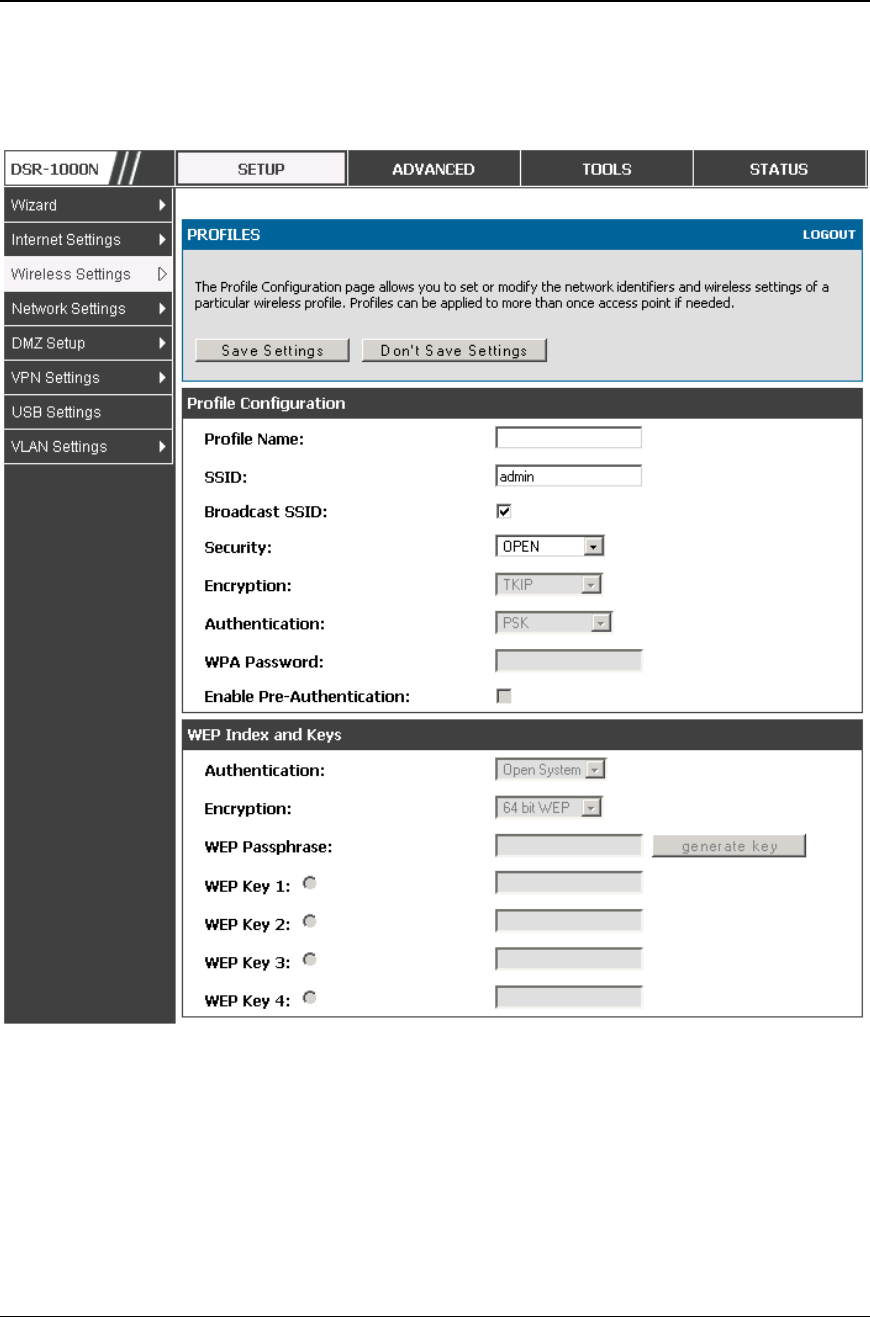
Unified Services Router User Manual
50
size. Next choose one of the keys to be used for authentication. The selected
key must be shared with wireless clients to connect to this device.
Figure 28: Profile configuration to set network security
4.2.2 WPA or WPA2 with PSK
A pre-shared key (PSK) is a known passphrase configured on the AP and client both
and is used to authenticate the wireless client. An acceptable passphrase is between
8 to 63 characters in length.

Unified Services Router User Manual
51
4.2.3 RADIUS Authentication
Setup > Wireless Settings > RADIUS Settings
Enterprise Mode uses a RADIUS Server for WPA and/or WPA2 security. A
RADIUS server must be configured and accessible by the router to authenticate
wireless client connections to an AP enabled with a profile that uses RADIUS
authentication.
• The Authentication IP Address is required to identify the server. A
secondary RADIUS server provides redundancy in the event that the primary
server cannot be reached by the router when needed.
• Authentication Port: the port for the RADIUS server connection
• Secret: enter the shared secret that allows this router to log into the
specified RADIUS server(s). This key must match the shared secret on the
RADIUS Server.
• The Timeout and Retries fields are used to either move to a secondary server
if the primary cannot be reached, or to give up the RADIUS authentication
attempt if communication with the server is not possible.
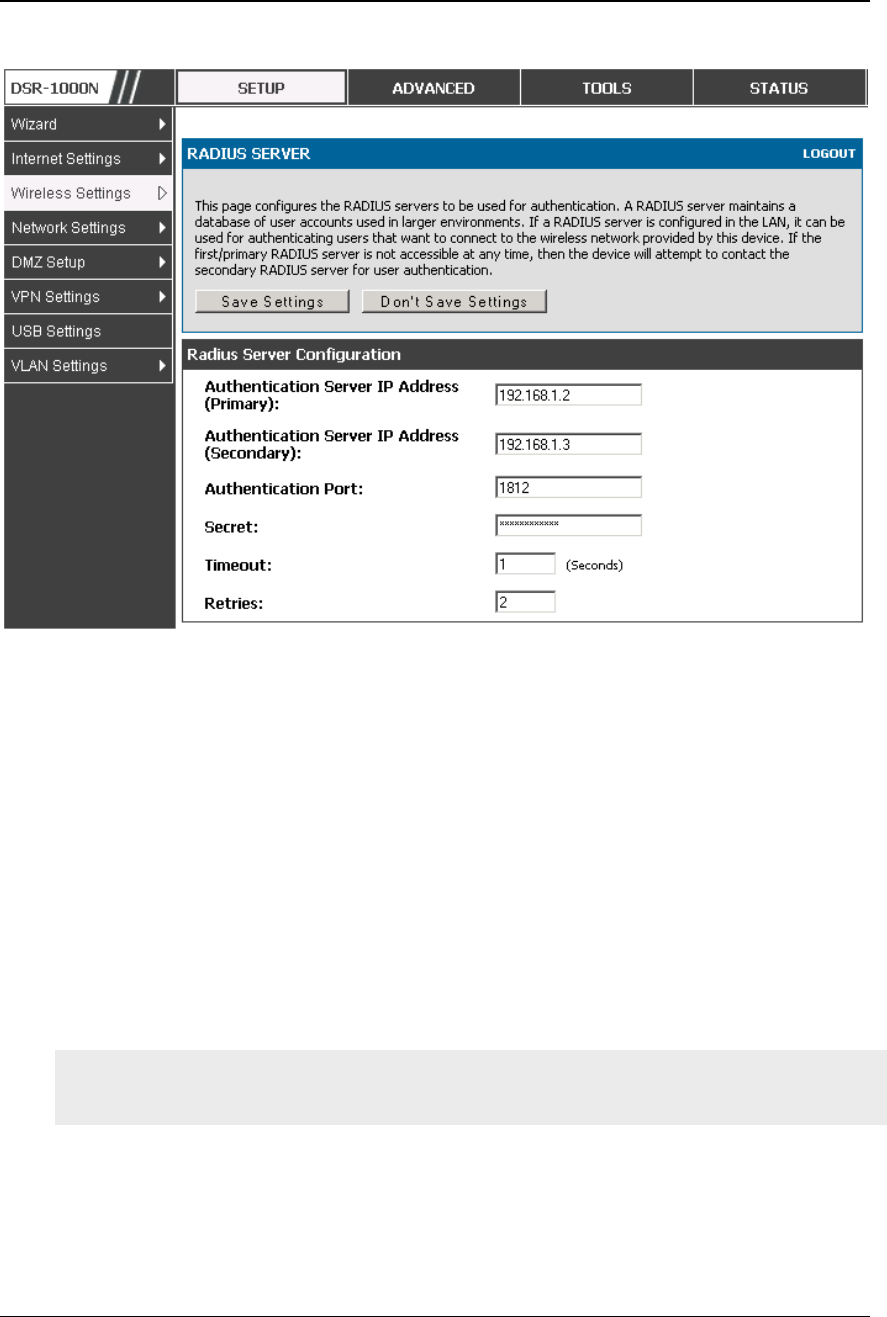
Unified Services Router User Manual
52
Figure 29: RADIUS server (External Authentication) configuration
4.3 Creating and Using Access Points
Setup > Wireless Settings > Access Points
Once a profile (a group of security settings) is created, it can be assigned to an AP on
the router. The AP SSID can be configured to broadcast its availability to the 802.11
environment can be used to establish a WLAN network.
The AP configuration page allows you to create a new AP and link to it one of the
available profiles. This router supports multiple AP’s referred to as virtual access
points (VAPs). Each virtual AP that has a unique SSIDs appears as an independent
access point to clients. This valuable feature allows the router’s radio to be
configured in a way to optimize security and throughput for a group of clients as
required by the user. To create a VAP, click the “add” button on the Setup >
Wireless Settings > Access Points page. After setting the AP name, the profile
dropdown menu is used to select one of the configured profiles.
The AP Name is a unique identifier used to manage the AP from the GUI, and is
not the SSID that is detected by clients when the AP has broadcast enabled.
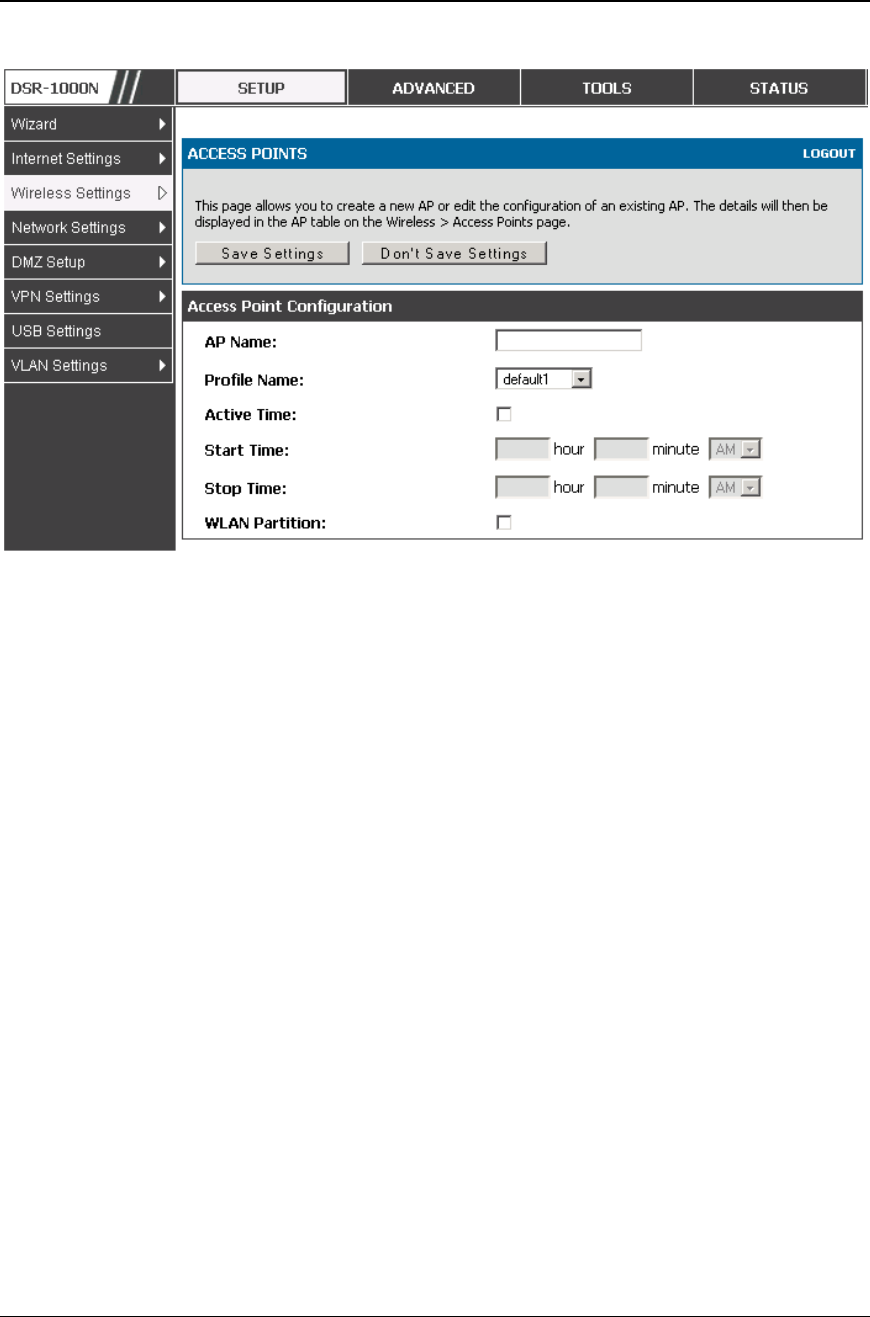
Unified Services Router User Manual
53
Figure 30: Virtual AP configuration
A valuable power saving feature is the start and stop time control for this AP. You
can conserve on the radio power by disabling the AP when it is not in use. For
example on evenings and weekends if you know there are no wireless clients, the start
and stop time will enable/disable the access point automatically.
Once the AP settings are configured, you must enable the AP on the radio on the
Setup > Wireless Settings > Access Points page. The status field changes to
“Enabled” if the AP is available to accept wireless clients. If the AP is configured to
broadcast its SSID (a profile parameter), a green check mark indicating it is
broadcasting will be shown in the List of Available Access points.
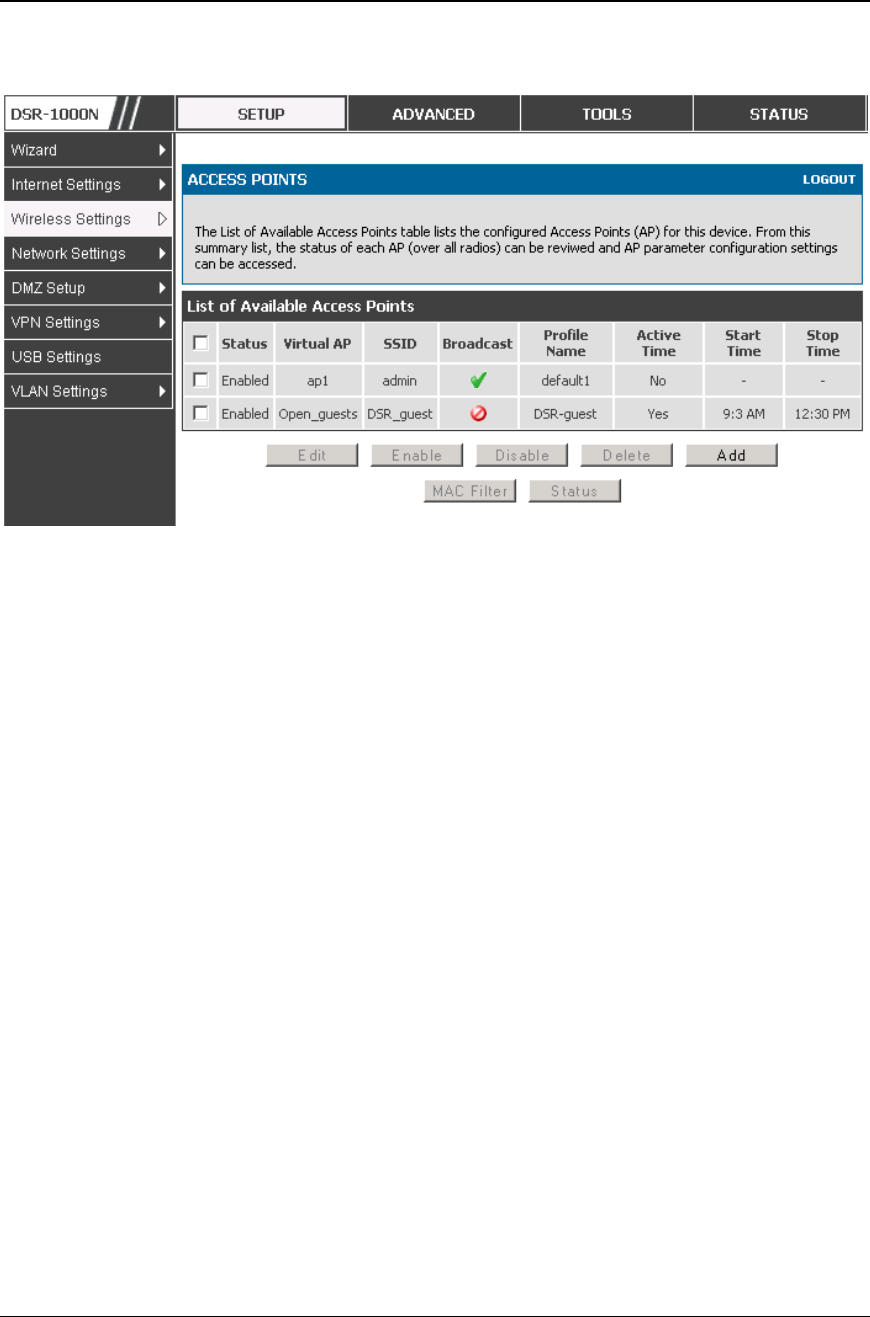
Unified Services Router User Manual
54
Figure 31: List of configured access points (Virtual APs) shows one
enabled access point on the radio, broadcasting its SSID
The clients connected to a particular AP can be viewed by using the Status Button on
the List of Available Access Points. Traffic statistics are shown for that individual
AP, as compared to the summary stats for each AP on the Statistics table. Connected
clients are sorted by the MAC address and indicate the security parameters used by
the wireless link, as well as the time connected to this particular AP. Clicking the
Details button next to the connected client will give the detailed send and receive
traffic statistics for the wireless link between this AP and the client.
4.3.1 Primary benefits of Virtual APs:
• Optimize throughput: if 802.11b, 802.11 g, and 802.11n clients are expected
to access the LAN via this router, creating 3 VAPs will allow you to manage
or shape traffic for each group of clients. A unique SSID can be created for
the network of 802.11b clients and another SSID can be assigned for the
802.11n clients. Each can have different security parameters – remember,
the SSID and security of the link is determined by the profile. In this way
legacy clients can access the network without bringing down the overall
throughput of more capable 802.11n clients.
• Optimize security: you may wish to support select legacy clients that only
offer WEP security while using WPA2 security for the majority of clients
for the radio. By creating two VAPs configured with different SSIDs and
different security parameters, both types of clients can connect to the LAN.
Since WPA2 is more secure, you may want to broadcast this SSID and not
broadcast the SSID for the VAP with WEP since it is meant to be used for a
few legacy devices in this scenario.
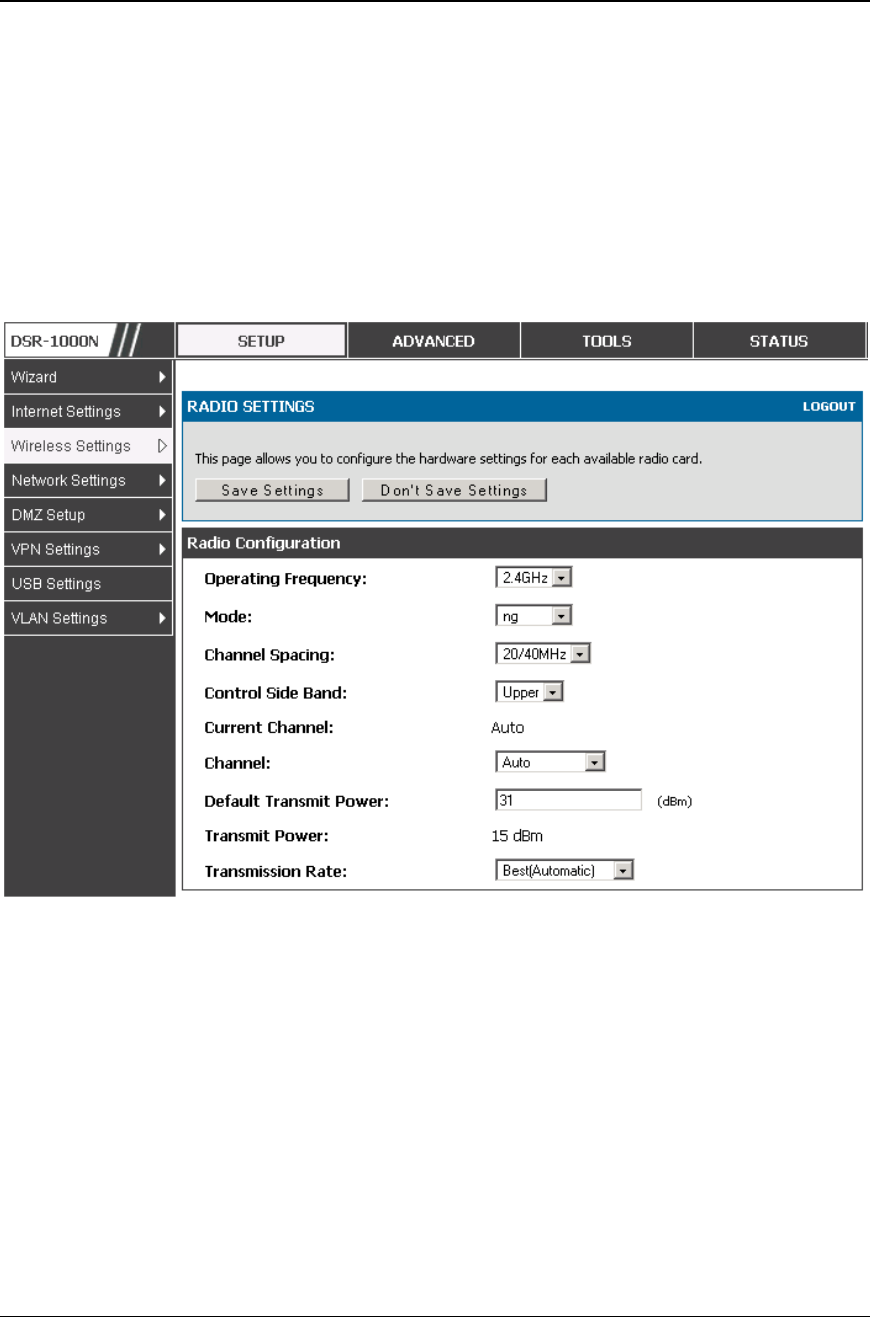
Unified Services Router User Manual
55
4.4 Tuning Radio Specific Settings
Setup > Wireless Settings > Radio Settings
The Radio Settings page lets you configure the channels and power levels available
for the AP’s enabled on the device. The router has a dual band 802.11n radio,
meaning either 2.4 GHz or 5 GHz frequency of operation can be selected (not
concurrently though). Based on the selected operating frequency, the mode selection
will let you define whether legacy connections or only 802.11n connections (or both)
are accepted on configured APs.
Figure 32: Radio card configuration options
The ratified 802.11n support on this radio requires selecting the appropriate broadcast
(NA or NG etc.) mode, and then defining the channel spacing and control side band
for 802.11n traffic. The default settings are appropriate for most networks. For
example, changing the channel spacing to 40 MHz can improve bandwidth at the
expense of supporting earlier 802.11n clients.
The available transmission channels are governed by regulatory constraints based on
the region setting of the router. The maximum transmission power is similarly
governed by regulatory limits; you have the option to decrease from the default
maximum to reduce the signal strength of traffic out of the radio.
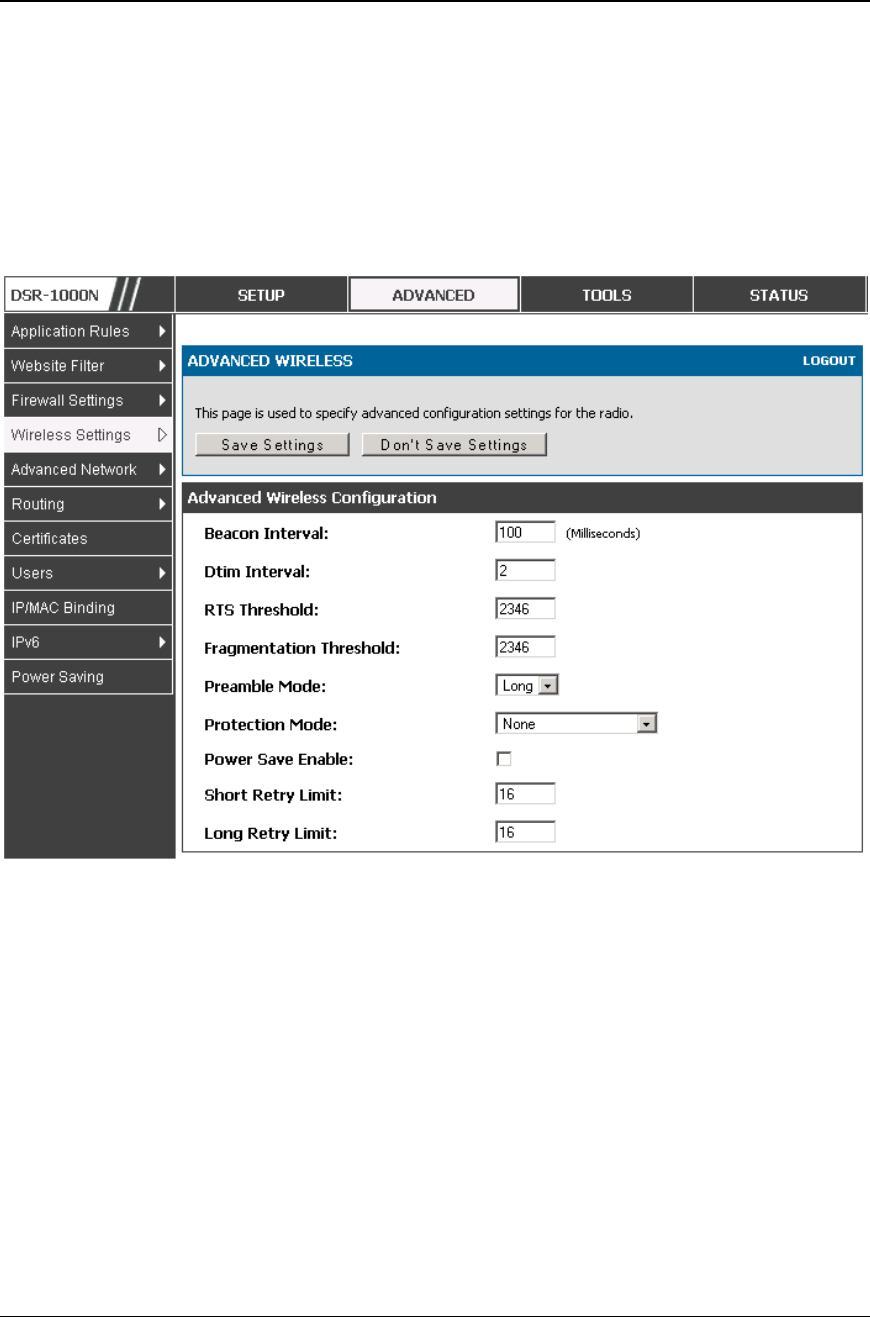
Unified Services Router User Manual
56
4.5 Advanced Wireless Settings
Advanced > Wireless Settings > Advanced Wireless
Sophisticated wireless administrators can modify the 802.11 communication
parameters in this page. Generally, the default settings are appropriate for most
networks. Please refer to the GUI integrated help text for further details on the use of
each configuration parameter.
Figure 33: Advanced Wireless communication settings
4.6 Wi-Fi Protected Setup (WPS)
Advanced > Wireless Settings > WPS
WPS is a simplified method to add supporting wireless clients to the network. WPS is
only applicable for APs that employ WPA or WPA2 security. To use WPS, select the
eligible VAPs from the dropdown list of APs that have been configured with this
security and enable WPS status for this AP.
The WPS Current Status section outlines the security, authentication, and encryption
settings of the selected AP. These are consistent with the AP’s profile. There are two
setup options available for WPS:
• Personal Identification Number (PIN): The wireless device that supports WPS
may have an alphanumeric PIN, if so add the PIN in this field. The router will
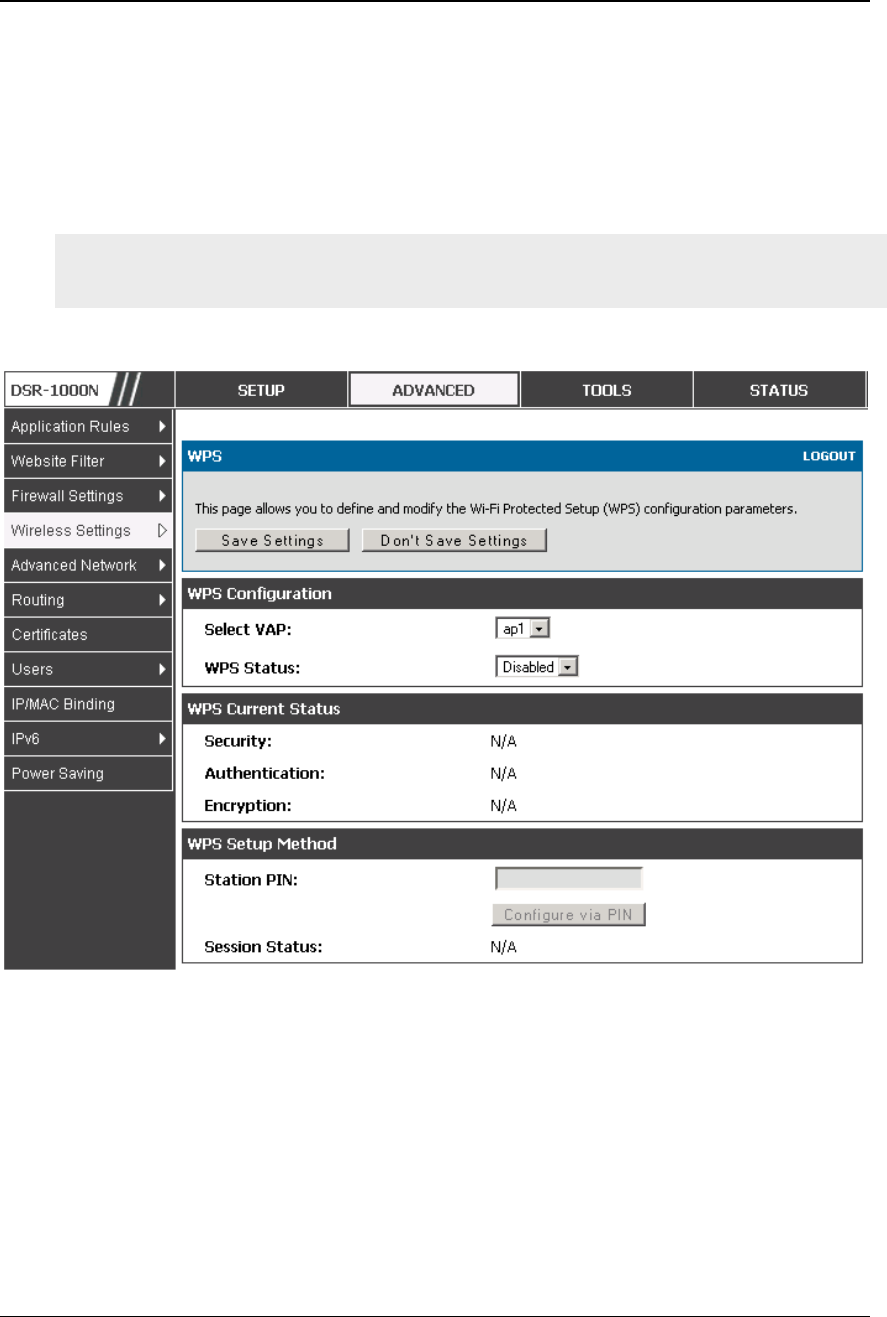
Unified Services Router User Manual
57
connect within 60 seconds of clicking the “Configure via PIN” button immediately
below the PIN field. There is no LED indication that a client has connected.
• Push Button Configuration (PBC): for wireless devices that support PBC, press
and hold down on this button and within 2 minutes click the PBC connect button.
The AP will detect the wireless device and establish a link to the client.
More than one AP can use WPS, but only one AP can be used to establish WPS
links to client at any given time.
Figure 34: WPS configuration for an AP with WPA/WPA2 profile

Chapter 5. Securing the Private
Network
You can secure your network by creating and applying rules that your router uses to
selectively block and allow inbound and outbound Internet traffic. You then specify
how and to whom the rules apply. To do so, you must define the following:
• Services or traffic types (examples: web browsing, VoIP, other standard services
and also custom services that you define)
• Direction for the traffic by specifying the source and destination of traffic; this is
done by specifying the “From Zone” (LAN/WAN/DMZ) and “To Zone”
(LAN/WAN/DMZ)
• Schedules as to when the router should apply rules
• Any Keywords (in a domain name or on a URL of a web page) that the router
should allow or block
• Rules for allowing or blocking inbound and outbound Internet traffic for specified
services on specified schedules
• MAC addresses of devices that should not access the internet
• Port triggers that signal the router to allow or block access to specified services as
defined by port number
• Reports and alerts that you want the router to send to you
You can, for example, establish restricted-access policies based on time-of-day, web
addresses, and web address keywords. You can block Internet access by applications
and services on the LAN, such as chat rooms or games. You can block just certain
groups of PCs on your network from being accessed by the WAN or public DMZ
network.
5.1 Firewall Rules
Advanced > Firewall Settings > Firewall Rules
Inbound (WAN to LAN/DMZ) rules restrict access to traffic entering your network,
selectively allowing only specific outside users to access specific local resources. By
default all access from the insecure WAN side are blocked from accessing the secure
LAN, except in response to requests from the LAN or DMZ. To allow outside devices
to access services on the secure LAN, you must create an inbound firewall rule for
each service.
If you want to allow incoming traffic, you must make the router’s WAN port IP
address known to the public. This is called “exposing your host.” How you make your
address known depends on how the WAN ports are configured; for this router you
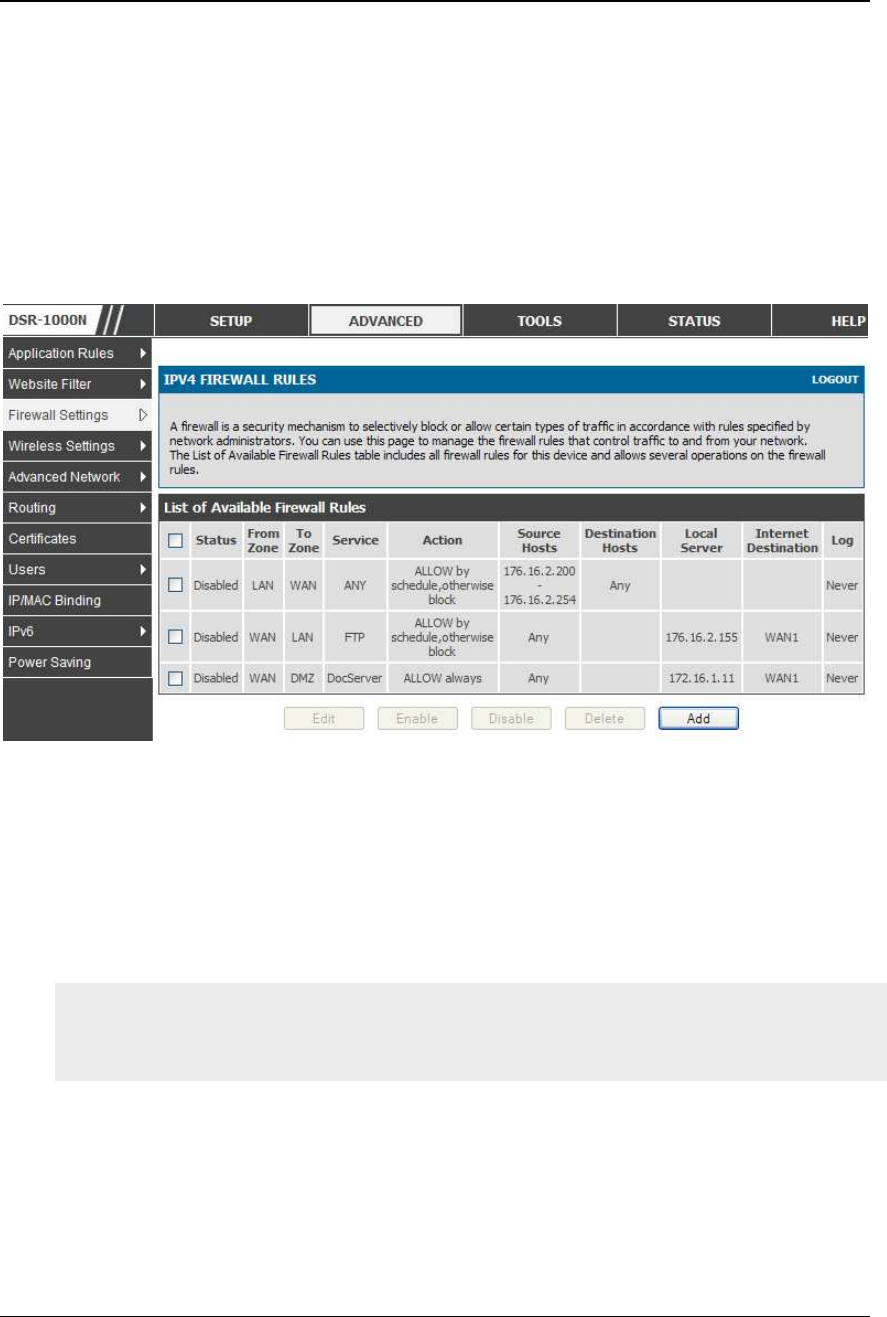
Unified Services Router User Manual
60
may use the IP address if a static address is assigned to the WAN port, or if your
WAN address is dynamic a DDNS (Dynamic DNS) name can be used.
Outbound (LAN/DMZ to WAN) rules restrict access to traffic leaving your network,
selectively allowing only specific local users to access specific outside resources. The
default outbound rule is to allow access from the secure zone (LAN) to either the
public DMZ or insecure WAN. You can change this default behavior in the Firewall
Settings > Default Outbound Policy page. When the default outbound policy is
allow always, you can to block hosts on the LAN from accessing internet services by
creating an outbound firewall rule for each service.
Figure 35: List of Available Firewall Rules
5.2 Defining Rule Schedules
Tools > Schedules
Firewall rules can be enabled or disabled automatically if they are associated with a
configured schedule. The schedule configuration page allows you to define days of
the week and the time of day for a new schedule, and then this schedule can be
selected in the firewall rule configuration page.
All schedules will follow the time in the routers configured time zone. Refer to the
section on choosing your Time Zone and configuring NTP servers for more
information.
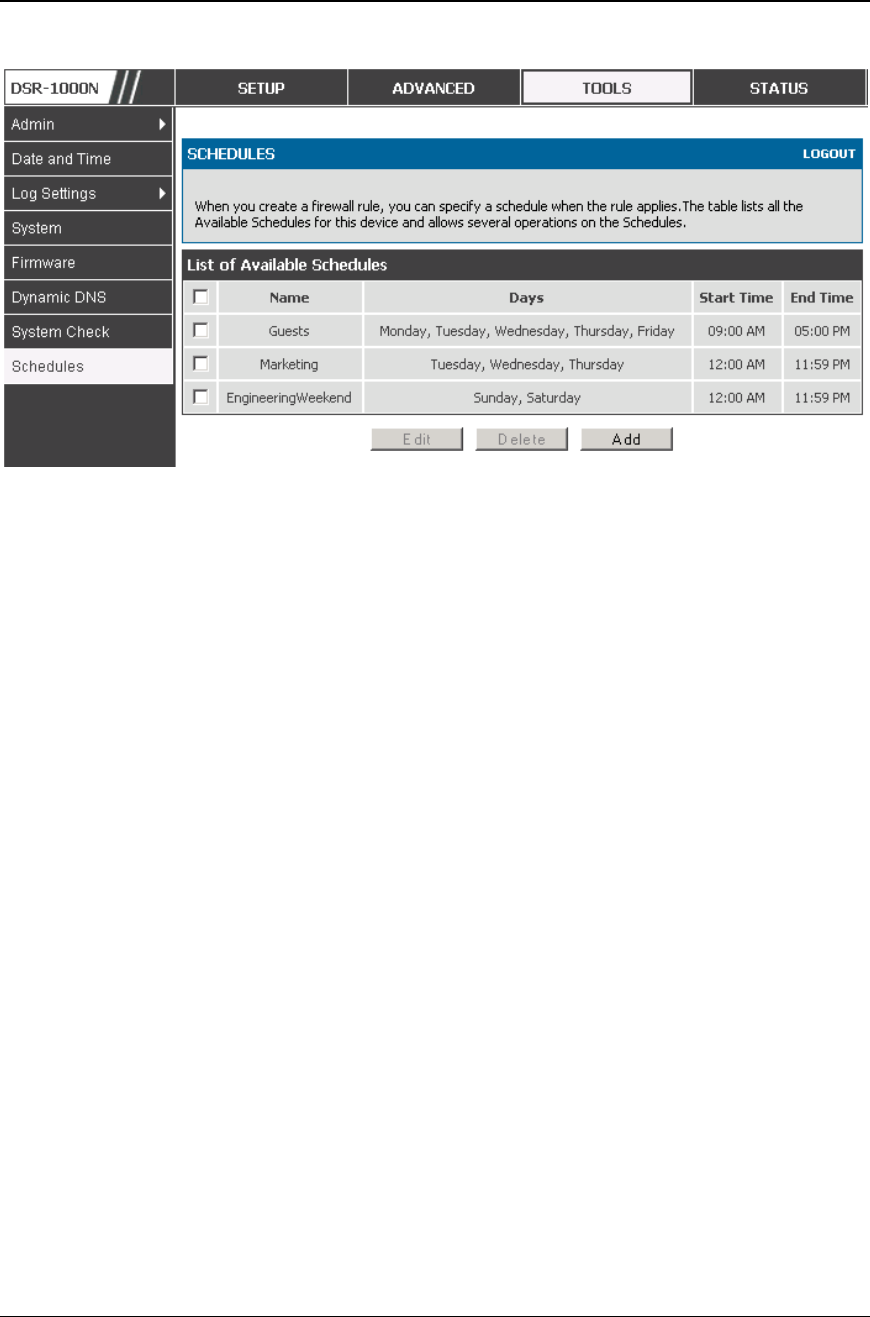
Unified Services Router User Manual
61
Figure 36: List of Available Schedules to bind to a firewall rule
5.3 Configuring Firewall Rules
Advanced > Firewall Settings > Firewall Rules
All configured firewall rules on the router are displayed in the Firewall Rules list.
This list also indicates whether the rule is enabled (active) or not, and gives a
summary of the From/To zone as well as the services or users that the rule affects.
To create a new firewall rules, follow the steps below:
1. View the existing rules in the List of Available Firewall Rules table.
2. To edit or add an outbound or inbound services rule, do the following:
• To edit a rule, click the checkbox next to the rule and click Edit to reach that rule’s
configuration page.
• To add a new rule, click Add to be taken to a new rule’s configuration page. Once
created, the new rule is automatically added to the original table.
3. Chose the From Zone to be the source of originating traffic: either the secure LAN, public
DMZ, or insecure WAN. For an inbound rule WAN should be selected as the From Zone.
4. Choose the To Zone to be the destination of traffic covered by this rule. If the From Zone
is the WAN, the To Zone can be the public DMZ or secure LAN. Similarly if the From
Zone is the LAN, then the To Zone can be the public DMZ or insecure WAN.
5. Parameters that define the firewall rule include the following:

Unified Services Router User Manual
62
• Service: ANY means all traffic is affected by this rule. For a specific service
the drop down list has common services, or you can select a custom defined
service.
• Action & Schedule: Select one of the 4 actions that this rule defines:
BLOCK always, ALLOW always, BLOCK by schedule otherwise ALLOW,
or ALLOW by schedule otherwise BLOCK. A schedule must be
preconfigured in order for it to be available in the dropdown list to assign to
this rule.
• Source & Destination users: For each relevant category, select the users to which
the rule applies:
• Any (all users)
• Single Address (enter an IP address)
• Address Range (enter the appropriate IP address range)
• Log: traffic that is filtered by this rule can be logged; this requires configuring the
router’s logging feature separately.
• QoS Priority: Outbound rules (where To Zone = insecure WAN only) can have the
traffic marked with a QoS priority tag. Select a priority level:
• Normal-Service: ToS=0 (lowest QoS)
• Minimize-Cost: ToS=1
• Maximize-Reliability: ToS=2
• Maximize-Throughput: ToS=4
• Minimize-Delay: ToS=8 (highest QoS)
6. Inbound rules can use Destination NAT (DNAT) for managing traffic from the WAN.
Destination NAT is available when the To Zone = DMZ or secure LAN.
• With an inbound allow rule you can enter the internal server address that is hosting
the selected service.
• You can enable port forwarding for an incoming service specific rule (From Zone =
WAN) by selecting the appropriate checkbox. This will allow the selected service
traffic from the internet to reach the appropriate LAN port via a port forwarding
rule.
• Translate Port Number: With port forwarding, the incoming traffic to be forwarded
to the port number entered here.

Unified Services Router User Manual
63
• External IP address: The rule can be bound to a specific WAN interface by
selecting either the primary WAN or configurable port WAN as the source IP
address for incoming traffic.
This router supports multi-NAT and so the External IP address does not necessarily
have to be the WAN address. On a single WAN interface, multiple public IP
addresses are supported. If your ISP assigns you more than one public IP address,
one of these can be used as your primary IP address on the WAN port, and the
others can be assigned to servers on the LAN or DMZ. In this way the LAN/DMZ
server can be accessed from the internet by its aliased public IP address.
7. Outbound rules can use Source NAT (SNAT) in order to statically map (bind) all
LAN/DMZ traffic matching the rule parameters to a specific WAN interface or external IP
address (usually provided by your ISP).
Once the new or modified rule parameters are saved, it appears in the master list of
firewall rules. To enable or disable a rule, click the checkbox next to the rule in the
list of firewall rules and choose Enable or Disable.
The router applies firewall rules in the order listed. As a general rule, you should
move the strictest rules (those with the most specific services or addresses) to the
top of the list. To reorder rules, click the checkbox next to a rule and click up or
down.
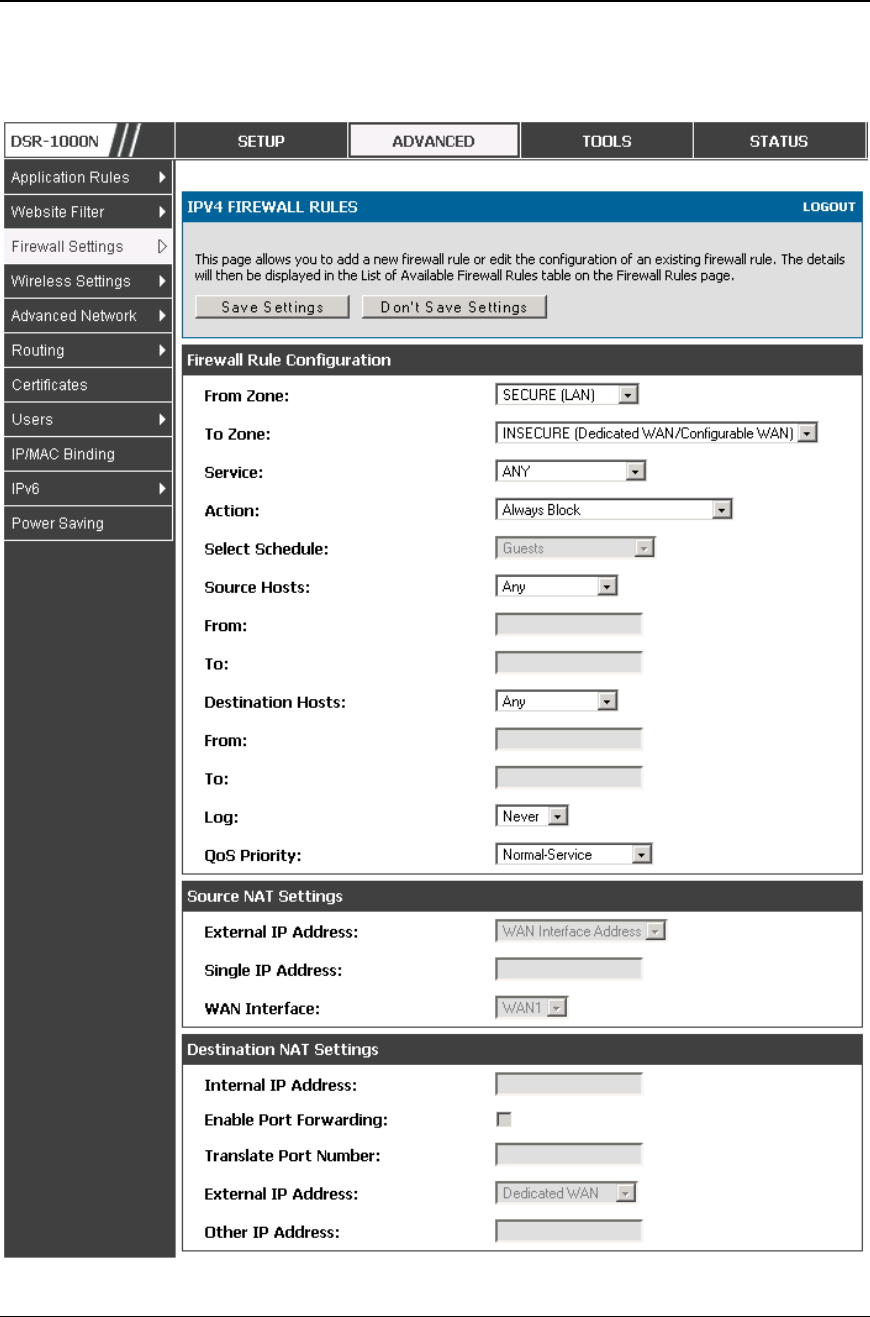
Unified Services Router User Manual
64
Figure 37: The firewall rule configuration page allows you to define the
To/From zone, service, action, schedules, and specify
source/destination IP addresses as needed.

Unified Services Router User Manual
65
5.3.1 Firewall Rule Configuration Examples
Example 1: Allow inbound HTTP traffic to the DMZ
Situation: You host a public web server on your local DMZ network. You want to
allow inbound HTTP requests from any outside IP address to the IP address of your
web server at any time of day.
Solution: Create an inbound rule as follows.
Parameter Value
From Zone Insecure (WAN1/WAN2)
To Zone Public (DMZ)
Service HTTP
Action ALLOW always
Send to Local Server (DNAT IP) 192.168.5.2 (web server IP address)
Destination Users Any
Log Never
Example 2: Allow videoconferencing from range of outside IP addresses
Situation: You want to allow incoming videoconferencing to be initiated from a
restricted range of outside IP addresses (132.177.88.2 - 132.177.88.254), from a
branch office.
Solution: Create an inbound rule as follows. In the example, CUSeeMe (the video
conference service used) connections are allowed only from a specified range of
external IP addresses.
Parameter Value
From Zone Insecure (WAN1/WAN2)
To Zone Secure (LAN)
Service CU-SEEME:UDP
Action ALLOW always
Send to Local Server (DNAT IP) 192.168.10.11
Destination Users Address Range
From 132.177.88.2
To 134.177.88.254
Enable Port Forwarding Yes (enabled)
Example 3: Multi-NAT configuration
Situation: You want to configure multi-NAT to support multiple public IP
addresses on one WAN port interface.
Solution: Create an inbound rule that configures the firewall to host an additional
public IP address. Associate this address with a web server on the DMZ. If you

Unified Services Router User Manual
66
arrange with your ISP to have more than one public IP address for your use, you can
use the additional public IP addresses to map to servers on your LAN. One of these
public IP addresses is used as the primary IP address of the router. This address is
used to provide Internet access to your LAN PCs through NAT. The other addresses
are available to map to your DMZ servers.
The following addressing scheme is used to illustrate this procedure:
Router
• WAN IP address: 10.1.0.118
• LAN IP address: 192.168.10.1; subnet 255.255.255.0
• Web server host in the DMZ, IP address: 192.168.12.222
• Access to Web server: (simulated) public IP address 10.1.0.52
E
x
a
m
p
l
e
4
:
B
l
o
c
k traffic by schedule if generated from specific range of machines
Use Case: Block all HTTP traffic on the weekends if the request originates from a
specific group of machines in the LAN having a known range of IP addresses, and
anyone coming in through the Network from the WAN (i.e. all remote users).
Configuration:
1. Setup a schedule:
• To setup a schedule that affects traffic on weekends only, navigate to
Security: Schedule, and name the schedule “Weekend”
• Define “weekend” to mean 12 am Saturday morning to 12 am Monday
morning – all day Saturday & Sunday
• In the Scheduled days box, check that you want the schedule to be active for
“specific days”. Select “Saturday” and “Sunday”
• In the scheduled time of day, select “all day” – this will apply the schedule
between 12 am to 11:59 pm of the selected day.
Parameter Value
From Zone Insecure (WAN1/WAN2)
To Zone Public (DMZ)
Service HTTP
Action ALLOW always
Send to Local Server (DNAT IP) 192.168.12.222 ( web server local IP address)
Destination Users Single Address
From 10.1.0.52
WAN Users Any
Log Never
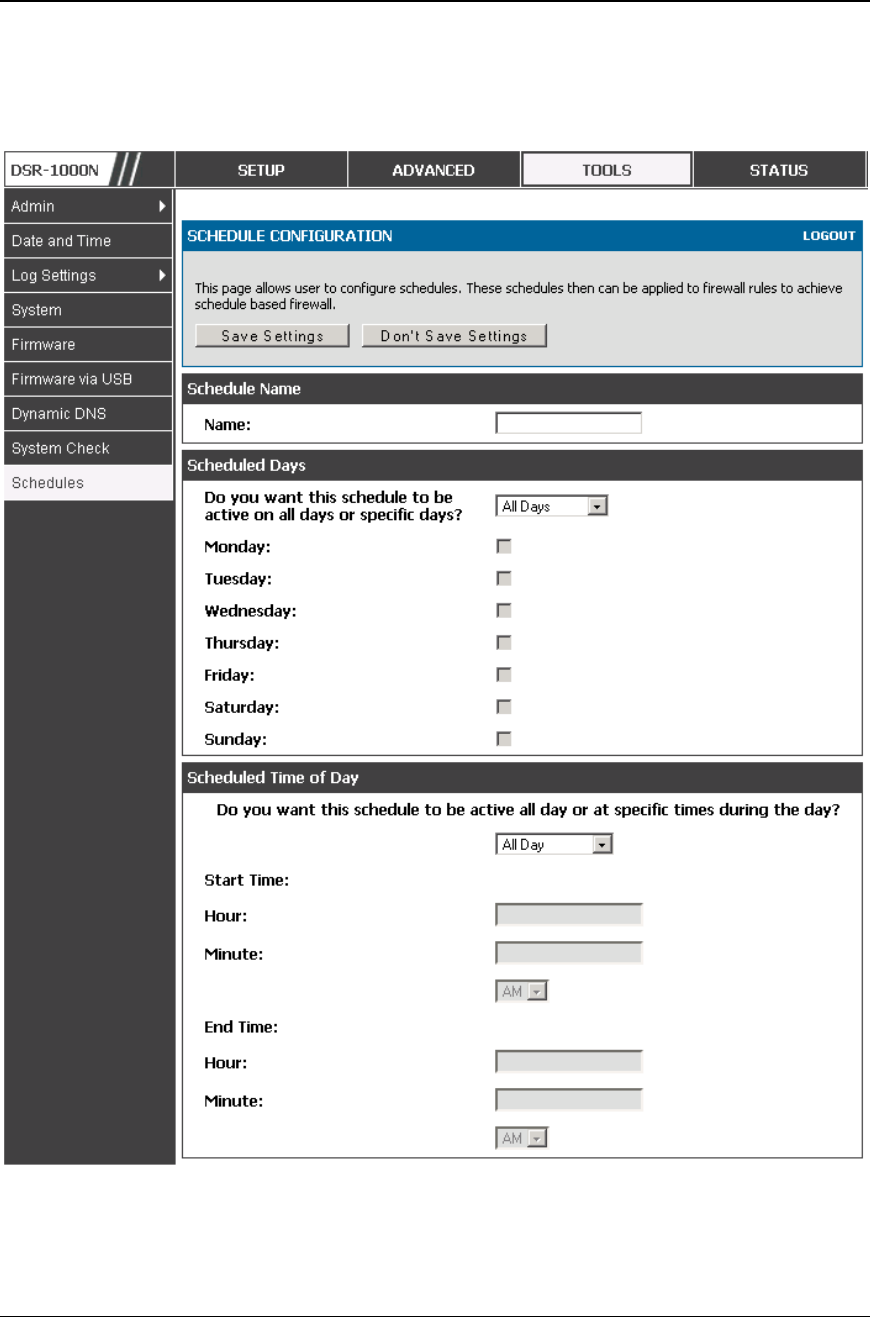
Unified Services Router User Manual
67
• Click apply – now schedule “Weekend” isolates all day Saturday and
Sunday from the rest of the week.
Figure 38: Schedule configuration for the above example.
2. Since we are trying to block HTTP requests, it is a service with To Zone: Insecure
(WAN1/WAN2) that is to be blocked according to schedule “Weekend”.

Unified Services Router User Manual
68
3. Select the Action to “Block by Schedule, otherwise allow”. This will take a predefined
schedule and make sure the rule is a blocking rule during the defined dates/times. All
other times outside the schedule will not be affected by this firewall blocking rule
4. As we defined our schedule in schedule “Weekend”, this is available in the dropdown
menu
5. We want to block the IP range assigned to the marketing group. Let’s say they have IP
192.168.10.20 to 192.168.10.30. On the Source Users dropdown, select Address Range
and add this IP range as the From and To IP addresses.
6. We want to block all HTTP traffic to any services going to the insecure zone. The
Destination Users dropdown should be “any”.
7. We don’t need to change default QoS priority or Logging (unless desired) – clicking apply
will add this firewall rule to the list of firewall rules.
8. The last step is to enable this firewall rule. Select the rule, and click “enable” below the
list to make sure the firewall rule is active
5.4 Security on Custom Services
Advanced > Firewall Settings > Custom Services
Custom services can be defined to add to the list of services available during firewall
rule configuration. While common services have known TCP/UDP/ICMP ports for
traffic, many custom or uncommon applications exist in the LAN or WAN. In the
custom service configuration menu you can define a range of ports and identify the
traffic type (TCP/UDP/ICMP) for this service. Once defined, the new service will
appear in the services list of the firewall rules configuration menu.
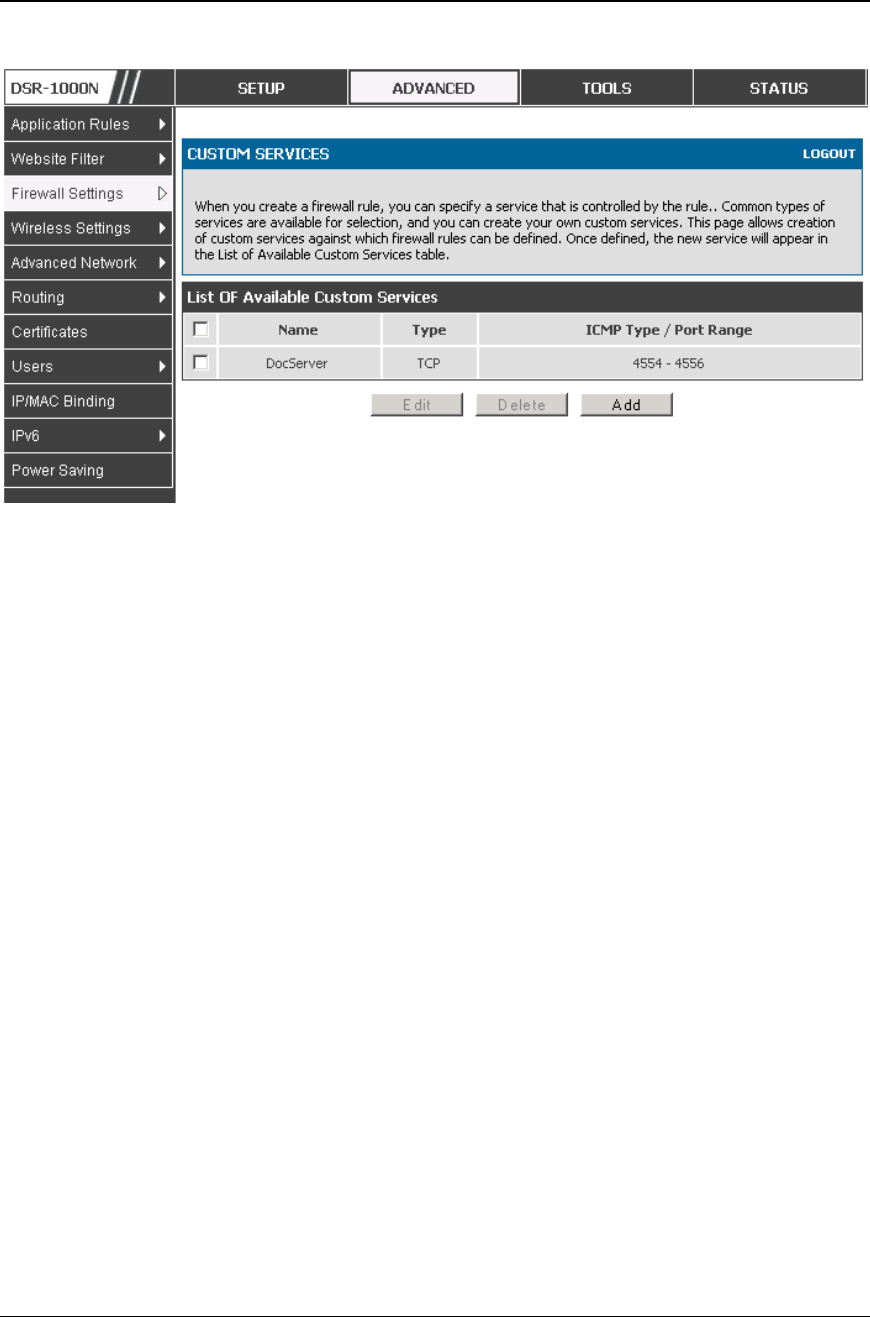
Unified Services Router User Manual
69
Figure 39: List of user defined services.
5.5 ALG support
Advanced > Firewall Settings > ALGs
Application Level Gateways (ALGs) are security component that enhance the firewall
and NAT support of this router to seamlessly support application layer protocols. In
some cases enabling the ALG will allow the firewall to use dynamic ephemeral TCP/
UDP ports to communicate with the known ports a particular client application (such
as H.323 or RTSP) requires, without which the admin would have to open large
number of ports to accomplish the same support. Because the ALG understands the
protocol used by the specific application that it supports, it is a very secure and
efficient way of introducing support for client applications through the router’s
firewall.
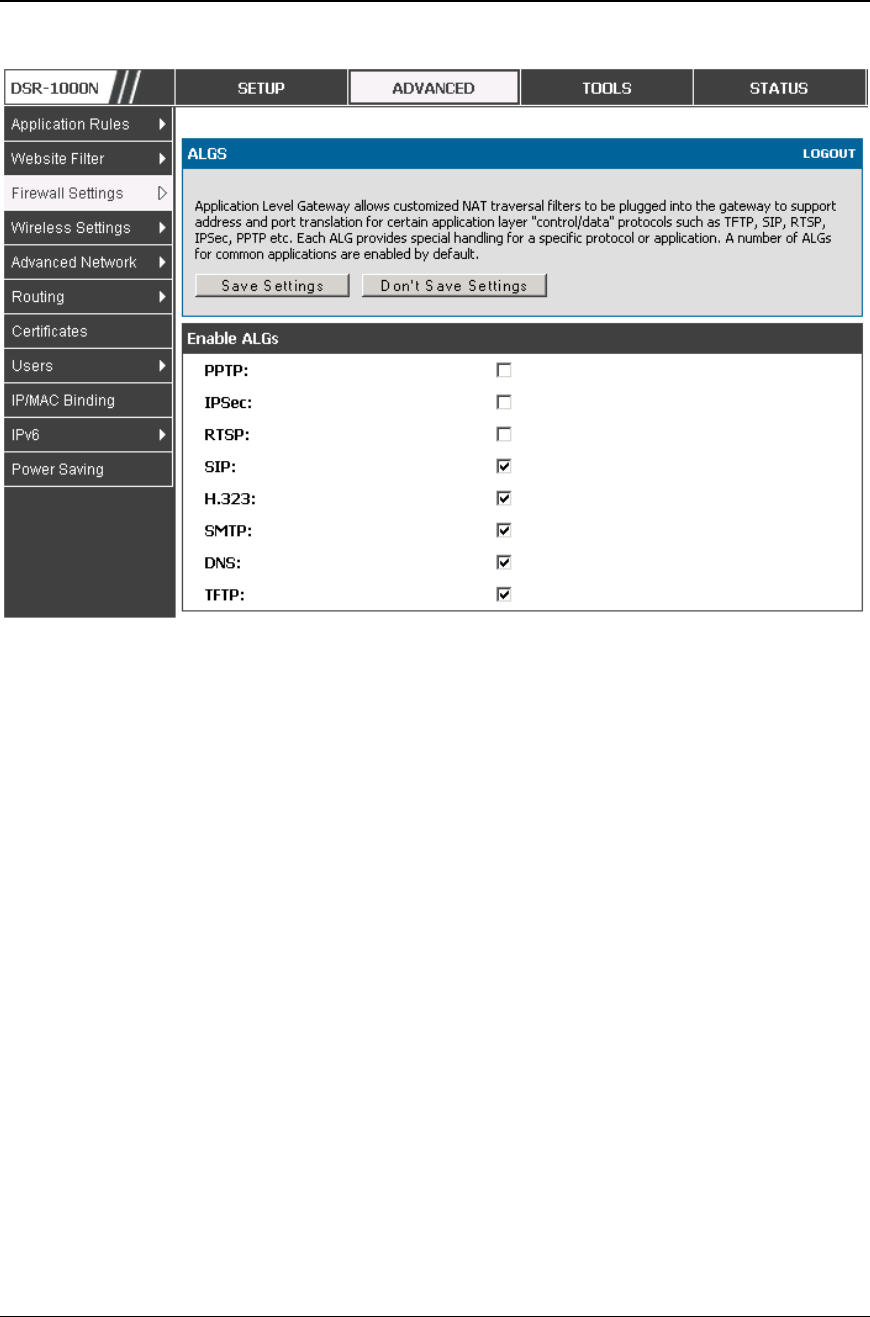
Unified Services Router User Manual
70
Figure 40: Available ALG support on the router.
5.6 VPN Passthrough for Firewall
Advanced > Firewall Settings > VPN Passthrough
This router’s firewall settings can be configured to allow encrypted VPN traffic for
IPSec, PPTP, and L2TP VPN tunnel connections between the LAN and internet. A
specific firewall rule or service is not appropriate to introduce this passthrough
support; instead the appropriate check boxes in the VPN Passthrough page must be
enabled.
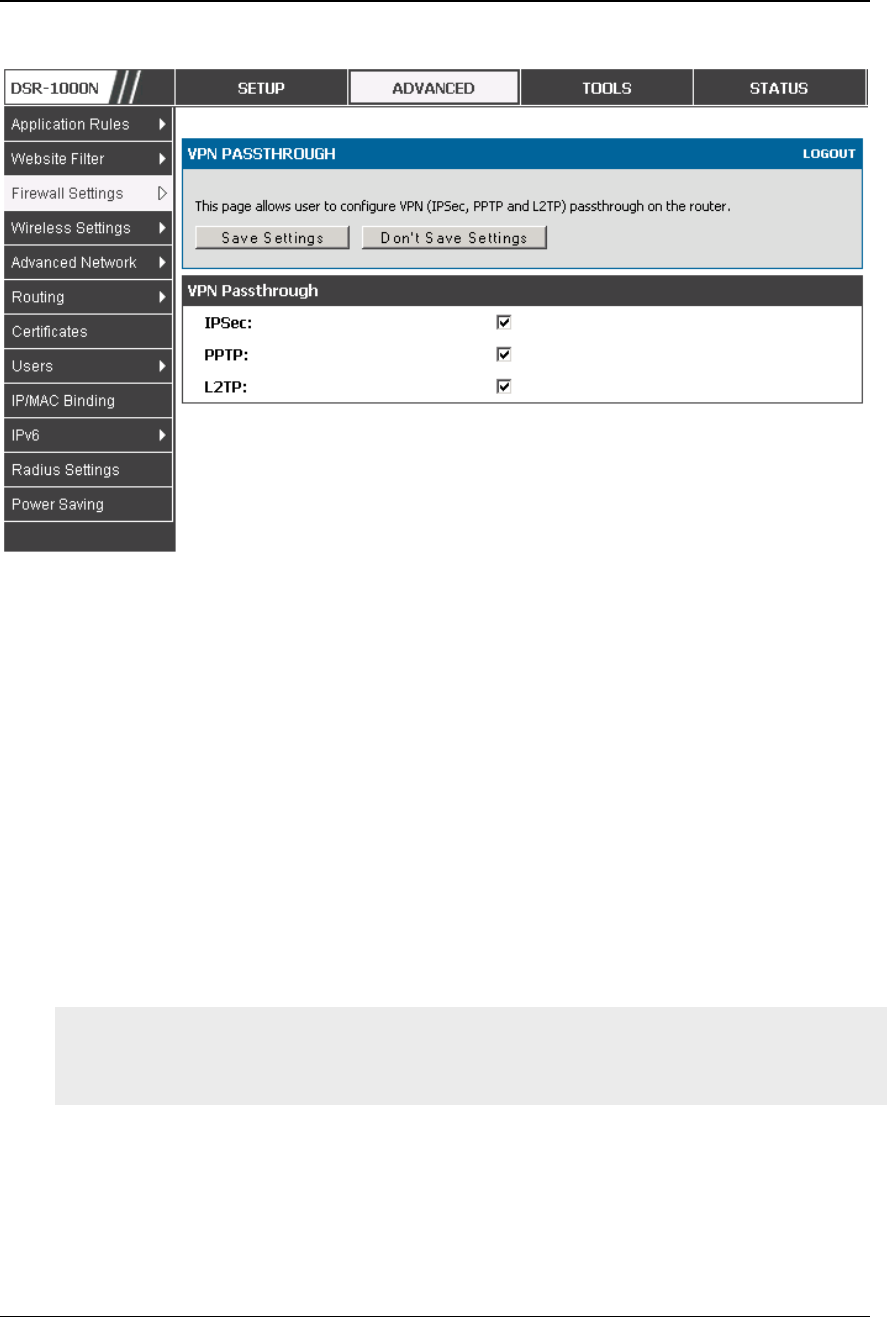
Unified Services Router User Manual
71
Figure 41: Passthrough options for VPN tunnels
5.7 Application Rules
Advanced > Application Rules > Application Rules
Application rules are also referred to as port triggering. This feature allows devices
on the LAN or DMZ to request one or more ports to be forwarded to them. Port
triggering waits for an outbound request from the LAN/DMZ on one of the defined
outgoing ports, and then opens an incoming port for that specified type of traffic. This
can be thought of as a form of dynamic port forwarding while an application is
transmitting data over the opened outgoing or incoming port(s).
Port triggering application rules are more flexible than static port forwarding that is
an available option when configuring firewall rules. This is because a port triggering
rule does not have to reference a specific LAN IP or IP range. As well ports are not
left open when not in use, thereby providing a level of security that port forwarding
does not offer.
Port triggering is not appropriate for servers on the LAN, since there is a
dependency on the LAN device making an outgoing connection before incoming
ports are opened.
Some applications require that when external devices connect to them, they receive
data on a specific port or range of ports in order to function properly. The router must
send all incoming data for that application only on the required port or range of ports.
The router has a list of common applications and games with corresponding outbound
and inbound ports to open. You can also specify a port triggering rule by defining the
type of traffic (TCP or UDP) and the range of incoming and outgoing ports to open
when enabled.
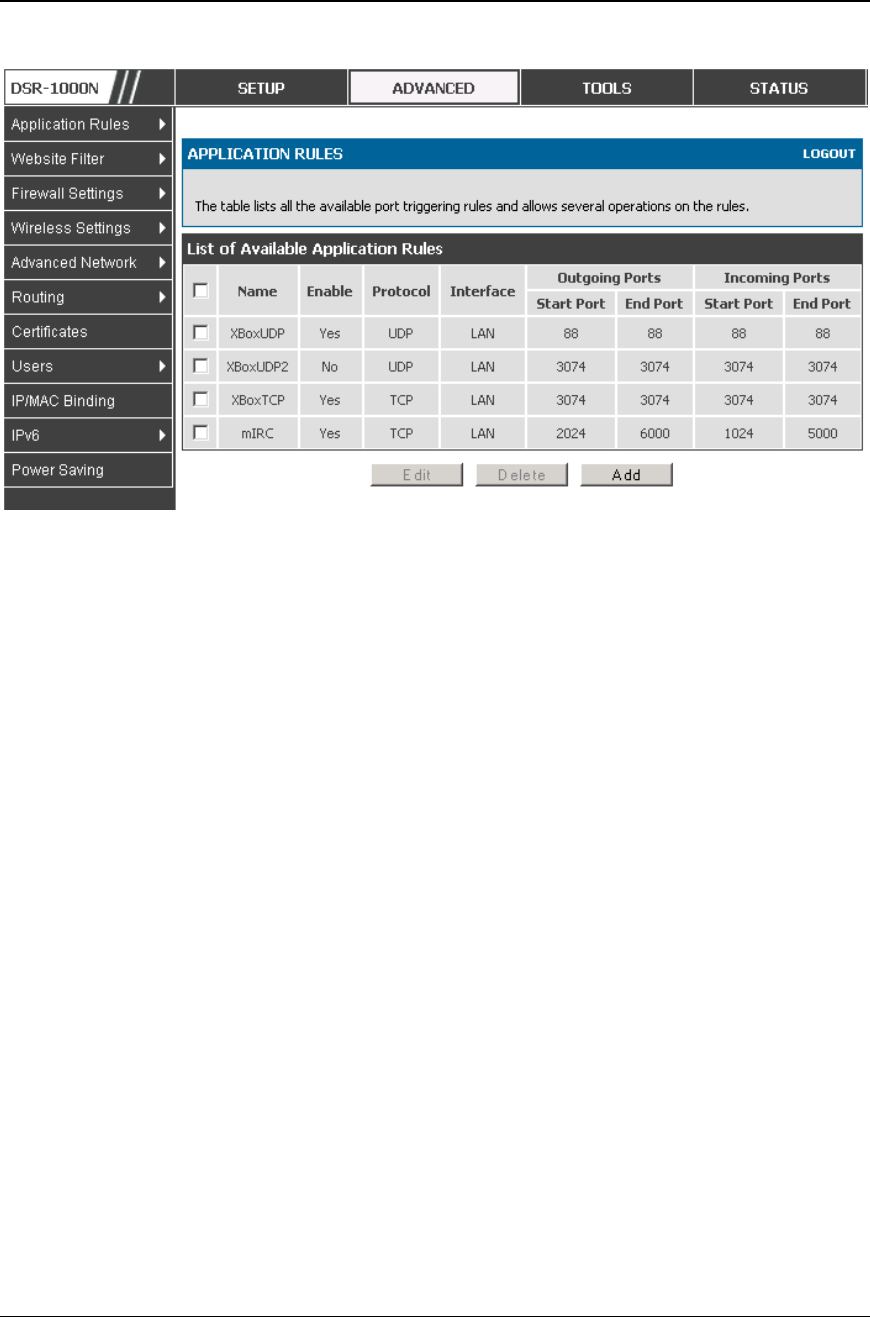
Unified Services Router User Manual
72
Figure 42: List of Available Application Rules showing 4 unique rules
The application rule status page will list any active rules, i.e. incoming ports that are
being triggered based on outbound requests from a defined outgoing port.
5.8 Web Content Filtering
The gateway offers some standard web filtering options to allow the admin to easily
create internet access policies between the secure LAN and insecure WAN. Instead of
creating policies based on the type of traffic (as is the case when using firewall rules),
web based content itself can be used to determine if traffic is allowed or dropped.
• Content Filtering
Advanced > Website Filter > Content Filtering
Content filtering must be enabled to configure and use the subsequent features (list of
Trusted Domains, filtering on Blocked Keywords, etc.). Proxy servers, which can be
used to circumvent certain firewall rules and thus a potential security gap, can be
blocked for all LAN devices. Java applets can be prevented from being downloaded
from internet sites, and similarly the gateway can prevent ActiveX controls from
being downloaded via Internet Explorer. For added security cookies, which typically
contain session information, can be blocked as well for all devices on the private
network.
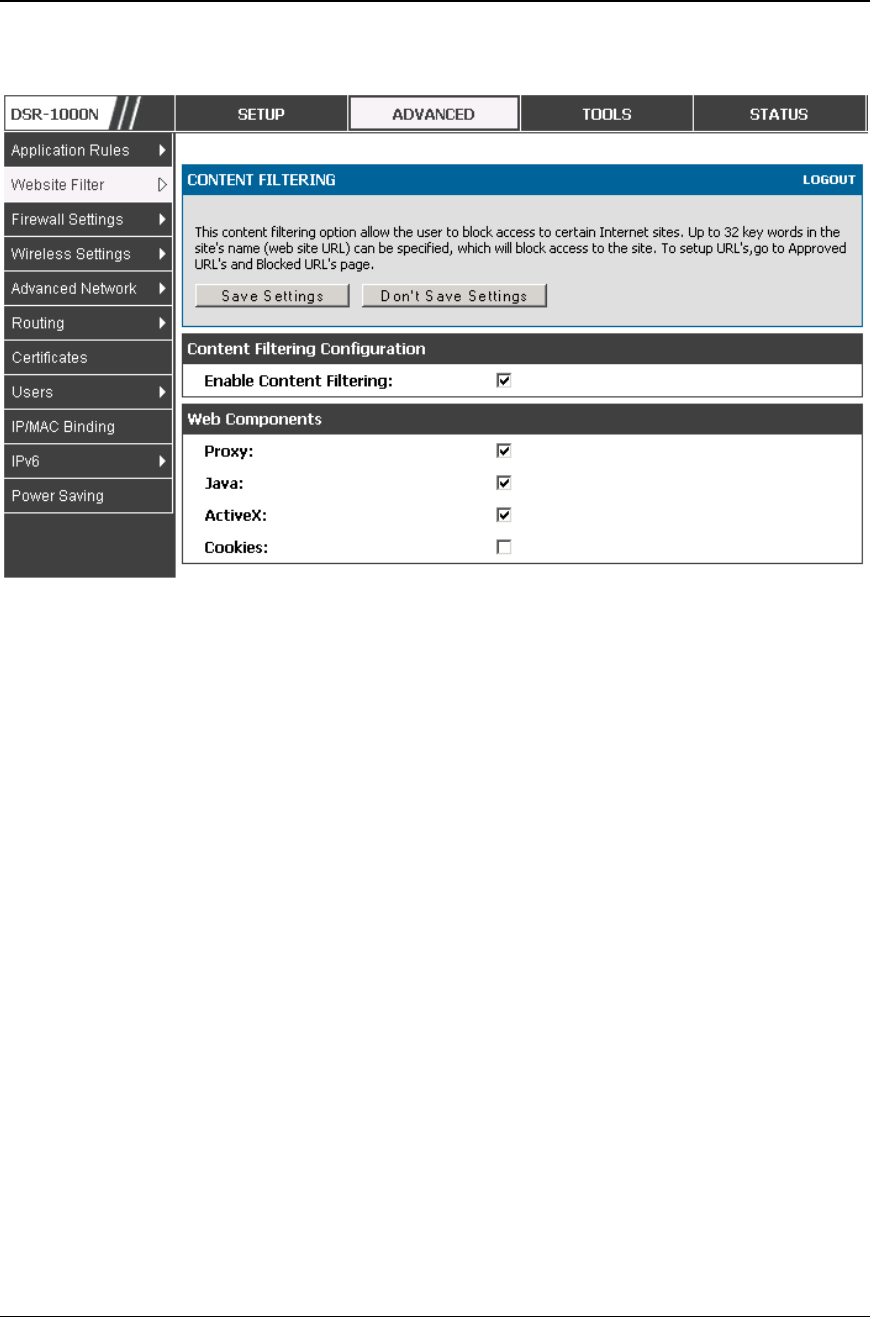
Unified Services Router User Manual
73
Figure 43: Content Filtering used to block access to proxy servers and
prevent ActiveX controls from being downloaded
• Approved URLs
Advanced > Website Filter > Approved URLs
The Approved URLs is an acceptance list for all URL domain names. Domains added
to this list are allowed in any form. For example, if the domain “yahoo” is added to
this list then all of the following URL’s are permitted access from the LAN:
www.yahoo.com, yahoo.co.uk, etc.
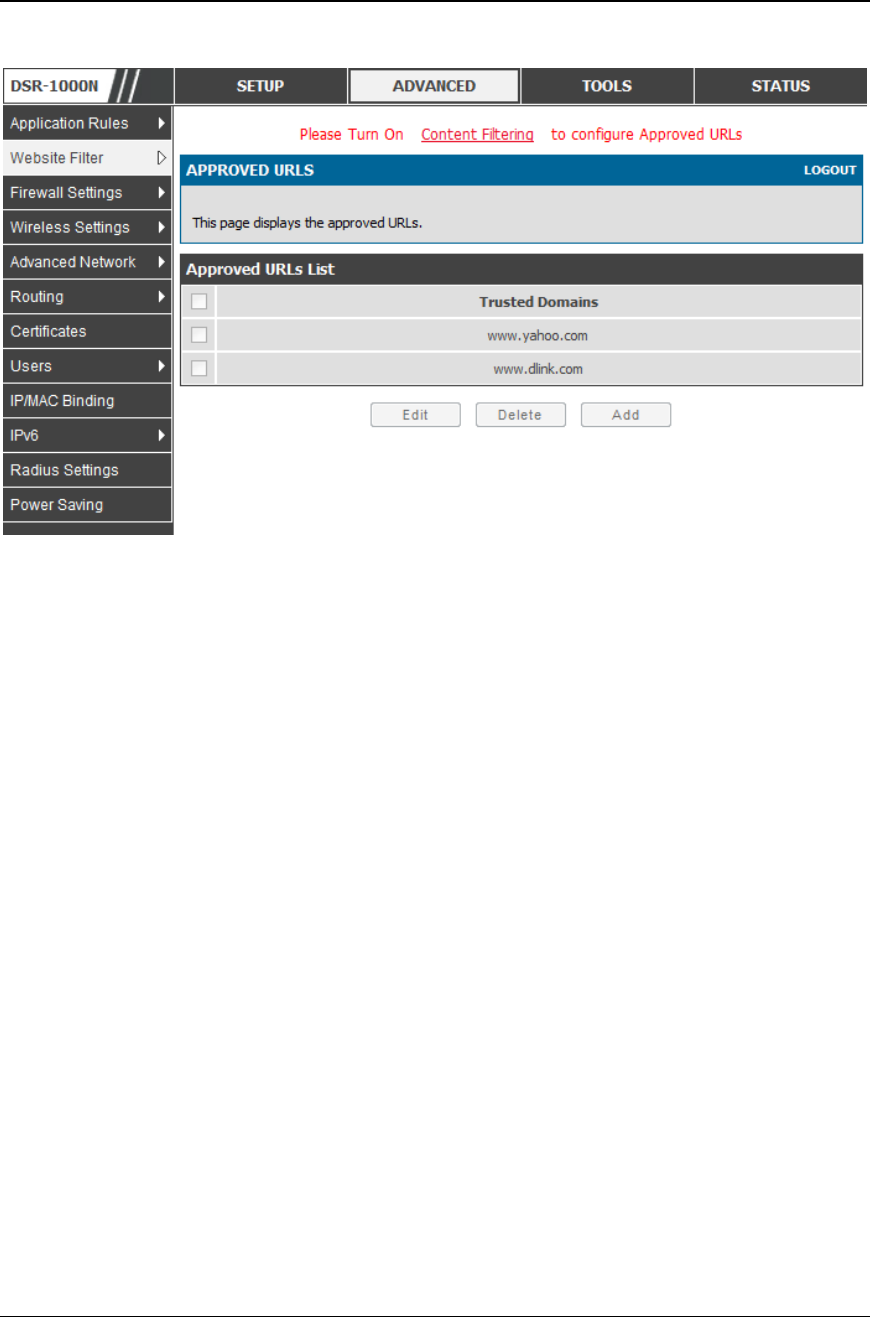
Unified Services Router User Manual
74
Figure 44: Two trusted domains added to the Approved URLs List
• Blocked Keywords
Advanced > Website Filter > Blocked Keywords
Keyword blocking allows you to block all website URL’s or site content that contains
the keywords in the configured list. This is lower priority than the Approved URL
List; i.e. if the blocked keyword is present in a site allowed by a Trusted Domain in
the Approved URL List, then access to that site will be allowed.
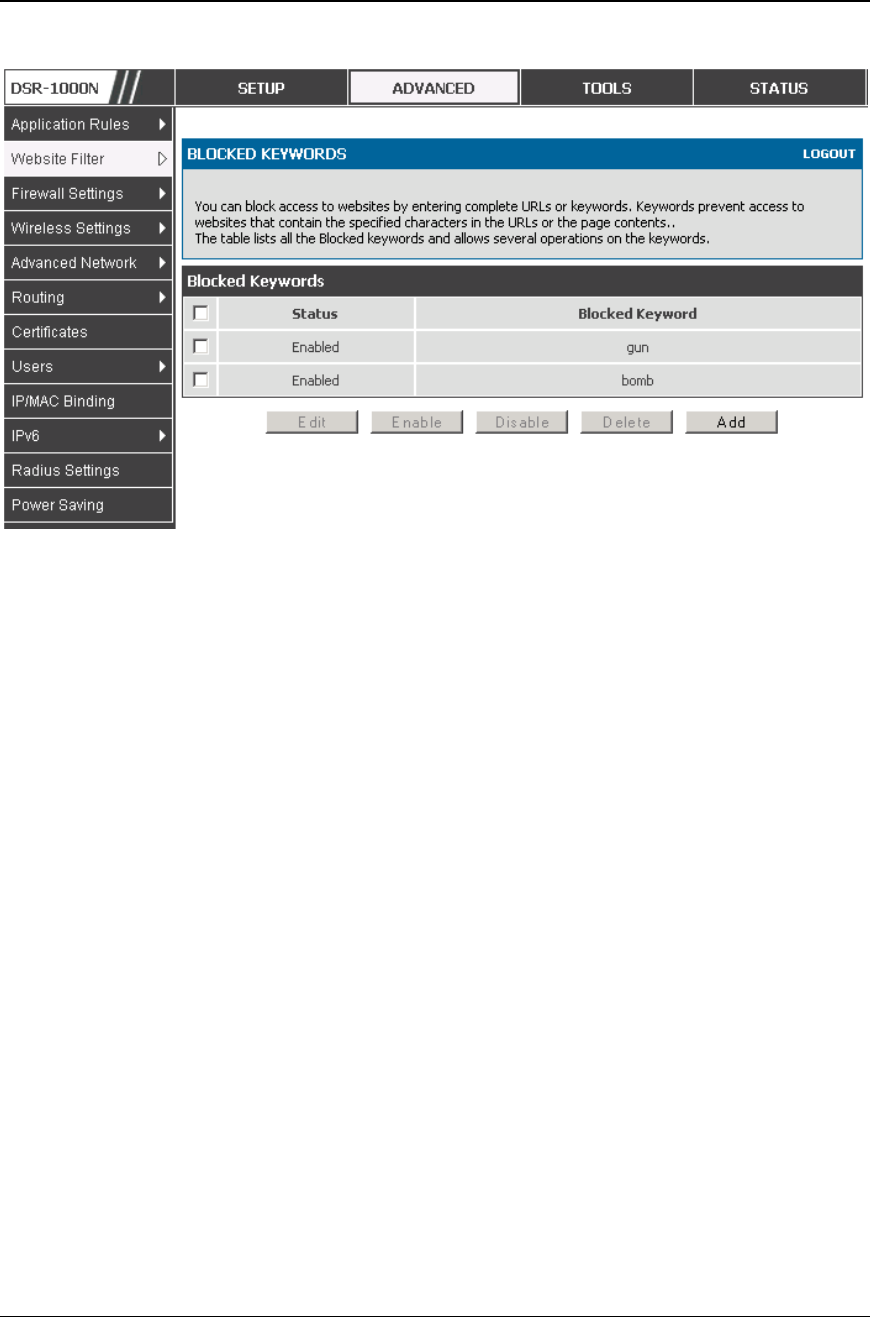
Unified Services Router User Manual
75
Figure 45: Two keywords added to the block list
5.9 IP/MAC Binding
Advanced > IP/MAC Binding
Another available security measure is to only allow outbound traffic (from the LAN to
WAN) when the LAN node has an IP address matching the MAC address bound to it.
This is IP/MAC Binding, and by enforcing the gateway to validate the source traffic’s
IP address with the unique MAC Address of the configured LAN node, the
administrator can ensure traffic from that IP address is not spoofed. In the event of a
violation (i.e. the traffic’s source IP address doesn’t match up with the expected MAC
address having the same IP address) the packets will be dropped and can be logged for
diagnosis.
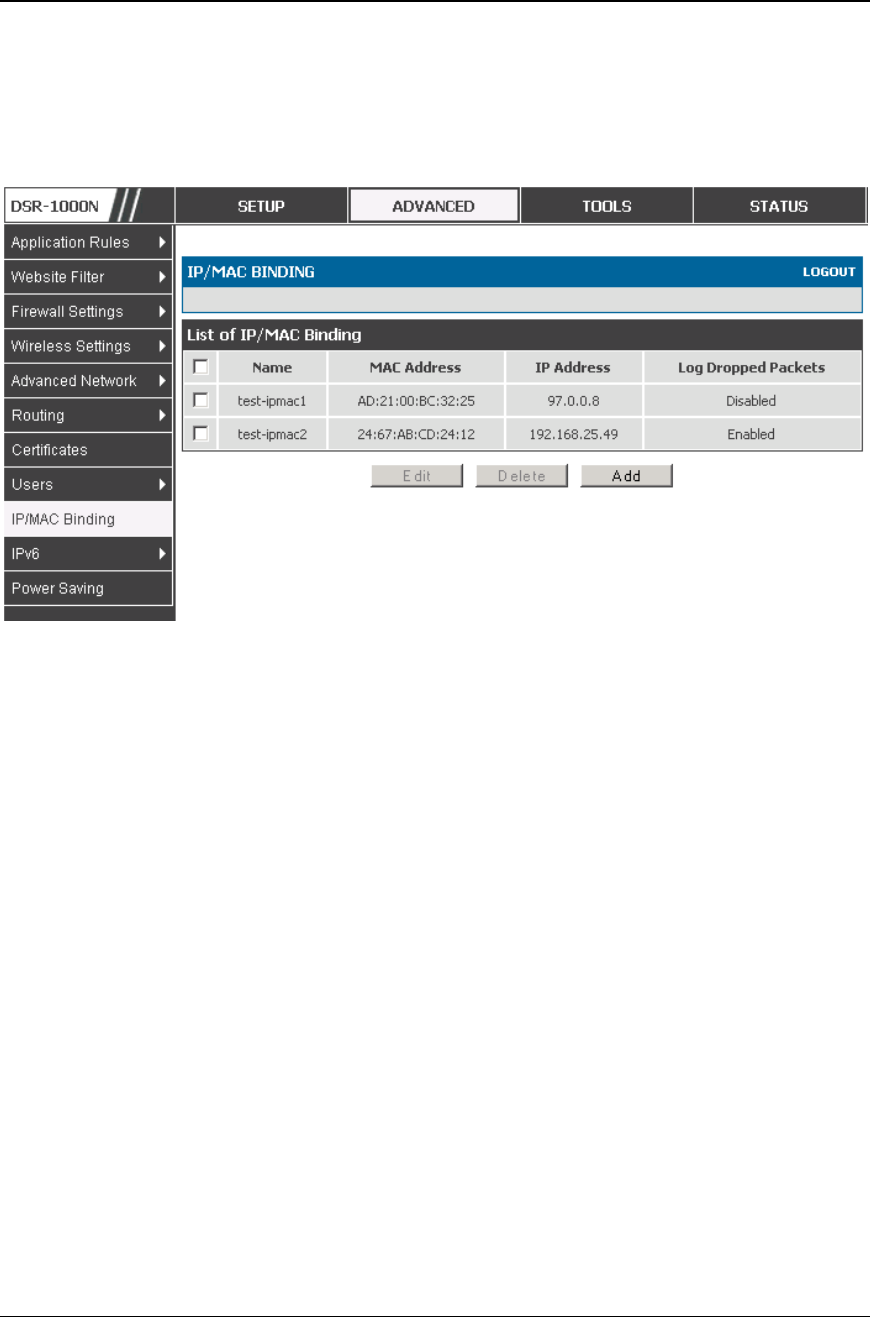
Unified Services Router User Manual
76
Figure 46: The above example of IP/MAC Binding binds a LAN host’s
MAC Address to an IP address. If there is an IP/MAC Binding
violation, the violating packet will be dropped and logs will be
captured
5.10 Intrusion Prevention (IPS)
Advanced > Advanced Network > IPS
The gateway’s Intrusion Prevention System (IPS) prevents malicious attacks from the
internet from accessing the private network. Static attack signatures loaded to the
device allow common attacks to be detected and prevented. The checks can be
enabled between the WAN and DMZ or LAN, and a running counter will allow the
administrator to see how many malicious intrusion attempts from the WAN have been
detected and prevented.
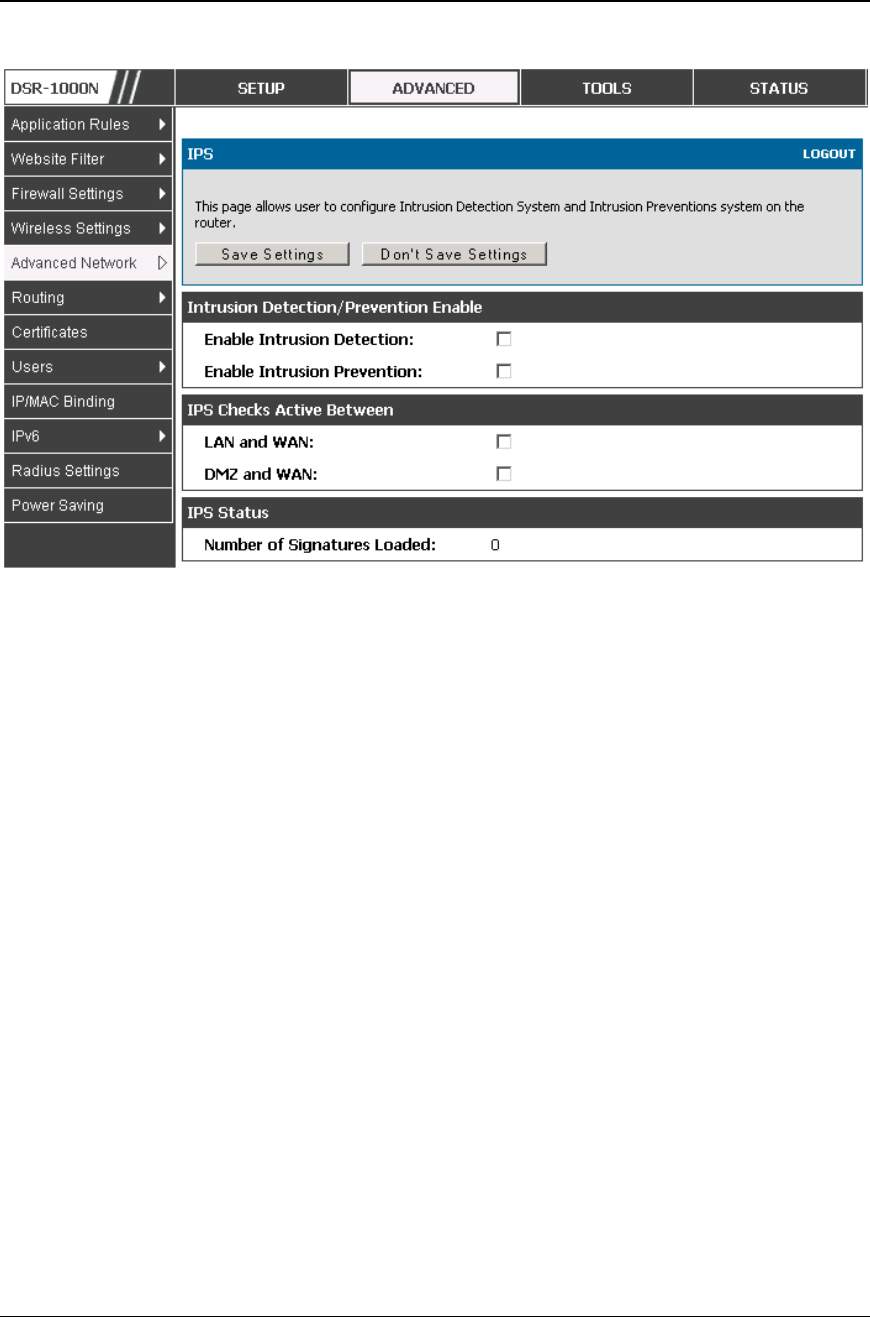
Unified Services Router User Manual
77
Figure 47: Intrusion Prevention features on the router
5.10.1 Protecting from Internet Attacks
Advanced > Advanced Network > Attack Checks
Attacks can be malicious security breaches or unintentional network issues that
render the router unusable. Attack checks allow you to manage WAN security
threats such as continual ping requests and discovery via ARP scans. TCP and UDP
flood attack checks can be enabled to manage extreme usage of WAN resources.
Additionally certain Denial-of-Service (DoS) attacks can be blocked. These attacks,
if uninhibited, can use up processing power and bandwidth and prevent regular
network services from running normally. ICMP packet flooding, SYN traffic
flooding, and Echo storm thresholds can be configured to temporarily suspect traffic
from the offending source.
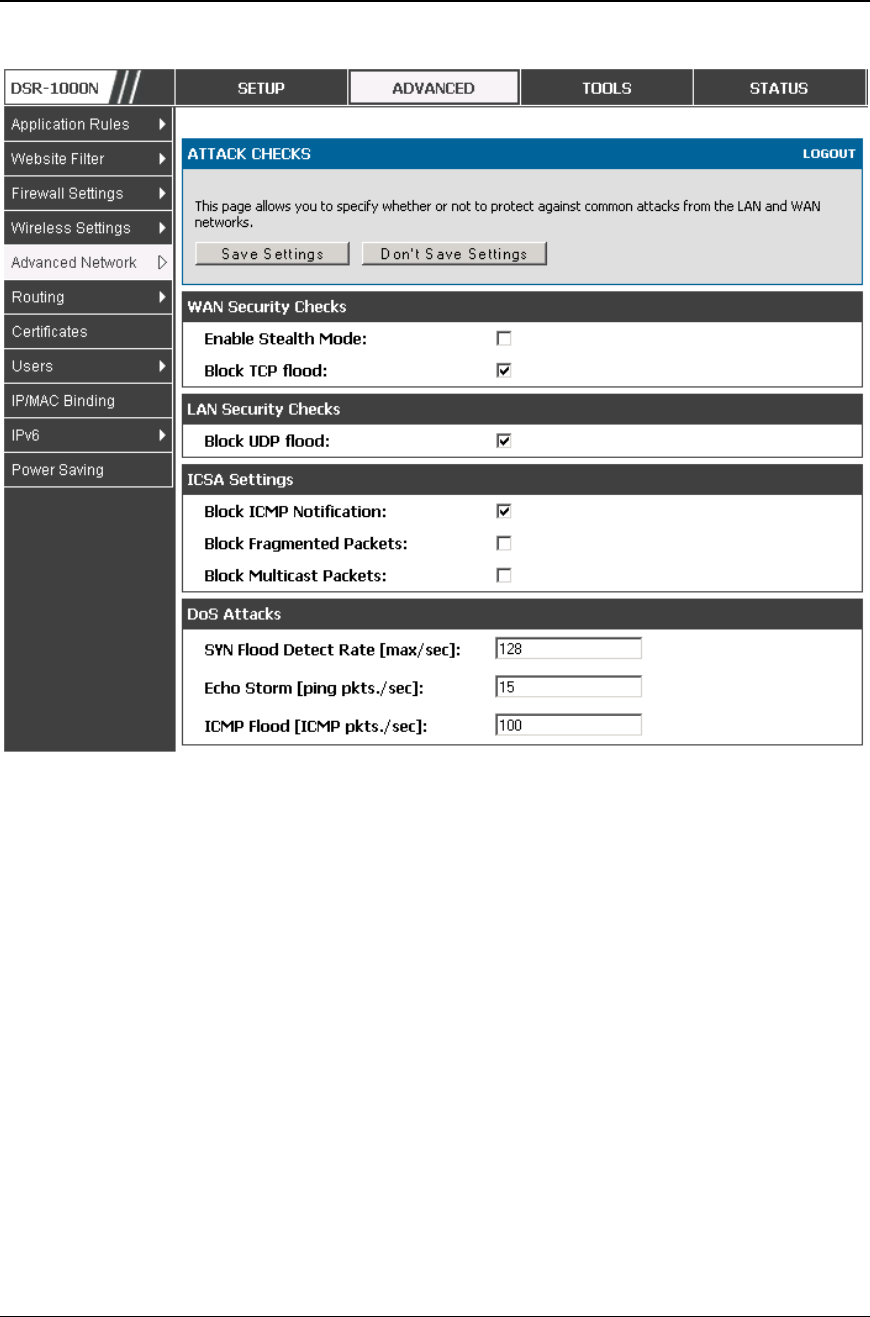
Unified Services Router User Manual
78
Figure 48: Protecting the router and LAN from internet attacks

Unified Services Router User Manual
79
Chapter 6. IPSec / PPTP / L2TP VPN
A VPN provides a secure communication channel (“tunnel”) between two gateway
routers or a remote PC client. The following types of tunnels can be created:
• Gateway-to-gateway VPN: to connect two or more routers to secure traffic between
remote sites.
• Remote Client (client-to-gateway VPN tunnel): A remote client initiates a VPN
tunnel as the IP address of the remote PC client is not known in advance. The
gateway in this case acts as a responder.
• Remote client behind a NAT router: The client has a dynamic IP address and is
behind a NAT Router. The remote PC client at the NAT router initiates a VPN
tunnel as the IP address of the remote NAT router is not known in advance. The
gateway WAN port acts as responder.
• PPTP server for LAN / WAN PPTP client connections.
• L2TP server for LAN / WAN L2TP client connections.
6.1 VPN Wizard
Setup > Wizard > VPN Wizard
You can use the VPN wizard to quickly create both IKE and VPN policies. Once the
IKE or VPN policy is created, you can modify it as required.
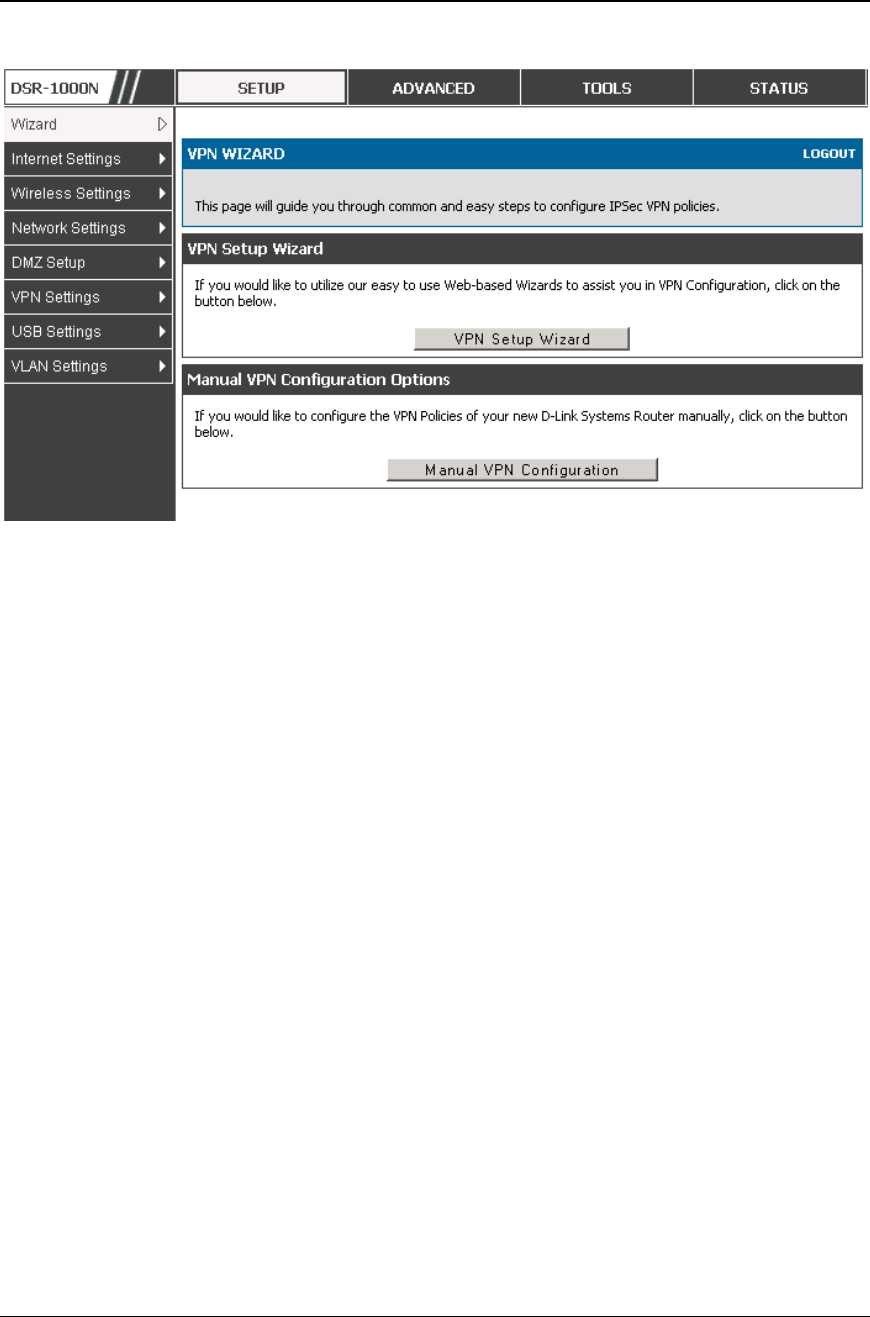
Unified Services Router User Manual
80
Figure 49: VPN Wizard launch screen
To easily establish a VPN tunnel using VPN Wizard, follow the steps below:
1. Step 1: Select the VPN tunnel type to create
• The tunnel can either be a gateway to gateway connection (site-to-site) or a tunnel
to a host on the internet (remote access).
• Set the Connection Name and pre-shared key: the connection name is used for
management, and the pre-shared key will be required on the VPN client or gateway
to establish the tunnel
• Determine the local gateway for this tunnel; if there is more than 1 WAN
configured the tunnel can be configured for either of the gateways.
2. Step 2: Configure Remote and Local WAN address for the tunnel endpoints
• Remote Gateway Type: identify the remote endpoint of the tunnel by FQDN or
static IP address
• Remote WAN IP address / FQDN: This field is enabled only if the peer you are
trying to connect to is a Gateway. For VPN Clients, this IP address or Internet
Name is determined when a connection request is received from a client.
• Local Gateway Type: identify this router’s endpoint of the tunnel by FQDN or
static IP address

Unified Services Router User Manual
81
• Local WAN IP address / FQDN: This field can be left blank if you are not using a
different FQDN or IP address than the one specified in the WAN port’s
configuration.
3. Step 3: Configure the Secure Connection Remote Accessibility fields to identify the
remote network:
• Remote LAN IP address: address of the LAN behind the peer gateway
• Remote LAN Subnet Mask: the subnet mask of the LAN behind the peer
Note: The IP address range used on the remote LAN must be different from the IP
address range used on the local LAN.
4. Step4: review the settings and click Connect to establish the tunnel.
The Wizard will create a Auto IPSec policy with the following default values for a
VPN Client or Gateway policy (these can be accessed from a link on the Wizard
page):
Parameter Default value from Wizard
Exchange Mode Aggressive (Client policy ) or Main (Gateway policy)
ID Type FQDN
Local WAN ID wan_local.com (only applies to Client policies)
Remote WAN ID wan_remote.com (only applies to Client policies)
Encryption Algorithm 3DES
Authentication Algorithm SHA-1
Authentication Method Pre-shared Key
PFS Key-Group DH-Group 2(1024 bit)
Life Time (Phase 1) 24 hours
Life Time (Phase 2) 8 hours
NETBIOS Enabled (only applies to Gateway policies)
The VPN Wizard is the recommended method to set up an Auto IPSec policy.
Once the Wizard creates the matching IKE and VPN policies required by the Auto
policy, one can modify the required fields through the edit link. Refer to the online
help for details.

Unified Services Router User Manual
82
6.2 Configuring IPSec Policies
Setup > VPN Settings > IPSec > IPSec Policies
A IPSec policy is between this router and another gateway or this router and a IPSec
client on a remote host. The IPSec mode can be either tunnel or transport depending
on the network being traversed between the two policy endpoints.
• Transport: This is used for end-to-end communication between this router and the
tunnel endpoint, either another IPSec gateway or an IPSec VPN client on a host.
Only the data payload is encrypted and the IP header is not modified or encrypted.
• Tunnel: This mode is used for network-to-network IPSec tunnels where this
gateway is one endpoint of the tunnel. In this mode the entire IP packet including
the header is encrypted and/or authenticated.
When tunnel mode is selected, you can enable NetBIOS and DHCP over IPSec.
DHCP over IPSec allows this router to serve IP leases to hosts on the remote LAN. As
well in this mode you can define the single IP address, range of IPs, or subnet on both
the local and remote private networks that can communicate over the tunnel.
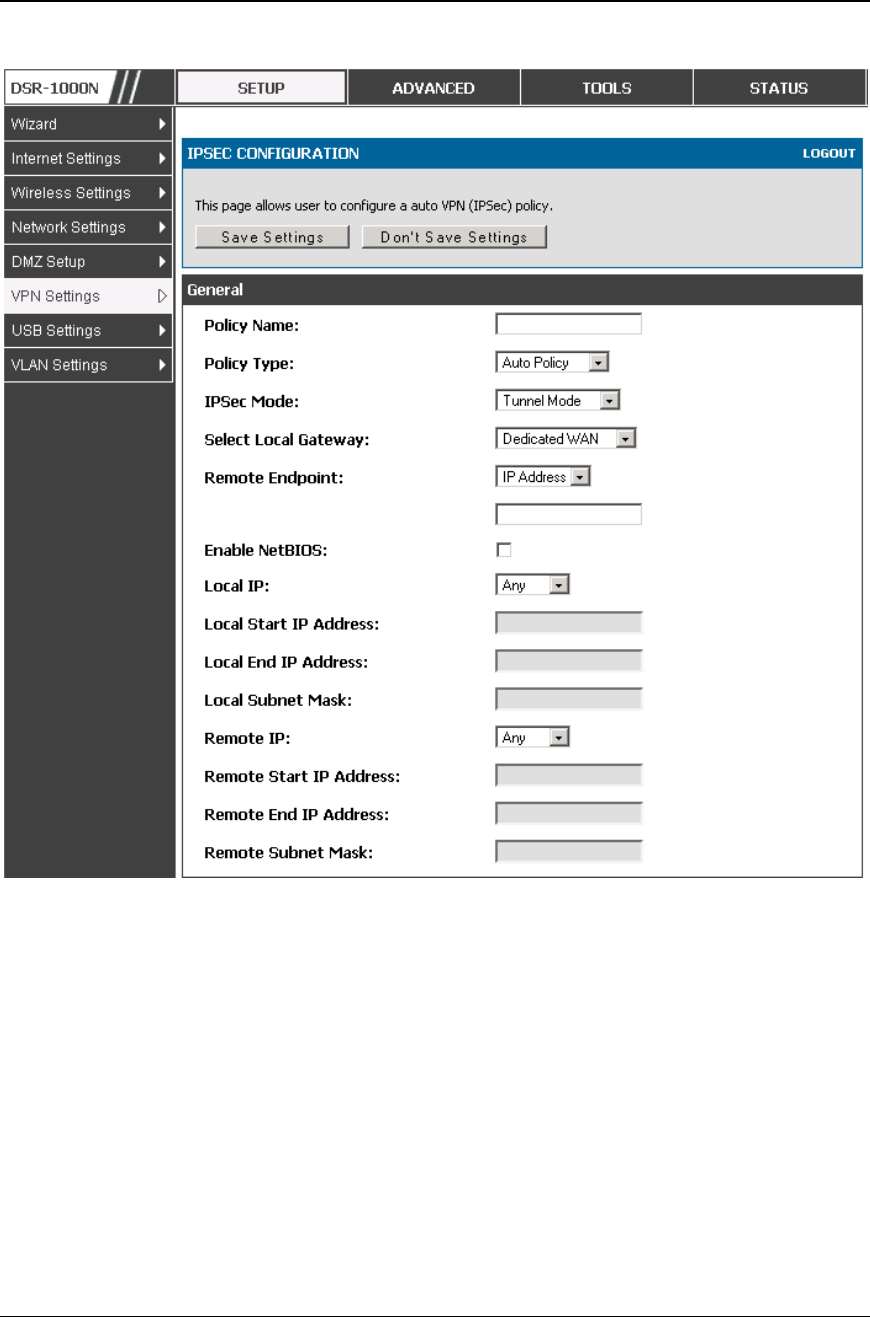
Unified Services Router User Manual
83
Figure 50: IPSec policy configuration
Once the tunnel type and endpoints of the tunnel are defined you can determine the
Phase 1 / Phase 2 negotiation to use for the tunnel. This is covered in the IPSec
mode setting, as the policy can be Manual or Auto. For Auto policies, the Internet
Key Exchange (IKE) protocol dynamically exchanges keys between two IPSec hosts.
The Phase 1 IKE parameters are used to define the tunnel’s security association
details. The Phase 2 Auto policy parameters cover the security association lifetime
and encryption/authentication details of the phase 2 key negotiation.
The VPN policy is one half of the IKE/VPN policy pair required to establish a Auto
IPSec VPN tunnel. The IP addresses of the machine or machines on the two VPN
endpoints are configured here, along with the policy parameters required to secure the
tunnel
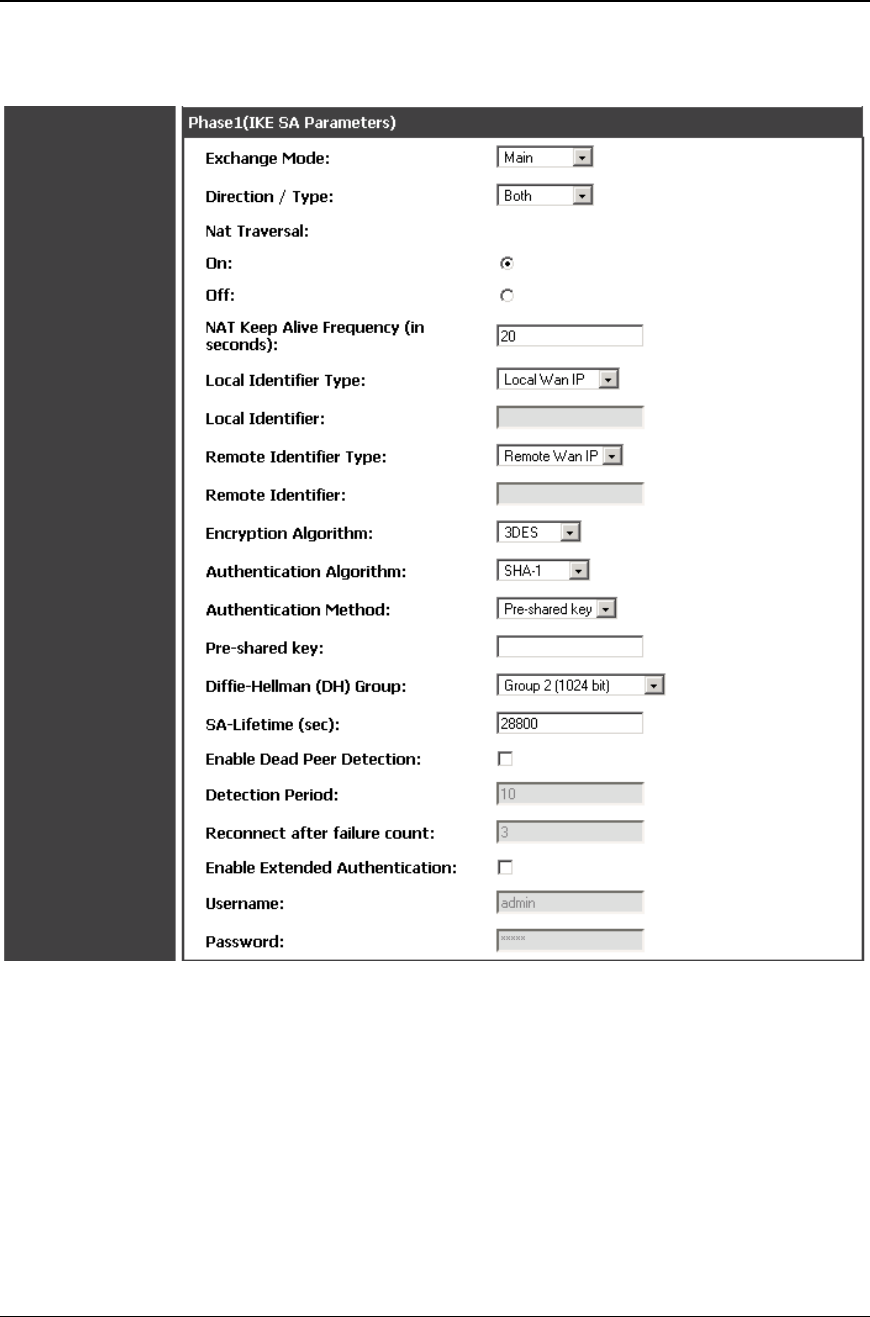
Unified Services Router User Manual
84
Figure 51: IPSec policy configuration continued (Auto policy via IKE)
A Manual policy does not use IKE and instead relies on manual keying to exchange
authentication parameters between the two IPSec hosts. The incoming and outgoing
security parameter index (SPI) values must be mirrored on the remote tunnel
endpoint. As well the encryption and integrity algorithms and keys must match on the
remote IPSec host exactly in order for the tunnel to establish successfully. Note that
using Auto policies with IKE are preferred as in some IPSec implementations the SPI
(security parameter index) values require conversion at each endpoint.
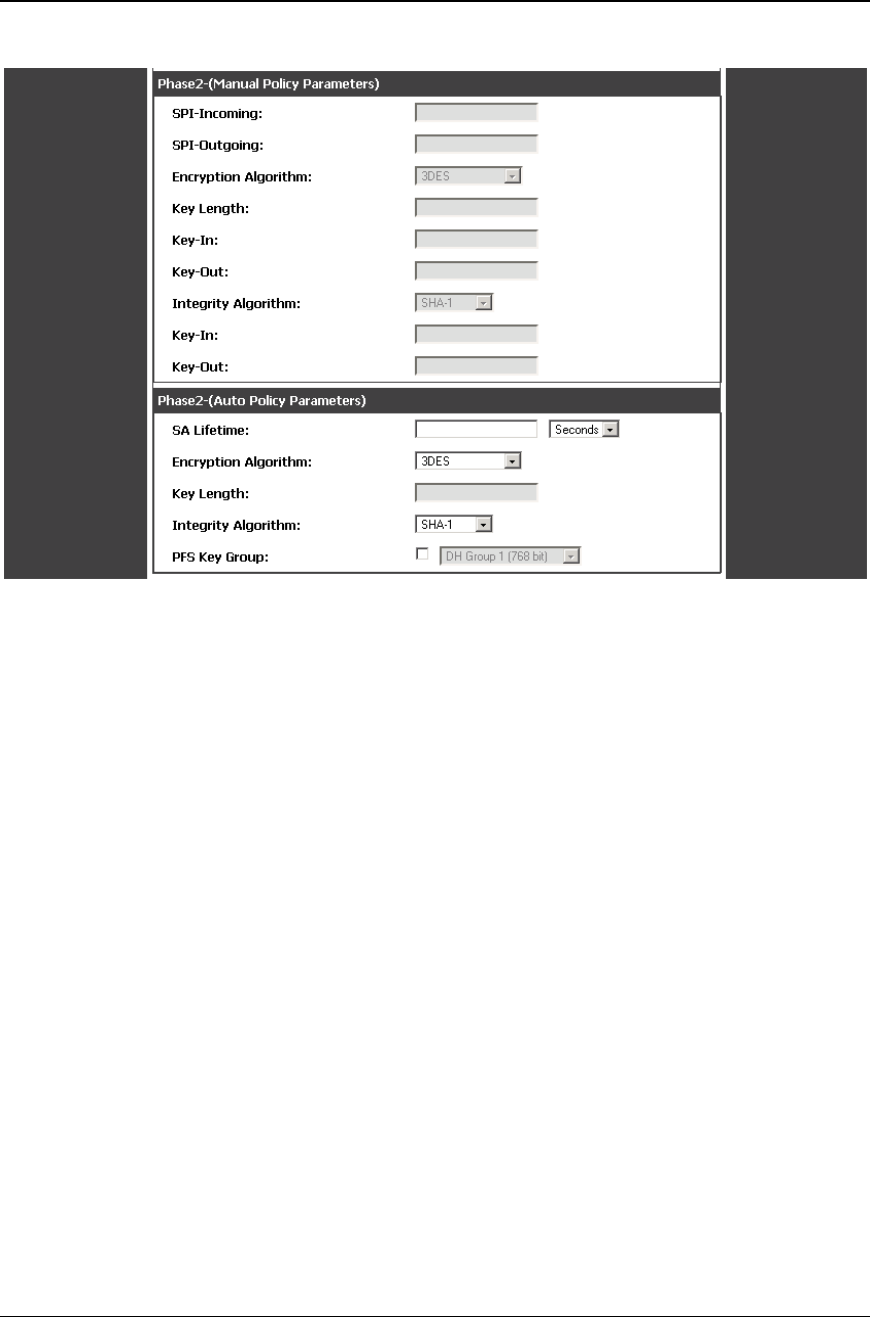
Unified Services Router User Manual
85
Figure 52: IPSec policy configuration continued (Auto / Manual Phase 2)
6.2.1 Extended Authentication (XAUTH)
You can also configure extended authentication (XAUTH). Rather than configure a
unique VPN policy for each user, you can configure the VPN gateway router to
authenticate users from a stored list of user accounts or with an external
authentication server such as a RADIUS server. With a user database, user accounts
created in the router are used to authenticate users.
With a configured RADIUS server, the router connects to a RADIUS server and
passes to it the credentials that it receives from the VPN client. You can secure the
connection between the router and the RADIUS server with the authentication
protocol supported by the server (PAP or CHAP). For RADIUS – PAP, the router
first checks in the user database to see if the user credentials are available; if they
are not, the router connects to the RADIUS server.
6.3 Configuring VPN clients
Remote VPN clients must be configured with the same VPN policy parameters used in
the VPN tunnel that the client wishes to use: encryption, authentication, life time, and
PFS key-group. Upon establishing these authentication parameters, the VPN Client
user database must also be populated with an account to give a user access to the
tunnel.

Unified Services Router User Manual
86
VPN client software is required to establish a VPN tunnel between the router and
remote endpoint. Open source software (such as OpenVPN or Openswan) as well as
Microsoft IPSec VPN software can be configured with the required IKE policy
parameters to establish an IPSec VPN tunnel. Refer to the client software guide for
detailed instructions on setup as well as the router’s online help.
The user database contains the list of VPN user accounts that are authorized to use a
given VPN tunnel. Alternatively VPN tunnel users can be authenticated using a
configured Radius database. Refer to the online help to determine how to populate the
user database and/or configure RADIUS authentication.
6.4 PPTP / L2TP Tunnels
This router supports VPN tunnels from either PPTP or L2TP ISP servers. The router
acts as a broker device to allow the ISP's server to create a TCP control connection
between the LAN VPN client and the VPN server.
6.4.1 PPTP Tunnel Support
Setup > VPN Settings > PPTP > PPTP Server
A PPTP VPN can be established through this router. Once enabled a PPTP server is
available on the router for LAN and WAN PPTP client users to access. Once the
PPTP server is enabled, PPTP clients that are within the range of configured IP
addresses of allowed clients can reach the router’s PPTP server. Once authenticated
by the PPTP server (the tunnel endpoint), PPTP clients have access to the network
managed by the router.
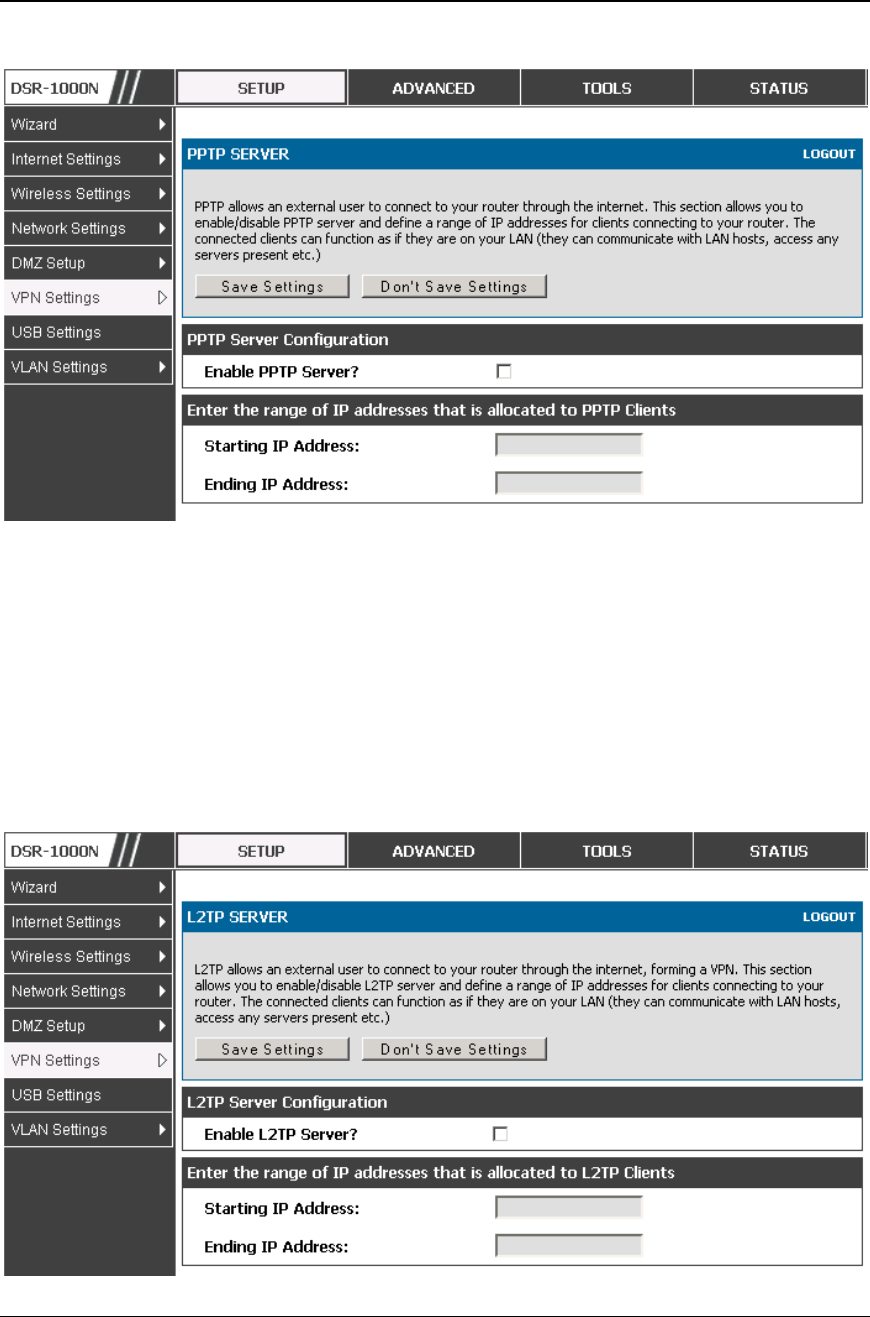
Unified Services Router User Manual
87
Figure 53: PPTP tunnel configuration – PPTP Server
6.4.2 L2TP Tunnel Support
Setup > VPN Settings > L2TP > L2TP Server
A L2TP VPN can be established through this router. Once enabled a L2TP server is
available on the router for LAN and WAN L2TP client users to access. Once the
L2TP server is enabled, L2TP clients that are within the range of configured IP
addresses of allowed clients can reach the router’s L2TP server. Once authenticated
by the L2TP server (the tunnel endpoint), L2TP clients have access to the network
managed by the router.
Figure 54: L2TP tunnel configuration – L2TP Server

Chapter 7. SSL VPN
The router provides an intrinsic SSL VPN feature as an alternate to the standard IPSec
VPN. SSL VPN differs from IPSec VPN mainly by removing the requirement of a pre-
installed VPN client on the remote host. Instead, users can securely login through the
SSL User Portal using a standard web browser and receive access to configured
network resources within the corporate LAN. The router supports multiple concurrent
sessions to allow remote users to access the LAN over an encrypted link through a
customizable user portal interface, and each SSL VPN user can be assigned unique
privileges and network resource access levels.
The remote user can be provided different options for SSL service through this router:
• VPN Tunnel: The remote user’s SSL enabled browser is used in place of a VPN
client on the remote host to establish a secure VPN tunnel. A SSL VPN client
(Active-X or Java based) is installed in the remote host to allow the client to join
the corporate LAN with pre-configured access/policy privileges. At this point a
virtual network interface is created on the user’s host and this will be assigned an
IP address and DNS server address from the router. Once established, the host
machine can access allocated network resources.
• Port Forwarding: A web-based (ActiveX or Java) client is installed on the client
machine again. Note that Port Forwarding service only supports TCP connections
between the remote user and the router. The router administrator can define specific
services or applications that are available to remote port forwarding users instead
of access to the full LAN like the VPN tunnel.
ActiveX clients are used when the remote user accesses the portal using the Internet
Explorer browser. The Java client is used for other browsers like Mozilla Firefox,
Netscape Navigator, Google Chrome, and Apple Safari.
7.1 Users, Groups, and Domains
Advanced > Users > Users
Authentication of the users (IPSec, SSL VPN, or GUI) is done by the router using
either a local database on the router or external authentication servers (i.e. LDAP or
RADIUS). The remote user must specify the user, group and domain when logging in
to the router. One or more users are members of a Group. One or more Groups belong
to an authentication Domain.
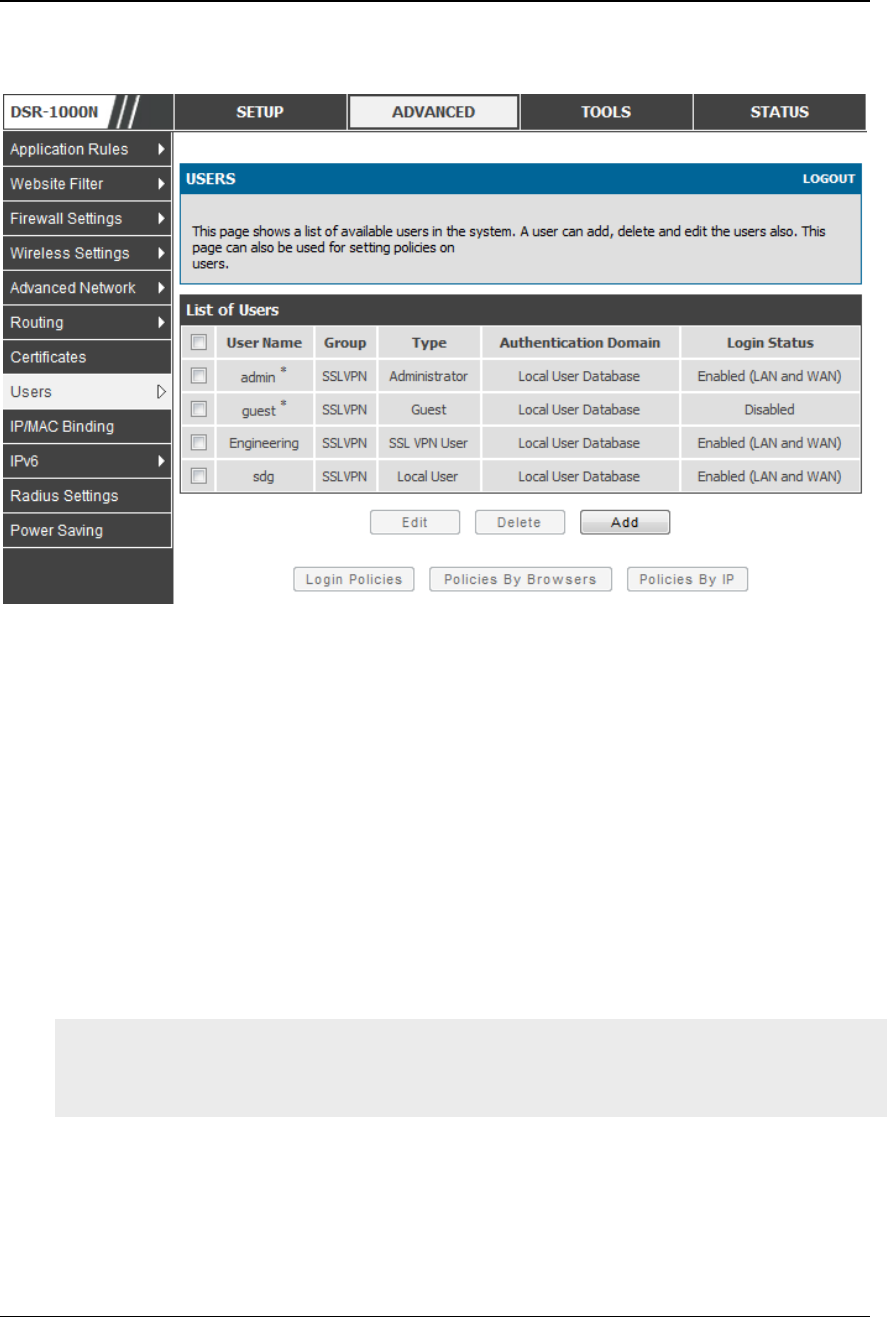
Unified Services Router User Manual
90
Figure 55: Available Users with login status and associated
Group/Domain
Advanced > Users > Domains
The Domain determines the authentication method (local user database, external
server) to be used when validating the remote user’s connection. As well the Domain
determines the portal layout presented to the remote SSL user. Since the portal layout
assigns access to SSL VPN tunnel and/or SSL VPN Port Forwarding features, the
domain is essential in defining the authentication and features exposed to SSL users.
Advanced > Users > Groups
Groups are used to assign access policies to a set of SSL users within a domain.
Groups are domain subsets that can be seen as types of SSL users; some groups
require access to all available network resources and some can be provided access to a
select few. With groups, a very secure hierarchy of SSL VPN remote access can be
created for all types of users with minimal number of policies to configure.
You must create a Domain first, and then a new Group can be created and assigned
to the Domain. The last step is to add specific SSL VPN users to an already-
configured Group.
7.1.1 User Types and Passwords
Advanced > Users > Users
User level policies can be specified by browser, IP address of the host, and whether
the user can login to the router’s GUI in addition to the SSL VPN portal. The

Unified Services Router User Manual
91
following user types are assigned to a user that reaches the GUI login screen from
the LAN or WAN:
• Administrator: This is the router’s super-user, and can manage the router, use SSL
VPN to access network resources, and login to L2TP/PPTP servers on the WAN.
There will always be one default administrator user for the GUI.
• Guest (read only): The guest user gains read only access to the GUI to observe and
review configuration settings. The guest does not have SSL VPN access.
• SSL VPN User: This user has access to the SSL VPN services as determined by the
group policies and authentication domain of which it is a member. The domain-
determined SSL VPN portal will be displayed when logging in with this user type.
• XAuth User: This user’s authentication is performed by an externally configured
RADIUS or other Enterprise server. It is not part of the local user database.
• L2TP User: These are L2TP VPN tunnel LAN users that can establish a tunnel with
the L2TP server on the WAN.
• PPTP User: These are PPTP VPN tunnel LAN users that can establish a tunnel with
the PPTP server on the WAN.
• Local User: This user’s authentication domain is located on the router itself.
Once the user type is determined, you can define/modify the password and idle login
timeout for the user. It is recommended that passwords contains no dictionary words
from any language, and is a mixture of letters (both uppercase and lowercase),
numbers, and symbols. The password can be up to 30 characters.
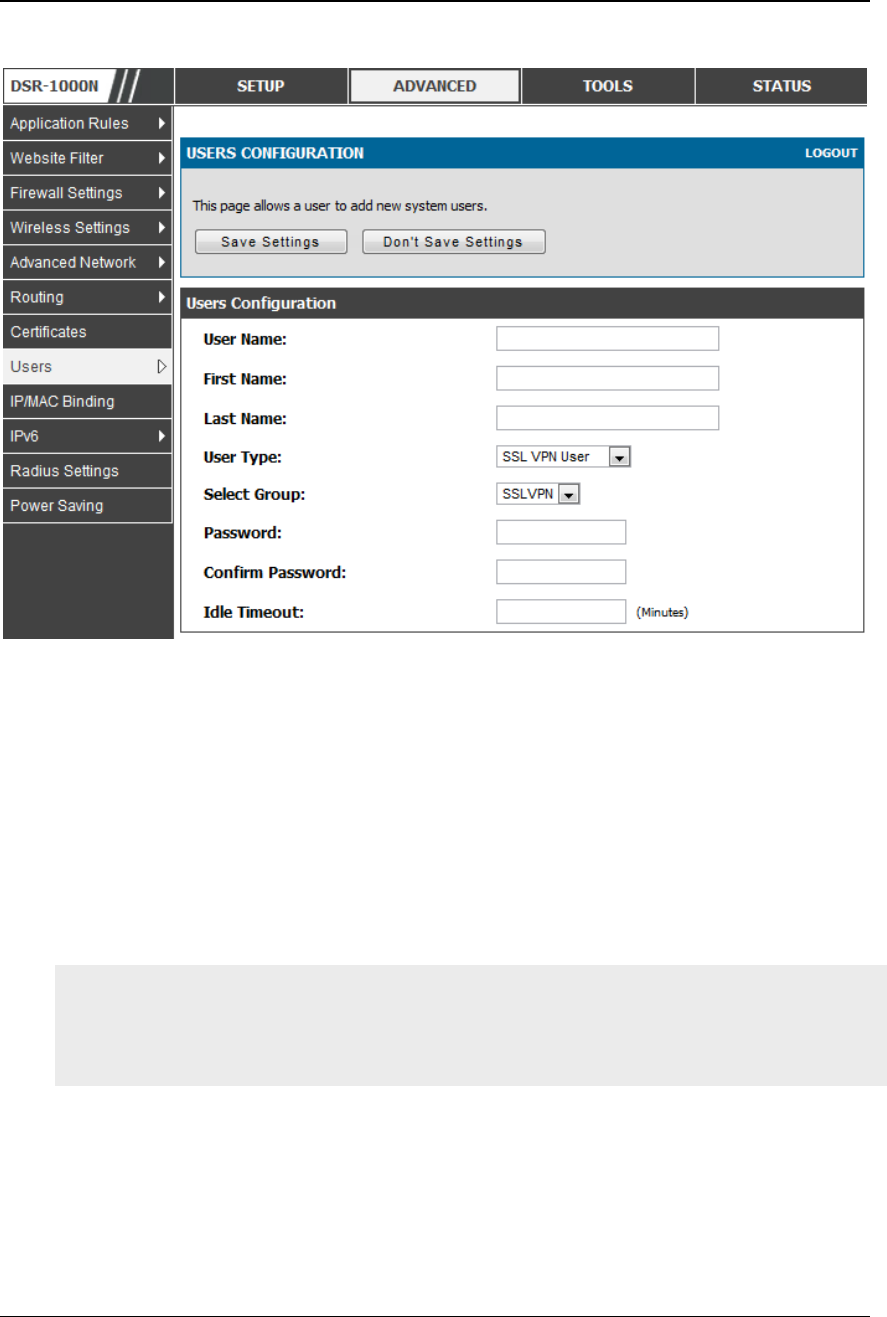
Unified Services Router User Manual
92
Figure 56: User configuration options
7.2 Using SSL VPN Policies
Setup > VPN Settings > SSL VPN Server > SSL VPN Policies
SSL VPN Policies can be created on a Global, Group, or User level. User level
policies take precedence over Group level policies and Group level policies take
precedence over Global policies. These policies can be applied to a specific network
resource, IP address or ranges on the LAN, or to different SSL VPN services
supported by the router. The List of Available Policies can be filtered based on
whether it applies to a user, group, or all users (global).
A more specific policy takes precedence over a generic policy when both are
applied to the same user/group/global domain. I.e. a policy for a specific IP address
takes precedence over a policy for a range of addresses containing the IP address
already referenced.
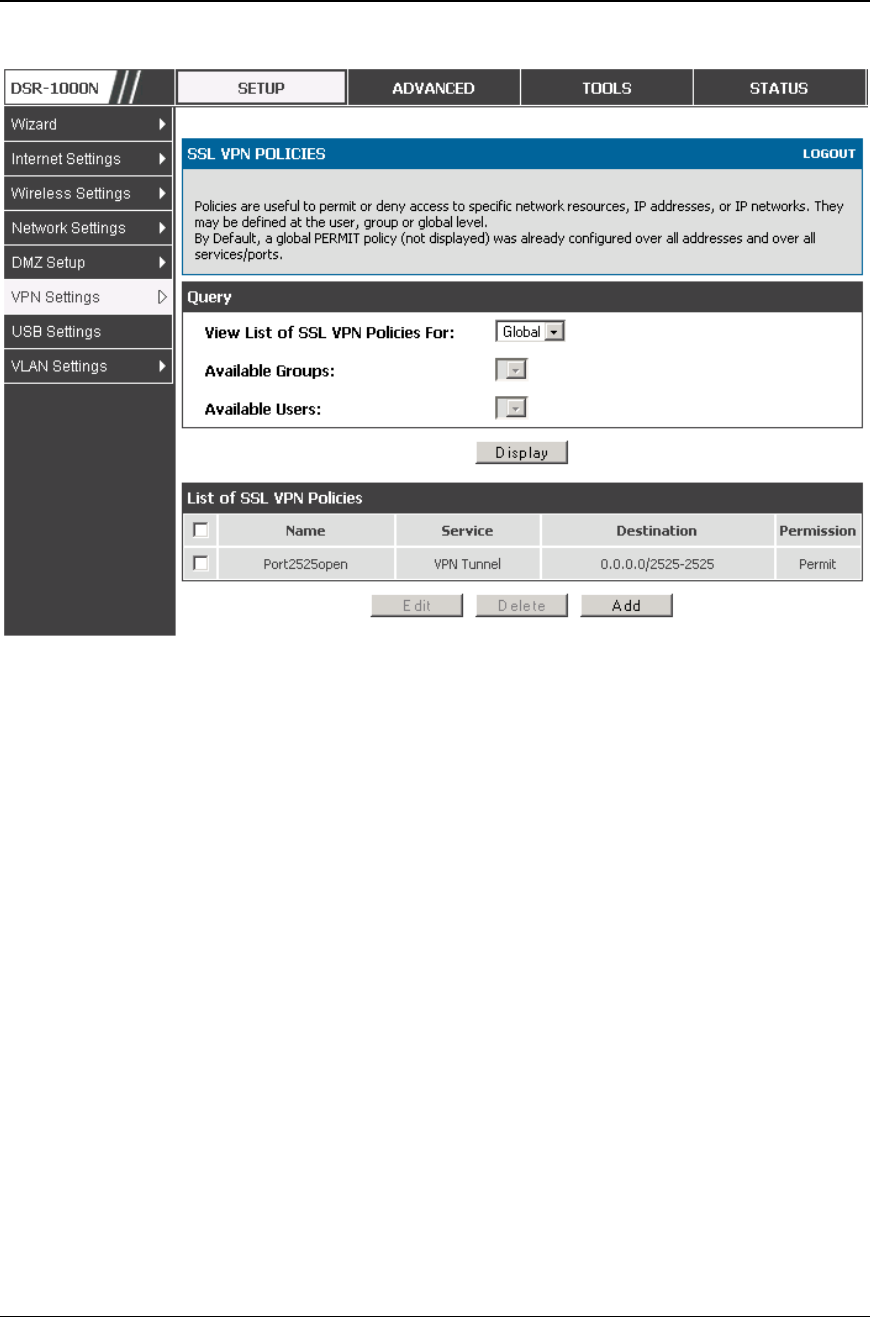
Unified Services Router User Manual
93
Figure 57: List of SSL VPN polices (Global filter)
To add a SSL VPN policy, you must first assign it to a user, group, or make it global
(i.e. applicable to all SSL VPN users). If the policy is for a group, the available
configured groups are shown in a drop down menu and one must be selected.
Similarly, for a user defined policy a SSL VPN user must be chosen from the
available list of configured users.
The next step is to define the policy details. The policy name is a unique identifier for
this rule. The policy can be assigned to a specific Network Resource (details follow in
the subsequent section), IP address, IP network, or all devices on the LAN of the
router. Based on the selection of one of these four options, the appropriate
configuration fields are required (i.e. choosing the network resources from a list of
defined resources, or defining the IP addresses). For applying the policy to addresses
the port range/port number can be defined.
The final steps require the policy permission to be set to either permit or deny access
to the selected addresses or network resources. As well the policy can be specified for
one or all of the supported SSL VPN services (i.e. VPN tunnel)
Once defined, the policy goes into effect immediately. The policy name, SSL service
it applies to, destination (network resource or IP addresses) and permission
(deny/permit) is outlined in a list of configured policies for the router.
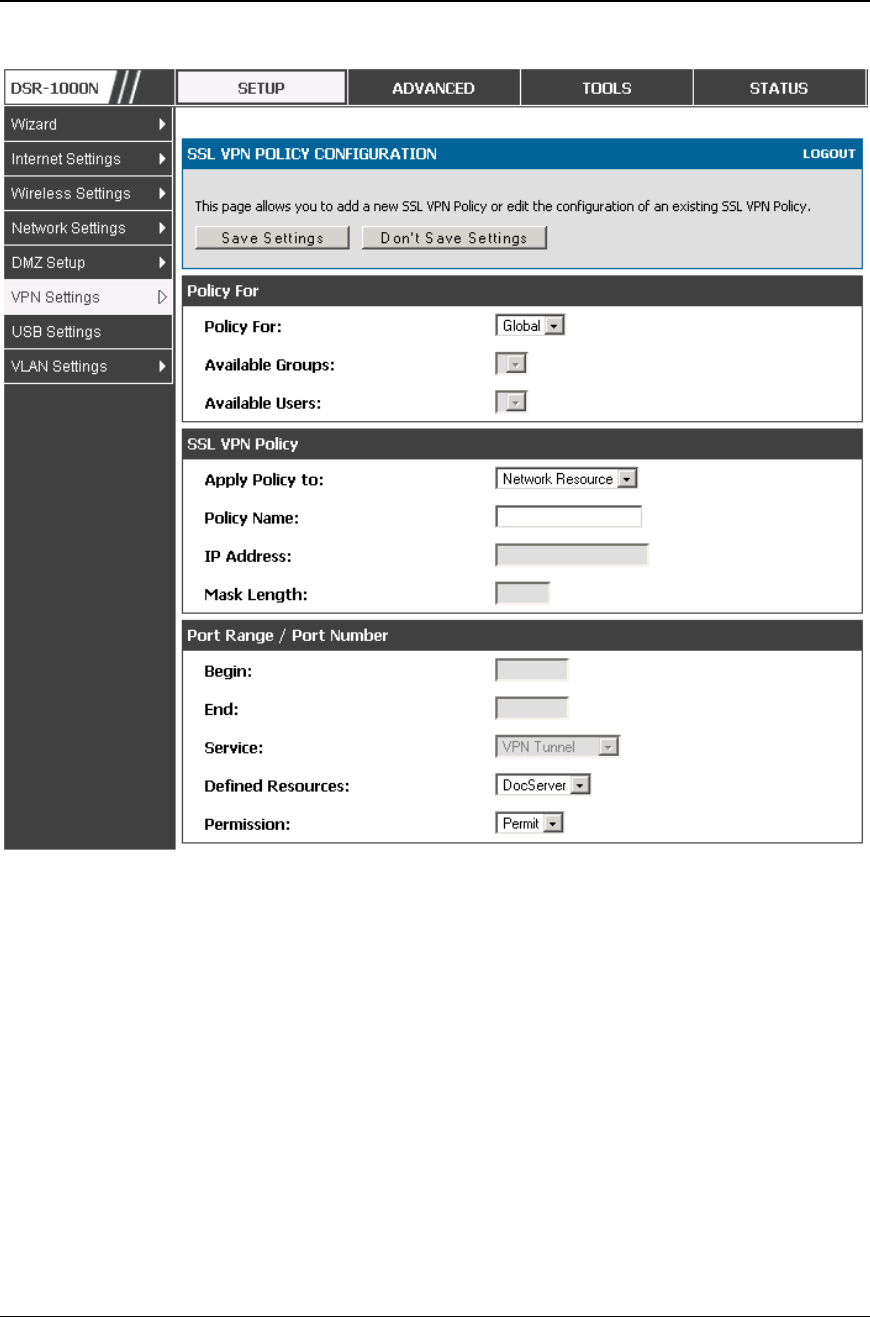
Unified Services Router User Manual
94
Figure 58: SSL VPN policy configuration
7.2.1 Using Network Resources
Setup > VPN Settings > SSL VPN Server > Resources
Network resources are services or groups of LAN IP addresses that are used to
easily create and configure SSL VPN policies. This shortcut saves time when
creating similar policies for multiple remote SSL VPN users.
Adding a Network Resource involves creating a unique name to identify the
resource and assigning it to one or all of the supported SSL services. Once this is
done, editing one of the created network resources allows you to configure the
object type (either IP address or IP range) associated with the service. The Network
Address, Mask Length, and Port Range/Port Number can all be defined for this
resource as required.
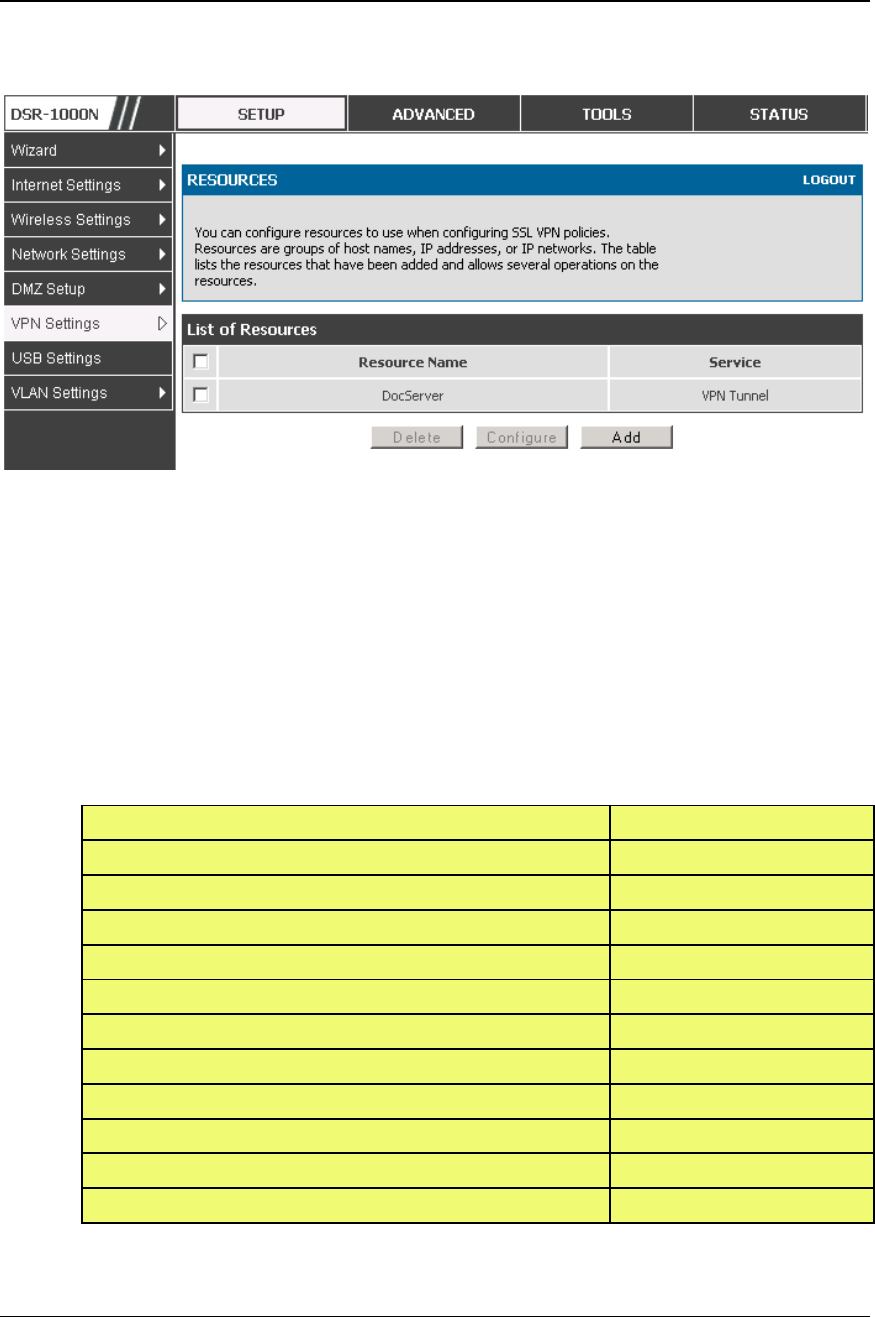
Unified Services Router User Manual
95
Figure 59: List of configured resources, which are available to assign to
SSL VPN policies
7.3 Application Port Forwarding
Setup > VPN Settings > SSL VPN Server > Port Forwarding
Port forwarding allows remote SSL users to access specified network applications or
services after they login to the User Portal and launch the Port Forwarding service.
Traffic from the remote user to the router is detected and re-routed based on
configured port forwarding rules.
Internal host servers or TCP applications must be specified as being made accessible
to remote users. Allowing access to a LAN server requires entering the local server IP
address and TCP port number of the application to be tunneled. The table below lists
some common applications and corresponding TCP port numbers:
TCP Application Port Number
FTP Data (usually not needed) 20
FTP Control Protocol 21
SSH 22
Telnet 23
SMTP (send mail) 25
HTTP (web) 80
POP3 (receive mail) 110
NTP (network time protocol) 123
Citrix 1494
Terminal Services 3389
VNC (virtual network computing) 5900 or 5800
As a convenience for remote users, the hostname (FQDN) of the network server can
be configured to allow for IP address resolution. This host name resolution provides
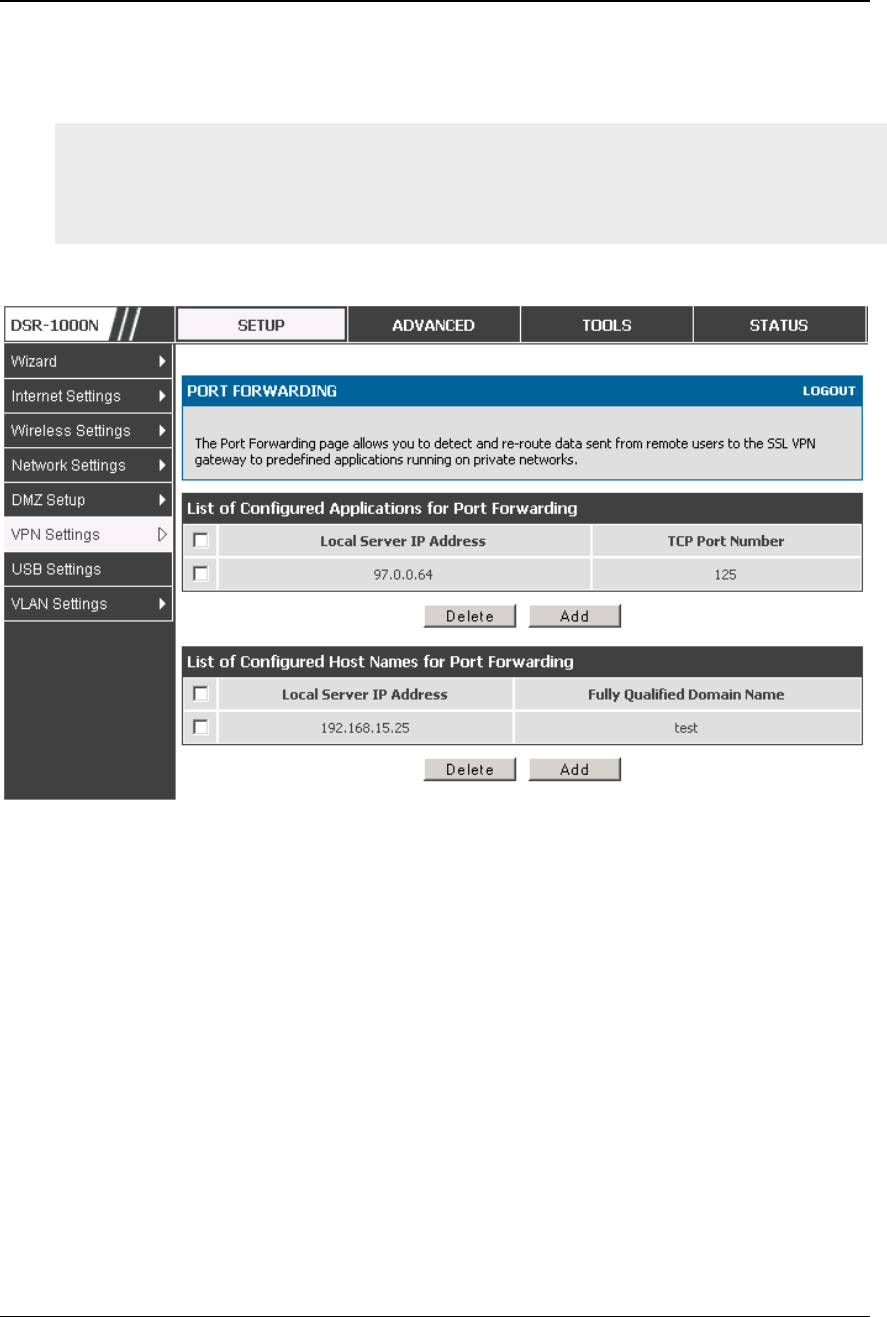
Unified Services Router User Manual
96
users with easy-to-remember FQDN’s to access TCP applications instead of error-
prone IP addresses when using the Port Forwarding service through the SSL User
Portal.
Defining the hostname is optional as minimum requirement for port forwarding is
identifying the TCP application and local server IP address. The local server IP
address of the configured hostname must match the IP address of the configured
application for port forwarding.
Figure 60: List of Available Applications for SSL Port Forwarding
7.4 SSL VPN Client Configuration
Setup > VPN Settings > SSL VPN Client > SSL VPN Client
An SSL VPN tunnel client provides a point-to-point connection between the browser-
side machine and this router. When a SSL VPN client is launched from the user
portal, a "network adapter" with an IP address from the corporate subnet, DNS and
WINS settings is automatically created. This allows local applications to access
services on the private network without any special network configuration on the
remote SSL VPN client machine.
It is important to ensure that the virtual (PPP) interface address of the VPN tunnel
client does not conflict with physical devices on the LAN. The IP address range for
the SSL VPN virtual network adapter should be either in a different subnet or non-
overlapping range as the corporate LAN.
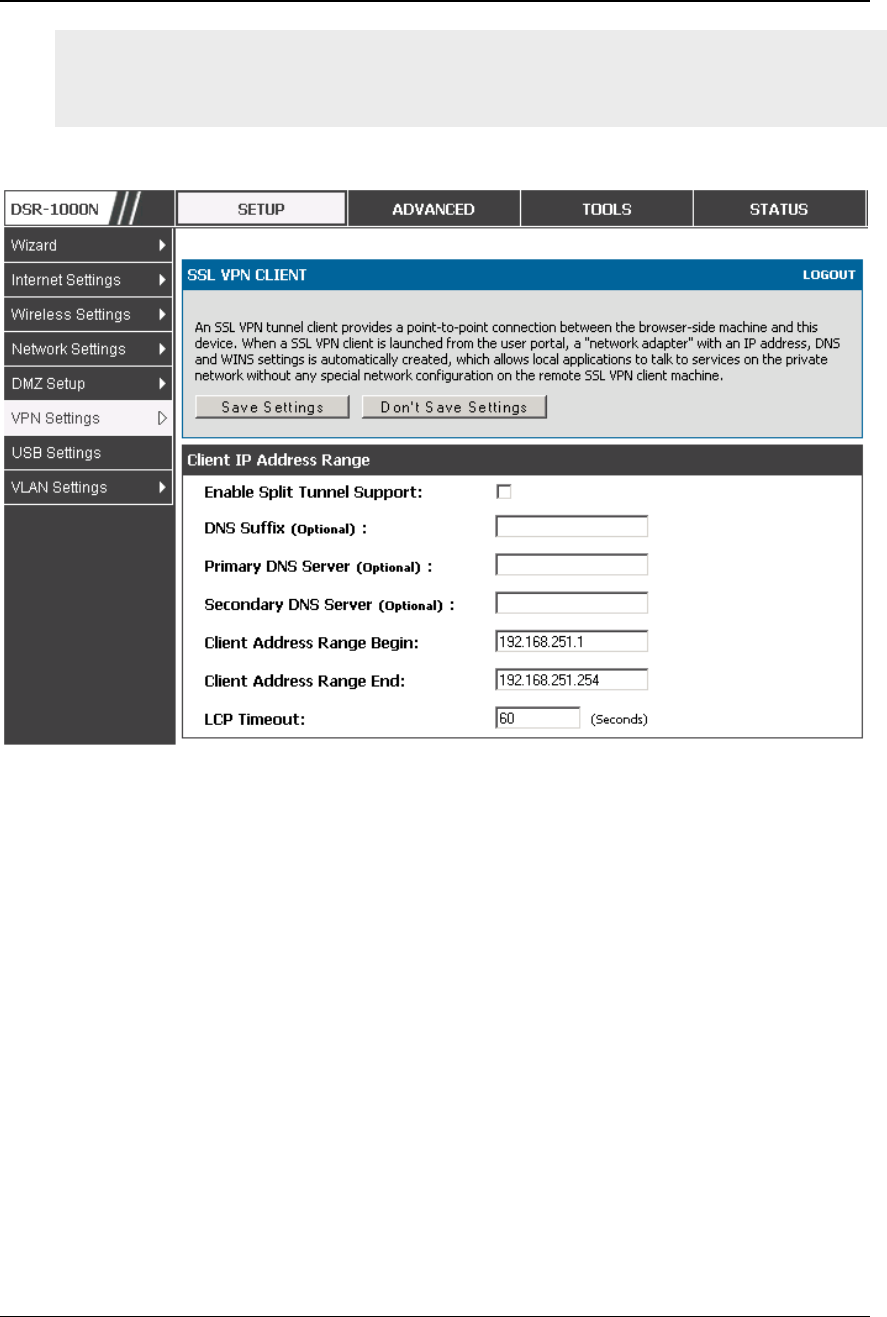
Unified Services Router User Manual
97
The IP addresses of the client’s network interfaces (Ethernet, Wireless, etc.) cannot
be identical to the router’s IP address or a server on the corporate LAN that is
being accessed through the SSL VPN tunnel.
Figure 61: SSL VPN client adapter and access configuration
The router allows full tunnel and split tunnel support. Full tunnel mode just sends all
traffic from the client across the VPN tunnel to the router. Split tunnel mode only
sends traffic to the private LAN based on pre-specified client routes. These client
routes give the SSL client access to specific private networks, thereby allowing access
control over specific LAN services.
Setup > VPN Settings > SSL VPN Client > Configured Client Routes
If the SSL VPN client is assigned an IP address in a different subnet than the
corporate network, a client route must be added to allow access to the private LAN
through the VPN tunnel. As well a static route on the private LAN’s firewall
(typically this router) is needed to forward private traffic through the VPN Firewall to
the remote SSL VPN client.
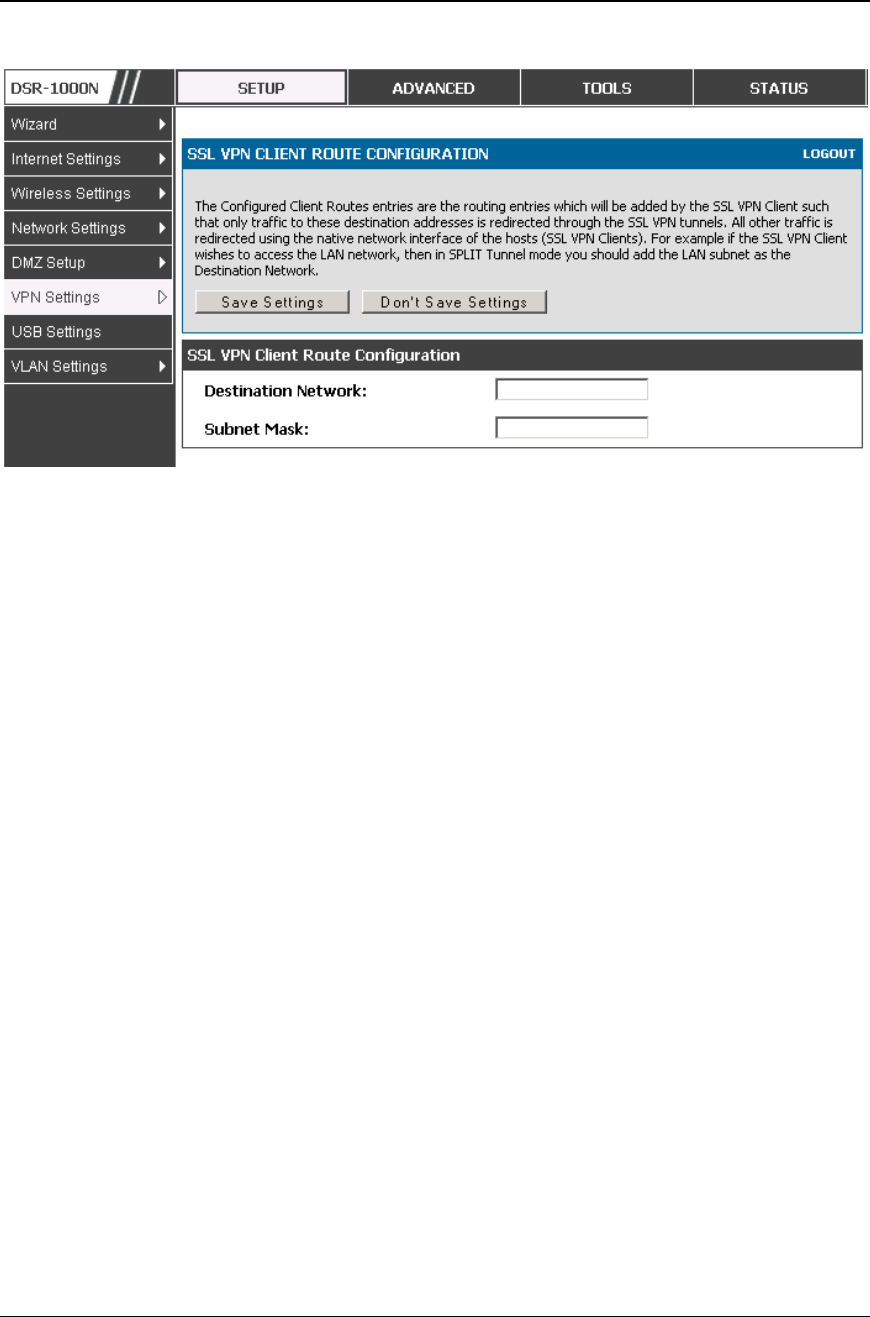
Unified Services Router User Manual
98
Figure 62: Configured client routes only apply in split tunnel mode
7.5 User Portal
Setup > VPN Settings > SSL VPN Client > SSL VPN Client Portal
When remote users want to access the private network through an SSL tunnel (either
using the Port Forwarding or VPN tunnel service), they login through a user portal.
This portal provides the authentication fields to provide the appropriate access levels
and privileges as determined by the router administrator. The domain where the user
account is stored must be specified, and the domain determines the authentication
method and portal layout screen presented to the remote user.
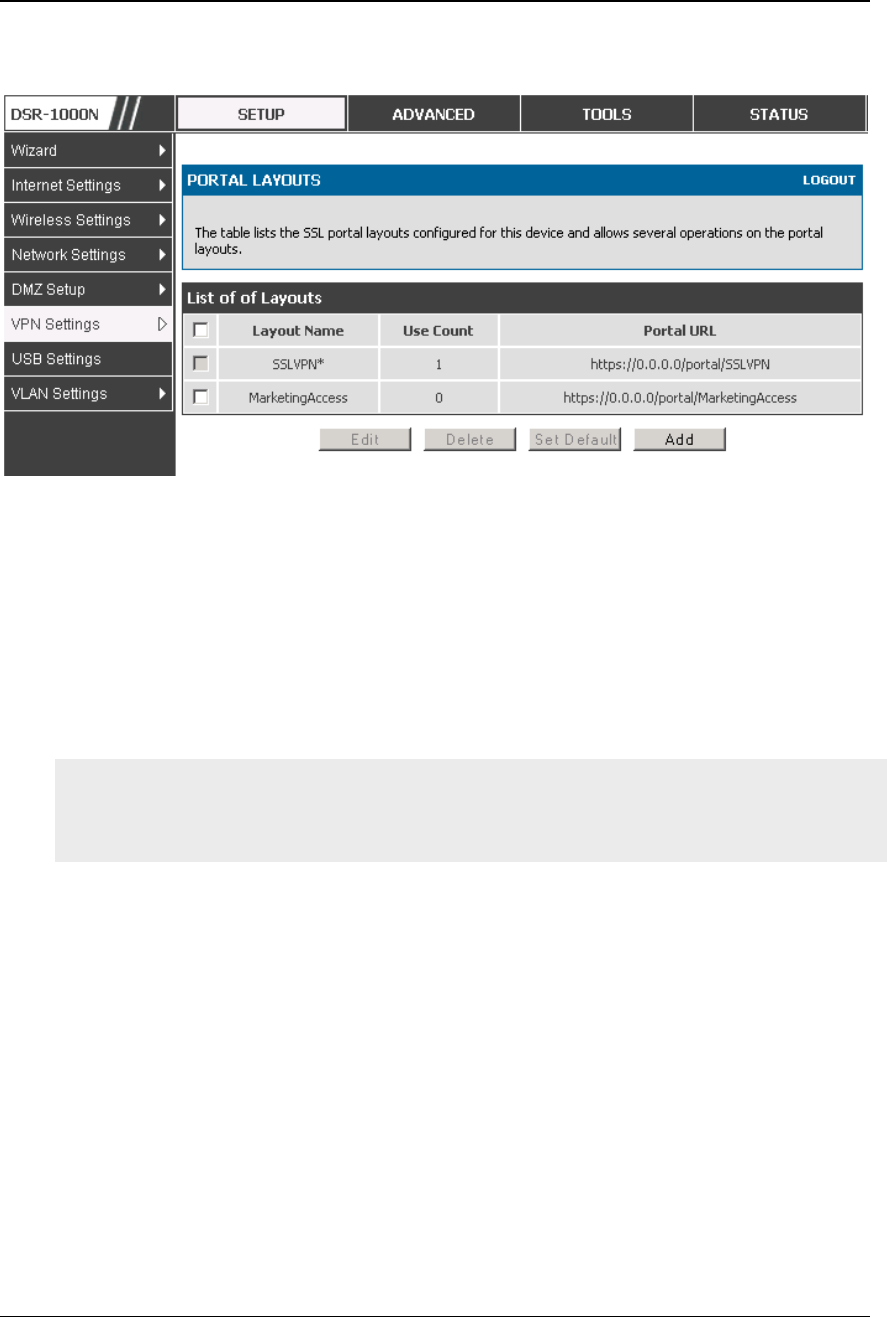
Unified Services Router User Manual
99
Figure 63: List of configured SSL VPN portals. The configured portal
can then be associated with an authentication domain
7.5.1 Creating Portal Layouts
Setup > VPN Settings > SSL VPN Server > Portal Layouts
The router allows you to create a custom page for remote SSL VPN users that is
presented upon authentication. There are various fields in the portal that are
customizable for the domain, and this allows the router administrator to
communicate details such as login instructions, available services, and other usage
details in the portal visible to remote users. During domain setup, configured portal
layouts are available to select for all users authenticated by the domain.
The default portal LAN IP address is https://192.168.10.1/scgi-
bin/userPortal/portal. This is the same page that opens when the “User Portal”
link is clicked on the SSL VPN menu of the router GUI.
The router administrator creates and edits portal layouts from the configuration
pages in the SSL VPN menu. The portal name, title, banner name, and banner
contents are all customizable to the intended users for this portal. The portal name is
appended to the SSL VPN portal URL. As well, the users assigned to this portal
(through their authentication domain) can be presented with one or more of the
router’s supported SSL services such as the VPN Tunnel page or Port Forwarding
page.
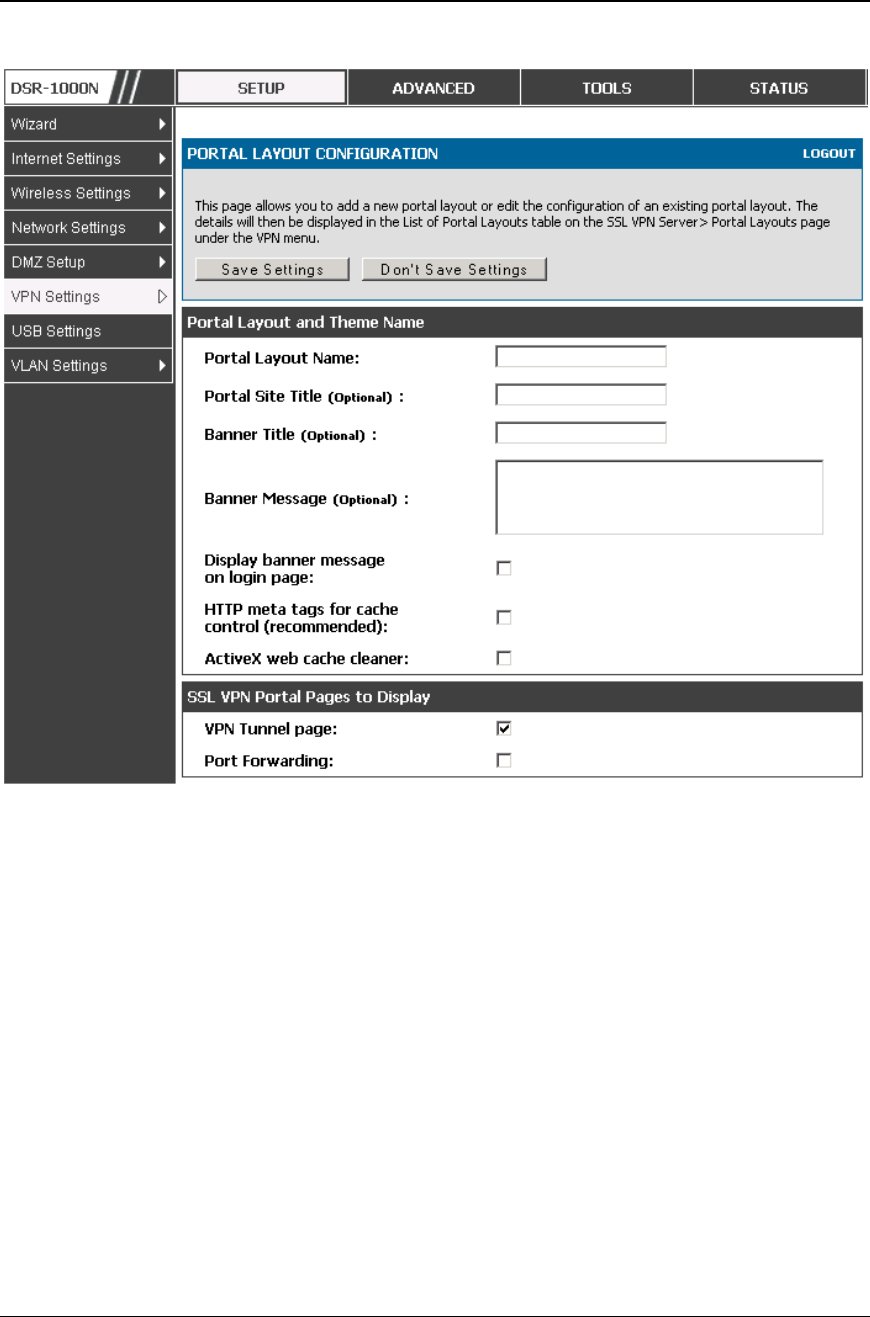
Unified Services Router User Manual
100
Figure 64: SSL VPN Portal configuration
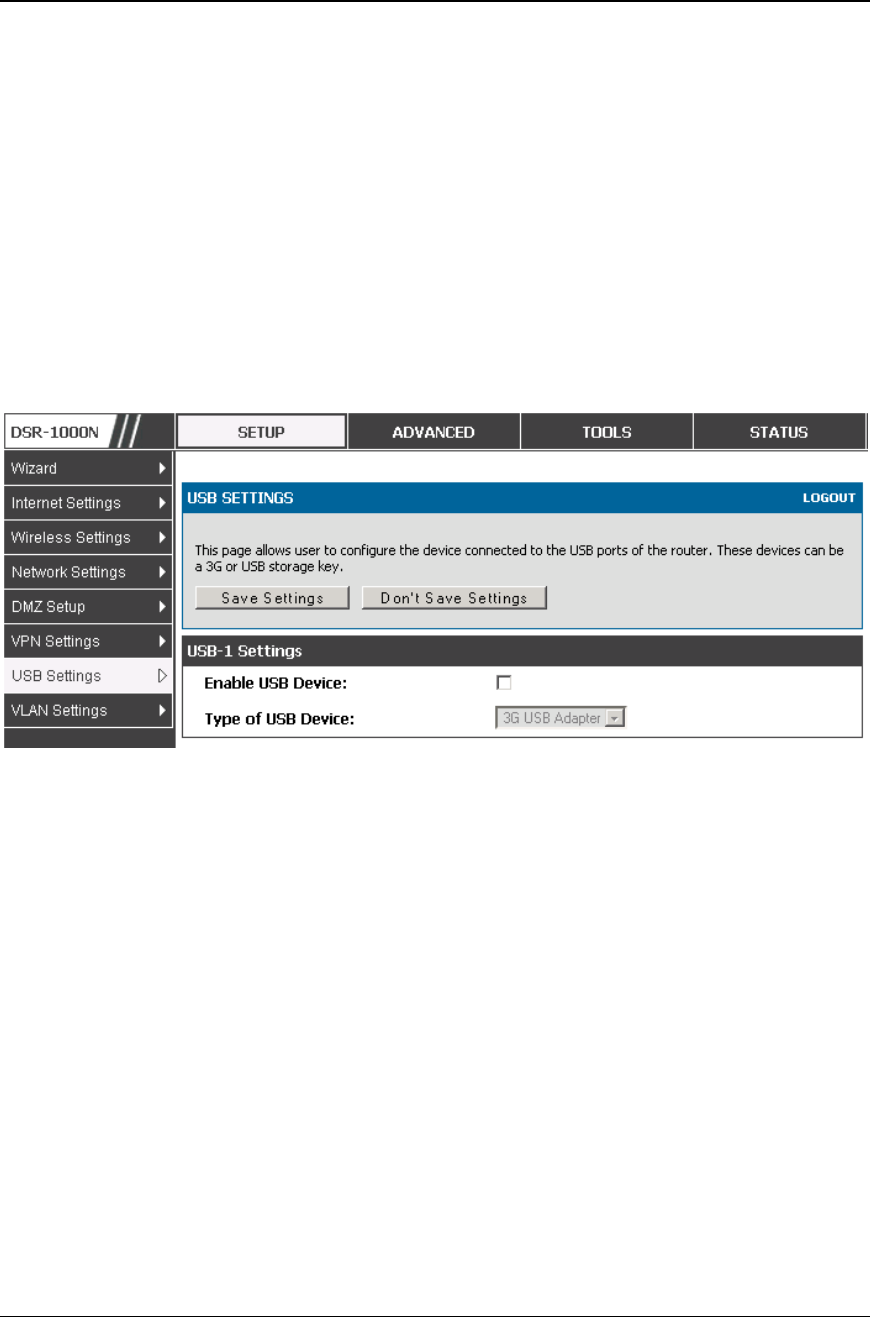
Unified Services Router User Manual
101
Chapter 8. Advanced Configuration
Tools
8.1 USB Device Setup
Setup > USB Settings
There are two USB ports on the DSR Unified Services Router. The port supports a 3G
modem where the USB dongle is used as a secondary WAN interface. Additionally,
the port can be used for a USB storage device if USB Disc is type is selected. This
storage can be accessed by LAN devices if appropriate policies are configured.
Figure 65: USB device configuration
8.2 Authentication Certificates
Advanced > Certificates
This gateway uses digital certificates for IPSec VPN authentication as well as SSL
validation (for HTTPS and SSL VPN authentication). You can obtain a digital
certificate from a well known Certificate Authority (CA) such as VeriSign, or
generate and sign your own certificate using functionality available on this gateway.
The gateway comes with a self-signed certificate, and this can be replaced by one
signed by a CA as per your networking requirements. A CA certificate provides
strong assurance of the server’s identity and is a requirement for most corporate
network VPN solutions.
The certificates menu allows you to view a list of certificates (both from a CA and
self-signed) currently loaded on the gateway. The following certificate data is
displayed in the list of Trusted (CA) certificates:
CA Identity (Subject Name): The certificate is issued to this person or organization
Issuer Name: This is the CA name that issued this certificate
Expiry Time: The date after which this Trusted certificate becomes invalid
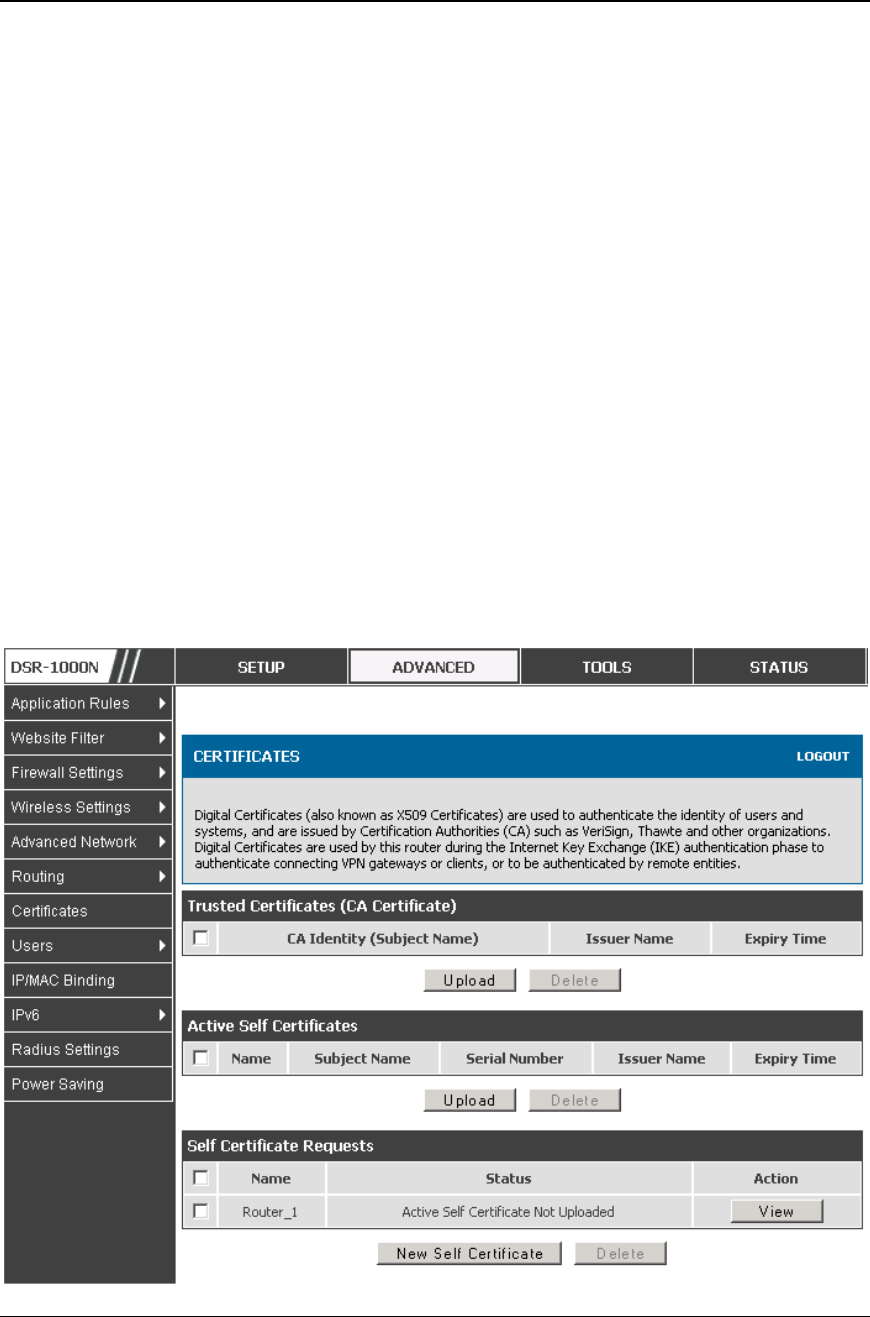
Unified Services Router User Manual
102
A self certificate is a certificate issued by a CA identifying your device (or self-
signed if you don’t want the identity protection of a CA). The Active Self Certificate
table lists the self certificates currently loaded on the gateway. The following
information is displayed for each uploaded self certificate:
Name: The name you use to identify this certificate, it is not displayed to IPSec VPN
peers or SSL users.
Subject Name: This is the name that will be displayed as the owner of this certificate.
This should be your official registered or company name, as IPSec or SSL VPN peers
are shown this field.
Serial Number: The serial number is maintained by the CA and used to identify this
signed certificate.
Issuer Name: This is the CA name that issued (signed) this certificate
Expiry Time: The date after which this signed certificate becomes invalid – you
should renew the certificate before it expires.
To request a self certificate to be signed by a CA, you can generate a Certificate
Signing Request from the gateway by entering identification parameters and passing it
along to the CA for signing. Once signed, the CA’s Trusted Certificate and signed
certificate from the CA are uploaded to activate the self-certificate validating the
identity of this gateway. The self certificate is then used in IPSec and SSL
connections with peers to validate the gateway’s authenticity.
Figure 66: Certificate summary for IPSec and HTTPS management
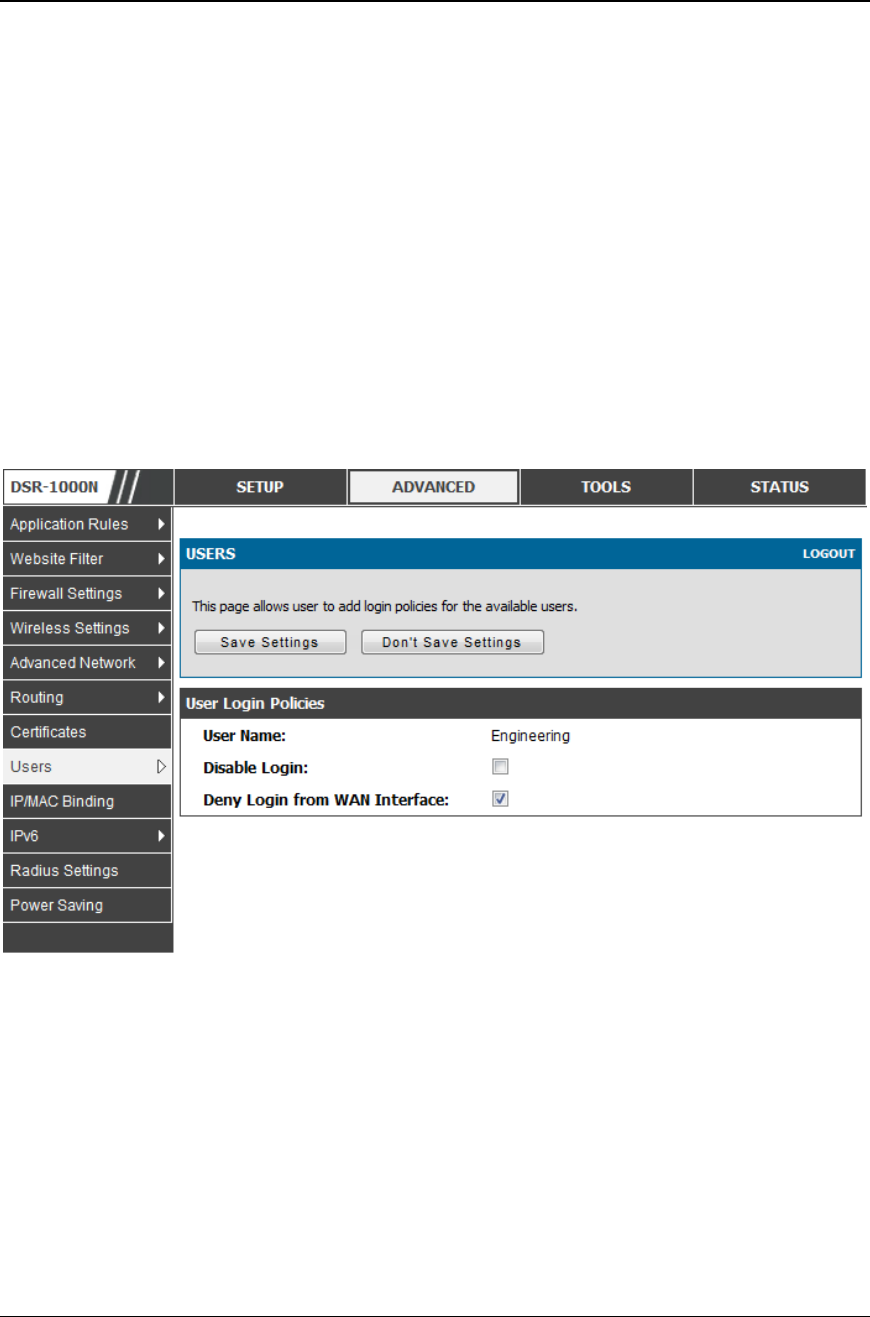
Unified Services Router User Manual
103
Chapter 9. Administration &
Management
9.1 Configuration Access Control
The primary means to configure this gateway via the browser-independent GUI. The
GUI can be accessed from LAN node by using the gateway’s LAN IP address and
HTTP, or from the WAN by using the gateway’s WAN IP address and HTTPS (HTTP
over SSL).
Administrator and Guest users are permitted to login to the router’s management
interface. The user type is set in the Advanced > Users > Users page. The Admin or
Guest user can be configured to access the router GUI from the LAN or the Internet
(WAN) by enabling the corresponding Login Policy.
Figure 67: User Login policy configuration
9.1.1 Remote Management
Both HTTPS and telnet access can be restricted to a subset of IP addresses. The
router administrator can define a known PC, single IP address or range of IP
addresses that are allowed to access the GUI with HTTPS. The opened port for SSL
traffic can be changed from the default of 443 at the same time as defining the
allowed remote management IP address range.
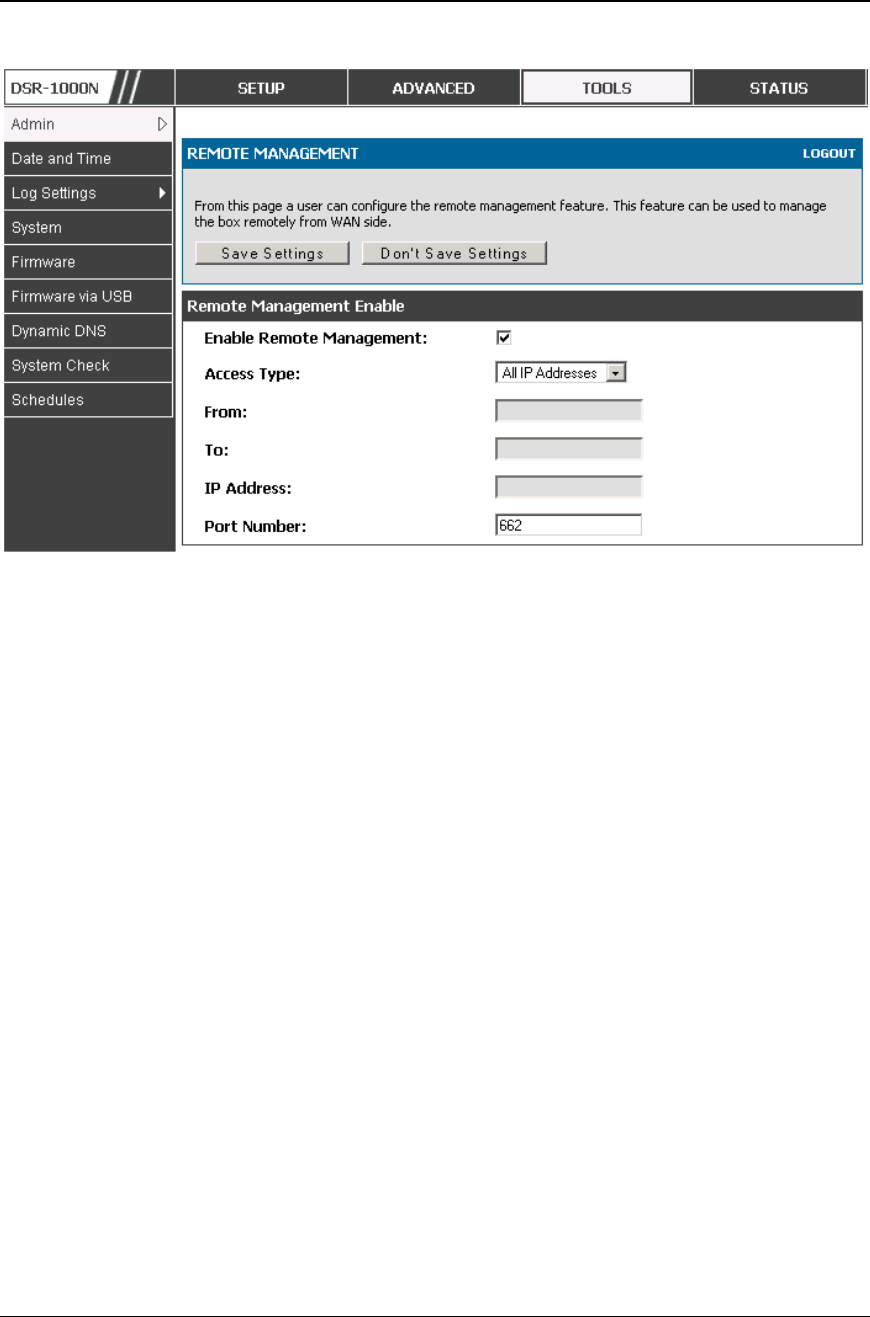
Unified Services Router User Manual
104
Figure 68: Remote Management from the WAN
9.1.2 CLI Access
In addition to the web-based GUI, the gateway supports SSH and Telnet
management for command-line interaction. The CLI login credentials are shared
with the GUI for administrator users. To access the CLI, type “cli” in the SSH or
console prompt and login with administrator user credentials.
9.2 SNMP Configuration
Tools > Admin > SNMP
SNMP is an additional management tool that is useful when multiple routers in a
network are being managed by a central Master system. When an external SNMP
manager is provided with this router’s Management Information Base (MIB) file, the
manager can update the router’s hierarchal variables to view or update configuration
parameters. The router as a managed device has an SNMP agent that allows the MIB
configuration variables to be accessed by the Master (the SNMP manager). The
Access Control List on the router identifies managers in the network that have read-
only or read-write SNMP credentials. The Traps List outlines the port over which
notifications from this router are provided to the SNMP community (managers) and
also the SNMP version (v1, v2c, v3) for the trap.
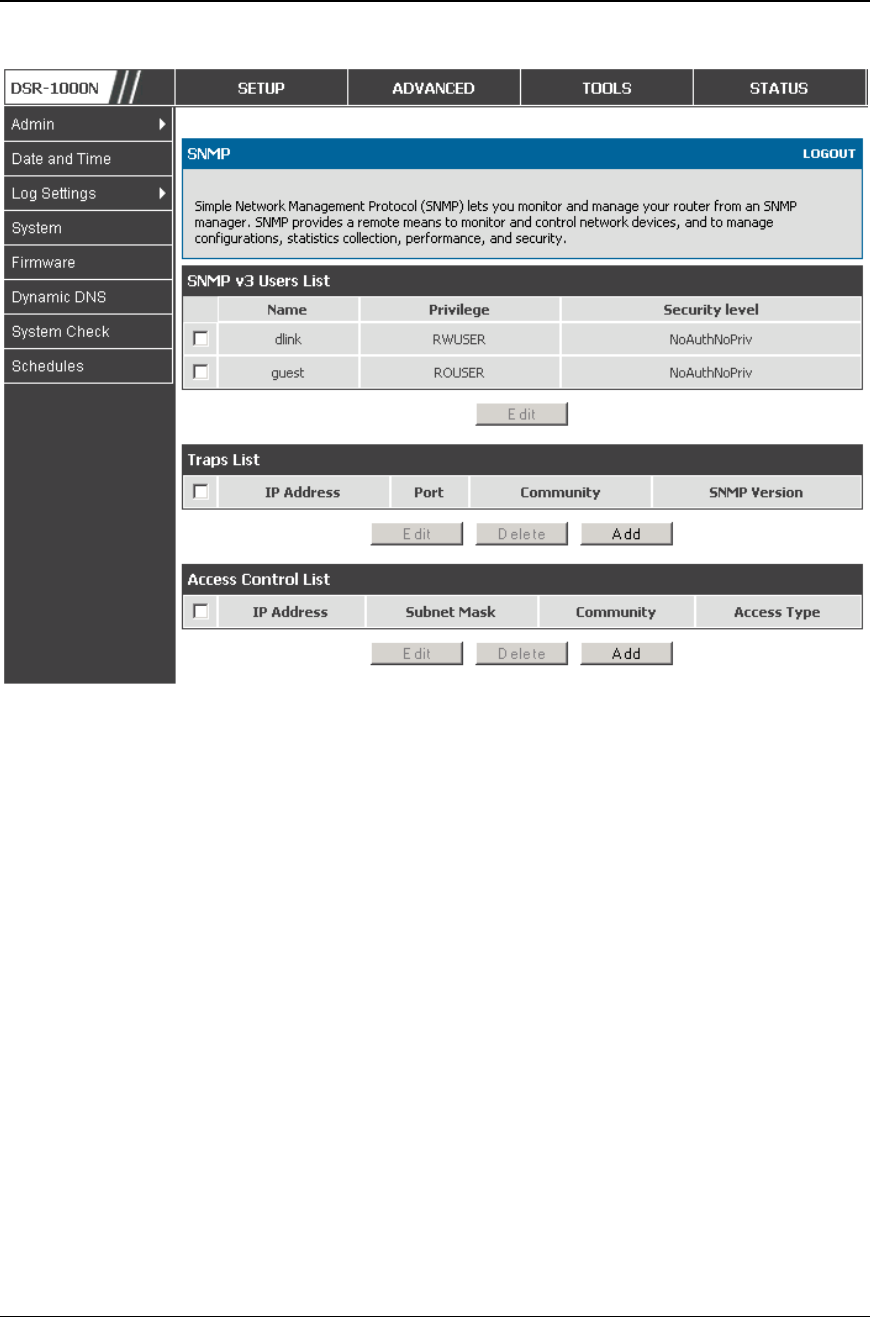
Unified Services Router User Manual
105
Figure 69: SNMP Users, Traps, and Access Control
Tools > Admin > SNMP System Info
The router is identified by an SNMP manager via the System Information. The
identifier settings The SysName set here is also used to identify the router for SysLog
logging.
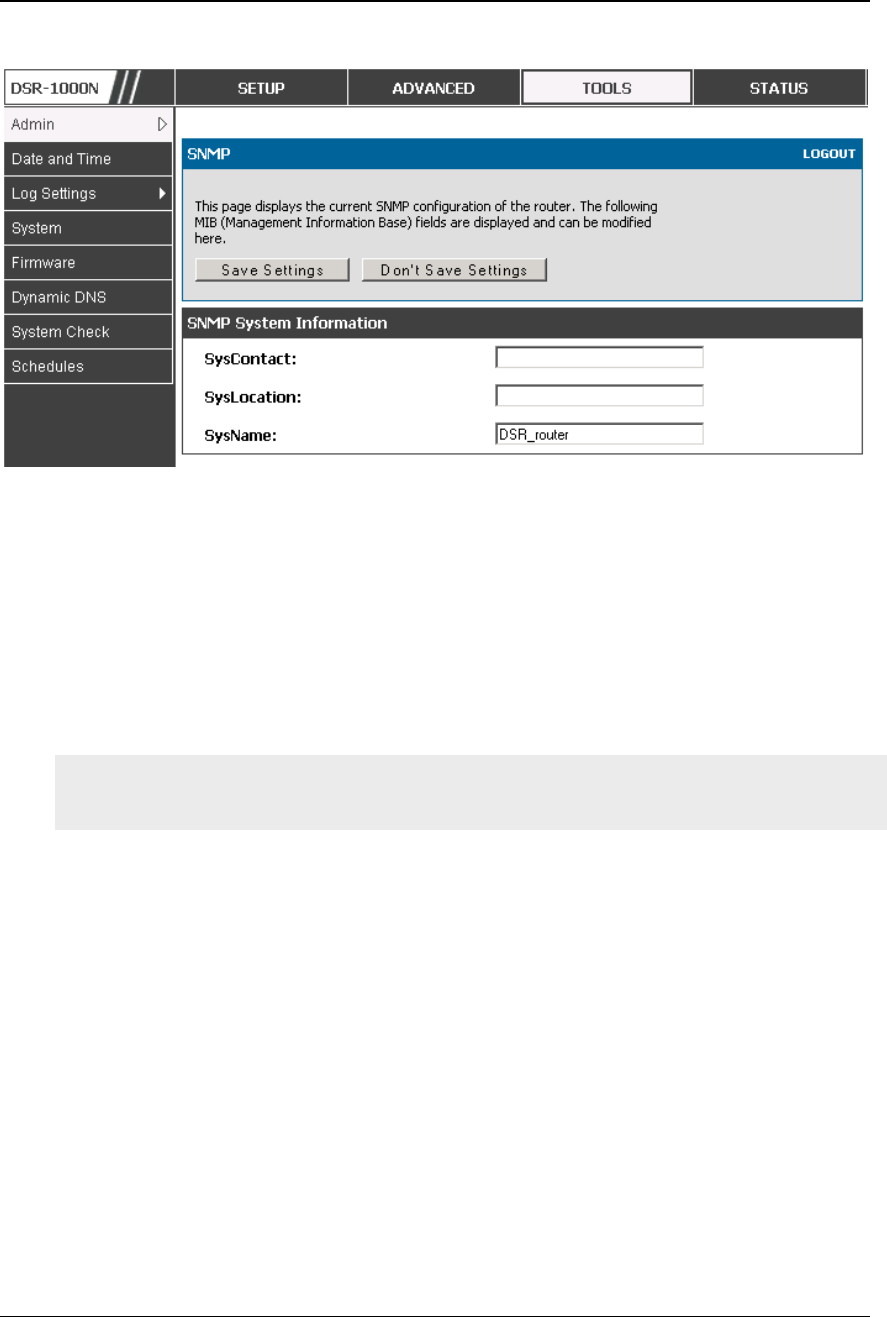
Unified Services Router User Manual
106
Figure 70: SNMP system information for this router
9.3 Configuring Time Zone and NTP
Tools > Date and Time
You can configure your time zone, whether or not to adjust for Daylight Savings
Time, and with which Network Time Protocol (NTP) server to synchronize the date
and time. You can choose to set Date and Time manually, which will store the
information on the router’s real time clock (RTC). If the router has access to the
internet, the most accurate mechanism to set the router time is to enable NTP server
communication.
Accurate date and time on the router is critical for firewall schedules, Wi-Fi power
saving support to disable APs at certain times of the day, and accurate logging.
Please follow the steps below to configure the NTP server:
1. Select the router’s time zone, relative to Greenwich Mean Time (GMT).
2. If supported for your region, click to Enable Daylight Savings.
3. Determine whether to use default or custom Network Time Protocol (NTP) servers. If
custom, enter the server addresses or FQDN.
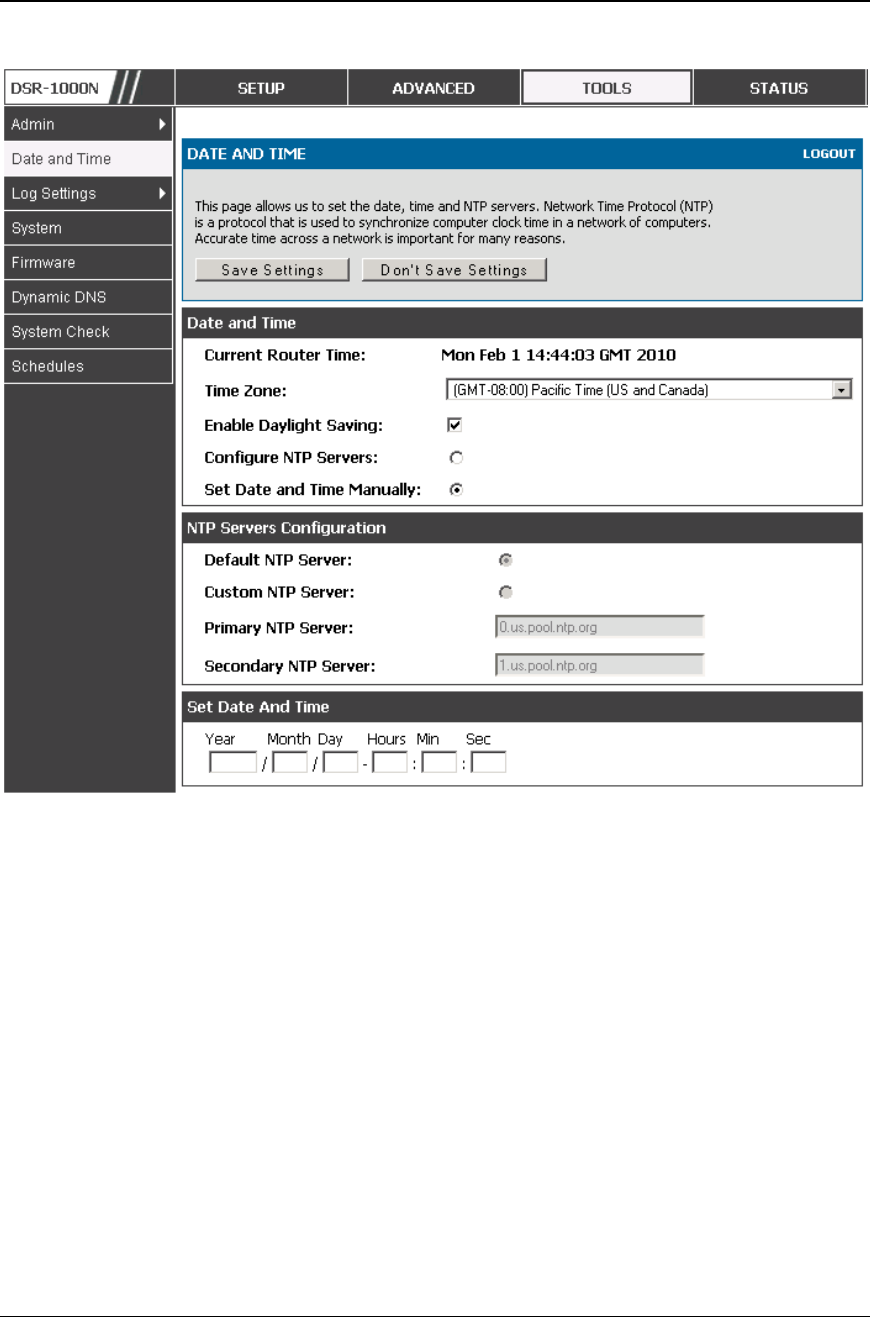
Unified Services Router User Manual
107
Figure 71: Date, Time, and NTP server setup
9.4 Log Configuration
This router allows you to capture log messages for traffic through the firewall, VPN,
and over the wireless AP. As an administrator you can monitor the type of traffic that
goes through the router and also be notified of potential attacks or errors when they
are detected by the router. The following sections describe the log configuration
settings and the ways you can access these logs.
9.4.1 Defining What to Log
Tools > Log Settings > Logs Facility
The Logs Facility page allows you to determine the granularity of logs to receive
from the router. There are three core components of the router, referred to as
Facilities:
• Kernel: This refers to the Linux kernel. Log messages that correspond to
this facility would correspond to traffic through the firewall or network
stack.

Unified Services Router User Manual
108
• System: This refers to application and management level features available
on this router, including SSL VPN and administrator changes for managing
the unit.
• Wireless: This facility corresponds to the 802.11 driver used for providing
AP functionality to your network.
For each facility, the following events (in order of severity) can be logged:
Emergency, Alert, Critical, Error, Warning, Notification, Information, Debugging.
When a particular severity level is selected, all events with severity equal to and
greater than the chosen severity are captured. For example if you have configured
CRITICAL level logging for the Wireless facility, then 802.11 logs with severities
CRITICAL, ALERT, and EMERGENCY are logged. The severity levels available
for logging are:
• EMERGENCY: system is unusable
• ALERT: action must be taken immediately
• CRITICAL: critical conditions
• ERROR: error conditions
• WARNING: warning conditions
• NOTIFICATION: normal but significant condition
• INFORMATION: informational
• DEBUGGING: debug-level messages
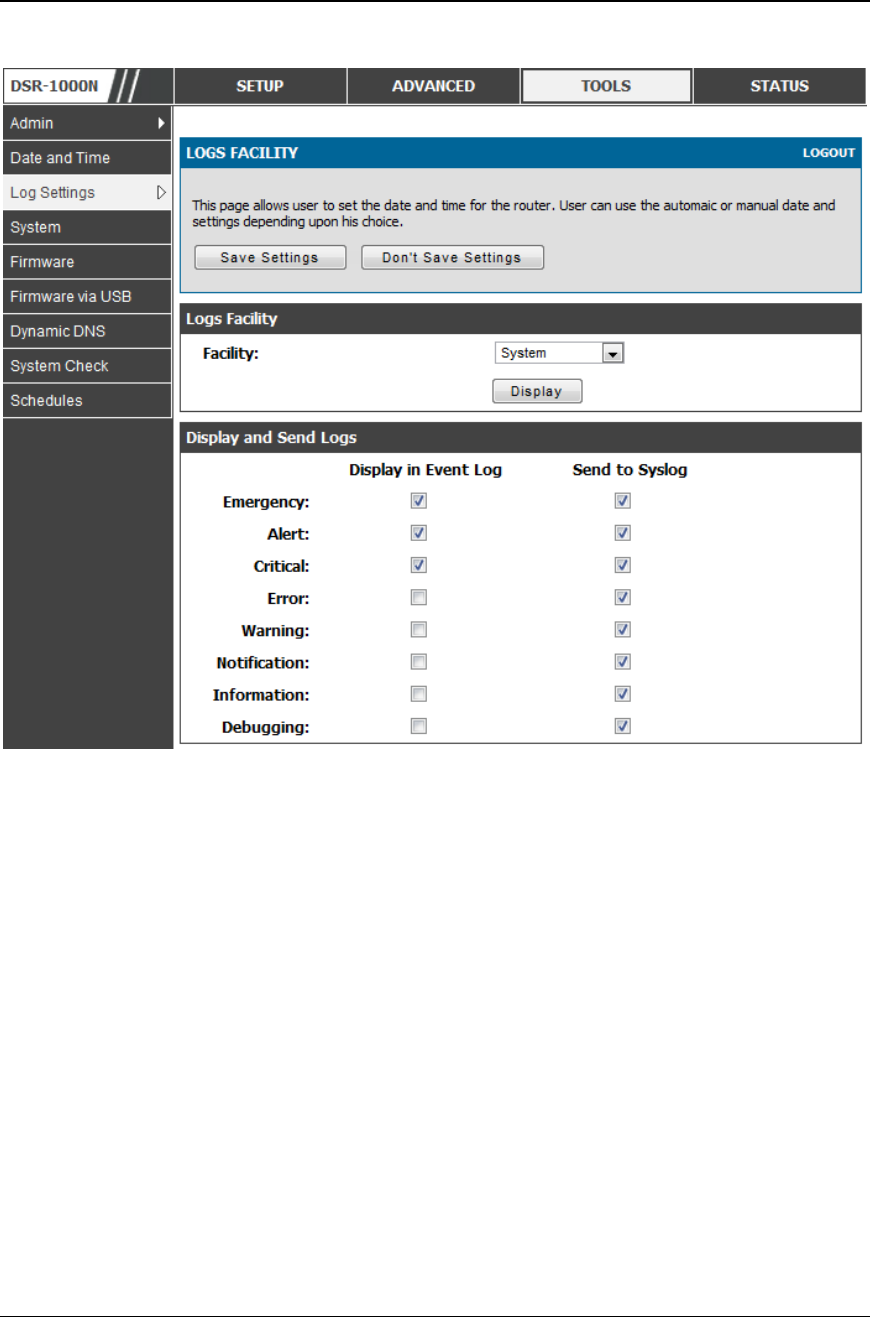
Unified Services Router User Manual
109
Figure 72: Facility settings for Logging
The display for logging can be customized based on where the logs are sent, either
the Event Log viewer in the GUI (the Event Log viewer is in the Status > Logs
page) or a remote Syslog server for later review. E-mail logs, discussed in a
subsequent section, follow the same configuration as logs configured for a Syslog
server.
Tools > Log Settings > Logs Configuration
This page allows you to determine the type of traffic through the router that is
logged for display in Syslog, E-mailed logs, or the Event Viewer. Denial of service
attacks, general attack information, login attempts, dropped packets, and similar
events can be captured for review by the IT administrator.
Traffic through each network segment (LAN, WAN, DMZ) can be tracked based on
whether the packet was accepted or dropped by the firewall.
Accepted Packets are those that were successfully transferred through the
corresponding network segment (i.e. LAN to WAN). This option is particularly
useful when the Default Outbound Policy is “Block Always” so the IT admin can
monitor traffic that is passed through the firewall.

Unified Services Router User Manual
110
• Example: If Accept Packets from LAN to WAN is enabled and there is a
firewall rule to allow SSH traffic from LAN, then whenever a LAN machine
tries to make an SSH connection, those packets will be accepted and a
message will be logged. (Assuming the log option is set to Allow for the
SSH firewall rule.)
Dropped Packets are packets that were intentionally blocked from being transferred
through the corresponding network segment. This option is useful when the Default
Outbound Policy is “Allow Always”.
• Example: If Drop Packets from LAN to WAN is enabled and there is a
firewall rule to block ssh traffic from LAN, then whenever a LAN machine
tries to make an ssh connection, those packets will be dropped and a
message will be logged. (Make sure the log option is set to allow for this
firewall rule.)
Enabling accepted packet logging through the firewall may generate a significant
volume of log messages depending on the typical network traffic. This is
recommended for debugging purposes only.
In addition to network segment logging, unicast and multicast traffic can be logged.
Unicast packets have a single destination on the network, whereas broadcast (or
multicast) packets are sent to all possible destinations simultaneously. One other
useful log control is to log packets that are dropped due to configured bandwidth
profiles over a particular interface. This data will indicate to the admin whether the
bandwidth profile has to be modified to account for the desired internet traffic of
LAN users.
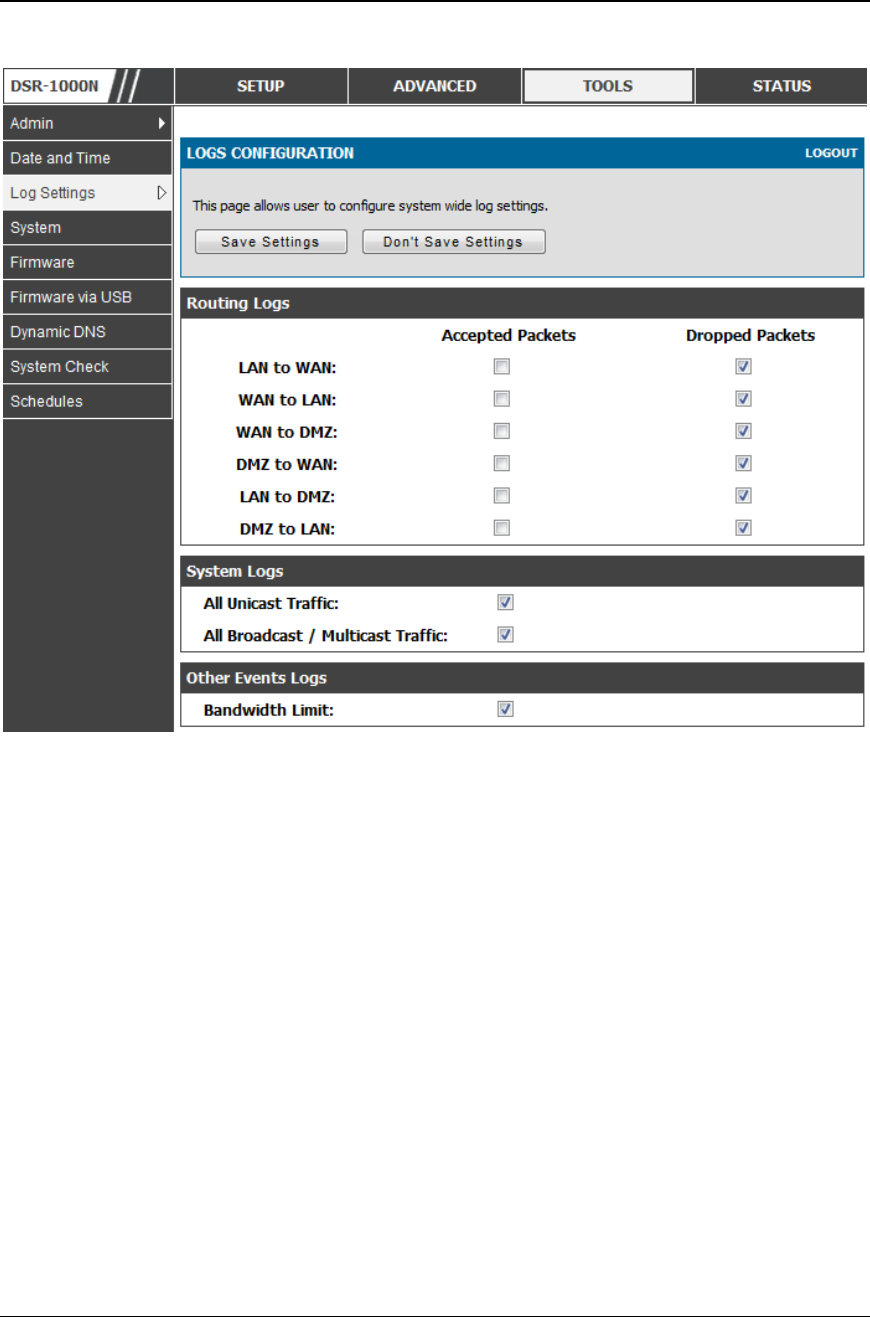
Unified Services Router User Manual
111
Figure 73: Log configuration options for traffic through router
9.4.2 Sending Logs to E-mail or Syslog
Tools > Log Settings > Remote Logging
Once you have configured the type of logs that you want the router to collect, they
can be sent to either a Syslog server or an E-Mail address. For remote logging a key
configuration field is the Remote Log Identifier. Every logged message will contain
the configured prefix of the Remote Log Identifier, so that syslog servers or email
addresses that receive logs from more than one router can sort for the relevant
device’s logs.
Once you enable the option to e-mail logs, enter the e-mail server’s address (IP
address or FQDN) of the SMTP server. The router will connect to this server when
sending e-mails out to the configured addresses. The SMPT port and return e-mail
addresses are required fields to allow the router to package the logs and send a valid
e-mail that is accepted by one of the configured “send-to” addresses. Up to three e-
mail addresses can be configured as log recipients.
In order to establish a connection with the configured SMTP port and server, define
the server’s authentication requirements. The router supports Login Plain (no
encryption) or CRAM-MD5 (encrypted) for the username and password data to be
sent to the SMTP server. Authentication can be disabled if the server does not have
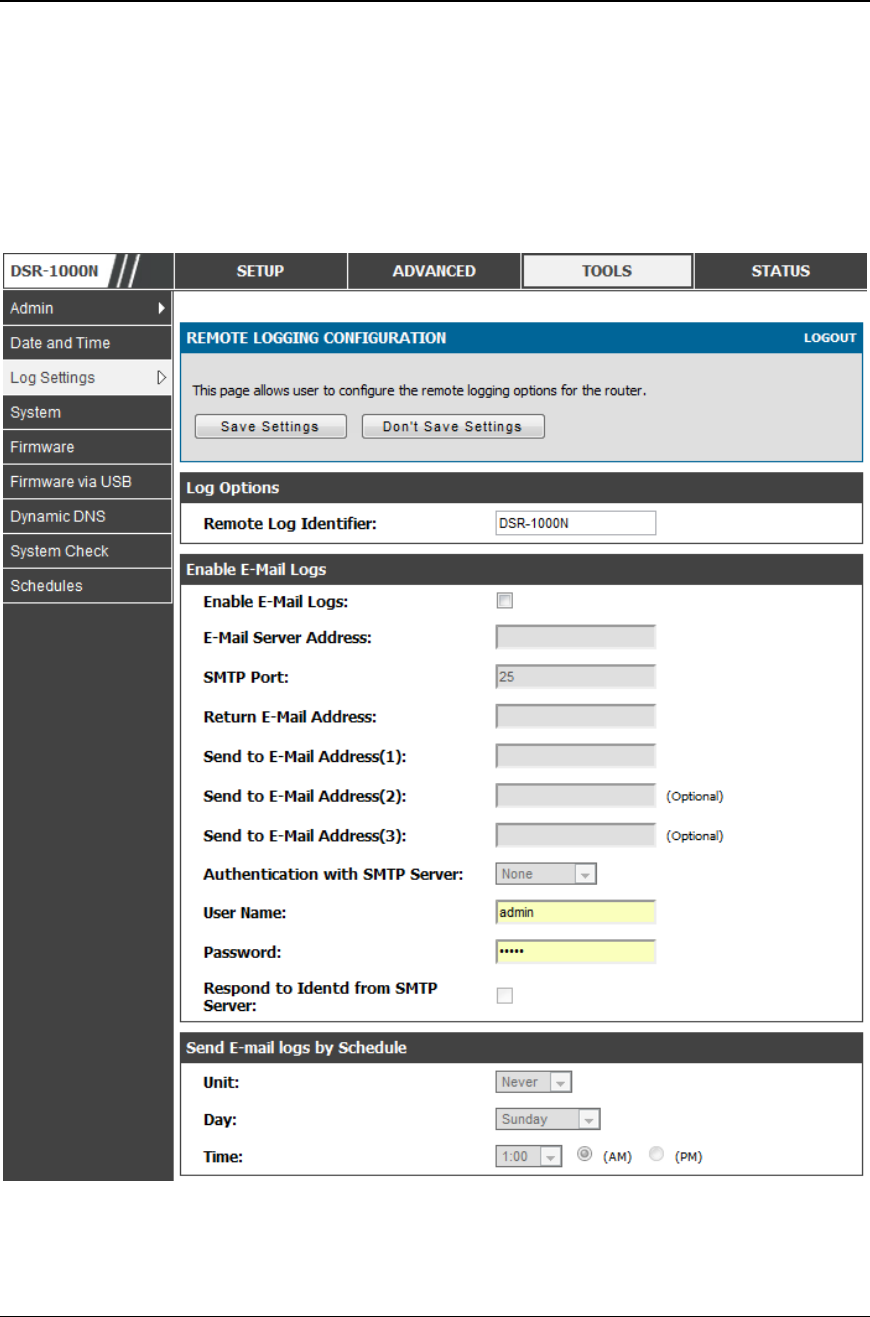
Unified Services Router User Manual
112
this requirement. In some cases the SMTP server may send out IDENT requests, and
this router can have this response option enabled as needed.
Once the e-mail server and recipient details are defined you can determine when the
router should send out logs. E-mail logs can be sent out based on a defined schedule
by first choosing the unit (i.e. the frequency) of sending logs: Hourly, Daily, or
Weekly. Selecting Never will disable log e-mails but will preserve the e-mail server
settings.
Figure 74: E-mail configuration as a Remote Logging option
An external Syslog server is often used by network administrator to collect and store
logs from the router. This remote device typically has less memory constraints than
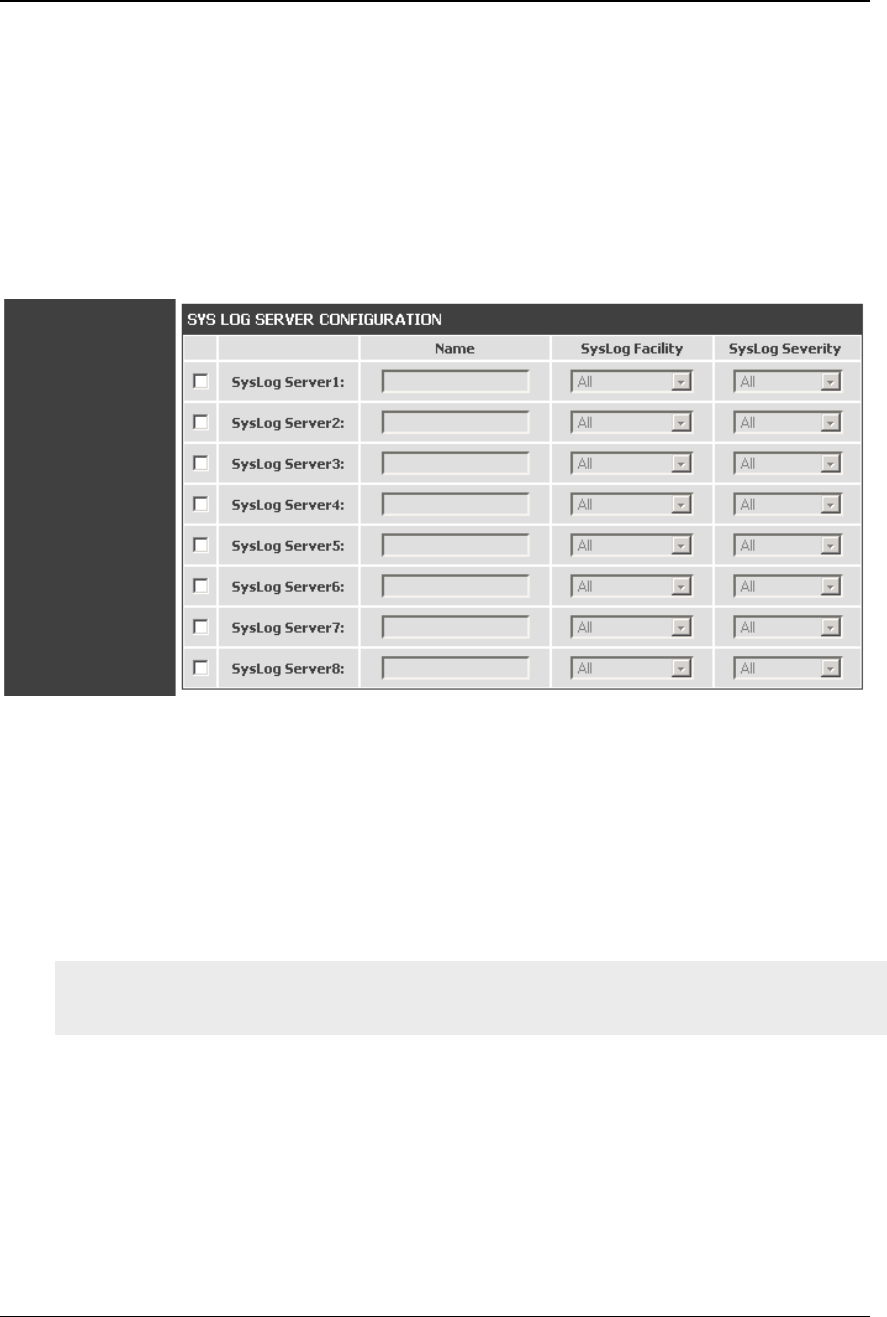
Unified Services Router User Manual
113
the local Event Viewer on the router’s GUI, and thus can collect a considerable
number of logs over a sustained period. This is typically very useful for debugging
network issues or to monitor router traffic over a long duration.
This router supports up to 8 concurrent Syslog servers. Each can be configured to
receive different log facility messages of varying severity. To enable a Syslog server
select the checkbox next to an empty Syslog server field and assign the IP address or
FQDN to the Name field. The selected facility and severity level messages will be
sent to the configured (and enabled) Syslog server once you save this configuration
page’s settings.
Figure 75: Syslog server configuration for Remote Logging (continued)
9.4.3 Event Log Viewer in GUI
Status > Logs > View All Logs
The router GUI lets you observe configured log messages from the Status menu.
Whenever traffic through or to the router matches the settings determined in the
Tools > Log Settings > Logs Facility or Tools > Log Settings > Logs
Configuration pages, the corresponding log message will be displayed in this
window with a timestamp.
It is very important to have accurate system time (manually set or from a NTP
server) in order to understand log messages.
Status > Logs > VPN Logs
This page displays IPSec VPN log messages as determined by the configuration
settings for facility and severity. This data is useful when evaluating IPSec VPN
traffic and tunnel health.
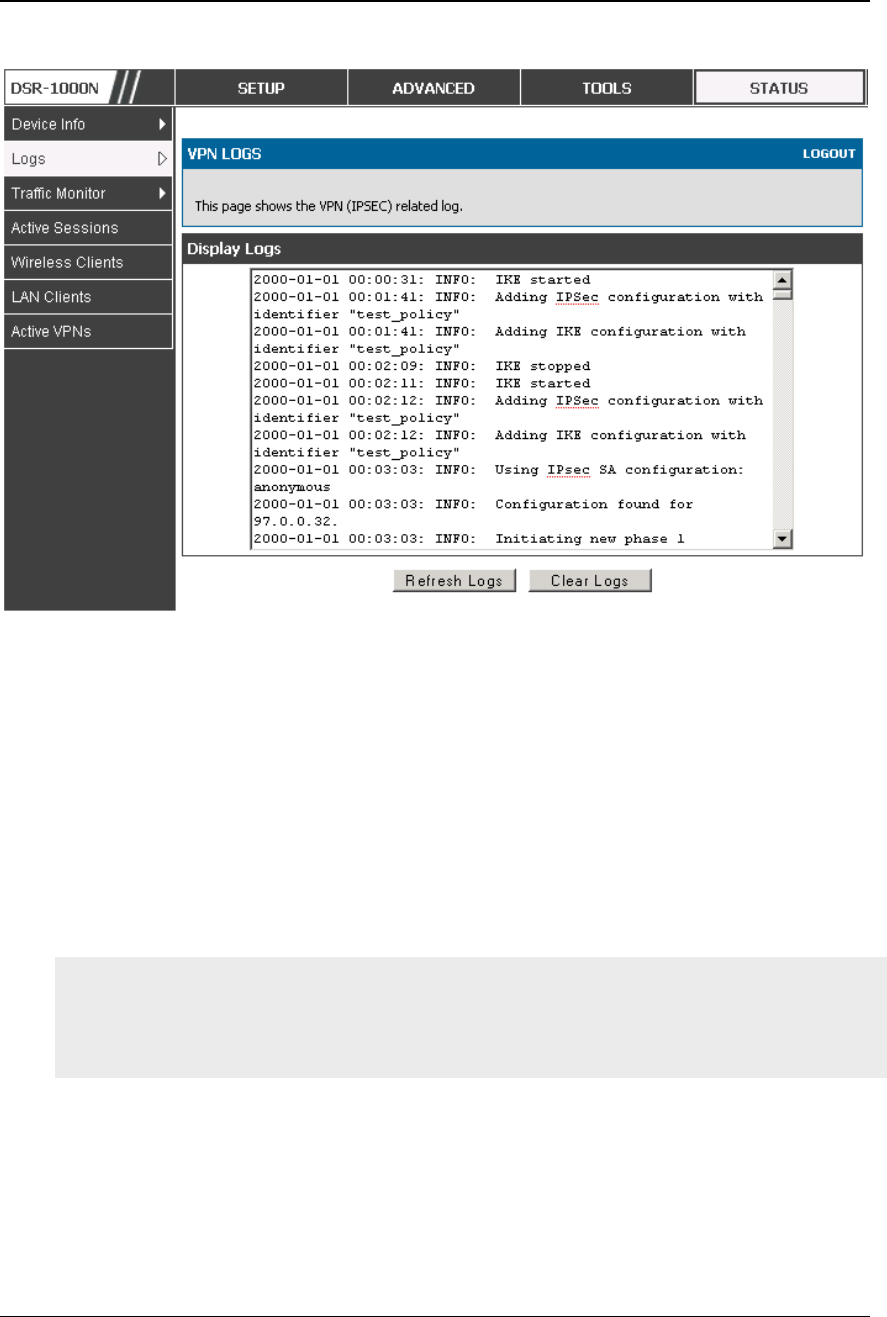
Unified Services Router User Manual
114
Figure 76: VPN logs displayed in GUI event viewer
9.5 Backing up and Restoring Configuration
Settings
Tools > System
You can back up the router’s custom configuration settings to restore them to a
different device or the same router after some other changes. During backup, your
settings are saved as a file on your host. You can restore the router's saved settings
from this file as well. This page will also allow you revert to factory default settings
or execute a soft reboot of the router.
IMPORTANT! During a restore operation, do NOT try to go online, turn off the
router, shut down the PC, or do anything else to the router until the operation is
complete. This will take approximately 1 minute. Once the LEDs are turned off,
wait a few more seconds before doing anything with the router.
For backing up configuration or restoring a previously saved configuration, please
follow the steps below:
1. To save a copy of your current settings, click the Backup button in the Save Current
Settings option. The browser initiates an export of the configuration file and prompts to
save the file on your host.
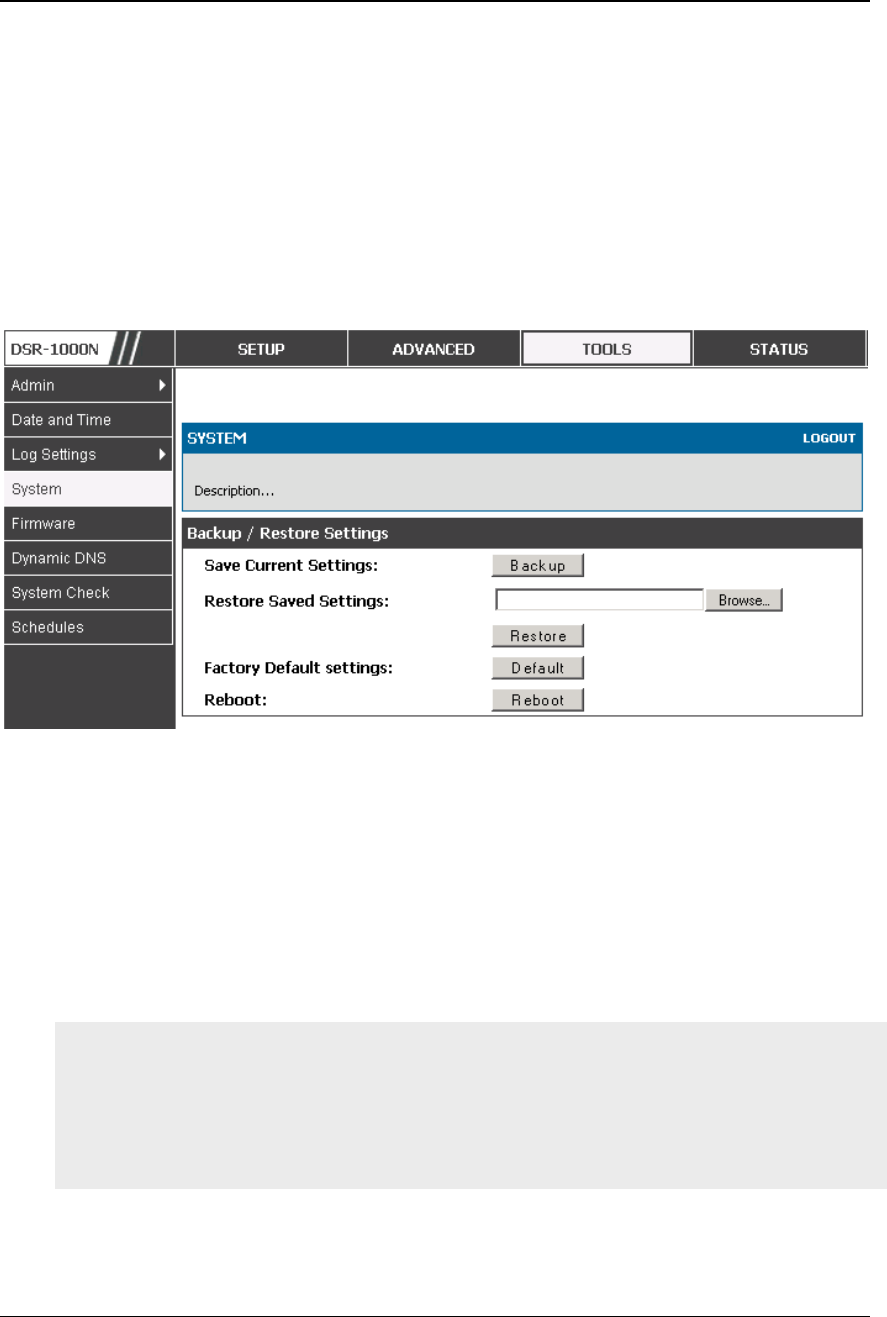
Unified Services Router User Manual
115
2. To restore your saved settings from a backup file, click Browse then locate the file on the
host. After clicking Restore, the router begins importing the file’s saved configuration
settings. After the restore, the router reboots automatically with the restored settings.
3. To erase your current settings and revert to factory default settings, click the Default
button. The router will then restore configuration settings to factory defaults and will
reboot automatically. (See Appendix B for the factory default parameters for the router).
Figure 77: Restoring configuration from a saved file will result in the
current configuration being overwritten and a reboot
9.6 Upgrading Router Firmware
Tools > Firmware
You can upgrade to a newer software version from the Administration web page. In
the Firmware Upgrade section, to upgrade your firmware, click Browse, locate and
select the firmware image on your host, and click Upgrade. After the new firmware
image is validated, the new image is written to flash, and the router is automatically
rebooted with the new firmware. The Firmware Information and also the Status >
Device Info > Device Status page will reflect the new firmware version.
IMPORTANT! During firmware upgrade, do NOT try to go online, turn off the
device, shut down the PC, or interrupt the process in anyway until the operation is
complete. This should take only a minute or so including the reboot process.
Interrupting the upgrade process at specific points when the flash is being written
to may corrupt the flash memory and render the router unusable without a low-level
process of restoring the flash firmware (not through the web GUI).
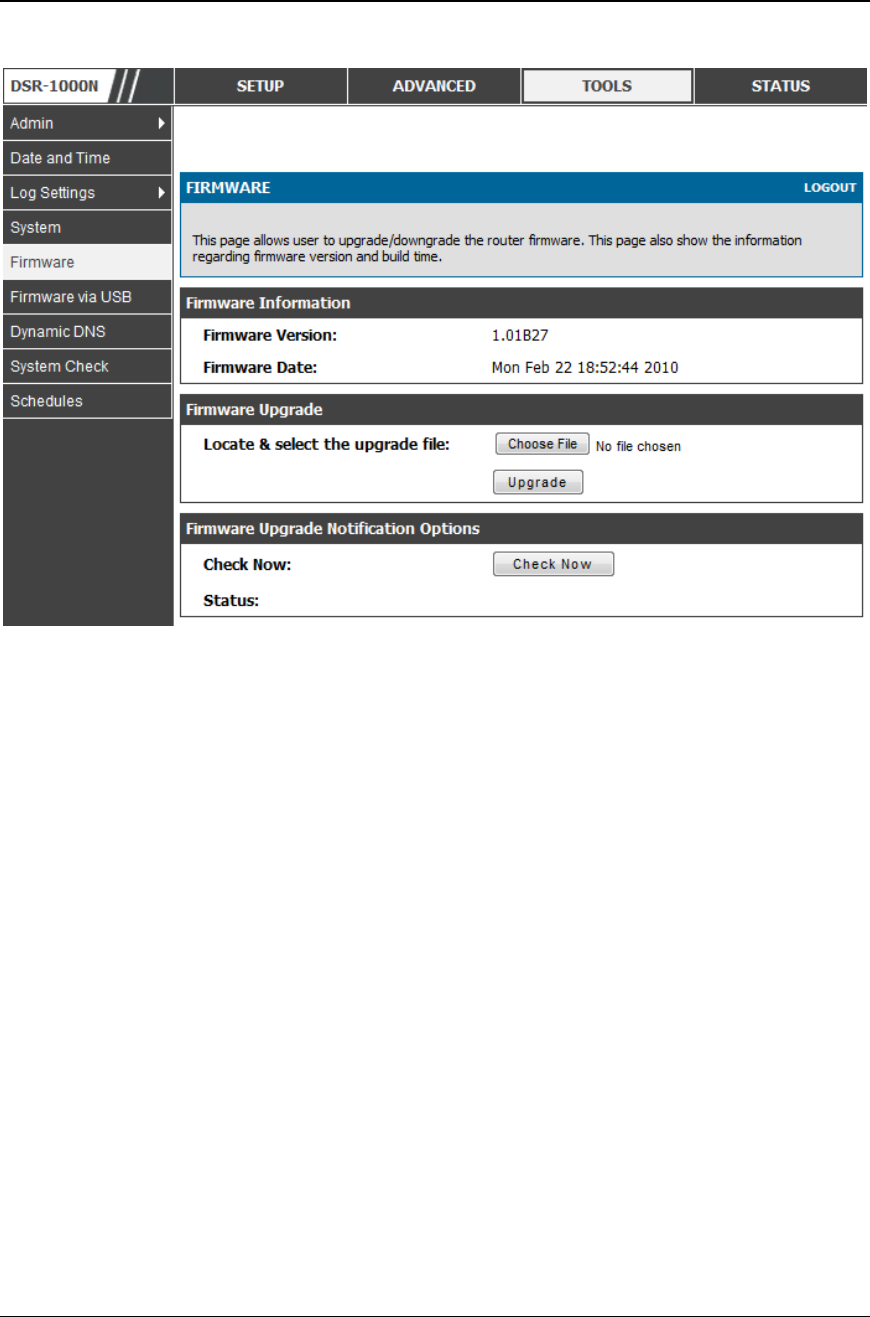
Unified Services Router User Manual
116
Figure 78: Firmware version information and upgrade option
This router also supports an automated notification to determine if a newer firmware
version is available for this router. By clicking the Check Now button in the
notification section, the router will check a D-Link server to see if a newer firmware
version for this router is available for download and update the Status field below.
9.7 Dynamic DNS Setup
Tools > Dynamic DNS
Dynamic DNS (DDNS) is an Internet service that allows routers with varying public
IP addresses to be located using Internet domain names. To use DDNS, you must
setup an account with a DDNS provider such as DynDNS.org, D-Link DDNS, or
Oray.net.
Each configured WAN can have a different DDNS service if required. Once
configured, the router will update DDNS services changes in the WAN IP address so
that features that are dependent on accessing the router’s WAN via FQDN will be
directed to the correct IP address. When you set up an account with a DDNS service,
the host and domain name, username, password and wildcard support will be provided
by the account provider.
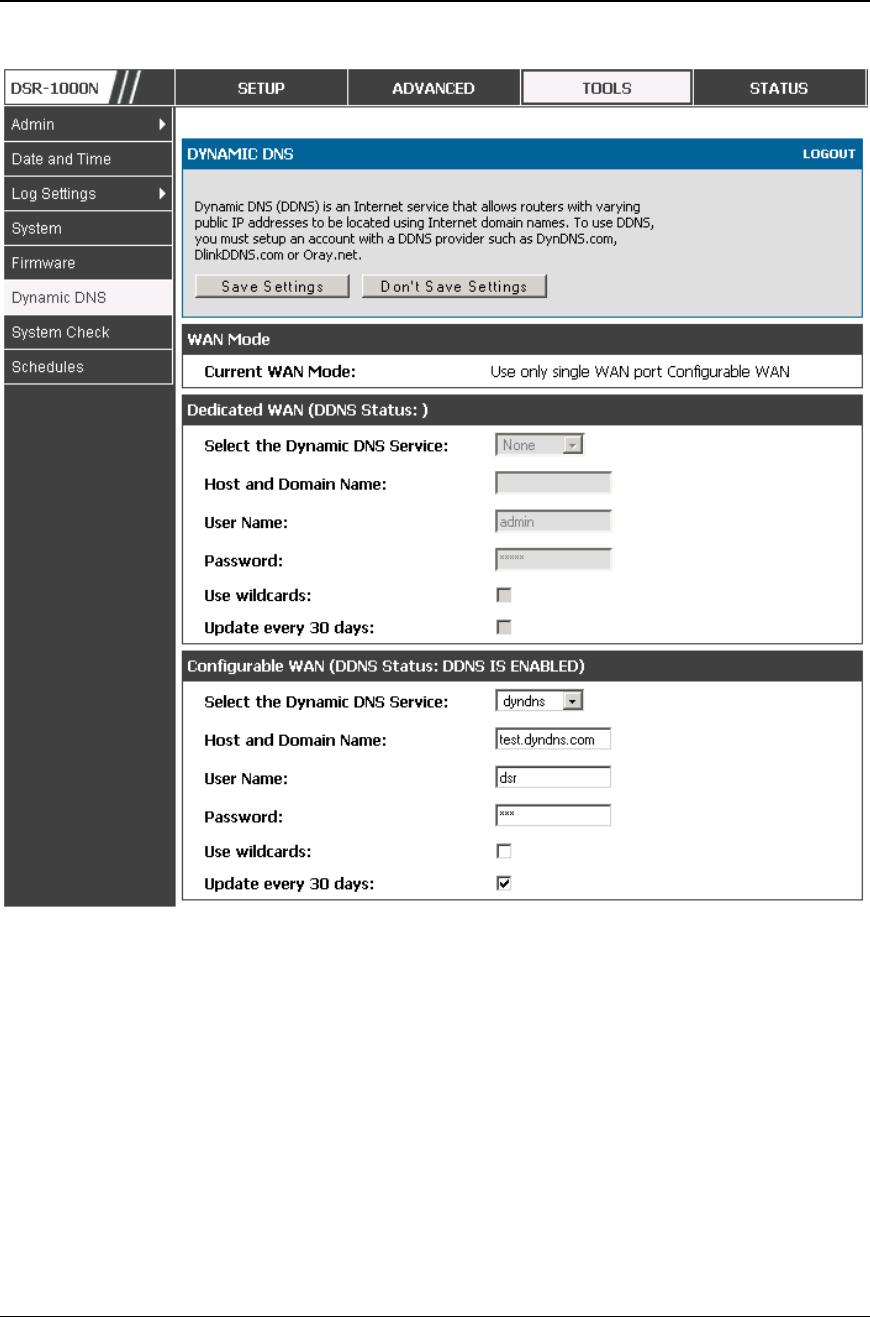
Unified Services Router User Manual
117
Figure 79: Dynamic DNS configuration
9.8 Using Diagnostic Tools
Tools > System Check
The router has built in tools to allow an administrator to evaluate the communication
status and overall network health.
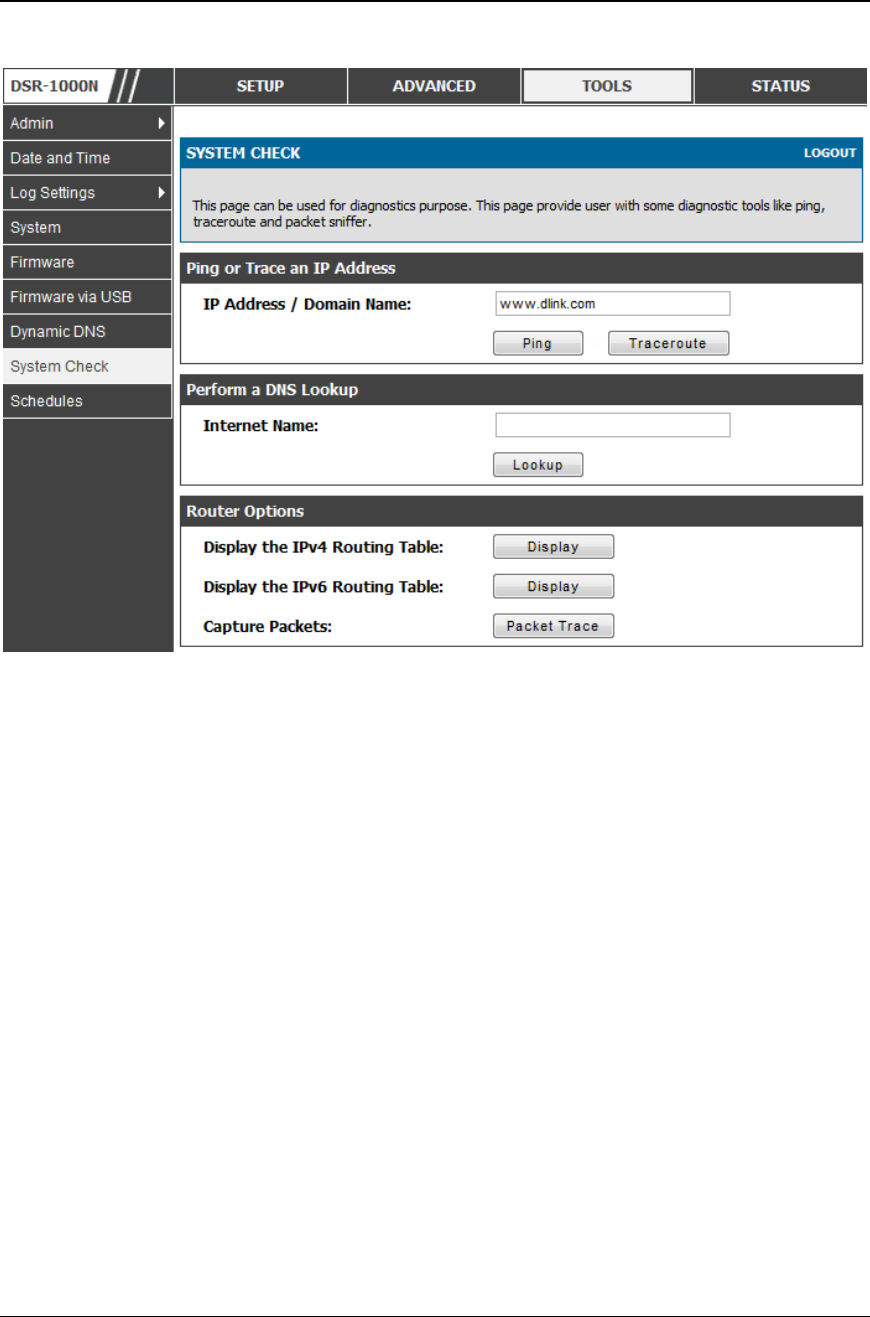
Unified Services Router User Manual
118
Figure 80: Router diagnostics tools available in the GUI
9.8.1 Ping
This utility can be used to test connectivity between this router and another device
on the network connected to this router. Enter an IP address and click PING. The
command output will appear indicating the ICMP echo request status.
9.8.2 Trace Route
This utility will display all the routers present between the destination IP address
and this router. Up to 30 “hops” (intermediate routers) between this router and the
destination will be displayed.
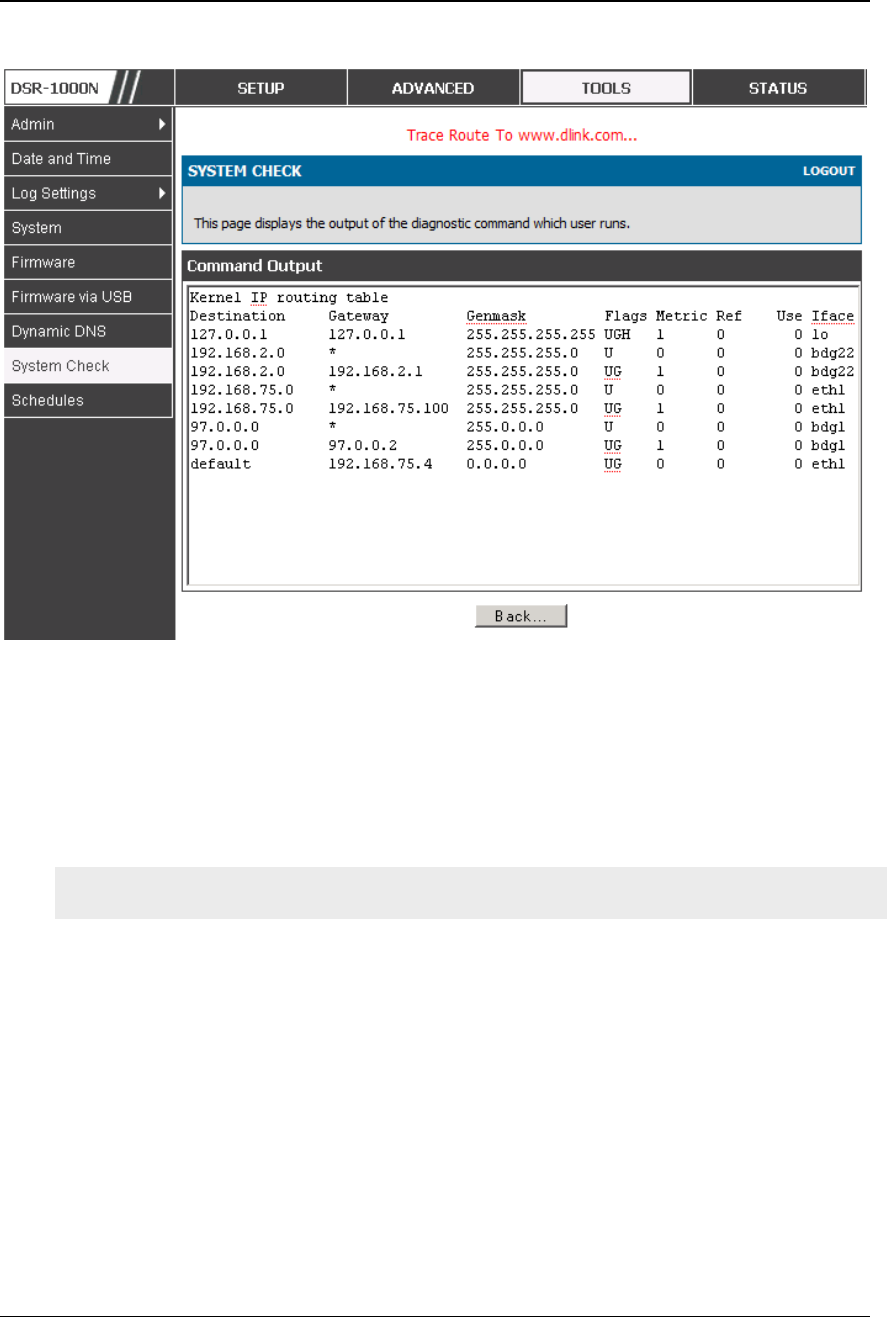
Unified Services Router User Manual
119
Figure 81: Sample traceroute output
9.8.3 DNS Lookup
To retrieve the IP address of a Web, FTP, Mail or any other server on the Internet,
type the Internet Name in the text box and click Lookup. If the host or domain entry
exists, you will see a response with the IP address. A message stating “Unknown
Host” indicates that the specified Internet Name does not exist.
This feature assumes there is internet access available on the WAN link(s).
9.8.4 Router Options
The static and dynamic routes configured on this router can be shown by clicking
Display for the corresponding routing table. Clicking the Packet Trace button will
allow the router to capture and display traffic through the device between the LAN
and WAN interface as well. This information is often very useful in debugging
traffic and routing issues.

Unified Services Router User Manual
120
Chapter 10. Router Status and
Statistics
10.1 System Overview
The Status page allows you to get a detailed overview of the system configuration.
The settings for the wired and wireless interfaces are displayed in the Device Status
page, and then the resulting hardware resource and router usage details are
summarized on the router’s Dashboard.
10.1.1 Device Status
Status > Device Info > Device Status
The Device Status page gives a summary of the router configuration settings
configured in the Setup and Advanced menus. The static hardware serial number and
current firmware version are presented in the General section. The WAN and LAN
interface information shown on this page are based on the administrator
configuration parameters. The radio band and channel settings are presented below
along with all configured and active APs that are enabled on this router.
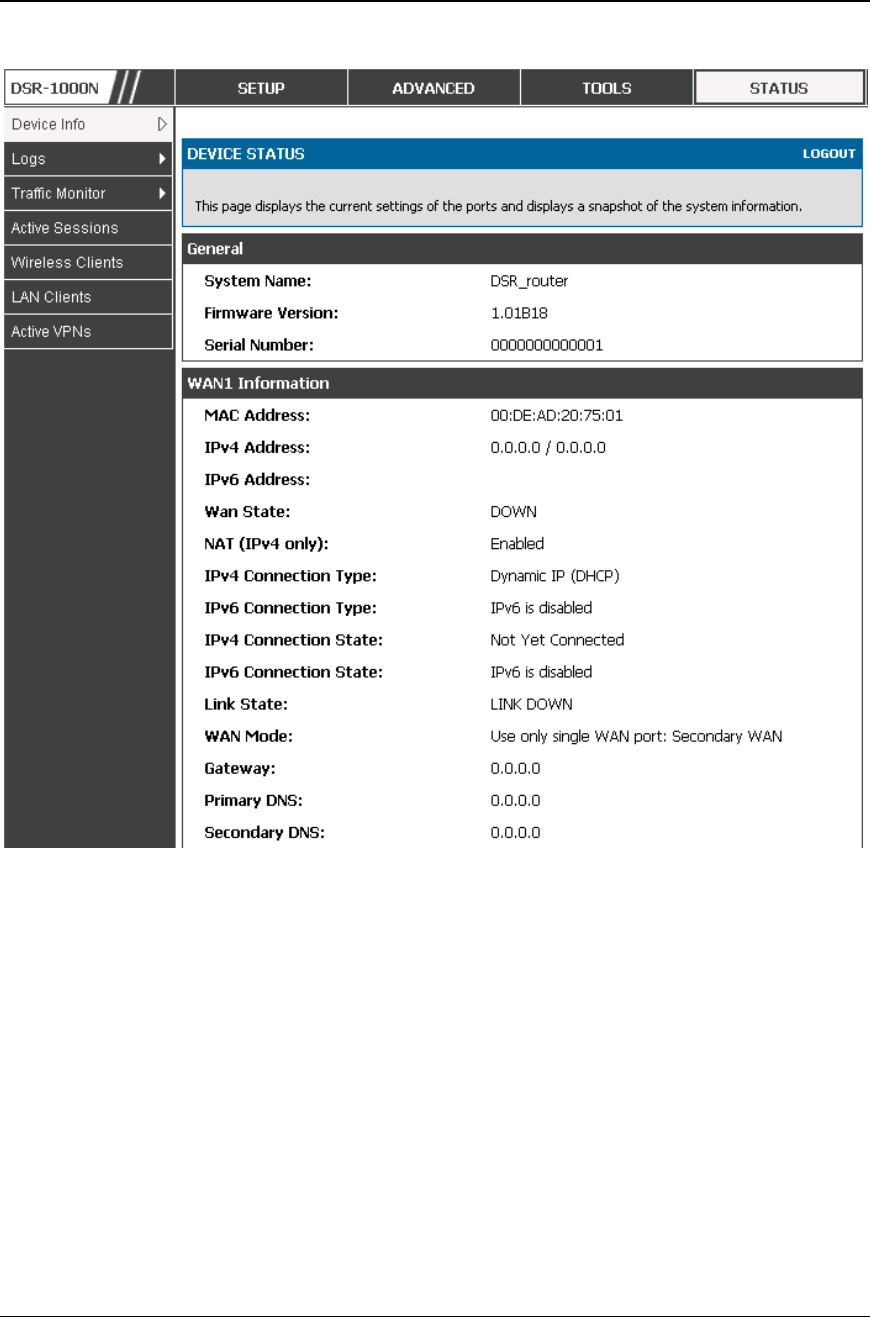
Unified Services Router User Manual
121
Figure 82: Device Status display
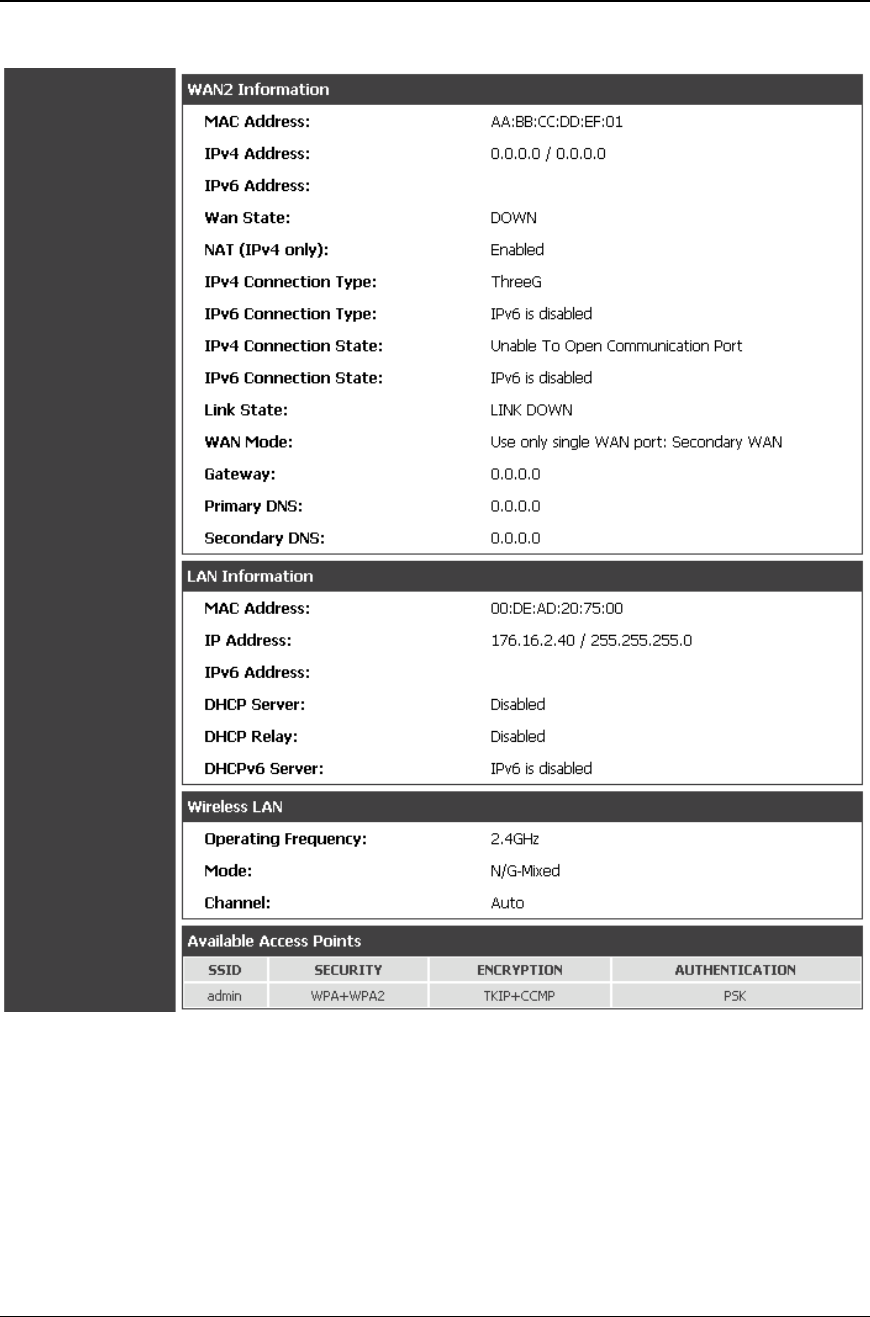
Unified Services Router User Manual
122
Figure 83: Device Status display (continued)
10.1.2 Resource Utilization
Status > Device Info > Dashboard
The Dashboard page presents hardware and usage statistics. The CPU and Memory
utilization is a function of the available hardware and current configuration and
traffic through the router. Interface statistics for the wired connections (LAN,
WAN1, WAN2/DMZ, VLANs) provide indication of packets through and packets
dropped by the interface. Click refresh to have this page retrieve the most current
statistics.
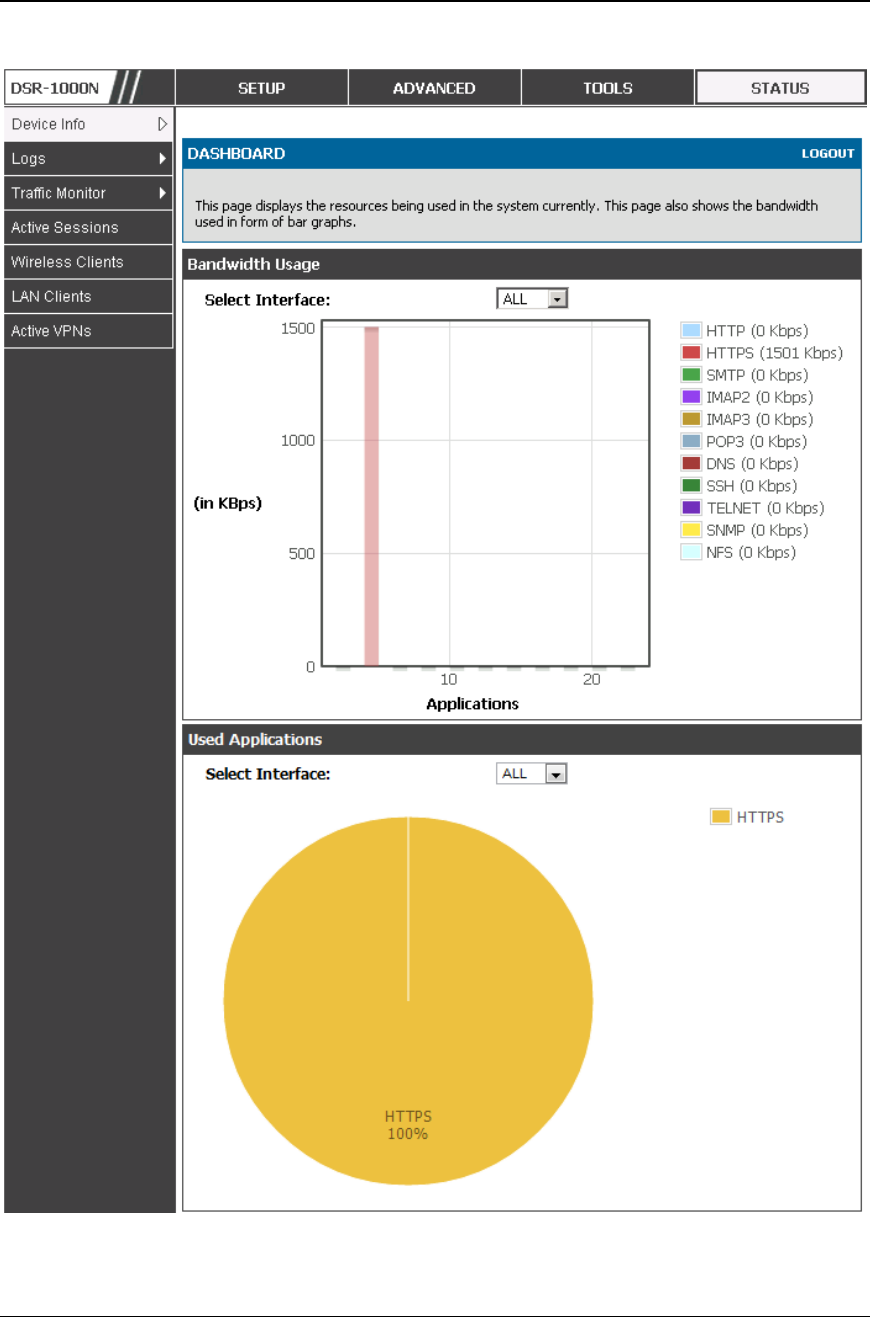
Unified Services Router User Manual
123
Figure 84: Resource Utilization statistics

Unified Services Router User Manual
124
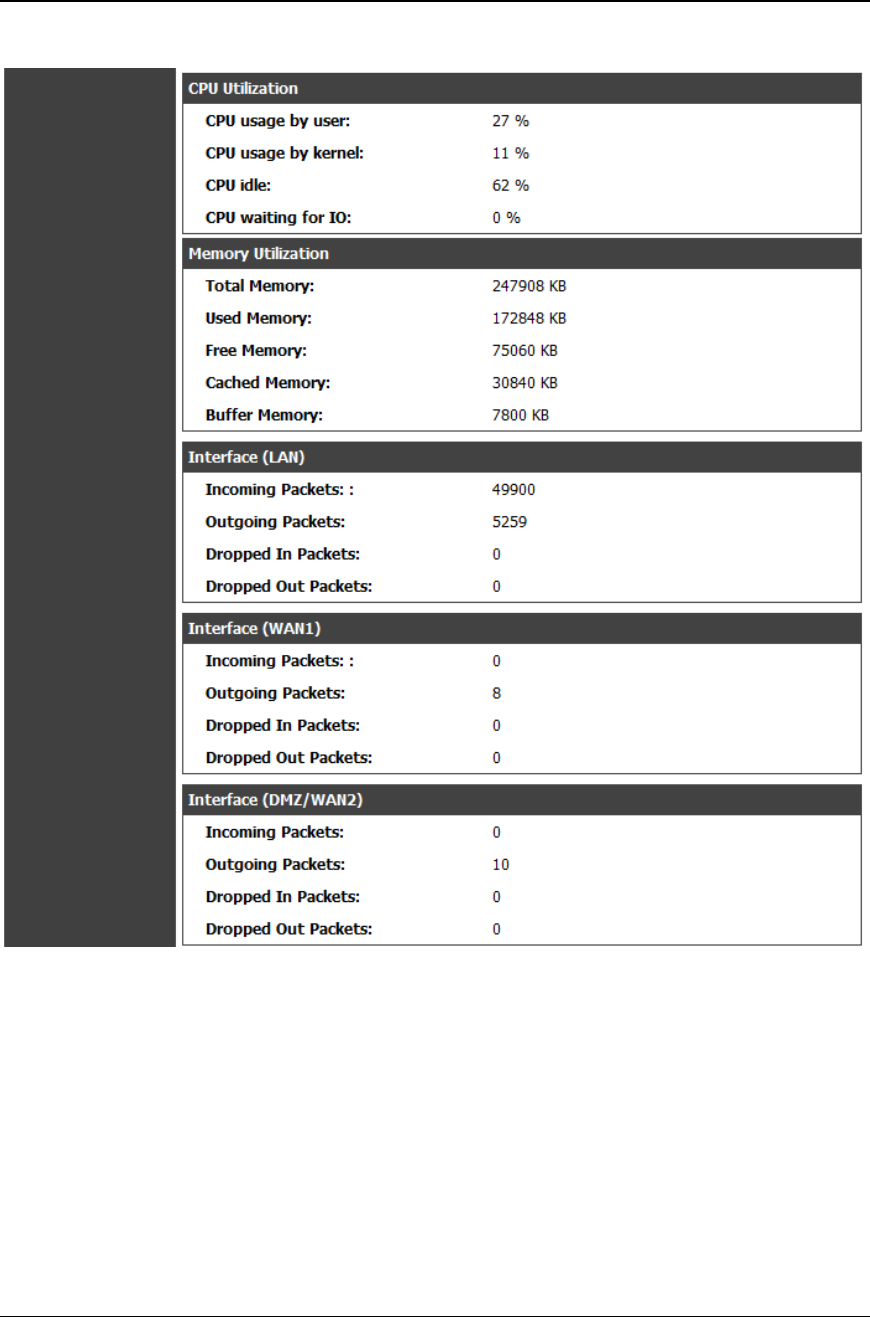
Unified Services Router User Manual
125
Figure 85: Resource Utilization data (continued)
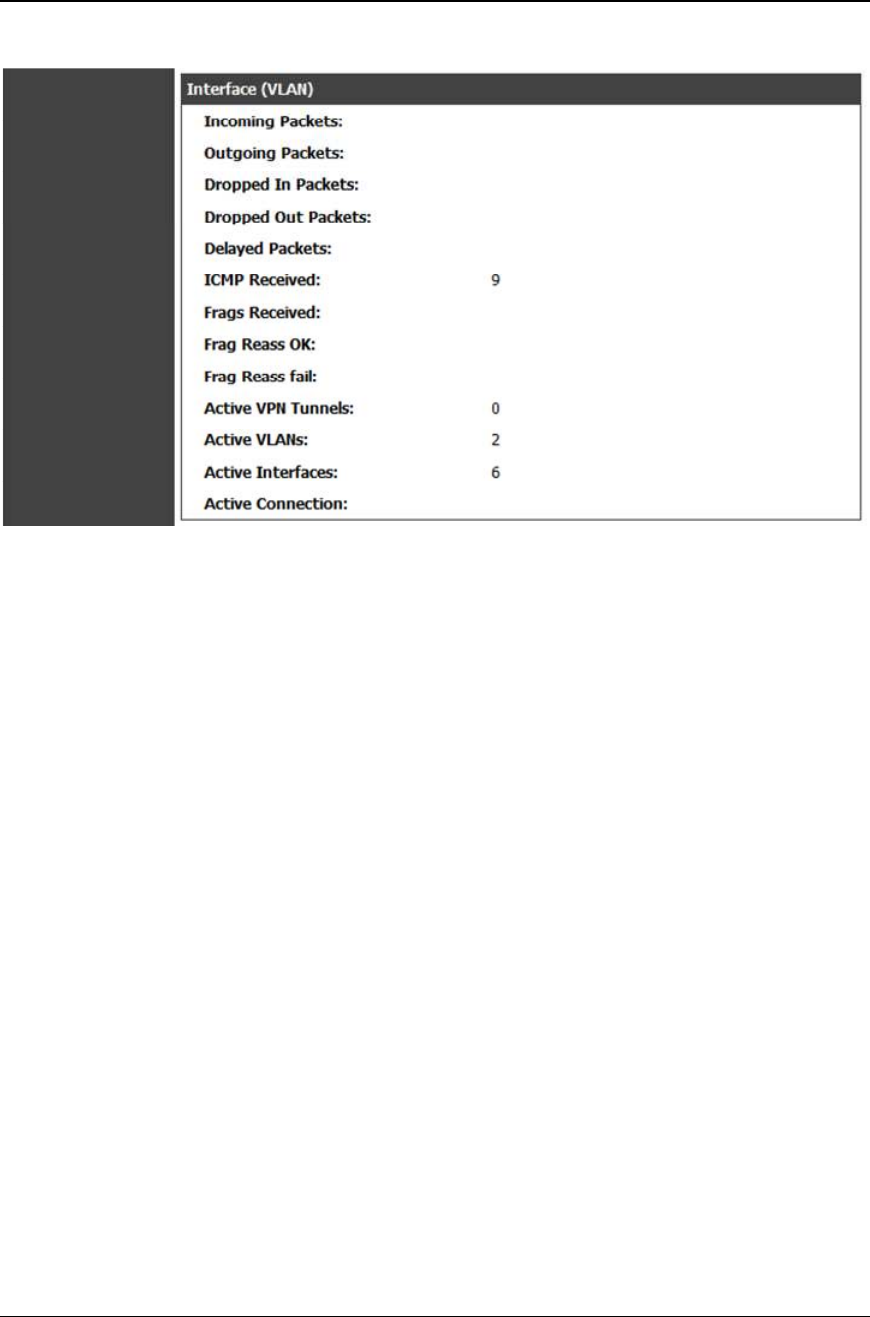
Unified Services Router User Manual
126
Figure 86: Resource Utilization data (continued)
10.2 Traffic Statistics
10.2.1 Wired Port Statistics
Status > Traffic Monitor > Device Statistics
Detailed transmit and receive statistics for each physical port are presented here.
Each interface (WAN1, WAN2/DMZ, LAN, and VLANs) have port specific packet
level information provided for review. Transmitted/received packets, port collisions,
and the cumulating bytes/sec for transmit/receive directions are provided for each
interface along with the port up time. If you suspect issues with any of the wired
ports, this table will help diagnose uptime or transmit level issues with the port.
The statistics table has auto-refresh control which allows display of the most current
port level data at each page refresh. The default auto-refresh for this page is 10
seconds.
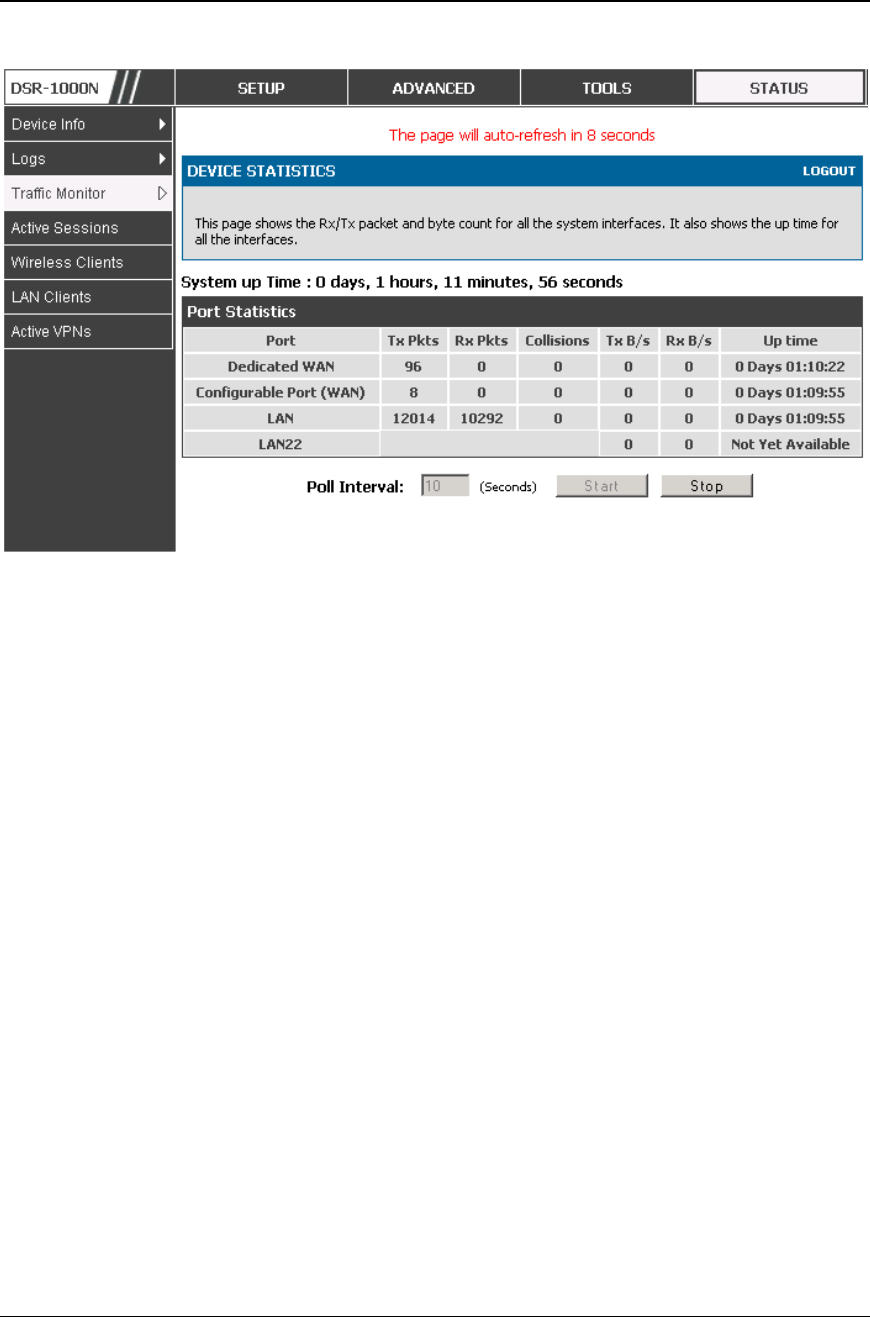
Unified Services Router User Manual
127
Figure 87: Physical port statistics
10.2.2 Wireless Statistics
Status > Traffic Monitor > Wireless Statistics
The Wireless Statistics tab displays the incrementing traffic statistics for each
enabled access point. This page will give a snapshot of how much traffic is being
transmitted over each wireless link. If you suspect that a radio or VAP may be
down, the details on this page would confirm if traffic is being sent and received
through the VAP.
The clients connected to a particular AP can be viewed by using the Status Button
on the list of APs in the Setup > Wireless > Access Points page. Traffic statistics
are shown for that individual AP, as compared to the summary stats for each AP on
this Statistics page. The poll interval (the refresh rate for the statistics) can be
modified to view more frequent traffic and collision statistics.
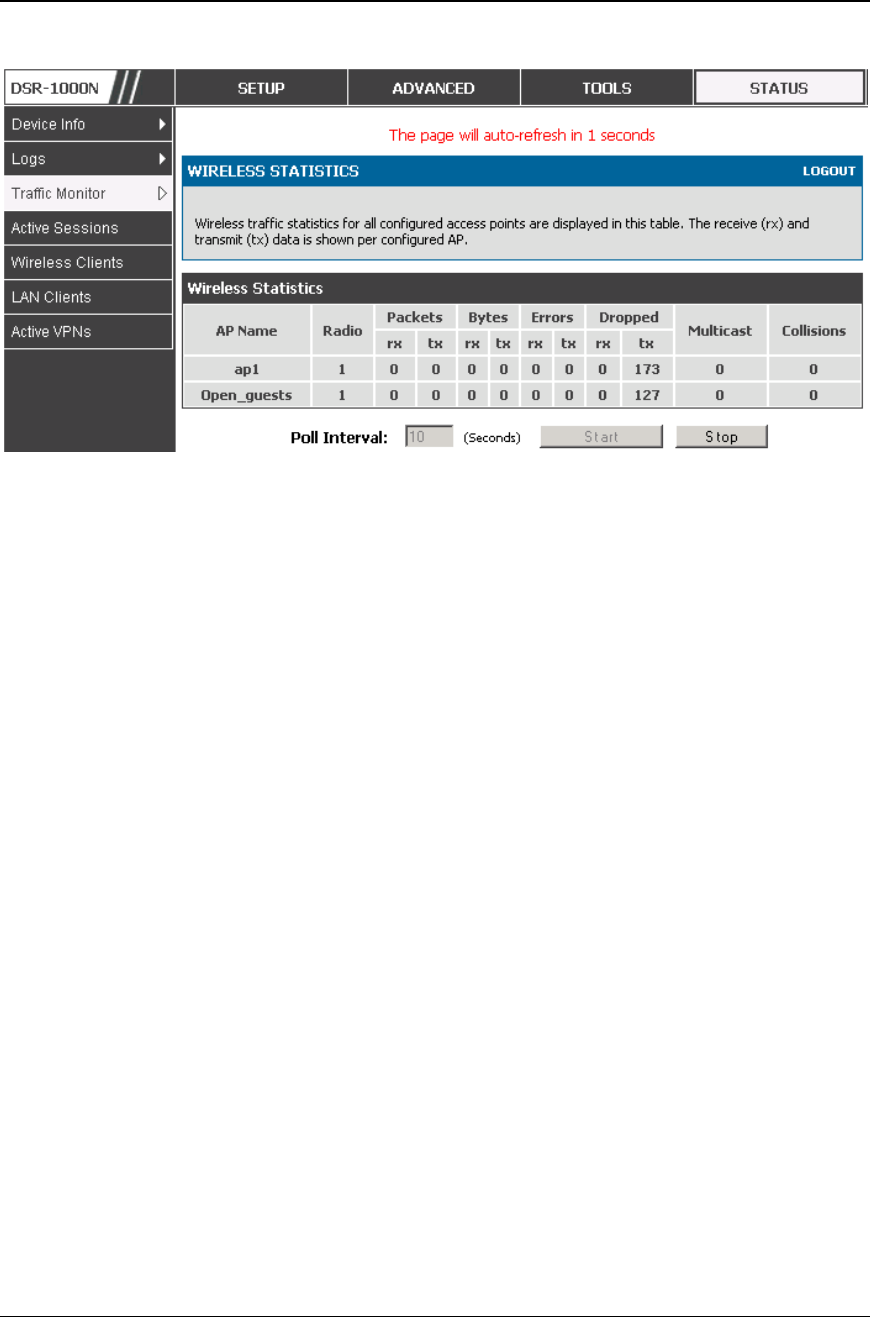
Unified Services Router User Manual
128
Figure 88: AP specific statistics
10.3 Active Connections
10.3.1 Sessions through the Router
Status > Active Sessions
This table lists the active internet sessions through the router’s firewall. The
session’s protocol, state, local and remote IP addresses are shown.
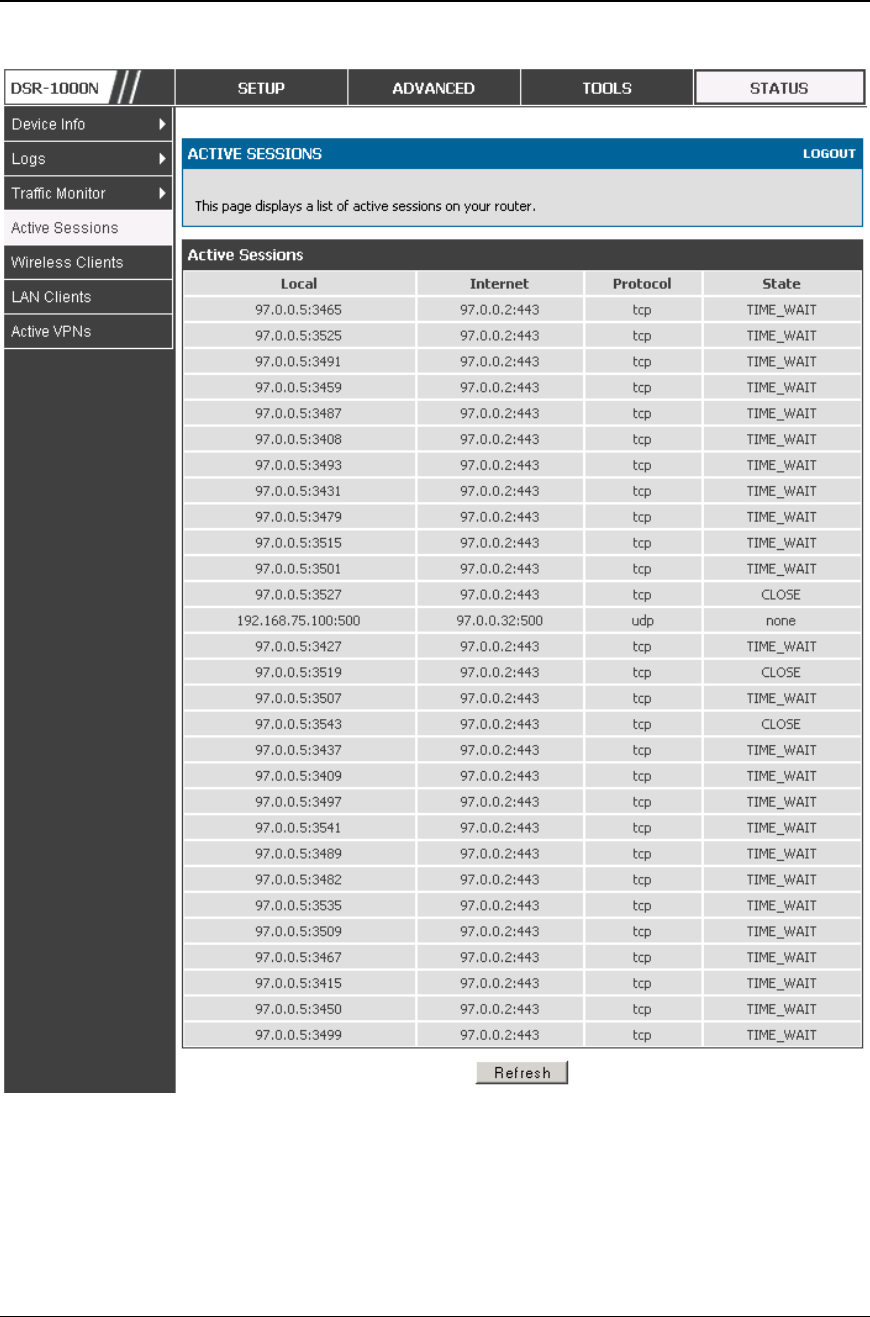
Unified Services Router User Manual
129
Figure 89: List of current Active Firewall Sessions
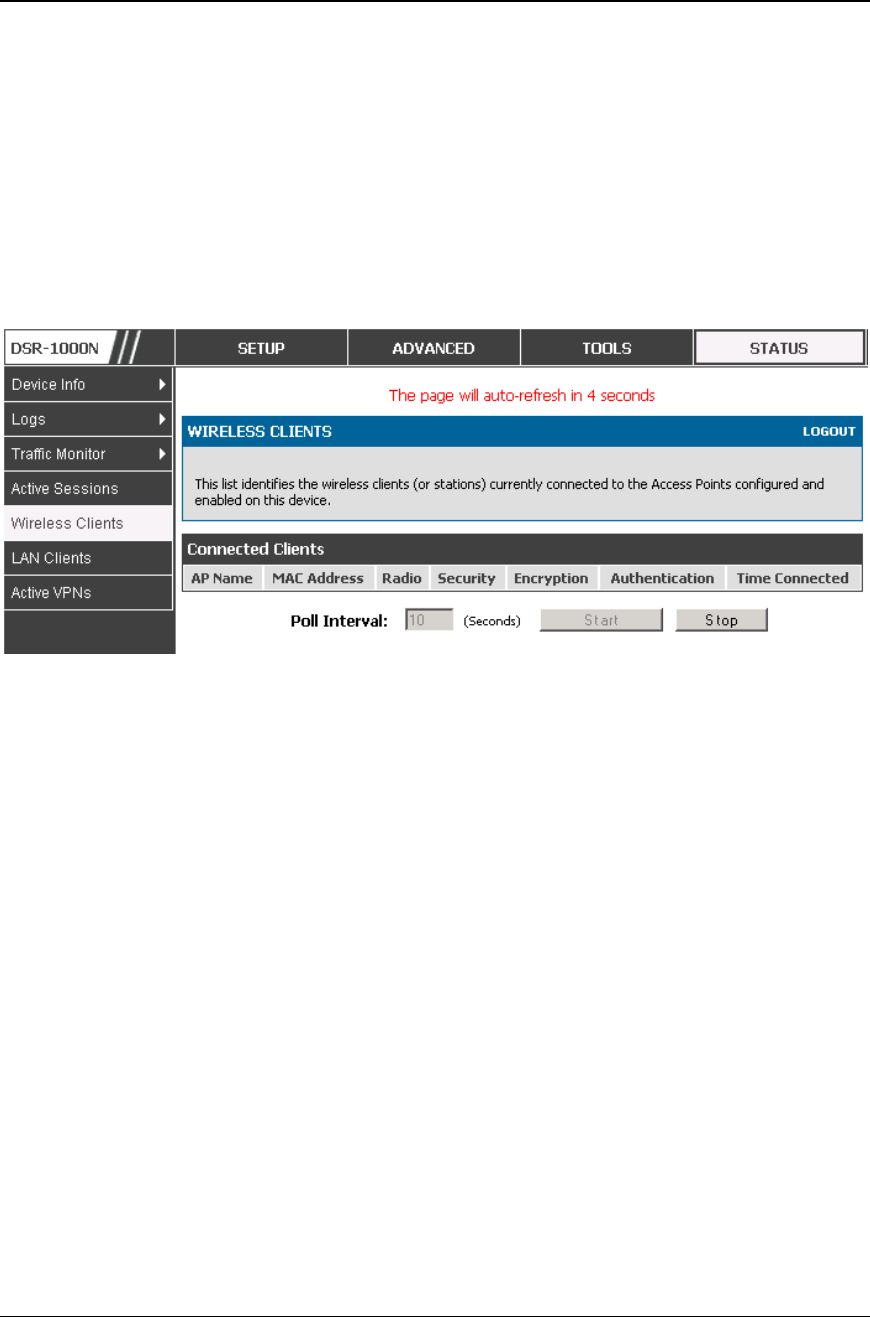
Unified Services Router User Manual
130
10.3.2 Wireless Clients
Status > Wireless Clients
The clients connected to a particular AP can be viewed on this page. Connected
clients are sorted by the MAC address and indicate the security parameters used by
the wireless link, as well as the time connected to the corresponding AP.
The statistics table has auto-refresh control which allows display of the most current
port level data at each page refresh. The default auto-refresh for this page is 10
seconds.
Figure 90: List of connected 802.11 clients per AP
10.3.3 LAN Clients
Status > LAN Clients
The LAN clients to the router are identified by an ARP scan through the LAN
switch. The NetBios name (if available), IP address and MAC address of discovered
LAN hosts are displayed.
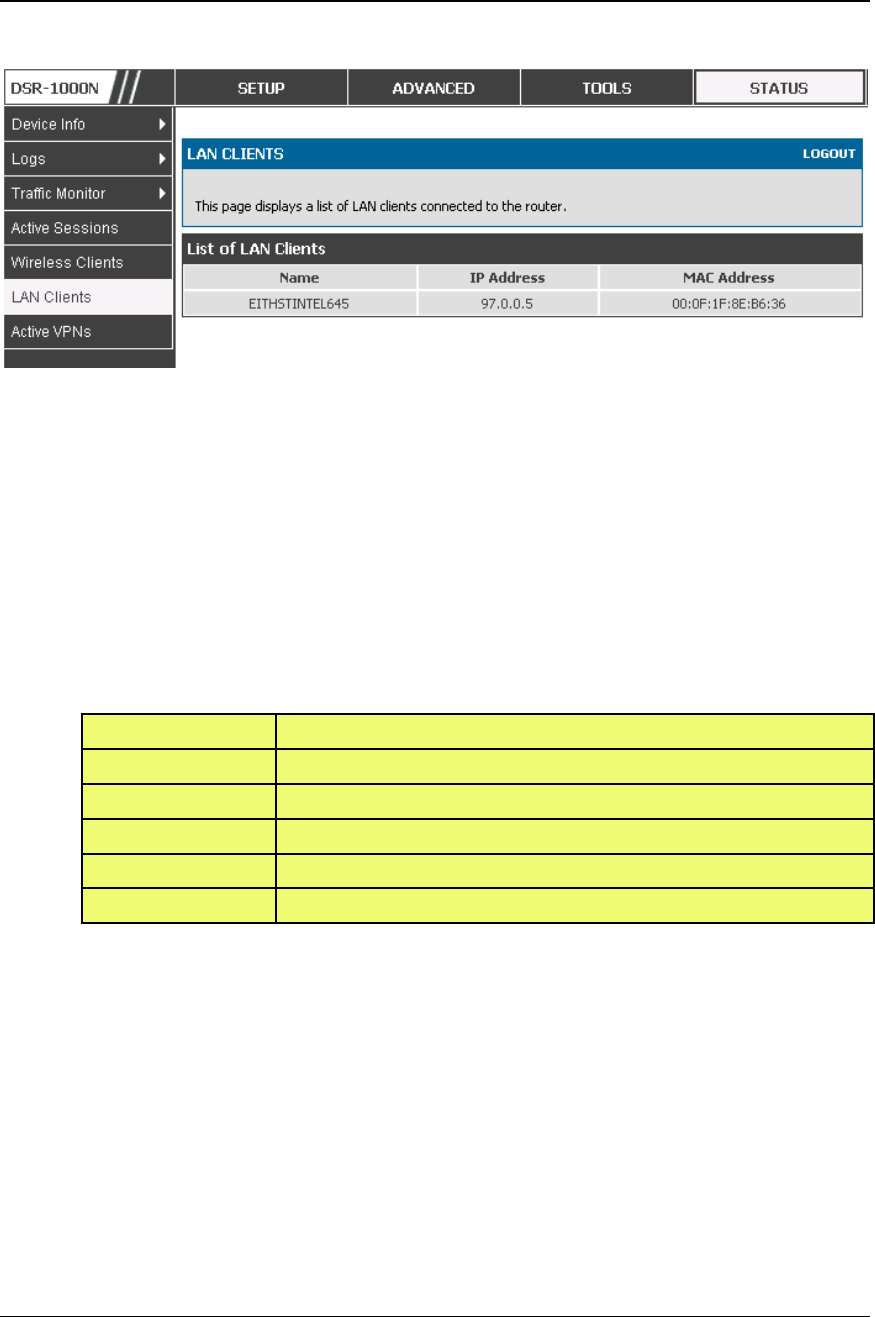
Unified Services Router User Manual
131
Figure 91: List of LAN hosts
10.3.4 Active VPN Tunnels
Status > Active VPNs
You can view and change the status (connect or drop) of the router’s IPSec security
associations. Here, the active IPSec SAs (security associations) are listed along with
the traffic details and tunnel state. The traffic is a cumulative measure of
transmitted/received packets since the tunnel was established.
If a VPN policy state is “IPSec SA Not Established”, it can be enabled by clicking
the Connect button of the corresponding policy. The Active IPSec SAs table
displays a list of active IPSec SAs. Table fields are as follows.
Field Description
Policy Name IKE or VPN policy associated with this SA.
Endpoint IP address of the remote VPN gateway or client.
Tx (KB) Kilobytes of data transmitted over this SA.
Tx (Packets) Number of IP packets transmitted over this SA.
State Status of the SA for IKE policies: Not Connected or IPSec SA Established.
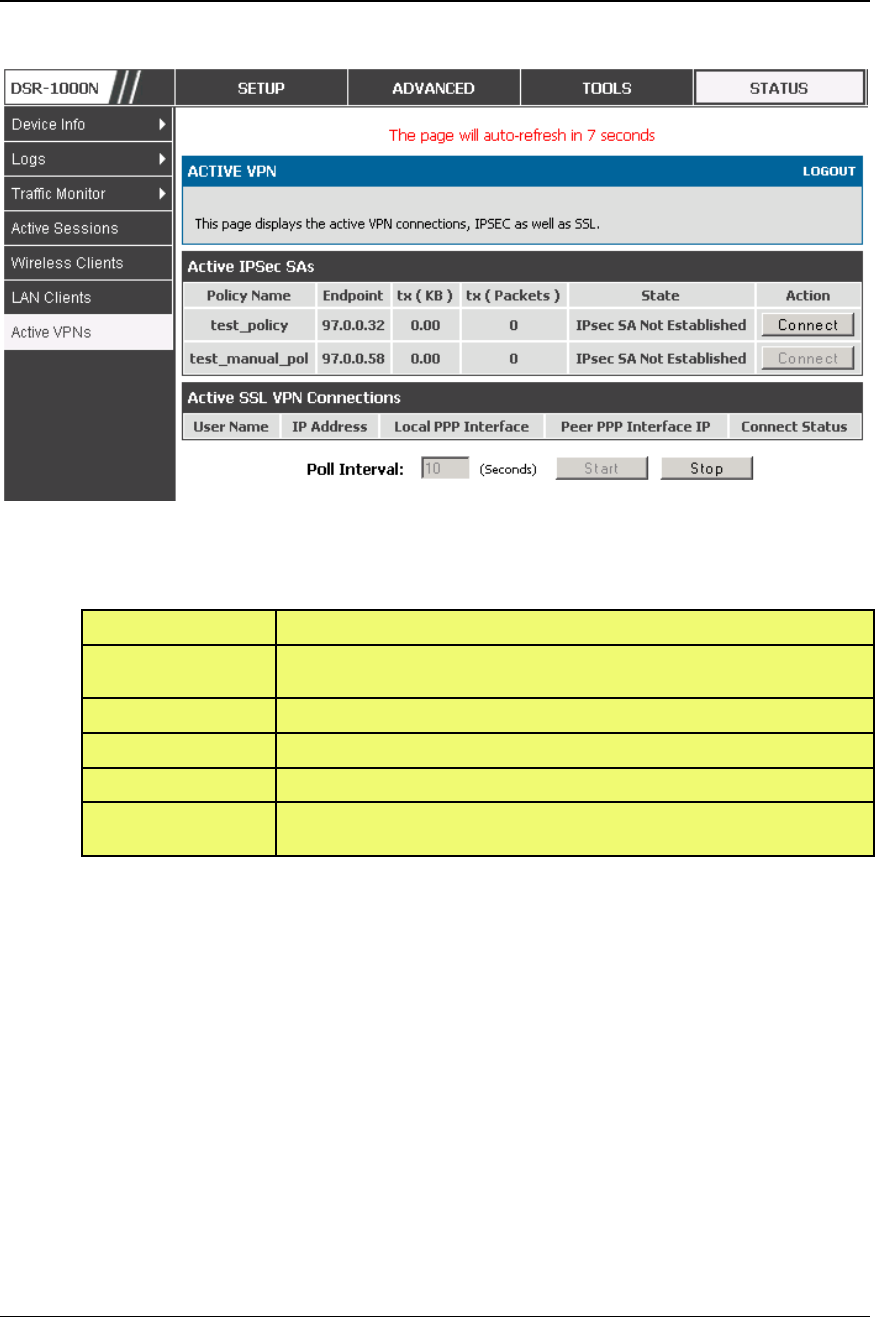
Unified Services Router User Manual
132
Figure 92: List of current Active VPN Sessions
All active SSL VPN connections, both for VPN tunnel and VPN Port forwarding, are
displayed on this page as well. Table fields are as follows.
Field Description
User Name The SSL VPN user that has an active tunnel or port forwarding session to this
router.
IP Address IP address of the remote VPN client.
Local PPP Interface The interface (WAN1 or WAN2) through which the session is active.
Peer PPP Interface IP The assigned IP address of the virtual network adapter.
Connect Status Status of the SSL connection between this router and the remote VPN client: Not
Connected or Connected.

Unified Services Router User Manual
133
Chapter 11. Trouble Shooting
11.1 Internet connection
Symptom: You cannot access the router’s web-configuration interface from a PC on
your LAN.
Recommended action:
1. Check the Ethernet connection between the PC and the router.
2. Ensure that your PC’s IP address is on the same subnet as the router. If you are using the
recommended addressing scheme, your PC’s address should be in the range 192.168.10.2
to 192.168.10.254.
3. Check your PC’s IP address. If the PC cannot reach a DHCP server, some versions of
Windows and Mac OS generate and assign an IP address. These auto-generated addresses
are in the range 169.254.x.x. If your IP address is in this range, check the connection from
the PC to the firewall and reboot your PC.
4. If your router’s IP address has changed and you don’t know what it is, reset the router
configuration to factory defaults (this sets the firewall’s IP address to 192.168.10.1).
5. If you do not want to reset to factory default settings and lose your configuration, reboot
the router and use a packet sniffer (such as Ethereal™) to capture packets sent during the
reboot. Look at the Address Resolution Protocol (ARP) packets to locate the router’s LAN
interface address.
6. Launch your browser and ensure that Java, JavaScript, or ActiveX is enabled. If you are
using Internet Explorer, click Refresh to ensure that the Java applet is loaded. Close the
browser and launch it again.
7. Ensure that you are using the correct login information. The factory default login name is
admin and the password is password. Ensure that CAPS LOCK is off when entering this
information.
Symptom: Router does not save configuration changes.
Recommended action:
1. When entering configuration settings, click Apply before moving to another menu or tab;
otherwise your changes are lost.
2. Click Refresh or Reload in the browser. Your changes may have been made, but the
browser may be caching the old configuration.

Unified Services Router User Manual
134
Symptom: Router cannot access the Internet.
Possible cause: If you use dynamic IP addresses, your router may not have requested
an IP address from the ISP.
Recommended action:
1. Launch your browser and go to an external site such as www.google.com.
2. Access the firewall’s configuration main menu at http://192.168.10.1.
3. Select Monitoring > Router Status.
4. Ensure that an IP address is shown for the WAN port. If 0.0.0.0 is shown, your firewall
has not obtained an IP address from your ISP. See the next symptom.
Symptom: Router cannot obtain an IP address from the ISP.
Recommended action:
1. Turn off power to the cable or DSL modem.
2. Turn off the router.
3. Wait 5 minutes, and then reapply power to the cable or DSL modem.
4. When the modem LEDs indicate that it has resynchronized with the ISP, reapply power to
the router. If the router still cannot obtain an ISP address, see the next symptom.
Symptom: Router still cannot obtain an IP address from the ISP.
Recommended action:
1. Ask your ISP if it requires a login program — PPP over Ethernet (PPPoE) or some other
type of login.
2. If yes, verify that your configured login name and password are correct.
3. Ask your ISP if it checks for your PC's hostname.
4. If yes, select Network Configuration > WAN Settings > Ethernet ISP
Settings and set the account name to the PC hostname of your ISP account.
5. Ask your ISP if it allows only one Ethernet MAC address to connect to the Internet, and
therefore checks for your PC’s MAC address.
6. If yes, inform your ISP that you have bought a new network device, and ask them to use
the firewall’s MAC address.
7. Alternatively, select Network Configuration > WAN Settings > Ethernet ISP
Settings and configure your router to spoof your PC’s MAC address.

Unified Services Router User Manual
135
Symptom: Router can obtain an IP address, but PC is unable to load Internet pages.
Recommended action:
1. Ask your ISP for the addresses of its designated Domain Name System (DNS) servers.
Configure your PC to recognize those addresses. For details, see your operating system
documentation.
2. On your PC, configure the router to be its TCP/IP gateway.
11.2 Date and time
Symptom: Date shown is January 1, 1970.
Possible cause: The router has not yet successfully reached a network time server
(NTS).
Recommended action:
1. If you have just configured the router, wait at least 5 minutes, select Administration >
Time Zone, and recheck the date and time.
2. Verify your Internet access settings.
Symptom: Time is off by one hour.
Possible cause: The router does not automatically adjust for Daylight Savings Time.
Recommended action:
1. Select Administration > Time Zone and view the current date and time settings.
2. Click to check or uncheck “Automatically adjust for Daylight Savings Time”, then click
Apply.
11.3 Pinging to Test LAN Connectivity
Most TCP/IP terminal devices and firewalls contain a ping utility that sends an ICMP
echo-request packet to the designated device. The device responds with an echo reply.
Troubleshooting a TCP/IP network is made very easy by using the ping utility in your
PC or workstation.
11.3.1 Testing the LAN path from your PC to your
router
1. From the PC’s Windows toolbar, select Start > Run.
2. Type ping <IP_address> where <IP_address> is the router’s IP address. Example: ping
192.168.10.1.
3. Click OK.

Unified Services Router User Manual
136
4. Observe the display:
• If the path is working, you see this message sequence:
Pinging <IP address> with 32 bytes of data
Reply from <IP address>: bytes=32 time=NN ms TTL=xxx
• If the path is not working, you see this message sequence:
Pinging <IP address> with 32 bytes of data
Request timed out
5. If the path is not working, Test the physical connections between PC and router
• If the LAN port LED is off, go to the “LED displays” section on page B-1
and follow instructions for “LAN or Internet port LEDs are not lit.”
• Verify that the corresponding link LEDs are lit for your network interface
card and for any hub ports that are connected to your workstation and
firewall.
6. If the path is still not up, test the network configuration:
• Verify that the Ethernet card driver software and TCP/IP software are
installed and configured on the PC.
• Verify that the IP address for the router and PC are correct and on the same
subnet.
11.3.2 Testing the LAN path from your PC to a remote
device
1. From the PC’s Windows toolbar, select Start > Run.
2. Type ping -n 10 <IP_address> where -n 10 specifies a maximum of 10 tries and <IP
address> is the IP address of a remote device such as your ISP’s DNS server. Example:
ping -n 10 10.1.1.1.
3. Click OK and then observe the display (see the previous procedure).
4. If the path is not working, do the following:
• Check that the PC has the IP address of your firewall listed as the default
gateway. (If the IP configuration of your PC is assigned by DHCP, this
information is not visible in your PC’s Network Control Panel.)

Unified Services Router User Manual
137
• Verify that the network (subnet) address of your PC is different from the
network address of the remote device.
• Verify that the cable or DSL modem is connected and functioning.
• Ask your ISP if it assigned a hostname to your PC.
If yes, select Network Configuration > WAN Settings > Ethernet ISP
Settings and enter that hostname as the ISP account name.
• Ask your ISP if it rejects the Ethernet MAC addresses of all but one of your
PCs.
Many broadband ISPs restrict access by allowing traffic from the MAC address of
only your broadband modem; but some ISPs additionally restrict access to the MAC
address of just a single PC connected to that modem. If this is the case, configure
your firewall to clone or spoof the MAC address from the authorized PC.
11.4 Restoring factory-default configuration
settings
To restore factory-default configuration settings, do either of the following:
1. Do you know the account password and IP address?
• If yes, select Administration > Settings Backup & Upgrade and click
default.
• If no, do the following:
On the rear panel of the router, press and hold the Reset button about 10 seconds,
until the test LED lights and then blinks.
Release the button and wait for the router to reboot.
2. If the router does not restart automatically; manually restart it to make the default settings
effective.
3. After a restore to factory defaults —whether initiated from the configuration interface or
the Reset button — the following settings apply:
• LAN IP address: 192.168.10.1
• Username: admin
• Password: password
• DHCP server on LAN: enabled
• WAN port configuration: Get configuration via DHCP

Chapter 12. Credits
Microsoft, Windows are registered trademarks of Microsoft Corp.
Linux is a registered trademark of Linus Torvalds.
UNIX is a registered trademark of The Open Group.

Unified Services Router User Manual
140
Appendix A. Glossary
ARP Address Resolution Protocol. Broadcast protocol for mapping IP addresses to MAC addresses.
CHAP Challenge-Handshake Authentication Protocol. Protocol for authenticating users to an ISP.
DDNS Dynamic DNS. System for updating domain names in real time. Allows a domain name to be
assigned to a device with a dynamic IP address.
DHCP Dynamic Host Configuration Protocol. Protocol for allocating IP addresses dynamically so that
addresses can be reused when hosts no longer need them.
DNS Domain Name System. Mechanism for translating H.323 IDs, URLs, or e-mail IDs into IP
addresses. Also used to assist in locating remote gatekeepers and to map IP addresses to
hostnames of administrative domains.
FQDN Fully qualified domain name. Complete domain name, including the host portion. Example:
serverA.companyA.com.
FTP File Transfer Protocol. Protocol for transferring files between network nodes.
HTTP Hypertext Transfer Protocol. Protocol used by web browsers and web servers to transfer files.
IKE Internet Key Exchange. Mode for securely exchanging encryption keys in ISAKMP as part of
building a VPN tunnel.
IPSec IP security. Suite of protocols for securing VPN tunnels by authenticating or encrypting IP
packets in a data stream. IPSec operates in either transport mode (encrypts payload but not
packet headers) or tunnel mode (encrypts both payload and packet headers).
ISAKMP Internet Key Exchange Security Protocol. Protocol for establishing security associations and
cryptographic keys on the Internet.
ISP Internet service provider.
MAC Address Media-access-control address. Unique physical-address identifier attached to a network
adapter.
MTU Maximum transmission unit. Size, in bytes, of the largest packet that can be passed on. The
MTU for Ethernet is a 1500-byte packet.
NAT Network Address Translation. Process of rewriting IP addresses as a packet passes through a
router or firewall. NAT enables multiple hosts on a LAN to access the Internet using the single
public IP address of the LAN’s gateway router.
NetBIOS Microsoft Windows protocol for file sharing, printer sharing, messaging, authentication, and
name resolution.
NTP Network Time Protocol. Protocol for synchronizing a router to a single clock on the network,
known as the clock master.
PAP Password Authentication Protocol. Protocol for authenticating users to a remote access server
or ISP.

Unified Services Router User Manual
141
PPPoE Point-to-Point Protocol over Ethernet. Protocol for connecting a network of hosts to an ISP
without the ISP having to manage the allocation of IP addresses.
PPTP Point-to-Point Tunneling Protocol. Protocol for creation of VPNs for the secure transfer of data
from remote clients to private servers over the Internet.
RADIUS Remote Authentication Dial-In User Service. Protocol for remote user authentication and
accounting. Provides centralized management of usernames and passwords.
RSA Rivest-Shamir-Adleman. Public key encryption algorithm.
TCP Transmission Control Protocol. Protocol for transmitting data over the Internet with guaranteed
reliability and in-order delivery.
UDP User Data Protocol. Protocol for transmitting data over the Internet quickly but with no
guarantee of reliability or in-order delivery.
VPN Virtual private network. Network that enables IP traffic to travel securely over a public TCP/IP
network by encrypting all traffic from one network to another. Uses tunneling to encrypt all
information at the IP level.
WINS Windows Internet Name Service. Service for name resolution. Allows clients on different IP
subnets to dynamically resolve addresses, register themselves, and browse the network without
sending broadcasts.
XAUTH IKE Extended Authentication. Method, based on the IKE protocol, for authenticating not just
devices (which IKE authenticates) but also users. User authentication is performed after device
authentication and before IPSec negotiation.

Appendix B. Factory Default Settings
Feature Description Default Setting
Device login User login URL http://192.168.10.1
User name (case sensitive) admin
Login password (case sensitive) admin
Internet
Connection WAN MAC address Use default address
WAN MTU size 1500
Port speed Autosense
Local area network
(LAN) IP address 192.168.10.1
IPv4 subnet mask 255.255.255.0
RIP direction None
RIP version Disabled
RIP authentication Disabled
DHCP server Enabled
DHCP starting IP address 192.168.10.2
DHCP ending IP address 192.168.10.100
Time zone GMT
Time zone adjusted for Daylight Saving Time Disabled
SNMP Disabled
Remote management Disabled
Firewall Inbound communications from the Internet Disabled (except traffic on port
80, the HTTP port)
Outbound communications to the Internet Enabled (all)
Source MAC filtering Disabled
Stealth mode Enabled

Unified Services Router User Manual
144
Appendix C. Standard Services
Available for Port Forwarding
& Firewall Configuration
ANY
AIM
BGP
BOOTP_CLIENT
BOOTP_SERVER
CU-SEEME:UDP
CU-SEEME:TCP
DNS:UDP
DNS:TCP
FINGER
FTP
HTTP
HTTPS
ICMP-TYPE-3
ICMP-TYPE-4
ICMP-TYPE-5
ICMP-TYPE-6
ICMP-TYPE-7
ICMP-TYPE-8
ICMP-TYPE-9
ICMP-TYPE-10
ICMP-TYPE-11
ICMP-TYPE-13
ICQ
IMAP2
IMAP3
IRC
NEWS
NFS
NNTP
PING
POP3
PPTP
RCMD
REAL-AUDIO
REXEC
RLOGIN
RTELNET
RTSP:TCP
RTSP:UDP
SFTP
SMTP
SNMP:TCP
SNMP:UDP
SNMP-TRAPS:TCP
SNMP-TRAPS:UDP
SQL-NET
SSH:TCP
SSH:UDP
STRMWORKS
TACACS
TELNET
TFTP
VDOLIVE

Unified Services Router User Manual
145
Appendix D. Log Output Reference
Facility: System (Networking)
Log Message Severity Log Message Severity
DBUpdate event: Table: %s opCode:%d
rowId:%d DEBUG BridgeConfig: too few arguments to
command %s ERROR
networkIntable.txt not found DEBUG BridgeConfig: too few arguments to
command %s ERROR
sqlite3QueryResGet failed DEBUG sqlite3QueryResGet failed.Query:%s ERROR
Interface is already deleted in bridge DEBUG ddnsDisable failed ERROR
removing %s from bridge %s... %s DEBUG sqlite3QueryResGet failed.Query:%s ERROR
adding %s to bridge %s... %s DEBUG sqlite3QueryResGet failed.Query:%s ERROR
stopping bridge... DEBUG ddnsDisable failed ERROR
stopping bridge... DEBUG failed to call ddns enable ERROR
stopping bridge... DEBUG ddnsDisable failed ERROR
%s:DBUpdate event: Table: %s
opCode:%d rowId:%d DEBUG sqlite3QueryResGet failed.Query:%s ERROR
Wan is not up DEBUG Error in executing DB update handler ERROR
%s:DBUpdate event: Table: %s
opCode:%d rowId:%d DEBUG sqlite3QueryResGet failed.Query:%s ERROR
doDNS:failed DEBUG Illegal invocation of ddnsView (%s) ERROR
doDNS:failed DEBUG sqlite3QueryResGet failed.Query:%s ERROR
doDNS:Result = FAILED DEBUG sqlite3QueryResGet failed.Query:%s ERROR
doDNS:Result SUCCESS DEBUG ddns: SQL error: %s ERROR
Write Old Entry: %s %s %s: to %s DEBUG Illegal operation interface got deleted ERROR
Write New Entry: %s %s #%s : to %s DEBUG sqlite3QueryResGet failed.Query:%s ERROR
Write Old Entry: %s %s %s: to %s DEBUG sqlite3QueryResGet failed.Query:%s ERROR
Write New Entry: %s %s #%s : to %s DEBUG sqlite3QueryResGet failed.Query:%s ERROR
ifStaticMgmtDBUpdateHandler: returning
with " DEBUG ddnsDisable failed ERROR
nimfLinkStatusGet: buffer: \ DEBUG ddns: SQL error: %s ERROR
nimfLinkStatusGetErr: returning with
status: %d DEBUG Failed to call ddns enable ERROR
nimfAdvOptSetWrap: current Mac
Option: %d DEBUG ddns: SQL error: %s ERROR
nimfAdvOptSetWrap: current Port Speed
Option: %d DEBUG sqlite3QueryResGet failed.Query:%s ERROR
nimfAdvOptSetWrap: current Mtu Option:
%d DEBUG Failed to call ddns enable ERROR
nimfAdvOptSetWrap: looks like we are
reconnecting. " DEBUG ddns: SQL error: %s ERROR
nimfAdvOptSetWrap: Mtu Size: %d DEBUG ddnsDisable failed ERROR
nimfAdvOptSetWrap: NIMF table is %s DEBUG ddns: SQL error: %s ERROR
nimfAdvOptSetWrap:WAN_MODE
TRIGGER DEBUG sqlite3QueryResGet failed.Query:%s ERROR
nimfAdvOptSetWrap: MTU: %d DEBUG Failed to call ddns enable ERROR
nimfAdvOptSetWrap: MacAddress: %s DEBUG ddns: SQL error: %s ERROR
nimfAdvOptSetWrap: old Mtu Flag: %d DEBUG ddnsDisable failed ERROR

Unified Services Router User Manual
146
nimfAdvOptSetWrap: user has changed
MTU option DEBUG ddns: SQL error: %s ERROR
nimfAdvOptSetWrap: MTU: %d DEBUG sqlite3QueryResGet failed.Query:%s ERROR
nimfAdvOptSetWrap: old MTU size: %d DEBUG sqlite3QueryResGet failed.Query:%s ERROR
nimfAdvOptSetWrap: old Port Speed
Option: %d DEBUG ddnsDisable failed ERROR
nimfAdvOptSetWrap: old Mac Address
Option: %d DEBUG ddns: SQL error: %s ERROR
nimfAdvOptSetWrap: MacAddress: %s DEBUG sqlite3QueryResGet failed.Query:%s ERROR
Setting LED [%d]:[%d] For %s DEBUG sqlite3QueryResGet failed.Query:%s ERROR
l2tpEnable: command string: %s DEBUG ddnsDisable failed ERROR
nimfAdvOptSetWrap: handling reboot
scenario DEBUG failed to call ddns enable ERROR
nimfAdvOptSetWrap: INDICATOR = %d DEBUG ddns: SQL error: %s ERROR
nimfAdvOptSetWrap: UpdateFlag: %d DEBUG ddnsDisable failed ERROR
nimfAdvOptSetWrap: returning with
status: %s DEBUG sqlite3QueryResGet failed.Query:%s ERROR
nimfGetUpdateMacFlag: MacTable Flag
is: %d DEBUG Error in executing DB update handler ERROR
nimfMacGet: Mac Option changed DEBUG Failed to open the resolv.conf file.
Exiting./n ERROR
nimfMacGet: Update Flag: %d DEBUG Could not write to the resolv.conf file.
Exiting. ERROR
nimfMacGet: MacAddress: %s DEBUG Error opening the lanUptime File ERROR
nimfMacGet: MacAddress: %s DEBUG Error Opening the lanUptime File. ERROR
nimfMacGet: MacAddress: %s DEBUG failed to open %s ERROR
nimfMacGet: MacAddress: %s DEBUG failed to open %s ERROR
nimfMacGet: MacAddress: %s DEBUG failed to query networkInterface table ERROR
nimfMacGet:Mac option Not changed \ DEBUG failed to query networkInterface table ERROR
nimfMacGet: MacAddress: %s DEBUG sqlite3QueryResGet failed.Query:%s ERROR
nimfMacGet: MacAddress: %s DEBUG failed to enable IPv6 forwarding ERROR
nimfMacGet: MacAddress: %s DEBUG failed to set capabilities on the " ERROR
nimfMacGet: returning with status: %s DEBUG failed to enable IPv6 forwarding ERROR
Now in enableing LanBridge function DEBUG failed to set capabilities on the " ERROR
sucessfully executed the command %s DEBUG failed to disable IPv6 forwarding ERROR
Now in disableing LanBridge function DEBUG failed to set capabilities on the " ERROR
sucessfully executed the command %s DEBUG failed to open %s ERROR
configPortTblHandler:Now we are in
Sqlite Update " DEBUG Could not create ISATAP Tunnel ERROR
The Old Configuration of ConfiPort
was:%s DEBUG Could not destroy ISATAP Tunnel ERROR
The New Configuration of ConfiPort
was:%s DEBUG Could not configure ISATAP Tunnel ERROR
The user has deselected the
configurable port DEBUG Could not de-configure ISATAP
Tunnel ERROR
failed query %s DEBUG nimfStatusUpdate: updating
NimfStatus failed ERROR
failed query %s DEBUG nimfStatusUpdate: updating
NimfStatus failed ERROR
failed query %s DEBUG nimfLinkStatusGet: determinig link's
status failed ERROR
%s:DBUpdate event: Table: %s
opCode:%d rowId:%d DEBUG nimfLinkStatusGet: opening status file
failed ERROR

Unified Services Router User Manual
147
%s:DBUpdate event: Table: %s
opCode:%d rowId:%d DEBUG Failed to commit ERROR
%s:%d SIP ENABLE: %s DEBUG ifStatusDBUpdate: Failed to begin " ERROR
sipTblHandler:failed to update ifStatic DEBUG %s: SQL error: %s ERROR
sipTblHandler:failed to update Configport DEBUG %s: Failed to commit " ERROR
%s:%d SIP DISABLE: %s DEBUG nimfNetIfaceTblHandler: unable to get
LedPinId ERROR
%s:%d SIP SET CONF: %s DEBUG nimfNetIfaceTblHandler: unable to get
LedPinId ERROR
Failed to open %s: %s DEBUG nimfNetIfaceTblHandler: unable to get
LedPinId ERROR
Failed to start sipalg DEBUG %s: unable to kill dhclient ERROR
Failed to stop sipalg DEBUG nimfAdvOptSetWrap: unable to get
current Mac Option ERROR
Failed to get config info DEBUG nimfAdvOptSetWrap: unable to get
current Port " ERROR
Network Mask: 0x%x DEBUG nimfAdvOptSetWrap: unable to get
current MTU Option ERROR
RTP DSCP Value: 0x%x DEBUG nimfAdvOptSetWrap: error getting
Mac Address from " ERROR
Need more arguments DEBUG nimfAdvOptSetWrap: unable to get
the MTU ERROR
Invalid lanaddr DEBUG nimfAdvOptSetWrap: error setting
interface advanced " ERROR
Invalid lanmask DEBUG nimfAdvOptSetWrap: error getting
MTU size ERROR
Invalid option DEBUG nimfAdvOptSetWrap: unable to get
Mac Address ERROR
Failed to set config info DEBUG nimfAdvOptSetWrap: error setting
interface advanced " ERROR
Unknown option DEBUG nimfAdvOptSetWrap: failed to get old
connectiontype ERROR
sshdTblHandler DEBUG nimfAdvOptSetWrap: old connection
type is: %s ERROR
pPort: %s DEBUG nimfAdvOptSetWrap: failed to get old
MTU Option ERROR
pProtocol: %s DEBUG nimfAdvOptSetWrap: error getting
MTU size ERROR
pListerAddr: %s DEBUG nimfOldFieldValueGet: failed to get
old " ERROR
pKeyBits: %s DEBUG nimfOldFieldValueGet: user has
changed MTU size ERROR
pRootEnable: %s DEBUG nimfAdvOptSetWrap: failed to get old
Port Speed " ERROR
pRsaEnable: %s DEBUG nimfAdvOptSetWrap: user has
changed Port Speed ERROR
pDsaEnable: %s DEBUG nimfAdvOptSetWrap: failed to get old
Mac Address " ERROR
pPassEnable: %s DEBUG nimfAdvOptSetWrap: user has
changed Mac Address " ERROR
pEmptyPassEnable: %s DEBUG nimfAdvOptSetWrap: unable to get
Mac Address ERROR
pSftpEnable: %s DEBUG nimfAdvOptSetWrap:Failed to RESET
the flag ERROR
pScpEnable: %s DEBUG nimfAdvOptSetWrap: setting
advanced options failed ERROR
pSshdEnable: %s DEBUG nimfAdvOptSetWrap: interface
advanced options applied ERROR

Unified Services Router User Manual
148
pPrivSep: %s DEBUG nimfGetUpdateMacFlag: unable to get
Flag from MacTable ERROR
%s:DBUpdate event: Table: %s
opCode:%d rowId:%d DEBUG nimfMacGet: Updating MAC address
failed ERROR
Re-Starting sshd daemon.... DEBUG sqlite3QueryResGet failed.Query:%s ERROR
sshd re-started successfully. DEBUG error executing the command %s ERROR
sshd stopped . DEBUG error executing the command %s ERROR
failed query %s DEBUG error executing the command %s ERROR
vlan disabled, not applying vlan
configuration.. DEBUG disableLan function is failed to disable
ConfigPort" ERROR
failed query %s DEBUG sqlite3QueryResGet failed.Query:%s ERROR
failed query %s DEBUG sqlite3QueryResGet failed.Query:%s ERROR
no ports present in this vlanId %d DEBUG Unable to Disable configurable port
from ERROR
failed query %s DEBUG configPortTblHandler has failed ERROR
vlan disabled, not applying vlan
configuration.. DEBUG sqlite3QueryResGet failed.Query:%s ERROR
disabling vlan DEBUG Error in executing DB update handler ERROR
enabling vlan DEBUG sqlite3QueryResGet failed ERROR
vlan disabled, not applying vlan
configuration.. DEBUG Failed to execute switchConfig for
port\ ERROR
no ports present in this vlanId %d DEBUG Failed to execute switchConfig for
port enable ERROR
failed query %s DEBUG Failed to execute ifconfig for port
enable ERROR
vlan disabled, not applying vlan
configuration.. DEBUG Failed to execute ethtool for\ ERROR
removing %s from bridge%s... %s DEBUG Failed to execute switchConfig for
port disable ERROR
adding %s to bridge%d... %s DEBUG Failed to execute ifconfig for port
disable ERROR
restarting bridge... DEBUG sqlite3QueryResGet failed ERROR
[switchConfig] Ignoring event on port
number %d DEBUG sqlite3_mprintf failed ERROR
restarting bridge... DEBUG sqlite3QueryResGet failed ERROR
executing %s ... %s DEBUG Failed to execute switchConfig for
port mirroring ERROR
removing %s from bridge%s... %s DEBUG Usage:%s <DB Name> <Entry
Name> <logFile> <subject> ERROR
adding %s to bridge%d... %s DEBUG sqlite3QueryResGet failed ERROR
[switchConfig] Ignoring event on %s DEBUG Could not get all the required
variables to email the Logs. ERROR
restarting bridge... DEBUG runSmtpClient failed ERROR
[switchConfig] Ignoring event on port
number %d DEBUG getaddrinfo returned %s ERROR
[switchConfig] executing %s ... %s DEBUG file not found ERROR
restarting bridge... DEBUG sqlite3QueryResGet failed.Query:%s ERROR
UserName: %s DEBUG sqlite3QueryResGet failed.Query:%s ERROR
Password: %s DEBUG sqlite3QueryResGet failed.Query:%s ERROR
IspName: %s DEBUG No memory to allocate ERROR
DialNumber: %s DEBUG Failed to Open SSHD Configuration
File ERROR
Apn: %s DEBUG Ipaddress should be provided with
accessoption 1 ERROR

Unified Services Router User Manual
149
GetDnsFromIsp: %s DEBUG Subnetaddress should be provided
with accessoption 2 ERROR
IdleTimeOutFlag: %s DEBUG Failed to restart sshd ERROR
IdleTimeOutValue: %d DEBUG unable to open the " ERROR
AuthMetho: %d DEBUG sqlite3QueryResGet failed.Query:%s ERROR
executing %s ... %s DEBUG Error in executing DB update handler ERROR
removing %s from bridge%d... %s DEBUG Error in executing DB update handler ERROR
adding %s to bridge%d... %s DEBUG unknown vlan state ERROR
stopping bridge... DEBUG Failed to execute vlanConfig binary
for vlanId %d ERROR
restarting bridge... DEBUG sqlite3_mprintf failed ERROR
Could not configure 6to4 Tunnel
Interface DEBUG Access port can be present only in
single vlan ERROR
Could not de-configure 6to4 Tunnel
Interface DEBUG Failed to execute vlanConfig binary
for vlanId %d ERROR
failed to restart 6to4 tunnel interfaces DEBUG unknown vlan state ERROR
BridgeConfig: too few arguments to
command %s DEBUG Failed to execute vlanConfig binary
for port number %d ERROR
BridgeConfig: unsupported command %d DEBUG Failed to clear vlan for oldPVID %d ERROR
BridgeConfig returned error=%d DEBUG Failed to execute vlanConfig binary
for port number %d ERROR
sqlite3QueryResGet failed DEBUG Failed to clear vlan for %d ERROR
Error in executing DB update handler DEBUG Failed to set vlan entry for vlan %d ERROR
sqlite3QueryResGet failed DEBUG Failed to set vlan entries, while
enabling \ ERROR
Failed to remove vlan Interface for vlanId
\ DEBUG sqlite3QueryResGet failed ERROR
sqlite3QueryResGet failed DEBUG Failed to execute vlanConfig binary
for port number %d ERROR
Invalid oidp passed DEBUG Failed to execute vlanConfig binary
for vlanId %d ERROR
Invalid oidp passed DEBUG Failed to enable vlan ERROR
Failed to get oid from the tree DEBUG Failed to disable vlan ERROR
threegEnable: Input to wrapper %s DEBUG Failed to set vlanPort table entries,
while \ ERROR
threegEnable: spawning command %s DEBUG Failed to enable vlan ERROR
threegMgmtHandler: query string: %s DEBUG unknown vlan state ERROR
threegMgmtHandler: returning with
status: %s DEBUG Error in executing DB update handler ERROR
adding to dhcprealy ifgroup failed DEBUG unknown vlan state ERROR
adding to ipset fwDhcpRelay failed DEBUG Failed to execute vlanConfig binary
for vlanId %d ERROR
Disabling Firewall Rule for DHCP Relay
Protocol DEBUG sqlite3_mprintf failed ERROR
Enabling Firewall Rule for DHCP Relay
Protocol DEBUG Access port can be present only in
single vlan ERROR
prerouting Firewall Rule add for Relay
failed DEBUG Failed to execute vlanConfig binary
for vlanId %d ERROR
prerouting Firewall Rule add for Relay
failed DEBUG unknown vlan state ERROR
%s: SQL get query: %s DEBUG Failed to execute vlanConfig binary
for port number %d ERROR
%s: sqlite3QueryResGet failed DEBUG Failed to clear vlan for oldPVID %d ERROR
%s: no result found DEBUG Failed to execute vlanConfig binary
for port number %d ERROR

Unified Services Router User Manual
150
%s: buffer overflow DEBUG Failed to clear vlan for %d ERROR
%s: value of %s in %s table is: %s DEBUG Failed to set vlan entry for vlan %d ERROR
%s: returning with status: %s DEBUG Failed to set vlan entries, while
enabling \ ERROR
dnsResolverConfigure: addressFamily:
%d DEBUG Failed to execute vlanConfig binary
for port number %d ERROR
dnsResolverConfigure: LogicalIfName:
%s DEBUG Failed to execute vlanConfig binary
for vlanId %d ERROR
chap-secrets File found DEBUG Failed to enable vlan ERROR
PID File for xl2tpd found DEBUG Failed to disable vlan ERROR
pid: %d DEBUG Failed to set vlanPort table entries,
while \ ERROR
options.xl2tpd file found DEBUG Failed to enable vlan ERROR
options.xl2tpd file not found DEBUG unknown vlan state ERROR
Conf File for xl2tpd found DEBUG threegMgmtInit: unable to open the
database file %s ERROR
xl2tpd.conf not found DEBUG threegConnEnable: failed to get the
WanMode ERROR
Chap Secrets file found DEBUG threegEnable:spawning failed ERROR
Chap Secrets file not found DEBUG threegDisable: unable to kill ppp
daemon ERROR
%s:DBUpdate event: Table: %s
opCode:%d rowId:%d DEBUG threegMgmtHandler: Query: %s ERROR
chap-secrets File found DEBUG threegMgmtHandler: error in
executing database update ERROR
PID File for pptpd found DEBUG Error in executing DB update handler ERROR
pid: %d DEBUG are we getting invoked twice ?? ERROR
PID File for pptpd interface found DEBUG could not open %s to append ERROR
pid: %d DEBUG could not write nameserver %s to %s ERROR
options.pptpd file found DEBUG could not write nameserver %s to %s ERROR
options.pptpd file not found DEBUG could not open %s to truncate ERROR
Conf File for pptpd found DEBUG dnsResolverConfigMgmtInit: unable
to open the " ERROR
pptpd.conf not found DEBUG resolverConfigDBUpateHandler:
sqlite3QueryResGet " ERROR
Chap Secrets file found DEBUG could not configure DNS resolver ERROR
Chap Secrets file not found DEBUG dnsResolverConfigure: could not write
nameserver:%s," ERROR
%s:DBUpdate event: Table: %s
opCode:%d rowId:%d DEBUG unboundMgmt: unable to open the " ERROR
chap-secrets File found DEBUG ioctl call Failed-could not update
active user Details ERROR
pppoeMgmtTblHandler: MtuFlag: %d DEBUG sqlite3QueryResGet failed.Query:%s ERROR
pppoeMgmtTblHandler: Mtu: %d DEBUG Can't kill xl2tpd ERROR
pppoeMgmtTblHandler:
IdleTimeOutFlag: %d DEBUG xl2tpd restart failed ERROR
pppoeMgmtTblHandler:
IdleTimeOutValue: %d DEBUG failed to get field value ERROR
pppoeMgmtTblHandler: UserName: %s DEBUG failed to get field value ERROR
pppoeMgmtTblHandler: Password: %s DEBUG sqlite3QueryResGet failed.Query:%s ERROR
pppoeMgmtTblHandler: DNS specified:
%s DEBUG sqlite3QueryResGet failed.Query:%s ERROR
pppoeMgmtTblHandler: Service: %s DEBUG unboundMgmt: unable to open the " ERROR
pppoeMgmtTblHandler: StaticIp: %s DEBUG writing options.xl2tpd failed ERROR

Unified Services Router User Manual
151
pppoeMgmtTblHandler: NetMask: %s DEBUG xl2tpdStop failed ERROR
pppoeMgmtTblHandler: AuthOpt: %d DEBUG writing xl2tpd.conf failed ERROR
pppoeMgmtTblHandler: Satus: %d DEBUG writing options.xl2tpd failed ERROR
pppoeEnable: ppp dial string: %s DEBUG xl2tpdStop failed ERROR
pppoeMgmtDBUpdateHandler: returning
with status: %s DEBUG xl2tpdStart failed ERROR
pptpMgmtTblHandler: MtuFlag: %d DEBUG sqlite3QueryResGet failed.Query:%s ERROR
pptpMgmtTblHandler: Mtu: %d DEBUG writing Chap-secrets/Pap-Secrets
failed ERROR
pptpMgmtTblHandler: IdleTimeOutFlag:
%d DEBUG xl2tpdStop failed ERROR
pptpMgmtTblHandler: IdleTimeOutValue:
%d DEBUG xl2tpdStart failed ERROR
pptpMgmtTblHandler: GetDnsFromIsp:
%d DEBUG sqlite3QueryResGet failed.Query:%s ERROR
pptpMgmtTblHandler: UserName: %s DEBUG writing Chap-secrets/Pap-Secrets
failed ERROR
pptpMgmtTblHandler: Password: %s DEBUG xl2tpdStop failed ERROR
pptpMgmtTblHandler: dynamic MyIp
configured DEBUG xl2tpdStart failed ERROR
pptpMgmtTblHandler: MyIp: %s DEBUG sqlite3QueryResGet failed.Query:%s ERROR
pptpMgmtTblHandler: ServerIp: %s DEBUG writing Chap-secrets/Pap-Secrets
failed ERROR
pptpMgmtTblHandler: StaticIp: %s DEBUG Error in executing DB update handler ERROR
pptpMgmtTblHandler: NetMask: %s DEBUG unboundMgmt: unable to open the " ERROR
pptpMgmtTblHandler:
MppeEncryptSupport: %s DEBUG Can't kill pptpd ERROR
pptpMgmtTblHandler: SplitTunnel: %s DEBUG pptpd restart failed ERROR
pptpEnable: ppp dial string: %s DEBUG Can't kill pptpd ERROR
pptpEnable: spawning command %s DEBUG failed to get field value ERROR
PID File for dhcpc found DEBUG failed to get field value ERROR
pid: %d DEBUG unboundMgmt: unable to open the " ERROR
pptpMgmtDBUpdateHandler: query
string: %s DEBUG writing options.pptpd failed ERROR
pptpMgmtDBUpdateHandler: returning
with status: %s DEBUG pptpdStop failed ERROR
dhcpcReleaseLease: dhcpc release
command: %s DEBUG writing pptpd.conf failed ERROR
dhcpcMgmtTblHandler: MtuFlag: %d DEBUG writing options.pptpd failed ERROR
dhcpcMgmtTblHandler: Mtu: %d DEBUG pptpdStop failed ERROR
DHCPv6 Server started successfully. DEBUG pptpdStart failed ERROR
DHCPv6 Server stopped successfully DEBUG writing Chap-secrets/Pap-Secrets
failed ERROR
DHCPv6 Client started successfully. DEBUG Error in executing DB update handler ERROR
DHCPv6 Client stopped successfully. DEBUG pppStatsUpdate: unable to get default
MTU ERROR
DHCPv6 Client Restart successful DEBUG pppoeMgmtInit: unable to open the
database file %s ERROR
l2tpMgmtTblHandler: MtuFlag: %d DEBUG pppoeDisable: unable to kill ppp
daemon ERROR
l2tpMgmtTblHandler: Mtu: %d DEBUG pppoeMultipleEnableDisable: pppoe
enable failed ERROR
l2tpMgmtTblHandler: IspName: %s DEBUG pppoeMultipleEnableDisable: pppoe
disable failed ERROR

Unified Services Router User Manual
152
l2tpMgmtTblHandler: UserName: %s DEBUG pppoeMgmtTblHandler: unable to get
current Mtu Option ERROR
l2tpMgmtTblHandler: Password: %s DEBUG pppoeMgmtTblHandler: unable to get
the Mtu ERROR
l2tpMgmtTblHandler: AccountName: %s DEBUG pppoeMgmtTblHandler: pppoe enable
failed ERROR
l2tpMgmtTblHandler: DomainName: %s DEBUG pppoeMgmtDBUpdateHandler: failed
query: %s ERROR
l2tpMgmtTblHandler: Secret: not
specified DEBUG pppoeMgmtDBUpdateHandler: error
in executing " ERROR
l2tpMgmtTblHandler: Secret: %s DEBUG pptpMgmtInit: unable to open the
database file %s ERROR
l2tpMgmtTblHandler: dynamic MyIp
configured DEBUG pptpEnable: error executing
command: %s ERROR
l2tpMgmtTblHandler: MyIp: %s DEBUG pptpEnable: unable to resolve
address: %s ERROR
l2tpMgmtTblHandler: ServerIp: %s DEBUG pptpEnable: inet_aton failed ERROR
l2tpMgmtTblHandler: StaticIp: %s DEBUG pptpEnable: inet_aton failed ERROR
l2tpMgmtTblHandler: NetMask: %s DEBUG pptpEnable:spawning failed ERROR
l2tpMgmtTblHandler: SplitTunnel: %s DEBUG pptpDisable: unable to kill ppp
daemon ERROR
needToStartHealthMonitor: returning with
status: %s DEBUG pptpMgmtTblHandler: unable to get
current MTU Option ERROR
l2tpEnable: command string: %s DEBUG pptpMgmtTblHandler: unable to get
the Mtu ERROR
l2tpEnable: command: %s DEBUG pptpMgmtTblHandler:
dbRecordValueGet failed for %s " ERROR
l2tpEnable: command string: %s DEBUG pptpMgmtTblHandler: pptp enable
failed ERROR
PID File for dhcpc found DEBUG pptpMgmtTblHandler: pptp disable
failed ERROR
pid: %d DEBUG pptpMgmtDBUpdateHandler:
sqlite3QueryResGet " ERROR
l2tpMgmtDBUpdateHandler: query string:
%s DEBUG pptpMgmtDBUpdateHandler: error in
executing " ERROR
l2tpMgmtDBUpdateHandler: returning
with status: %s DEBUG Illegal invocation of dhcpConfig (%s) ERROR
RADVD started successfully DEBUG dhcpLibInit: unable to open the
database file %s ERROR
RADVD stopped successfully DEBUG sqlite3QueryResGet failed.Query:%s ERROR
empty update. nRows=%d nCols=%d WARN dhcpcMgmtInit: unable to open the
database file %s ERROR
Wan is not up or in load balencing mode WARN dhcpcReleaseLease: unable to
release lease ERROR
threegMgmtHandler: no row found.
nRows = %d nCols = %d WARN dhcpcEnable: unable to kill dhclient ERROR
pppoeMgmtDBUpdateHandler: empty
update. WARN dhcpcEnable: enabling dhcpc failed
on: %s ERROR
dhcpcEnable: dhclient already running
on: %s WARN dhcpcDisable: unable to kill dhclient ERROR
dhcpcDisable: deleted dhclient.leases WARN dhcpcDisable: delete failed for
dhclient.leases ERROR
l2tpMgmtInit: unable to open the
database file %s ERROR dhcpcDisable: failed to reset the ip ERROR
l2tpEnable: unable to resolve address:
%s ERROR dhcpcMgmtTblHandler: unable to get
current Mtu Option ERROR
l2tpEnable: inet_aton failed ERROR dhcpcMgmtTblHandler: unable to get
the Mtu ERROR

Unified Services Router User Manual
153
The Enable Command is %s ERROR dhcpcMgmtTblHandler: dhclient
enable failed ERROR
l2tpEnable:Executing the Command
failed ERROR dhcpcMgmtTblHandler: dhcpc release
failed ERROR
l2tpDisable: command string: %s ERROR dhcpcMgmtTblHandler: dhcpc disable
failed ERROR
l2tpDisable: unable to stop l2tp session ERROR dhcpcMgmtDBUpdateHandler: failed
query: %s ERROR
l2tpMgmtTblHandler: unable to get
current MTU option ERROR dhcpcMgmtDBUpdateHandler: error
in executing " ERROR
l2tpMgmtTblHandler: unable to get the
Mtu ERROR DHCPv6 Client start failed. ERROR
l2tpMgmtTblHandler: dbRecordValueGet
failed for %s " ERROR DHCPv6 Client stop failed. ERROR
l2tpMgmtTblHandler: l2tpEnable failed ERROR failed to create/open DHCPv6 client " ERROR
l2tpMgmtTblHandler: disabling l2tp failed ERROR failed to write DHCPv6 client
configuration file ERROR
l2tpMgmtDBUpdateHandler:
sqlite3QueryResGet " ERROR failed to restart DHCPv6 Client ERROR
l2tpMgmtDBUpdateHandler: error in
executing ERROR failed to create/open DHCPv6 Server
" ERROR
Illegal invocation of tcpdumpConfig (%s) ERROR Restoring old configuration.. ERROR
Failed to start tcpdump ERROR DHCPv6 Server configuration update
failed ERROR
Failed to stop tcpdump ERROR DHCPv6 Server Restart failed ERROR
Invalid tcpdumpEnable value ERROR sqlite3QueryResGet failed.Query:%s ERROR
Facility: System (VPN)
Log Message Severity Log Message Severity
%d command not supported by eapAuth DEBUG PEAP key derive: ERROR ERROR
pCtx NULL. DEBUG PEAP context is NULL: ERROR ERROR
Current cert subject name= %s DEBUG Constructing P2 response: ERROR ERROR
X509_STORE_CTX_get_ex_data failed. DEBUG innerEapRecv is NULL: ERROR ERROR
Cannot get cipher, no session est. DEBUG Decrypting TLS data: ERROR ERROR
%s:
SSL_ERROR_WANT_X509_LOOKUP DEBUG Wrong identity size: ERROR ERROR
err code = (%d) in %s DEBUG Wrong size for extensions packet:
ERROR ERROR
BIO_write: Error DEBUG innerEapRecv is NULL: ERROR. ERROR
Decrypting: BIO reset failed DEBUG Inner EAP processing: ERROR ERROR
Encrypting BIO reset: ERROR DEBUG TLS handshake: ERROR. ERROR
BIO_read: Error DEBUG Sending P1 response: ERROR ERROR
EAP state machine changed from %s to
%s. DEBUG Unexpected tlsGlueContinue return
value. ERROR
EAP state machine changed from %s to
%s. DEBUG No more fragments in message.
ERROR ERROR
Received EAP Packet with code %d DEBUG No phase 2 data or phase 2 data
buffer NULL: ERROR ERROR
Response ID %d DEBUG Allocating memory for PEAP Phase 2
payload: ERROR ERROR
Response Method %d DEBUG TLS encrypting response: ERROR ERROR

Unified Services Router User Manual
154
Created EAP/PEAP context: OK DEBUG Setting message in fragment buffer:
ERROR ERROR
Deleted EAP/PEAP context: OK DEBUG Allocating TLS read buffer is NULL:
ERROR ERROR
Upper EAP sent us: decision = %d
method state = %d DEBUG Setting last fragment: ERROR ERROR
P2 decision=(%d); methodState=(%d) DEBUG Getting message: ERROR ERROR
Writing message to BIO: ERROR. DEBUG Processing PEAP message: ERROR ERROR
Encrypted (%d) bytes for P2 DEBUG Setting fragment: ERROR ERROR
P2: sending fragment. DEBUG Creating receive buffer: ERROR ERROR
P2: message size = %d DEBUG Setting first fragment: ERROR ERROR
P2: sending unfragmented message. DEBUG Sending P1 response: ERROR ERROR
P1: Sending fragment. DEBUG NULL request (or response) PDU or
NULL context: ERROR ERROR
P1: Total TLS message size = (%d) DEBUG Expecting start packet, got something
else: ERROR ERROR
P1: sending unfragmented message. DEBUG Protocol version mismatch: ERROR ERROR
peapFragFirstProcess: TLS record size
to receive = (%d) DEBUG Processing PEAP message (from
frag): ERROR ERROR
Setting version %d DEBUG Processing PEAP message: ERROR ERROR
PEAP pkt rcvd: data len=(%d) flags=(%d)
version=(%d) DEBUG Processing PEAP message: ERROR ERROR
Got PEAP/Start packet. DEBUG Indicated length not valid: ERROR ERROR
Got first fragment DEBUG Did not get Acknowledged result:
ERROR ERROR
Got fragment (n) DEBUG Cannot understand AVP value:
ERROR ERROR
Got last fragment DEBUG eapExtResp is NULL: ERROR ERROR
Got unfragmented message DEBUG eapWscCtxCreate:
EAPAUTH_MALLOC failed. ERROR
Got frag ack. DEBUG eapWscProcess: umiIoctl req to WSC
failed, status = %d ERROR
Ext AVP parsed: flags=(0x%x) DEBUG eapWscCheck: Invalid frame ERROR
Mandatory bit not set: WARNING DEBUG eapWscBuildReq: Invalid state %d ERROR
Ext AVP parsed: type=(%d) DEBUG eapWscProcessWscResp: Invalid data
recd pData = %p, dataLen" ERROR
Ext AVP parsed: value=(%d) DEBUG Data received for invalid context,
dropping it ERROR
Got PEAPv0 success! DEBUG eapWscProcessWscResp: Build
Request failed ERROR
Got PEAPv0 failure! DEBUG eapWscProcessWscResp: Invalid
state %d ERROR
pCtx NULL. DEBUG eapWscProcessWscResp: Message
processing failed 0x%X ERROR
Authenticator response check: Error DEBUG eapWscProcessWscData: Invalid
notification recd %d ERROR
Authenticator response check: Failed DEBUG unable to initialize MD5 ERROR
MS-CHAP2 Response AVP size = %u DEBUG MDString: adpDigestInit for md5 failed ERROR
Created EAP/MS-CHAP2 context: OK. DEBUG EAPAUTH_MALLOC failed. ERROR
pCtx NULL. DEBUG EAPAUTH_MALLOC failed. ERROR
Deleted EAP/MS-CHAPv2 context: OK DEBUG NULL context created: Error ERROR
Not authenticated yet. DEBUG NULL context received: Error ERROR
Authenticator response invalid DEBUG Authenticator ident invalid. ERROR
EAP-MS-CHAPv2 password changed. DEBUG Success request message invalid: ERROR

Unified Services Router User Manual
155
Error
rcvd. opCode %d. DEBUG Plugin context is NULL ERROR
pCtx NULL. DEBUG Deriving implicit challenge: Error ERROR
TLS message len changed in the
fragment, ignoring. DEBUG Generating NT response: Error ERROR
no data to send while fragment ack
received. DEBUG NULL in/out buffer: Error ERROR
TLS handshake successful. DEBUG Incorrect vendor id. ERROR
Created EAP/TTLS context: OK DEBUG Allocating memory for outBuff: ERROR ERROR
Deleted EAP/TTLS context: OK DEBUG AVP code not recognized ERROR
No more fragments in message. ERROR DEBUG EAPAUTH_MALLOC failed. ERROR
Upper EAP sent us: method state = %d;
decision = %d DEBUG Converting password to unicode: Error ERROR
P2: sending fragment. DEBUG Generating password hash: Error. ERROR
P2 send unfragmented message. DEBUG Generating password hash hash:
Error. ERROR
P1: sending fragment. DEBUG Generating master key: Error. ERROR
P1: sending unfragmented message. DEBUG Generating first 16 bytes of session
key: Error.n ERROR
\tTLSMsgLen = 0x%x DEBUG Generating second 16 bytes of session
key: Error.n ERROR
Send req ptr = 0x%x; Send resp ptr =
0x%x DEBUG Converting password to unicode: Error ERROR
P2 decision=(%d); methodState=(%d) DEBUG Constructing failure response: ERROR ERROR
Default EAP: method state = %d;
decision = %d DEBUG Error checking authenticator response. ERROR
TTLS pkt: data len=(%d) flags=(0x%x) DEBUG Error generating NT response. ERROR
Got start DEBUG Username string more than 256 ASCII
characters: ERROR ERROR
Got first fragment (n). DEBUG Invalid Value-Size. ERROR
Got fragment (n). DEBUG Invalid MS-Length. Got (%d), expected
(%d) ERROR
Got last fragment DEBUG Error constructing response. ERROR
Got unfragmented message. DEBUG Got type (%d), expecting (%d) ERROR
Got frag ack. DEBUG Cannot handle message; opCode =
%d ERROR
Rcvd. AVP Code-%u: flags-0x%x: len-
%u: vendorId-%u: " DEBUG EAPAUTH_MALLOC failed. ERROR
MOD EAP: method state from upper =
%d; decision = %d DEBUG tlsGlueCtxCreate failed. ERROR
Got AVP len = %ul. Should be less than
16777215 DEBUG client certificate must be set in the
profile. ERROR
AVP length extract: Error DEBUG received tls message length too big. ERROR
pFB is NULL DEBUG total frags len > initial total tls length. ERROR
Requesting message before assembly
complete DEBUG total frags len > initial total tls length. ERROR
pFB is NULL DEBUG total data rcvd(%d) doesnt match the
initial " ERROR
pFB is NULL DEBUG couldnt write %d data to TLS buffer. ERROR
Buffer cannot hold message: ERROR DEBUG invalid flags %s passed to
eapTlsBuildResp. ERROR
pFB is NULL: Error DEBUG EAPAUTH_MALLOC failed. ERROR
pFB is NULL DEBUG tlsGlueCtxCreate failed. ERROR
TLS_FB* is NULL. DEBUG Context NULL: ERROR ERROR

Unified Services Router User Manual
156
pFB->msgBuff is NULL. DEBUG Setting profile to glue layer: ERROR. ERROR
Error calculating binary. DEBUG _eapCtxCreate failed. ERROR
Error calculating binary. DEBUG %d authentication not enabled in the
system. ERROR
adpDigestInit for SHA1 failed. DEBUG Initializing inner non-EAP auth plugin:
ERROR ERROR
adpDigestInit for SHA1 failed. DEBUG TTLS key derive: ERROR ERROR
E = %d DEBUG TTLS context from EAP plugin is
NULL: ERROR ERROR
R = %d DEBUG Allocating memory for TTLS Phase 2
payload: ERROR ERROR
Could not initialize des-ecb DEBUG TLS Encrypting response: ERROR ERROR
adpDigestInit for MD4 failed. DEBUG Allocating TLS read buffer is NULL:
ERROR ERROR
adpDigestInit for SHA1 failed. DEBUG Inner authentication (id: %d)
unhandled ERROR
adpDigestInit for SHA1 failed. DEBUG innerEapRecv is NULL: ERROR. ERROR
Error converting received auth reponse to
bin. DEBUG Decrypting TLS data: ERROR ERROR
Gnerating challenge hash: Error DEBUG Processing Phase 2 method: Error ERROR
Generating password hash: Error DEBUG Writing message to BIO: ERROR. ERROR
Generating challenge response: Error DEBUG TLS handshake: ERROR. ERROR
Conn cipher name=%s ver=%s: %s DEBUG Unexpected tlsGlueContinue return
value. ERROR
Send req ptr = 0x%x; Send resp ptr =
0x%x DEBUG NULL request (or response) PDU or
NULL context ERROR
Request ptr = 0x%x; DEBUG Protocol version mismatch: ERROR ERROR
Response ptr = 0x%x DEBUG Creating receive buffer: ERROR ERROR
Rcvd. AVP Code - %ul DEBUG Setting first fragment: ERROR ERROR
Rcvd. AVP flags - 0x%02x DEBUG Setting fragment: ERROR ERROR
Rcvd. AVP len - %ul DEBUG Setting last fragment: ERROR ERROR
Rcvd. AVP vendor id - %ul DEBUG Getting message: ERROR ERROR
\tCode = %d DEBUG Processing TTLS message: ERROR ERROR
\tIdent = %d DEBUG Processing TTLS message: ERROR ERROR
\tLen = %d DEBUG Processing TTLS message: ERROR ERROR
\tType = %d DEBUG Decapsulating AVP: ERROR ERROR
\tOpCode = %d DEBUG Processing EAP receive: Error ERROR
\tMSID = %d DEBUG AVP code not EAP: Error ERROR
\tmsLen = %d DEBUG Encapsulating AVP: ERROR ERROR
\tvalSize = %d DEBUG profile %s doesnt exist. ERROR
Frag Buffer bytes left = (%d) DEBUG profile %s is in use. ERROR
Stripped username=(%s) DEBUG profile %s already exists. ERROR
digestLen = %d. DEBUG EAPAUTH_MALLOC failed ERROR
ClearText = DEBUG User not found. ERROR
CipherText = DEBUG EAP-MD5 not enabled in system
configuration. ERROR
digestLen = %d. DEBUG EAP-MSCHAPV2 not enabled in
system configuration. ERROR
digestLen1 = %d. DEBUG EAP-TLS not enabled in system
configuration. ERROR
digestLen2 = %d. DEBUG EAP-TTLS not enabled in system
configuration. ERROR

Unified Services Router User Manual
157
password change is not allowed for this
user DEBUG EAP-PEAP not enabled in system
configuration. ERROR
completed writing the policy DEBUG EAP-WSC not enabled in system
configuration. ERROR
completed writing the SA DEBUG PAP not enabled in system
configuration. ERROR
completed writing the proposal block DEBUG CHAP not enabled in system
configuration. ERROR
cmdBuf: %s DEBUG MSCHAP not enabled in system
configuration. ERROR
X509_DEBUG : Invalid Certificate for the
generated" DEBUG MSCHAPV2 not enabled in system
configuration. ERROR
X590_ERROR : Failed to create File '%s' DEBUG PAP/Token not enabled in system
configuration. ERROR
x509TblHandler DEBUG EAP-MD5 not enabled in system
configuration. ERROR
pCertType: %s DEBUG EAP-MSCHAPV2 not enabled in
system config. ERROR
pRowQueryStr: %s DEBUG EAP-TLS not enabled in system
configuration. ERROR
x509SelfCertTblHandler DEBUG EAP-TTLS and EAP-PEAP are not
valid as inner" ERROR
pRowQueryStr: %s DEBUG invalid innerAuth %d. ERROR
%s:DBUpdate event: Table: %s
opCode:%d rowId:%d DEBUG profile %s doesnt exist. ERROR
umiRegister failed ERROR Re-assembling fragments incorrect
size ERROR
eapAuthHandler: Invalid data received ERROR Error creating cipher context. ERROR
EAPAUTH_MALLOC failed. ERROR Error initializing cipher context. ERROR
malloc failed. ERROR Error creating digest context. ERROR
BIO_new_mem_buf failed. ERROR Error initializing digest context. ERROR
malloc failed. ERROR Error initializing DES in Klite ERROR
BIO_new_mem_buf failed. ERROR Error initializing MD4 in Klite ERROR
SSL_CTX_new (TLSv1_client_method)
failed. ERROR Error initializing RC4 in Klite ERROR
unable to set user configured CIPHER
list %s ERROR Error initializing SHA in Klite ERROR
Certificate verification failed. ERROR Error cleaning cipher context. ERROR
Server name match failed. Got (%s)
expected " ERROR Error destroying cipher context. ERROR
SSL_CTX_use_certificate_file (cert,
PEM) failed. ERROR Error cleaning digest context. ERROR
SSL_CTX_use_PrivateKey_file failed. ERROR Error destroying digest context. ERROR
private key does not match public key ERROR Error stripping domain name. ERROR
SSL_CTX_load_verify_locations failed ERROR Error cleaning digest context. ERROR
SSL_new failed. ERROR Error cleaning digest context. ERROR
Both SSL_VERIFY_PEER and
SSL_VERIFY_NONE set: Error ERROR Challenge not present in failure
packet. ERROR
EAPAUTH_MALLOC failed. ERROR Wrong challenge length. ERROR
EAPAUTH_MALLOC failed. ERROR Incorrect password change version
value. ERROR
eapTimerCreate failed. ERROR Error generating password hash. ERROR
eapCtxDelete:pCtx == NULL ERROR Error generating password hash. ERROR
eapRole != EAP_ROLE_PEER or
EAP_ROLE_AUTHENTICATOR ERROR Error encrypting password hash with
block ERROR

Unified Services Router User Manual
158
pEapCtx == NULL or pPDU == NULL. ERROR Could not initialize des-ecb ERROR
received EAP pdu bigger than
EAP_MTU_SIZE. ERROR Error cleaning cipher context. ERROR
received EAP pdu bigger than
EAP_MTU_SIZE. ERROR Error cleaning cipher context. ERROR
state machine is in invalid state. ERROR Error cleaning digest context. ERROR
unable to create method context. ERROR Error cleaning digest context. ERROR
method ctxCreate failed. ERROR adpDigestInit for SHA1 failed. ERROR
method profile set failed. ERROR X509_ERROR : .Query:%s ERROR
state machine is in invalid state. ERROR X509_ERROR : Invalid Certificate for
the " ERROR
Only StandAlone authenticator supported
currently. ERROR invalid x509 certificate ERROR
state machine is in invalid state. ERROR Couldn't get the x509 cert hash ERROR
BuildReq operation failed ERROR Memory allocation failed ERROR
No method ops defined for current
method ERROR FileName too lengthy ERROR
Process operation failed ERROR Couldn't execute command ERROR
state machine is in invalid state. ERROR Memory allocation failed ERROR
Packet length mismatch %d, %d ERROR Memory allocation failed ERROR
eapAuthTypeToType: Invalid
eapAuthType %d ERROR invalid certificate data ERROR
eapTypeToAuthType: Invalid eapType
%d ERROR .Query:%s ERROR
unable to create method context. ERROR .Query:%s ERROR
method ctxCreate failed. ERROR Memory allocation failed ERROR
Invalid condition, methodState = %d,
respMethod = %d ERROR X509_ERROR : Failed to validate the
certficate " ERROR
A EAP Ctx map already exists ERROR Memory allocation failed ERROR
eapTimerCreate: Currently unsupported
for Peer role ERROR .Query:%s ERROR
eapTimerStart: Currently unsupported for
Peer role ERROR Invalid Sign Key Length : %d ERROR
eapTimerDestroy: Currently unsupported
for Peer role ERROR Invalid Hash Alg : %d ERROR
eapTimerCancel: Currently unsupported
for Peer role ERROR Invalid Sign Alg : %d ERROR
eapTimerHandler: Currently unsupported
for Peer role ERROR No Memory Available ERROR
pCtx is NULL: ERROR ERROR Certificate Request Failed ERROR
tlsGlueCtxCreate failed ERROR File Open Failed ERROR
eapVars is NULL ERROR File is Empty ERROR
Context NULL: ERROR ERROR Memory Allocation Failed ERROR
Initializing inner EAP auth: ERROR ERROR File Open Failed ERROR
pCtx is NULL: ERROR ERROR File is Empty ERROR
Memory Allocation Failed ERROR Error in executing DB update handler ERROR
Facility: System (Admin)
Log Message Severity Log Message Severity
Usage:%s <DBFile> DEBUG unable to register to UMI ERROR

Unified Services Router User Manual
159
Could not open database: %s DEBUG sqlite3QueryResGet failed ERROR
CPU LOG File not found DEBUG radSendtoServer: socket: %s ERROR
MEM LOG File not found DEBUG radSendtoServer: bind() Failed: %s:
%s ERROR
cpuMemUsageDBUpdateHandler:
update query: %s DEBUG radRecvfromServer: recvfrom() Failed:
%s ERROR
Printing the whole list after inserting DEBUG radRecvfromServer: Packet too small
from %s:%d: %s ERROR
%s at %d(minute) %d(hour)
%d(dayOfMonth) %d(month)" DEBUG radCheckMsgAuth: Invalid Message-
Authenticator length in" ERROR
adpCmdExec exited with return code=%d DEBUG radDictLoad: couldn't open dictionary
%s: %s ERROR
%s op=%d row=%d DEBUG radBuildAndSendReq: Invalid Request
Code %d ERROR
sqlite3_mprintf failed DEBUG radPairAssign: bad attribute value
length ERROR
sqlite3QueryResGet failed: query=%s DEBUG radPairAssign: unknown attribute type
%d ERROR
Printing the whole list after delete DEBUG radPairNew: unknown attribute %d ERROR
%s at %d(minute) %d(hour)
%d(dayOfMonth) %d(month)" DEBUG radPairGen: Attribute(%d) has invalid
length ERROR
Printing the whole list after inserting DEBUG radPairValue: unknown attribute type
%d ERROR
%s at %d(minute) %d(hour)
%d(dayOfMonth) %d(month)" DEBUG radPairValueLen: unknown attribute
type %d ERROR
email logs: No logging events enabled DEBUG radPairLocate: Attribute(%d) has
invalid length ERROR
%s DEBUG radPairUnpackDefault: Unknown-
Attribute[%d]: ERROR
Mail sent and the Database is reset. DEBUG radConfigure: can't open %s: %s ERROR
Disabled syslog server DEBUG radConfigure: %s: line %d: bogus
format: %s ERROR
Event logs are full, sending logs to email DEBUG radConfAssert: No AuthServer
Specified ERROR
Email logs sending failed DEBUG radConfAssert: No Default Timeout
Specified ERROR
Packing attribute: %s DEBUG radConfAssert: No Default Retry
Count Specified ERROR
Server found: %s, secret: %s DEBUG radExtractMppeKey: Invalid MS-
MPPE-Key Length ERROR
Packed Auth. Reqest: code:%d, id:%d,
len:%d DEBUG radVendorMessage: Invalid Length in
Vendor Message ERROR
Sending Packet to %x:%d .... DEBUG radVendorMessage: Unknown Vendor
ID received:%d ERROR
Receiving Reply Packet.... DEBUG radVendorAttrGet: Invalid Length in
Vendor Message ERROR
Verified Reply Packet Integrity DEBUG radVendorAttrGet: Unknown Vendor
ID:%d ERROR
Generated Reply Attribute-Value pairs DEBUG radVendorMessagePack: Unknown
Vendor ID:%d ERROR
Verified Message-Authenticator DEBUG radGetIPByName: couldn't resolve
hostname: %s ERROR
Unloaded RADIUS Dictionary DEBUG radGetHostIP: couldn't get hostname ERROR
Adding Dictionary Attribute %s DEBUG radGetHostIP: couldn't get host IP
address ERROR
Adding Dictionary Value %s DEBUG radius dictionary loading failed ERROR
Loaded Dictionary %s DEBUG Failed to set default timeout value ERROR

Unified Services Router User Manual
160
Adding Dictionary Attribute '%s' DEBUG Failed to set default retries value ERROR
Adding Dictionary Value %s DEBUG ERROR: incomplete DB update
information. ERROR
Receiving attribute: %s DEBUG old values result does not contain 2
rows ERROR
Processing attribute: %s DEBUG sqlite3QueryResGet failed ERROR
Processing attribute: %s DEBUG empty update. nRows=%d nCols=%d ERROR
Processing attribute: %s DEBUG Error in executing DB update handler ERROR
Processing attribute: %s DEBUG sqlite3QueryResGet failed ERROR
radConfGet: " DEBUG Invalid SQLITE operation code - %d ERROR
Added Server %s:%d with " DEBUG sqlite3QueryResGet failed ERROR
Added Server %s:%d with " DEBUG empty result. nRows=%d nCols=%d ERROR
Default Timeout Set to %d DEBUG sqlite3QueryResGet failed ERROR
Default Retry Count Set to %d DEBUG empty result. nRows=%d nCols=%d ERROR
%s - %s : %d DEBUG RADIUS Accounting Exchange Failed ERROR
Deleting Server %s:%d with " DEBUG Unable to set debug for radAcct. ERROR
Adding RowId:%d to Server %s:%d with " DEBUG Unable to set debug level for radAcct. ERROR
rowIds: %d - %d DEBUG ERROR: option value not specified ERROR
Deleting Server %s:%d with " DEBUG ERROR: option value not specified ERROR
RADIUS Deconfigured DEBUG Unable to initialize radius ERROR
Found Option %s on line %d of file %s DEBUG radEapMsgQueueAdd: Invalid EAP
packet length(%d) ERROR
Setting Option %s with value %s DEBUG radEapRecvTask: invalid EAP
code:%d ERROR
RADIUS Configured DEBUG radEapRecvTask: Packet length
mismatch %d, %d ERROR
%d : Server %s:%d with " DEBUG No attributes received in Access-
Challenge message ERROR
DBUpdate event: Table: %s opCode:%d
rowId:%d DEBUG No State Attribute in Access-
Challenge message ERROR
Host IP address: %s DEBUG radEapRecvTask: " ERROR
Adding Packet for existing cookie:%p DEBUG failed to initialize UMI ERROR
Adding Packet and cookie:%p DEBUG umiRegister failed. errno=%d ERROR
Releasing Packet and cookie:%p DEBUG Invalid arguments to ioctl handler ERROR
Releasing Packet with cookie:%p DEBUG radEapSendRtn: Invalid Arguments ERROR
Received EAP-Identity from Pnac: %s DEBUG radEapSendRtn: failed to allocate
buffer ERROR
Filling User-Name: %s DEBUG umiIoctl failed ERROR
Filling State: DEBUG failed to initialize EAP message queue
ERROR
Filling EAP-Message: DEBUG Unable to set debug for radEap. ERROR
Filling Service-Type: %d DEBUG Unable to set debug level for radEap. ERROR
Filling Framed-MTU: %d DEBUG ERROR: option value not specified ERROR
Received Access-Challenge from Server DEBUG ERROR: option value not specified ERROR
Sending Reply EAP Packet to Pnac DEBUG could not initialize MGMT framework ERROR
Error sending packet to Pnac DEBUG Unable to initialize radius ERROR
RADIUS Authentication Failed; " DEBUG Unable to set debug for radEap. ERROR
RADIUS Authentication Successful; " DEBUG Unable to set debug level for radEap. ERROR
Got Packet with cookie:%p DEBUG ERROR: option value not specified ERROR
Next DNS Retry after 1 min DEBUG Unable to initialize radius ERROR
Next Synchronization after" DEBUG Invalid username or password ERROR

Unified Services Router User Manual
161
Next Synchronization after" DEBUG Unable to set debug for radAuth. ERROR
Next Synchronization after %d \ DEBUG Unable to set debug level for radAuth. ERROR
Primary is not available, " DEBUG ERROR: option value not specified ERROR
Secondary is not available, " DEBUG Unable to initialize radius ERROR
Invalid value for use default servers, " DEBUG Invalid username, challenge or
response ERROR
No server is configured, " DEBUG Unable to set debug for radAuth. ERROR
Backing off for %d seconds DEBUG Unable to set debug level for radAuth. ERROR
Requesting time from %s DEBUG ERROR: option value not specified ERROR
Synchronized time with %s DEBUG Unable to initialize radius ERROR
Received KOD packet from %s DEBUG Invalid username or password ERROR
No suitable server found %s DEBUG usage : %s <DB fileName> ERROR
Received Invalid Length packet from %s DEBUG ntpd : umi initialization failed ERROR
Received Invalid Version packet from %s DEBUG ntpd : ntpInit failed ERROR
Received Invalid Mode packet from %s DEBUG ntpd : ntpMgmtInit failed ERROR
Request Timed out from %s DEBUG There was an error while getting the
timeZoneChangeScript." ERROR
Looking Up %s DEBUG unexpected reply from %d cmd=%d ! ERROR
Timezone difference :%d DEBUG cmd %d not supported. caller %d ERROR
Could not open file: %s DEBUG default reached ERROR
Could not read data from file DEBUG Unable to initialize ntpControl ERROR
ntpTblHandler DEBUG ntpMgmt : Couldn't open database %s
ERROR
status: %d DEBUG ERROR : incomplete DB update
information ERROR
tz: %d DEBUG empty update. nRows=%d nCols=%d ERROR
DayLightsaving: %d DEBUG Error in executing DB update handler ERROR
pNtpControl-
>ServerNames[PRIMARY_SERVER]:
%s DEBUG requestNtpTime: Invalid addr ERROR
pNtpControl-
>ServerNames[SECONDARY_SERVER]
: %s DEBUG failed to take lock for compId: %d ERROR
DS: %d DEBUG failed to convert ioctl args to buffer
for" ERROR
pPriServ %s DEBUG request timeout dst(%d) <-- src(%d) ERROR
pSecServ %s DEBUG failed to take lock for compId: %d ERROR
Making request from %d --> %d DEBUG umiIoctlArgsToBuf: failed to allocate
memory ERROR
sent request dst(%d) <-- src(%d) using
option %d DEBUG umiRecvFrom: could not allocate
memory ERROR
received request too small!(%d bytes) DEBUG adpMalloc failed ERROR
Received a UMI request from %d DEBUG context with ID: %d already registered
ERROR
sent a reply src(%d) ---> dst(%d) DEBUG Failed to allocate memory for creating
UMI context ERROR
umiRegister (%x,%x,%x,%x) DEBUG Failed to create recvSem for UMI
context ERROR
srcId=%d(%s) --> destId=%d(%s)
cmd=%d inLen=%d outLen=%d DEBUG Failed to create mutex locks for UMI
context ERROR
waiting for reply...Giving Up DEBUG Failed to create mutex recvQLock for
UMI context ERROR
No request in the list after semTake DEBUG Invalid arguments to umiIoctl ERROR
reply timeout DEBUG could not find the destination context ERROR

Unified Services Router User Manual
162
timeout after semTake DEBUG memPartAlloc for %d size failed ERROR
srcId=%d(%s) <-- destId=%d(%s)
cmd=%d DEBUG memPartAlloc for %d size failed ERROR
Un-registerting component with Id %d DEBUG No Handler registered for this UMI
context ERROR
failed to send ioctl request: dst(%d) <---
src(%d) DEBUG Couldn't find component with ID
(%d)," ERROR
processed a reply dst(%d) <-- src(%d) DEBUG id=%d handler=%x ERROR
request with no result option dst(%d) <--
src(%d) DEBUG Received NULL buffer in
umiBufToIoctlArgs() ERROR
cmd = %s DEBUG usbMgmtInit: unable to open the
database file %s ERROR
cmdstring is %s %s:%d DEBUG call to printConfig failed ERROR
Calling printerConfig binary ... DEBUG Failed to Disable Network Storage" ERROR
Calling unmount for USB ... DEBUG Some error occurred while removing
device ERROR
Calling mount for USB ... DEBUG Some error occurred while removing
device ERROR
usbdevice is %d %s:%d DEBUG Sqlite update failed ERROR
Query string: %s DEBUG Failed to enable printer properly ERROR
sqlite3QueryResGet failed.Query:%s DEBUG Failed to mount device on system ERROR
%s: 1. usb is already disconnected for
old usb type. " DEBUG Failed to enable network storage
device" ERROR
%s: 2.call disable for new usb type ! DEBUG Failed to mount device on system ERROR
%s: 3. usb is already disconnected for
old usb type. " DEBUG Sqlite update failed ERROR
%s: 4. Disabled old usb type . Now " DEBUG USB1 Touch failed ERROR
usbdevice is %d %s:%d DEBUG USB2 Touch failed ERROR
USB: failed to begin transaction: %s DEBUG Sqlite update failed ERROR
USB: SQL error: %s pSetString = %s DEBUG Failed query: %s ERROR
USB: failed to commit transaction: %s DEBUG Failed to execute usb database
update handler ERROR
USB: updated table: %s DEBUG Usage:%s <DBFile> <opType>
<tblName> <rowId> ERROR
USB: returning with status: %s DEBUG Illegal invocation of snmpConfig (%s) ERROR
%s:DBUpdate event: Table: %s
opCode:%d rowId:%d DEBUG Invalid Community Access Type ERROR
executing %s status =%d DEBUG Invalid User Access Type ERROR
executing %s DEBUG Invalid Security Level ERROR
%s returned status=%d DEBUG Invalid Authentication Algorithm ERROR
%s returned status=%d DEBUG Invalid Privacy Algorithm ERROR
snmpd.conf not found DEBUG Invalid Argument ERROR
[SNMP_DEBUG] : Fwrite Successful DEBUG Failed to allocate memory for
engineID ERROR
[SNMP_DEBUG] : Fwrite failed DEBUG [SNMP_DEBUG]: Failed to get host
address ERROR
radPairGen: received unknown attribute
%d of length %d WARN [SNMP_DEBUG] : FOPEN failed ERROR
radPairGen: %s has unknown type WARN sqlite3QueryResGet failed.Query:%s ERROR
radPairLocate: unknown attribute %ld of
length %d WARN sqlite3QueryResGet failed.Query:%s ERROR
radPairLocate: %s has unknown type WARN Invalid Security Level ERROR
Illegal invocation of cpuMemUsage (%s) ERROR Invalid Authentication Algorithm ERROR

Unified Services Router User Manual
163
cpuMemUsageDBUpdateHandler: SQL
error: %s ERROR Invalid Privacy Algorithm ERROR
unable to open the DB file %s ERROR Failed to Get Host Address ERROR
umiInit failed ERROR Invalid version ERROR
unable to register to UMI ERROR snmp v3 Trap Configuration Failed ERROR
Error Reading from the Database. ERROR sqlite3QueryResGet failed query:%s ERROR
short DB update event request! ERROR sqlite3QueryResGet failed.Query:%s ERROR
Error in executing DB update handler ERROR Failed to Open Snmp Configuration
File ERROR
adpListNodeRemove : Returned with an
error ERROR Failed to write access control entries ERROR
command too long. Try increasing " ERROR Failed to write snmpv3 users entries ERROR
failed to allocate memory for
CRON_NODE ERROR Failed to write snmp trap entries ERROR
sqlite3QueryResGet failed ERROR Failed to write system entries. ERROR
There was an error while reading the
schedules. ERROR Failed to restart snmp ERROR
unable to register to UMI ERROR %s failed with status ERROR
short DB update event request! ERROR Error in executing DB update handler ERROR
malloc(DB_UPDATE_NODE) failed ERROR %s: Unable to open file: %s ERROR
short ifDev event request! ERROR RADVD start failed ERROR
sqlite3_mprintf failed ERROR RADVD stop failed ERROR
no component id matching %s ERROR failed to create/open RADVD
configuration file %s ERROR
umiIoctl (%s,
UMI_CMD_DB_UPDATE(%d)) failed. ERROR Restoring old configuration.. ERROR
sqlite3_mprintf failed ERROR failed to write/update RADVD
configuration file ERROR
sqlite3_mprintf failed ERROR upnpDisableFunc failed ERROR
no component id matching %s ERROR upnpEnableFunc failed ERROR
umiIoctl (%s,
UMI_CMD_IFDEV_EVENT(%d)) failed. ERROR sqlite3QueryResGet failed.Query:%s ERROR
klogctl(9) failed ERROR Error in executing DB update handler ERROR
malloc failed for %d bytes ERROR unable to open the DB file %s ERROR
klogctl(4) failed ERROR umiInit failed ERROR
emailLogs: Invalid Number of
Arguments!! Exiting. ERROR unable to register to UMI ERROR
sqlite3QueryResGet failed ERROR short DB update event request! ERROR
Could not execute the smtpClient. ERROR short ifDev event request! ERROR
Error while cleaning the
database.Exiting. %s ERROR sqlite3_mprintf failed ERROR
%s failed. status=%d ERROR
Facility: System (Firewall)
Log Message Severity Log Message Severity
Enabling rule for protocol binding. DEBUG Disable all NAT rules. DEBUG
Disabling rule for protocol binding. DEBUG Enable all NAT rules. DEBUG
Enabling Remote SNMP on WAN. DEBUG Enabling NAT URL filter rules. DEBUG
Disabling Remote SNMP on WAN DEBUG Restarting all NAT rules. DEBUG

Unified Services Router User Manual
164
wan traffic counters are restared DEBUG Deleting schedule based firewall rules. DEBUG
Traffic limit has been reached DEBUG Deleting schedule based firewall rules
from DB. DEBUG
Traffic meter monthly limit has been
changed to %d. DEBUG Update schedule based firewall rules in
DB. DEBUG
Enabling traffic meter for only dowload. DEBUG Restart schedule based firewall rules. DEBUG
Enabling traffic meter for both directions. DEBUG inter vlan routing enabled DEBUG
Enabling traffic meter with no limit. DEBUG inter vlan routing disabled DEBUG
Email alert in traffic meter disabled. DEBUG Disabling Content Filter for %d DEBUG
Email alert in traffic meter enabled. DEBUG Enabling Content Filter for %d DEBUG
Traffic Meter:Monthly limit %d MB has
been " DEBUG ./src/firewall/linux/user/firewalld.c:59:#u
ndef ADP_DEBUG2 DEBUG
Traffic Metering: Adding rule to drop all
traffic DEBUG ./src/firewall/linux/user/firewalld.c:61:#d
efine ADP_DEBUG2 printf DEBUG
Traffic Metering: %sabling Email traffic DEBUG Enabling Source MAC Filtering DEBUG
Disabling attack checks for IPv6 rules. DEBUG Disabling Source MAC Filtering DEBUG
Enabling attack checks for IPv6 rules. DEBUG Adding MAC Filter Policy for Block &
Permit Rest DEBUG
Configuring one to one NAT settings with
%s private start IP " DEBUG Adding MAC Filter Policy for Permit &
Block Rest DEBUG
Deleting forward one to one NAT having
setting %s private start" DEBUG Restarting Source MAC Address Policy
DEBUG
Disabling attack check for Block ping to
WAN interface. DEBUG Disabling Firewall Rule for DHCP Relay
Protocol DEBUG
Disabling attack check for Stealth mode
for tcp DEBUG Enabling Firewall Rule for DHCP Relay
Protocol DEBUG
Disabling attack check for Stealth mode
for udp DEBUG prerouting Firewall Rule add for Relay
failed DEBUG
Disabling attack check for TCP Flood. DEBUG prerouting Firewall Rule add for Relay
failed DEBUG
Disabling attack check for UDP Flood. DEBUG Deleting MAC Filter Policy for Address
%s DEBUG
Disabling attack check for IPSec. DEBUG Adding MAC Filter Policy for Address
%s DEBUG
Disabling attack check for PPTP. DEBUG Disabling Firewall Rules for DMZ host DEBUG
Disabling attack check for L2TP. DEBUG Enabling Firewall Rules for DMZ host DEBUG
Disabling attack check for UDP Flood. DEBUG Disabling Firewall Rules for Spill Over
Load Balancing DEBUG
Disabling attack check for IPSec. DEBUG Disabling Firewall Rules for Load
Balancing DEBUG
Disabling attack check for PPTP. DEBUG Enabling Firewall Rules for Load
Balancing DEBUG
Disabling attack check for L2TP. DEBUG Enabling Firewall Rules for Spill Over
Load Balancing DEBUG
Enabling attack check for Block ping to
WAN " DEBUG Enabling Firewall Rules for Auto
Failover DEBUG
Enabling attack check for Stealth Mode
for tcp. DEBUG Enabling Firewall Rules for Load
Balancing . DEBUG
Enabling attack check for Stealth Mode
for udp. DEBUG Enabling Firewall Rules for Spill Over
Load Balancing . DEBUG
Enabling attack check for TCP Flood. DEBUG Enabling Firewall Rules for Auto
Failover DEBUG
Enabling attack check for UDP Flood. DEBUG Deleting BlockSites Keyword \ DEBUG
Enabling attack check for IPSec. DEBUG Enabling BlockSites Keyword \ DEBUG
Enabling attack check for PPTP. DEBUG Disabling BlockSites Keyword \ DEBUG

Unified Services Router User Manual
165
Enabling attack check for L2TP. DEBUG Updating BlockSites Keyword from \ DEBUG
Enabling attack check for UDP Flood. DEBUG Inserting BlockSites Keyword \ DEBUG
Enabling attack check for IPSec. DEBUG Deleting Trusted Domain \ DEBUG
Enabling attack check for PPTP. DEBUG Adding Trusted Domain \ DEBUG
Enabling attack check for L2TP. DEBUG Restarting Schedule Based Firewall
Rules DEBUG
Enabling DoS attack check with %d
SyncFlood detect rate, " DEBUG Enabling Remote SNMP DEBUG
Disabling DoS attack check having %d
SyncFlood detect rate," DEBUG Disabling Remote SNMP DEBUG
Enabling ICSA Notification Item for ICMP
notification. DEBUG Enabling Remote SNMP DEBUG
Enabling ICSA Notification Item for
Fragmented Packets. DEBUG Disabling DOS Attacks DEBUG
Enabling ICSA Notification Item for Multi
cast Packets. DEBUG Enabling DOS Attacks DEBUG
Disabling ICSA Notification Item for
ICMP notification. DEBUG Enabling DOS Attacks DEBUG
Disabling ICSA Notification Item for
Fragmented Packets. DEBUG Restarting Firewall [%d]:[%d] For %s DEBUG
Disabling ICSA Notification Item for Multi
cast Packets. DEBUG restartStatus = %d for LogicalIfName =
%s DEBUG
Adding IP/MAC binding rule for %s MAC
address " DEBUG Deleting Lan Group %s DEBUG
Deleting IP/MAC binding rule for %s
MAC " DEBUG Adding Lan Group %s DEBUG
./src/firewall/linux/user/firewalld.c:60:#un
def ADP_DEBUG DEBUG Deleting lan host %s from group %s DEBUG
./src/firewall/linux/user/firewalld.c:62:#def
ine ADP_DEBUG printf DEBUG Adding lan host %s from group %s DEBUG
Restarting traffic meter with %d mins,
%d hours, " DEBUG Disabling Firewall Rule for IGMP
Protocol DEBUG
Updating traffic meter with %d mins, %d
hours, " DEBUG Enabling Firewall Rule for IGMP
Protocol DEBUG
Deleting traffic meter. DEBUG Deleting IP/MAC Bind Rule for MAC
address %s and IP " DEBUG
Disabling block traffic for traffic meter. DEBUG Adding IP/MAC Bind Rule for MAC
address %s and IP DEBUG
Enabling traffic meter. DEBUG Deleting Protocol Bind Rule for Service
%s DEBUG
Adding lan group %s. DEBUG Deleting Protocol Bind Rule for Service
%s DEBUG
Deleting lan group %s. DEBUG Deleting Protocol Bind Rule for Service
%s DEBUG
Renaming lan group from %s to %s. DEBUG Adding Protocol Bind Rule for Service
%s DEBUG
Deleting host %s from %s group. DEBUG %s Session Settings DEBUG
Adding host %s to %s group. DEBUG Restarting IPv6 Firewall Rules... DEBUG
Enabling Keyword blocking for %s
keyword. DEBUG Deleting Port Trigger Rule for
%d:%d:%d:%d:%d DEBUG
Disabling keyword Blocking for %s
keyword . DEBUG Deleting Port Trigger Rule for
%d:%d:%d:%d:%d DEBUG
Deleting trusted domain with keyword
%s. DEBUG Enabling Port Trigger Rule for
%d:%d:%d:%d:%d DEBUG
Adding %s keyword to trusted domain. DEBUG Disabling Port Trigger Rule for
%d:%d:%d:%d:%d DEBUG
Enabling Management Access from DEBUG Enabling Port Trigger Rule for DEBUG

Unified Services Router User Manual
166
Internet on port %d %d:%d:%d:%d:%d
Enabling remote access management
for IP address range" DEBUG Disabling Port Trigger Rule for
%d:%d:%d:%d:%d DEBUG
Enabling remote access management to
only this PC. DEBUG Adding Port Trigger Rule for
%d:%d:%d:%d:%d DEBUG
Disabling Management Access from
Internet on port %d DEBUG Enabling Content Filter DEBUG
Disabling remote access management
for IP address range" DEBUG Disabling Content Filter DEBUG
Disabling remote access management
only to this PC. DEBUG Enabling Content Filter DEBUG
MAC Filtering %sabled for BLOCK and
PERMIT REST. DEBUG Setting NAT mode for pLogicalIfName
= %s DEBUG
MAC Filtering %sabled for PERMIT and
BLOCK REST. DEBUG Enabling DROP for INPUT DEBUG
Enabling Content Filtering. DEBUG Enabling DROP for FORWARD DEBUG
Disabling Content Filtering. DEBUG Enabling NAT based Firewall Rules DEBUG
Deleting rule, port triggering for protocol
TCP. DEBUG Setting transparent mode for
pLogicalIfName \ DEBUG
Deleting rule, port triggering for protocol
UDP. DEBUG Enabling Accept for INPUT DEBUG
Deleting rule, port triggering for protocol
TCP. DEBUG Enabling Accept for FORWARD DEBUG
Deleting rule, port triggering for protocol
UDP. DEBUG Setting Routing mode for
pLogicalIfName \ DEBUG
Enabling rule, port triggering for protocol
TCP. DEBUG Enabling DROP for INPUT DEBUG
Enabling rule, port triggering for protocol
UDP. DEBUG Enabling DROP for FORWARD DEBUG
Enabling rule, port triggering for protocol
TCP. DEBUG Disabling NAT based Firewall Rules DEBUG
Enabling rule, port triggering for protocol
UDP. DEBUG Enabling Firewall Rules for URL
Filtering & " DEBUG
Enabling DNS proxy. DEBUG Adding Firewall Rule for RIP Protocol DEBUG
Restarting DNS proxy. DEBUG Restarting Schedule Based Firewall
Rules DEBUG
checking DNS proxy for Secure zone. DEBUG enabling IPS checks between %s and
%s zones. DEBUG
checking DNS proxy for Public zone. DEBUG disabling IPS checks between %s and
%s zones. DEBUG
Enabling Block traffic from %s zone. DEBUG Stopping IPS...%s DEBUG
Configuring firewall session settings for " DEBUG IPS started. DEBUG
Disabling DMZ DEBUG Route already exists DEBUG
Disabling WAN-DMZ rules . DEBUG Route addition failed: Network
Unreachable DEBUG
Enabling WAN DMZ rules . DEBUG Route addition failed: Network is down DEBUG
Restarting DMZ rule having %s address
with %s address. DEBUG Route addition failed DEBUG
Enabling LAN DHCP relay. DEBUG Failed to add rule in iptables DEBUG
OneToOneNat configured successfully DEBUG Failed to delete rule from iptables DEBUG
OneToOneNat configuration failed DEBUG fwLBSpillOverConfigure: Something
going wrong here ERROR
Deleting scheduled IPv6 rules. DEBUG fwLBSpillOverConfigure: unable to get
interfaceName ERROR
delete from FirewallRules6 where
ScheduleName = '%s'. DEBUG fwLBSpillOverConfigure: Could not set
PREROUTING rules ERROR

Unified Services Router User Manual
167
Update FirewallRules6 where
ScheduleName = '%s' to New " DEBUG fwLBSpillOverConfigure: Could not set
POSTROUTING rules ERROR
Dns proxy Restart failed DEBUG fwLBSpillOverConfigure: Something
going wrong Here ERROR
deleting interface to ifgroup failed DEBUG fwL2TPGenericRules.c: unable to open
the database file " ERROR
adding interface to ifgroup failed DEBUG fwL2TPGenericRules.c: inet_aton failed ERROR
deleting interface pVirtIface %s from
ifgroup %d" DEBUG fwPPTPGenericRules.c: unable to
open the database file " ERROR
adding interface pVirtIface %s to ifgroup
%d failed DEBUG fwPPTPGenericRules.c: inet_aton
failed ERROR
Deleting IP address %s. DEBUG DNS proxy firewall rule add failed for
%s ERROR
Adding new IP address %s. DEBUG deleting interface %s from ifgroup %d
failed ERROR
Updating old IP address %s to new IP
address %s. DEBUG adding interface %s to ifgroup %d
failed ERROR
Restarting Firewall For %s Address
Update from %s:%s DEBUG nimfBridgeTblHandler: unable to get
interfaceName ERROR
Disabling Firewall Rule for MSS packet
marking DEBUG nimfBridgeTblHandler: \ ERROR
Enabling Firewall Rule for MSS packet
marking DEBUG nimfBridgeTblHandler: unable to get \ ERROR
Enabling packet marking rule for %s
IDLE timer DEBUG Failed to %s traffic from %s to %s to
IPS. ERROR
Deleted firewall rule %s for service %s
with action %s DEBUG Failed to %s traffic from %s to %s to
IPS. ERROR
%s firewall rule %s for service %s with
action %s DEBUG failed to start IPS service. ERROR
Added firewall rule %s for service %s
with action %s DEBUG Timeout in waiting for IPS service to
start. ERROR
Deleting inbound(WAN-LAN) firewall
rule. DEBUG Usage:%s <DBFile> <opType>
<tblName> <rowId> " ERROR
Deleting inbound(WAN-DMZ) firewall
rule. DEBUG xlr8NatConfig: illegal invocation of (%s) ERROR
RIPng disabled. DEBUG Illegal invocation of [%s] ERROR
RIPng enabled. DEBUG xlr8NatMgmtTblHandler: failed query:
%s ERROR
Disable IPv6 firewall rule. DEBUG Could not open file: %s ERROR
Enable IPv6 firewall rule. DEBUG Rip Error Command Too Long ERROR
Deleting IGMP proxy rule. DEBUG No authentication for Ripv1 ERROR
Enable IGMP proxy rule. DEBUG Invalid Rip Direction ERROR
Restarting IGMP rule. DEBUG Invalid Rip Version ERROR
Traffic meter enabled with no limit type. DEBUG Invalid Password for 1st Key ERROR
Traffic meter enabled for only download. DEBUG Invalid Time for 1st Key ERROR
Traffic meter enabled for both directions. DEBUG Invalid Password for 2nd Key ERROR
Deleted firewall rule %s for service %s
with action %s DEBUG Invalid Time for 2nd Key ERROR
%s firewall rule %s for service %s with
action %s DEBUG Invalid First KeyId ERROR
Added firewall rule %s for service %s
with action %s DEBUG Invalid Second KeyId ERROR
Enabling Inter VLAN routing. DEBUG Invalid Authentication Type ERROR
Updating inter VLAN routing status. DEBUG ripDisable failed ERROR
Deleting inter VLAN routing. DEBUG ripEnable failed ERROR

Unified Services Router User Manual
168
Facility: Local0 (Wireless)
Log Message Severity Log Message Severity
(node=%s) setting %s to val = %d DEBUG sqlite3QueryResGet failed ERROR
Custom wireless event: '%s' DEBUG sqlite3QueryResGet failed ERROR
Wireless event: cmd=0x%x len=%d DEBUG VAP(%s) set beacon interval failed ERROR
New Rogue AP
(%02x:%02x:%02x:%02x:%02x:%02x)
detected DEBUG VAP(%s) set DTIM interval failed ERROR
WPS session in progress, ignoring
enrolle assoc request DEBUG VAP(%s) set RTS Threshold failed ERROR
ran query %s DEBUG VAP(%s) set Fragmentation Threshold
failed ERROR
DBUpdate event: Table: %s opCode:%d
rowId:%d DEBUG VAP(%s) set Protection Mode failed ERROR
%sing VAPs using profile %s DEBUG VAP(%s) set Tx Power failed ERROR
%sing VAP %s DEBUG WDS Profile %s not found ERROR
ran query %s DEBUG Failed to initalize WPS on %s ERROR
%sing VAP instance %s DEBUG failed to get profile %s ERROR
VAP(%s) set Short Preamble failed DEBUG could not initialize MGMT framework ERROR
VAP(%s) set Short Retry failed DEBUG could not initialize MGMT framework ERROR
VAP(%s) set Long Retry failed DEBUG dot11VapBssidUpdt SQL error: %s ERROR
Decrypting context with key %s DEBUG sqlite3QueryResGet failed.Query:%s ERROR
Unknown IAPP command %d received. DEBUG KDOT11_GET_PARAM(IEEE80211_I
OC_CHANNEL) failed ERROR
unexpected reply from %d cmd=%d ! DEBUG Failed to get the channel setting for %s
ERROR
unexpected reply from %d cmd=%d ! DEBUG sqlite3QueryResGet failed.Query:%s ERROR
Recvied DOT11_EAPOL_KEYMSG DEBUG sqlite3QueryResGet failed.Query:%s ERROR
shutting down AP:%s DEBUG profile %s not found ERROR
APCtx Found DEBUG sqlite3QueryResGet failed.Query:%s ERROR
APCtx Not-Found DEBUG Interface name and policy must be
specified ERROR
node not found *:*:*:%x:%x:%x DEBUG Interface name and policy must be
specified ERROR
error installing unicast key for %s DEBUG invalid ACL type %d ERROR
cmd =%d i_type =%d i_val=%d DEBUG interface name not specified ERROR
join event for new node %s DEBUG interface name not specified ERROR
wpa/rsn IE id %d/%d not supported DEBUG Invalid interface - %s specified ERROR
wpa IE id %d not supported DEBUG buffer length not specified ERROR
leave event for node %s DEBUG Invalid length(%d) specified ERROR
NodeFree request for node : %s DEBUG failed created iappdLock ERROR
installing key to index %d DEBUG failed to create cipher contexts. ERROR
iReq.i_val : %d DEBUG unable to register to UMI ERROR
pIfName : %s DEBUG iappSockInit() failed ERROR
iReq.i_val : %d DEBUG iappInit got error, unregistering it with
UMI ERROR
setting mode: %d DEBUG umiIoctl(UMI_COMP_UDOT11,%d,%d
) failed ERROR
Global counter wrapped, re-generating... DEBUG umiIoctl(UMI_COMP_KDOT11,%d,%d
) failed ERROR

Unified Services Router User Manual
169
Got
PNAC_EVENT_PREAUTH_SUCCESS
event for : %s DEBUG UDP failed, received Length is %d ERROR
event for non-existent node %s DEBUG umiIoctl(UMI_COMP_KDOT11, ERROR
PNAC_EVENT_EAPOL_START event
received DEBUG umiIoctl(UMI_COMP_UDOT11,%d,%d
) \ ERROR
PNAC_EVENT_EAPOL_LOGOFF event
received DEBUG umiIoctl(UMI_COMP_KDOT11,%d,%d
) \ ERROR
PNAC_EVENT_REAUTH event received DEBUG No IAPP Node found for req id %d ERROR
PNAC_EVENT_AUTH_SUCCESS event
received DEBUG umiIoctl(UMI_COMP_UDOT11,%d,%d
) \ ERROR
PNAC_EVENT_PORT_STATUS_CHAN
GED event received DEBUG umiIoctl(UMI_COMP_KDOT11,%d,%d
) \ ERROR
unsupported event %d from PNAC DEBUG umiIoctl(UMI_COMP_UDOT11,%d,%d
) failed ERROR
event for non-existent node %s. Create
new node. DEBUG UDP socket is not created ERROR
Add new node to DOT11 Node list DEBUG UDP send failed ERROR
Update dot11STA database DEBUG IAPP: socket (SOCK_STREAM) failed. ERROR
Add PMKSA to the list DEBUG IAPP: TCP connect failed to %s. ERROR
eapolRecvAuthKeyMsg: received key
message DEBUG cmd %d not supported.sender=%d ERROR
node not found DEBUG umiIoctl(UMI_COMP_KDOT11,%d,%d
) failed ERROR
eapolRecvKeyMsg: replay counter not
incremented DEBUG IAPP-CACHE-NOTIFY-REQUEST
send to ERROR
eapolRecvKeyMsg: replay counter is not
same DEBUG ./src/dot11/iapp/iappLib.c:1314:
ADP_ERROR ( ERROR
processing pairwise key message 2 DEBUG BSSID value passed is NULL ERROR
RSN IE matching: OK DEBUG reserved requestId is passed ERROR
processing pairwise key message 4 DEBUG interface name is NULL ERROR
processing group key message 2 DEBUG IP address value passed is NULL ERROR
processing key request message from
client DEBUG opening receive UDP socket failed ERROR
WPA version %2x %2x not supported DEBUG enabling broadcast for UDP socket
failed ERROR
(%s) group cipher %2x doesn't match DEBUG opening receive TCP socket for new
AP failed ERROR
(%s)Pairwise cipher %s not supported DEBUG ./src/dot11/iapp/iappLib.c:1784:
ADP_ERROR( ERROR
(%s) authentication method %d not
supported DEBUG ./src/dot11/iapp/iappLib.c:1794:
ADP_ERROR( ERROR
%s:Auth method=%s pairwise cipher=%s
IE size=%d DEBUG ./src/dot11/iapp/iappLib.c:1803:
ADP_ERROR( ERROR
WPA version %2x %2x not supported DEBUG failed created dot11dLock. ERROR
Unable to obtain IE of type %d DEBUG failed initialize profile library. ERROR
PTK state changed from %s to %s DEBUG failed to create cipher contexts. ERROR
using PMKSA from cache DEBUG unable to register to UMI ERROR
PTK GK state changed from %s to %s DEBUG could not create MIB tree ERROR
GK state changed from %s to %s DEBUG unable to register to PNAC ERROR
Sending PTK Msg1 DEBUG Max registration attempts by DOT11 to
PNAC exceeded ERROR
Sending PTK Msg3 DEBUG Creation of EAP WPS Profile Failed ERROR
Sending GTK Msg1 DEBUG umiIoctl(UMI_COMP_IAPP,%d ) failed ERROR

Unified Services Router User Manual
170
sending EAPOL pdu to PNAC... DEBUG DOT11_RX_EAPOL_KEYMSG:
unknown ifname %s ERROR
creating pnac authenticator with values
%d %d - %s DEBUG cmd %d not supported.sender=%d ERROR
Profile %s does not exist DEBUG inteface name passed is NULL ERROR
IAPP initialized. DEBUG BSSID passed is NULL ERROR
Encrypting context key=%s for DEBUG inteface name passed is NULL ERROR
could not find access point context for
%s DEBUG unable to allocate memory for
DOT11_CTX ERROR
join event for existing node %s DEBUG unable to install wme mapping on %s ERROR
failed to send
PNAC_FORCE_AUTHORIZED " DEBUG unable to get %s mac address ERROR
failed to send PNAC_AUTHORIZED " DEBUG Failed to set %s SSID ERROR
failed to send
PNAC_VAR_KEY_AVAILABLE (TRUE) " DEBUG Failed to set SSID broadcast status ERROR
failed to send PNAC_VAR_KEY_TX_EN
(TRUE) " DEBUG Failed to set PreAuth mode ERROR
failed to send PNAC_VAR_KEY_TX_EN
(FALSE) " DEBUG unable to install key ERROR
failed to send
PNAC_FORCE_AUTHORIZED " DEBUG KDOT11_SET_PARAM:IEEE80211_I
OC_AUTHMODE failed ERROR
failed to send PNAC_AUTHORIZED " DEBUG KDOT11_SET_PARAM:IEEE80211_I
OC_PRIVACY failed ERROR
mic verification: OK DEBUG wpaInit failed ERROR
pnacIfConfig: Invalid supplicant" DEBUG dot11InstallProfile: unable to get
interface index ERROR
Failed to process user request DEBUG adpHmacInit(%s) failed ERROR
Failed to process user request - %s(%d) DEBUG interface %s not found ERROR
pnacIfConfigUmiIoctl: umiIoctl failed DEBUG AP not found on %s ERROR
pnacIfConfigUmiIoctl: usrPnac returned
%d DEBUG keyLen > PNAC_KEY_MAX_SIZE ERROR
pnacIfConfigUmiIoctl: usrPnac returned
%d DEBUG Invalid profile name passed ERROR
pnacIfConfigUmiIoctl: usrPnac returned
%d DEBUG Creation of WPS EAP Profile failed ERROR
pnacKernNotifier: invalid PAE
configuration " DEBUG unsupported command %d ERROR
From pnacEapDemoAuthRecv:
unsupported response " DEBUG device %s not found ERROR
From pnacEapDemoAuthRecv: invalid
codes received DEBUG unsupported command %d ERROR
From pnacRadXlateDemoRecv: received
unknown " DEBUG dot11NodeAlloc failed ERROR
From pnacRadXlateDemoRecv: invalid
codes received DEBUG Getting WPA IE failed for %s ERROR
Error from pnacRadXlateDemoRecv:
malloc failed DEBUG Getting WPS IE failed for %s ERROR
From pnacRadXlateRadPktHandle:
received a non-supported" DEBUG Failed initialize authenticator for node
%s ERROR
Only md5 authentication scheme
currently supported. " DEBUG Failed to get the system up time while
adding node %s ERROR
Message from authenticator: DEBUG error creating PNAC port for node %s ERROR
from pnacPDUXmit: bufsize = %d,
pktType = %d," DEBUG dot11NodeAlloc failed ERROR
pnacPDUXmit: sending eap packet. code
= %d, " DEBUG Invalid arguments. ERROR

Unified Services Router User Manual
171
pnacRecvRtn: no corresponding pnac
port pae found DEBUG umiIoctl(UMI_COMP_IAPP,%d) failed ERROR
sending unicast key DEBUG Invalid IE. ERROR
sending broadcast key DEBUG umiIoctl(UMI_COMP_KDOT11_VAP,
%d ) failed ERROR
from pnacAuthPAEDisconnected: calling
pnacTxCannedFail DEBUG umiIoctl(UMI_COMP_KDOT11,%d
,%d) failed ERROR
from pnacAuthPAEForceUnauth: calling
pnacTxCannedFail DEBUG KDOT11_SET_PARAM:IEEE80211_I
OC_WME_CWMIN failed ERROR
state changed from %s to %s DEBUG KDOT11_SET_PARAM:IEEE80211_I
OC_WME_CWMAX failed ERROR
PNAC user comp id not set. dropping
event %d DEBUG KDOT11_SET_PARAM:IEEE80211_I
OC_WME_AIFS failed ERROR
sending event %d to %d DEBUG KDOT11_SET_PARAM:80211_IOC_
WME_TXOPLIMIT failed ERROR
requesting keys informantion from %d DEBUG KDOT11_SET_PARAM:IEEE80211_I
OC_WME_ACM failed ERROR
pnacUmiPortPaeParamSet: error in
getting port pae DEBUG KDOT11_SET_PARAM:IEEE80211_I
OC_WME failed ERROR
pnacUmiPortPaeParamSet: invalid
param - %d DEBUG invalid group cipher %d ERROR
pnacRecvASInfoMessage: Skey of length
%d set DEBUG KDOT11_SET_PARAM:IEEE80211_I
OC_MCASTCIPHER failed ERROR
pnacRecvASInfoMessage: reAuthPeriod
set to: %d DEBUG KDOT11_SET_PARAM:IEEE80211_I
OC_MCASTKEYLEN failed ERROR
pnacRecvASInfoMessage: suppTimeout
set to: %d DEBUG KDOT11_SET_PARAM:IEEE80211_I
OC_UCASTCIPHERS failed ERROR
PORT SUCCESSFULLY DESTROYED DEBUG KDOT11_SET_PARAM:IEEE80211_I
OC_KEYMGTALGS failed ERROR
creating physical port for %s DEBUG KDOT11_SET_PARAM:IEEE80211_I
OC_WPA failed ERROR
pnacAuthInit: using defualt
pnacAuthParams DEBUG unknow cipher type = %d ERROR
pnacSuppInit: using defualt
pnacSuppParams DEBUG umiIoctl(UMI_COMP_IAPP,%d) failed ERROR
Error from
pnacCombinedStMachTriggerFunc: " DEBUG invalid media value=%d ERROR
Error from
pnacCombinedStMachTriggerFunc: " DEBUG invalid mediaOpt value=%d ERROR
Error from
pnacCombinedStMachTriggerFunc: " DEBUG invalid mode value=%d ERROR
Error from
pnacCombinedStMachTriggerFunc: " DEBUG dot11PnacIfCreate failed ERROR
Error from
pnacCombinedStMachTriggerFunc: " DEBUG wpaPRF failed ERROR
Error from
pnacCombinedStMachTriggerFunc: " DEBUG Error generating global key counter ERROR
Error from
pnacCombinedStMachTriggerFunc: " DEBUG wpaCalcMic: unsupported key
descriptor version ERROR
Error from
pnacCombinedStMachTriggerFunc: " DEBUG integrity failed. need to stop all stations
" ERROR
Error from
pnacCombinedStMachTriggerFunc: " DEBUG couldn't find AP context for %s
interface ERROR
received a pdu on %s DEBUG dot11Malloc failed ERROR
pnacRecvMapi: protoType: %04x
pPhyPort->authToASSendRtn:%p DEBUG dot11Malloc failed ERROR
port not found DEBUG eapolRecvKeyMsg: unknown
descType =%d ERROR

Unified Services Router User Manual
172
from pnacRecvMapi: pkt body len = %d,
pktType = %d DEBUG eapolRecvKeyMsg: invalid descriptor
version ERROR
from pnacPDUProcess: received
PNAC_EAP_PACKET DEBUG eapolRecvKeyMsg: incorrect
descriptor version ERROR
from pnacPDUProcess: currentId = %d DEBUG eapolRecvKeyMsg: Ack must not be
set ERROR
from pnacPDUProcess: code = %d,
identifier = %d, " DEBUG eapolRecvKeyMsg: MIC bit must be
set ERROR
from pnacPDUProcess: setting rxResp
true DEBUG wpaAuthRecvPTKMsg2: unexpected
packet received ERROR
from pnacPDUProcess: code = %d,
identifier = %d, " DEBUG wpaAuthRecvPTKMsg2: mic check
failed ERROR
from pnacPDUProcess: received " DEBUG wpaAuthRecvPTKMsg2: rsn ie
mismatch ERROR
from pnacPDUProcess: received " DEBUG wpaAuthRecvPTKMsg4: unexpected
packet received ERROR
from pnacPDUProcess: received
PNAC_EAPOL_KEY_PACKET DEBUG wpaAuthRecvPTKMsg4:
keyDataLength not zero ERROR
doing pnacTxCannedFail DEBUG wpaAuthRecvPTKMsg4: mic check
failed ERROR
doing pnacTxCannedSuccess DEBUG wpaAuthRecvGTKMsg2: unexpected
packet received ERROR
doing pnacTxReqId DEBUG secureBit not set in GTK Msg2 ERROR
doing pnacTxReq DEBUG wpaAuthRecvGTKMsg2:
keyDataLength not zero ERROR
doing pnacTxStart DEBUG wpaAuthRecvGTKMsg2: mic check
failed ERROR
doing pnacTxLogoff DEBUG wpaAuthRecvKeyReq: unexpected
packet received ERROR
doing pnacTxRspId: 1st cond DEBUG wpaAuthRecvKeyReq: keyDataLength
not zero ERROR
doing pnacTxRspId: entering 2nd cond DEBUG wpaAuthRecvKeyReq: mic check
failed ERROR
from pnacTxRspId: code = %d, identifier
= %d, length = %d, " DEBUG invalid OUI %x %x %x ERROR
doing pnacTxRspId: 2nd cond DEBUG (%s) invalid OUI %x %x %x ERROR
doing pnacTxRspAuth: 1st cond DEBUG [%s:%d] Cipher in WPA IE : %x ERROR
doing pnacTxRspAuth: 2nd cond DEBUG (%s) invalid OUI %x %x %x ERROR
message for unknown port PAE DEBUG short WPA IE (length = %d) received ERROR
from pnacACToSuppRecvRtn: calling
pnacEapPktRecord DEBUG PTK state machine in unknown state. ERROR
from pnacEapPktRecord: code = %d,
identifier = %d, " DEBUG dot11InstallKeys failed ERROR
from pnacEapPktRecord: received
success pkt DEBUG group state machine entered into
WPA_AUTH_GTK_INIT ERROR
from pnacEapPktRecord: received failure
pkt DEBUG dot11Malloc failed ERROR
from pnacEapPktRecord: received
request pkt DEBUG dot11Malloc failed ERROR
unknown EAP-code %d DEBUG dot11Malloc failed ERROR
Authenticator[%d]: DEBUG aesWrap failed ERROR
Auth PAE state = %s DEBUG unknown key descriptor version %d ERROR
Auth Reauth state = %s DEBUG dot11Malloc failed ERROR
Back auth state = %s DEBUG could not initialize AES128ECB ERROR
Supplicant[%d]: DEBUG could not initialize AES-128-ECB ERROR
Supp Pae state = %s DEBUG MD5 initialization failed ERROR

Unified Services Router User Manual
173
from pnacBackAuthFail: calling
pnacTxCannedFail DEBUG RC4 framework initialization failed ERROR
%s returned ERROR DEBUG PNAC framework initialization failed ERROR
pnacUmiIoctlHandler: cmd: %s(%d) DEBUG ERROR: option value not specified ERROR
%s not configured for 802.1x DEBUG ERROR: -u can be used only with -s ERROR
could not process PDU received from the
wire DEBUG ERROR: user-name not specified ERROR
pnacPDUForward: failed to foward the
received PDU DEBUG failed to enable debug ERROR
Creating PHY port with AUTH backend :
%s SendRtn: %p RecvRtn:%p DEBUG [%s]: failed to convert string to MAC " ERROR
pnacUmiAuthConfig: %s not configured
for 802.1x DEBUG failed to initialize UMI ERROR
pnacSuppRegisterUserInfo: not a valid
AC DEBUG pnacPhyPortParamSet:invalid
arguments ERROR
pnacIfConfig: autoAuth Enabled DEBUG pnacPhyPortParamSet:Failed to
create socket ERROR
pnacSendRtn: no pnac port pae found for
" DEBUG Error from pnacPhyPortParamSet:%s-
device invalid ERROR
sending portStatus: %s[%d] to dot11 DEBUG Error from pnacPhyPortParamSet:%s-
Getting MAC address " ERROR
pnacRecvASInfoMessage: Rkey of
length %d set DEBUG pnacPhyPortParamSet:Failed to add
802.1X multicast " ERROR
ASSendRtn: %p ASToAuthRecv: %p DEBUG pnacIsInterfaceUp: failed to create a
raw socket ERROR
adpRand failed:unable to generate
random unicast key WARN pnacIsInterfaceUp: failed to get
interface flags ERROR
using group key as unicast key WARN failed to allocate buffer ERROR
Integrity check failed more than once in
last 60 secs. WARN UMI initialization failed ERROR
MIC failed twice in last 60 secs, taking
countermeasures WARN UMI initialization failed ERROR
Failed to set dot11 port status WARN Error from pnacEapDemoAuthLibInit:
malloc failed ERROR
PTK state machine in NO_STATE. WARN Error from pnacEapDemoAuthRecv:
received null EAP pkt ERROR
PTK state machine in NO_STATE!! WARN Error from pnacEapDemoAuthRecv:
send " ERROR
PMKSA refcount not 1 WARN Error from pnacRadXlateASAdd:
cannot open socket ERROR
IV verification failednknown subtype> WARN Error from pnacRadXlateDemoRecv:
received null EAP pkt ERROR
pnacIfConfig: overwriting previous
interface " WARN From pnacRadXlateDemoRecv: send " ERROR
pnacIfConfig: overwriting previous " WARN Error from pnacRadXlateDemoRecv:
radius " ERROR
pnacIfConfig: overwriting previous
username" WARN Error from pnacRadXlateDemoRecv:
radius " ERROR
pnacIfConfig: overwriting previous
password" WARN
Error from
pnacRadXlateRadIdRespSend: send
to failed ERROR
%s: Failed to set port status WARN
Error from
pnacRadXlateRadNonIdRespSend:
send to failed ERROR
%s: Failed to notify event to dot11 WARN
Error from
pnacRadXlateRadRecvProc: recvfrom
failed ERROR
pnacLibDeinit: Failed to destroy the WARN From ERROR

Unified Services Router User Manual
174
phyPort:%s pnacRadXlateRadPktIntegrityChk: no
corresponding "
pnacPortPaeDeconfig:kpnacPortPaeDec
onfig failed WARN
Error from
pnacRadXlateRadPktIntegrityChk: no
message " ERROR
pnacPortPaeDeconfig:kpnacPortPaeDec
onfig failed WARN Error from
pnacRadXlateRadPktIntegrityChk: " ERROR
pnacBackAuthSuccess: failed to notify
the destination " WARN
From
pnacRadXlateRadChalPktHandle: no
encapsulated eap " ERROR
could not initialize MGMT framework ERROR
Error from
pnacRadXlateRadChalPktHandle:
malloc for eap " ERROR
umiInit failed ERROR
Error from
pnacEapDemoSuppUserInfoRegister:
invalid " ERROR
iappInit failed ERROR Error from pnacEapDemoSuppRecv:
received null EAP pkt ERROR
could not initialize IAPP MGMT. ERROR Error from pnacEapDemoSuppRecv:
send ptr to pnac supplicant" ERROR
dot11Malloc failed ERROR From pnacEapDemoSuppRecv: user
info not entered yet ERROR
buffer length not specified ERROR Error from pnacEapDemoSuppRecv:
couldn't " ERROR
Invalid length(%d) specified ERROR MDString: adpDigestInit for md5 failed ERROR
Failed to get information about
authorized AP list. ERROR pnacUmiInit: UMI initialization failed ERROR
Recd IE data for non-existent AP %s ERROR could not start PNAC task ERROR
Recd IE data for wrong AP %s ERROR invalid aruments ERROR
Received Invalid IE data from WSC ERROR pnacIfNameToIndex failed ERROR
Recd IE data for non-existent AP %s ERROR pnacPhyPortParamSet: device invalid
%s%d ERROR
Recd WSC Start command without
interface name ERROR pnacPhyPortParamSet: EIOCGADDR
ioctl failed ERROR
Recd WSC start for non-existent AP %s ERROR pnacPhyPortParamSet: multicast addr
add ioctl failed ERROR
Recd WSC start for wrong AP %s ERROR pnacPhyPortParamUnset: multicast
addr del ioctl failed ERROR
Unable to send
WSC_WLAN_CMD_PORT to WSC ERROR pnacPDUXmit: Invalid arguments ERROR
Failed to get the ap context for %s ERROR pnacPDUXmit: failed to get M_BLK_ID ERROR
WPS can only be applied to WPA/WPA2
security profiles ERROR from pnacIsInterfaceUp: device %s%d
invalid ERROR
wpsEnable: running wsccmd failed ERROR pnacRecvRtn: dropping received
packet as port is" ERROR
Failed to get the ap context for %s ERROR pnacSendRtn: Invalid arguments ERROR
WPS conf. under non WPA/WPA2
security setting ERROR pnacSendRtn: no physical port
corresponding to" ERROR
Failed to reset the Beacon Frame IE in
the driver ERROR pnacSendRtn: dropping packet as
port" ERROR
Failed to reset the Beacon Frame IE in
the driver ERROR pnacAuthBuildRC4KeyDesc:
adpEncryptInit(RC4) failed ERROR
WPS method cannot be NULL ERROR pnacAuthBuildRC4KeyDesc:
adpCipherContextCtrl" ERROR
PIN value length should be a multiple of
4 !! ERROR pnacDot11UserSet: incorrect buffer
length ERROR
Failed to initiate PIN based association,
PIN = %s ERROR PNAC user component id not set. ERROR

Unified Services Router User Manual
175
Failed to initiate PBC based enrolle
association ERROR pnacKeyInfoGet:failed to allocate
buffer ERROR
Invalid association mode. (Allowed
modes : PIN/PBC) ERROR PNAC user comp id not set. dropping
EAPOL key pkt ERROR
wpsEnable: running wsccmd failed ERROR pnacUmiPortPaeParamSet: invalid
buffer received ERROR
Failed to send QUIT command to WSC
from DOT11 ERROR Error from pnacRecvASInfoMessage: " ERROR
Failed to clear off the WPS process ERROR pnacRecvASInfoMessage: " ERROR
missing profile name ERROR pnacRecvASInfoMessage: Bad info
length ERROR
A profile exists with the same name ERROR Error from pnacLibInit: malloc failed ERROR
Error in allocating memory for profile ERROR could not create phy ports lock ERROR
missing profile name ERROR could not create nodes ports lock ERROR
missing profile name ERROR port exists for iface - %s ERROR
Profile name and interface name must be
specified ERROR pnacPhyPortCreate failed ERROR
Profile %s does not exist ERROR kpnacPhyPortCreate failed ERROR
Could not set profile %s on the interface
%s ERROR invalid argument ERROR
missing profile name ERROR pnacAuthConfig: maxAuth limit
reached ERROR
Profile %s does not exist ERROR pnacAuthConfig: malloc failed ERROR
Profile %s does not exist ERROR Error from pnacAuthConfig: pAsArg
cannot be NULL ERROR
SSID should not be longer than %d ERROR Error from pnacAuthConfig: receive
routine hook " ERROR
Profile %s does not exist ERROR pnacAuthConfig: pnacAuthInit failed ERROR
Profile %s does not exist ERROR kpnacPortPaeConfig failed ERROR
Profile %s does not exist ERROR Invalid arguments ERROR
Profile %s does not exist ERROR Error from pnacSuppConfig: malloc
failed ERROR
Profile %s does not exist ERROR Error from pnacSuppConfig: receive
routine hook " ERROR
Profile %s does not exist ERROR Error from pnacSuppConfig:
pnacSuppInit failed ERROR
SSID not set. SSID is needed to
generate password hash ERROR kpnacPortPaeConfig failed ERROR
Password string too big ERROR pnacAuthDeconfig failed: pPortPae
NULL ERROR
dot11Malloc failed ERROR Error from pnacPhyPortDestroy: port
not configured ERROR
Profile %s does not exist ERROR pnacPhyPortDestroy: Failed to
deconfigure port ERROR
Hex string should only have %d hex
chars ERROR pnacPhyPortParamUnset FAILED ERROR
dot11Malloc failed ERROR Error from pnacPhyPortCreate: malloc
failed ERROR
Profile %s does not exist ERROR Error from pnacPhyPortCreate:
pnacPhyPortParamSet" ERROR
invalid key index %d. key index should
be 0-3. ERROR error from pnacPhyPortCreate: malloc
failed ERROR
wepKey length incorrect ERROR Error from pnacAuthInit:
pnacPortTimersInit failed ERROR
Profile %s does not exist ERROR Error from pnacAuthInit:
pnacAuthPAEInit failed ERROR

Unified Services Router User Manual
176
Invalid Cipher type %d ERROR Error from pnacAuthInit:
pnacAuthKeyTxInit failed ERROR
Profile supports WEP stas,Group cipher
must be WEP ERROR Error from pnacAuthInit:
pnacReauthTimerInit failed ERROR
Profile %s does not exist ERROR Error from pnacAuthInit:
pnacBackAuthInit failed ERROR
Profile %s does not exist ERROR Error from pnacAuthInit: pnacCtrlDirInit
failed ERROR
Profile %s does not exist ERROR Error from pnacAuthInit:
pnacKeyRecvInit failed ERROR
invalid pairwise cipher type %d ERROR Error from pnacSuppInit: malloc failed ERROR
Cipher %s is already in the list. ERROR Error from pnacSuppInit:
pnacPortTimersInit failed ERROR
Profile %s does not exist ERROR Error from pnacSuppInit:
pnacKeyRecvInit failed ERROR
Invalid Cipher type %d ERROR Error from pnacSuppInit:
pnacSuppKeyTxInit failed ERROR
Cipher %s not found in the list. ERROR Error from pnacSuppInit:
pnacSuppPAEInit failed ERROR
Profile %s does not exist ERROR Error from pnacRecvRtn: invalid
arguments ERROR
Profile %s does not exist ERROR Error from pnacRecvMapi:
unsupported PDU received ERROR
Auth method %s is already in the list ERROR suppToACSendRtn returned not OK! ERROR
Profile %s does not exist ERROR Error from pnacBasicPktCreate: malloc
failed ERROR
Auth method %s not found in the list. ERROR Error from pnacEAPPktCreate: basic
pkt create failed ERROR
Profile %s does not exist ERROR Error from pnacTxCannedFail: eap pkt
create failed ERROR
Profile %s does not exist ERROR Error from pnacTxCannedSuccess:
eap pkt create failed ERROR
Profile %s does not exist ERROR Error from pnacTxReqId: eap pkt
create failed ERROR
invalid type value %d. supported values
are 1,2,3,4 ERROR Error from pnacTxReq: eap pkt create
failed ERROR
Profile %s does not exist ERROR Error from pnacSendRespToServer:
malloc failed ERROR
invalid type value %d. supported values
are 1,2,3,4 ERROR Error from pnacSendRespToServer:
no AS configured ERROR
Profile %s does not exist ERROR Error from pnacTxStart: basic pkt
create failed ERROR
invalid type value %d. supported values
are 1,2,3,4 ERROR Error from pnacTxStart: basic pkt
create failed ERROR
Profile %s does not exist ERROR Error from pnacTxRspId: eap pkt
create failed ERROR
invalid type value %d. supported values
are 1,2,3,4 ERROR Error from pnacTxRspAuth: eap pkt
create failed ERROR
Profile %s does not exist ERROR Error from pnacEapPktRecord: EAP
packet too" ERROR
invalid type value %d. supported values
are 1,2,3,4 ERROR Error from pnacEapPktRecord: " ERROR
Profile %s does not exist ERROR from pnacBackAuthTimeout: calling
pnacTxCannedFail ERROR
ERROR: incomplete DB update
information. ERROR hmac_md5: adpHmacContextCreate
failed ERROR
old values result does not contain 2 rows ERROR hmac_md5:adpHmacInit failed ERROR
sqlite3QueryResGet failed ERROR pnacUmiIoctlHandler: invalid cmd: %d ERROR

Unified Services Router User Manual
177
Error in executing DB update handler ERROR pnacEapRadAuthSend: Invalid
arguments ERROR
sqlite3QueryResGet failed ERROR pnacEapRadAuthSend: failed to
allocate inbuffer ERROR
ERROR: incomplete DB update
information. ERROR pnacXmit : umiIoctl failed[%d] ERROR
old values result does not contain 2 rows ERROR pnacPDUForward: Invalid input ERROR
sqlite3QueryResGet failed ERROR pnacPDUForward: error in getting port
pae information ERROR
Error in executing DB update handler ERROR pnacPDUForward: error allocating
memory ERROR
sqlite3QueryResGet failed.Query:%s ERROR pnacUmiIfMacAddrChange: %s not
configured for 802.1x ERROR
sqlite3QueryResGet failed.Query:%s ERROR pnacUmiIfMacAddrChange: could not
process PDU received" ERROR
sqlite3QueryResGet failed.Query:%s ERROR pnacUmiPhyPortConfig: Invalid config
data ERROR
sqlite3QueryResGet failed.Query:%s ERROR pnacUmiPhyPortConfig: Invalid
backend name specified ERROR
startStopVap failed to stop %s ERROR pnacUmiPhyPortConfig: could not
create PNAC physical" ERROR
Invalid SQLITE operation code - %d ERROR pnacUmiAuthConfig: Invalid config
data ERROR
./src/dot11/mgmt/dot11Mgmt.c:1177:
ADP_ERROR ( ERROR pnacUmiAuthConfig: Invalid backend
name specified ERROR
only delete event expected on
dot11RogueAP. ERROR unable to create new EAP context. ERROR
sqlite3QueryResGet failed ERROR unable to apply %s profile on the EAP
context. ERROR
unhandled database operation %d ERROR pnacUmiAuthConfig: could not
configure PNAC PAE " ERROR
sqlite3QueryResGet failed ERROR pnacUmiSuppConfig: Invalid config
data ERROR
failed to configure WPS on %s ERROR pnacUmiSuppConfig: Invalid backend
name specified ERROR
sqlite3QueryResGet failed ERROR pnacUmiSuppConfig: %s not
configured for 802.1x ERROR
sqlite3QueryResGet failed ERROR pnacUmiSuppConfig: could not PNAC
port Access" ERROR
sqlite3QueryResGet failed ERROR pnacUmiSuppConfig: Failed to register
user information ERROR
sqlite3QueryResGet failed ERROR pnacPortByMacDeconfig: port not
found ERROR
sqlite3QueryResGet failed ERROR pnacPortByMacDeconfig: port not
found ERROR
no VAP rows returned. expected one ERROR pnacUmiIfDown: Invalid config data ERROR
multiple VAP rows returned. expected
one ERROR pnacUmiIfDown: Invalid config data ERROR
sqlite3QueryResGet failed ERROR Error from pnacPortDeconfig: port not
configured ERROR
invalid query result. ncols=%d nrows=%d ERROR pnacUmiIfDown: could not de-
configure port ERROR
%s:VAP(%s) create failed ERROR pnacUmiPhyPortDestroy: Invalid
config data ERROR
sqlite3QueryResGet failed ERROR pnacUmiPhyPortDestroy: Invalid
config data ERROR
invalid query result. ncols=%d nrows=%d ERROR pnacUmiPhyPortDestroy: Failed to
destroy the port ERROR

Unified Services Router User Manual
178
Invalid config data ERROR
Facility: Kernel
Log Message Severity Log Message Severity
DNAT: multiple ranges no longer
supported DEBUG %s: %s%s:%d -> %s:%d %s, DEBUG
DNAT: Target size %u wrong for %u
ranges, DEBUG %s: %s%s:%d %s, DEBUG
DNAT: wrong table %s, tablename DEBUG %s: Failed to add WDS MAC: %s, dev-
>name, DEBUG
DNAT: hook mask 0x%x bad,
hook_mask DEBUG %s: Device already has WDS mac
address attached, DEBUG
%s%d: resetting MPPC/MPPE
compressor, DEBUG %s: Added WDS MAC: %s, dev-
>name, DEBUG
%s%d: wrong offset value: %d, DEBUG %s: WDS MAC address %s is not
known by this interface, DEBUG
%s%d: wrong length of match value:
%d, DEBUG [madwifi] %s() : Not enough space.,
__FUNCTION__ DEBUG
%s%d: too big offset value: %d, DEBUG Returning to chan %d, ieeeChan DEBUG
%s%d: cannot decode offset value, DEBUG WEP DEBUG
%s%d: wrong length code: 0x%X, DEBUG AES DEBUG
%s%d: short packet (len=%d),
__FUNCTION__, DEBUG AES_CCM DEBUG
%s%d: bad sequence number: %d,
expected: %d, DEBUG CKIP DEBUG
%s%d: bad sequence number: %d,
expected: %d, DEBUG TKIP DEBUG
PPPIOCDETACH file->f_count=%d, DEBUG %s: cannot map channel to mode; freq
%u flags 0x%x, DEBUG
PPP: outbound frame not passed DEBUG %s: %s, vap->iv_dev->name, buf DEBUG
PPP: VJ decompression error DEBUG %s: [%s] %s, vap->iv_dev->name, DEBUG
PPP: inbound frame not passed DEBUG %s: [%s] %s, vap->iv_dev->name,
ether_sprintf(mac), buf DEBUG
PPP: reconstructed packet DEBUG [%s:%s] discard %s frame, %s, vap-
>iv_dev->name, DEBUG
PPP: no memory for DEBUG [%s:%s] discard frame, %s, vap-
>iv_dev->name, DEBUG
missed pkts %u..%u, DEBUG [%s:%s] discard %s information
element, %s, DEBUG
%s%d: resetting MPPC/MPPE
compressor, DEBUG [%s:%s] discard information element,
%s, DEBUG
%s%d: wrong offset value: %d, DEBUG [%s:%s] discard %s frame, %s, vap-
>iv_dev->name, DEBUG
%s%d: wrong length of match value:
%d, DEBUG [%s:%s] discard frame, %s, vap-
>iv_dev->name, DEBUG
%s%d: too big offset value: %d, DEBUG ifmedia_add: null ifm DEBUG
%s%d: cannot decode offset value, DEBUG Adding entry for DEBUG
%s%d: wrong length code: 0x%X, DEBUG ifmedia_set: no match for 0x%x/0x%x, DEBUG
%s%d: short packet (len=%d),
__FUNCTION__, DEBUG ifmedia_set: target DEBUG
%s%d: bad sequence number: %d,
expected: %d, DEBUG ifmedia_set: setting to DEBUG

Unified Services Router User Manual
179
%s%d: bad sequence number: %d,
expected: %d, DEBUG ifmedia_ioctl: no media found for 0x%x,
DEBUG
PPPIOCDETACH file->f_count=%d, DEBUG ifmedia_ioctl: switching %s to , dev-
>name DEBUG
PPP: outbound frame not passed DEBUG ifmedia_match: multiple match for DEBUG
PPP: VJ decompression error DEBUG <unknown type> DEBUG
PPP: inbound frame not passed DEBUG desc->ifmt_string DEBUG
PPP: reconstructed packet DEBUG mode %s, desc->ifmt_string DEBUG
PPP: no memory for DEBUG <unknown subtype> DEBUG
missed pkts %u..%u, DEBUG %s, desc->ifmt_string DEBUG
%s: INC_USE_COUNT, now %d,
__FUNCTION__, mod_use_count \ DEBUG %s%s, seen_option++ ? , : , DEBUG
%s: DEC_USE_COUNT, now %d,
__FUNCTION__, mod_use_count \ DEBUG %s%s, seen_option++ ? , : , DEBUG
PPPOL2TP %s: _fmt, DEBUG %s, seen_option ? > : DEBUG
PPPOL2TP: --> %s, __FUNCTION__) DEBUG %s: %s, dev->name, buf DEBUG
PPPOL2TP: <-- %s, __FUNCTION__) DEBUG %s: no memory for sysctl table!,
__func__ DEBUG
%s: recv: , tunnel->name DEBUG %s: no memory for VAP name!,
__func__ DEBUG
%s: xmit:, session->name DEBUG %s: failed to register sysctls!, vap-
>iv_dev->name DEBUG
%s: xmit:, session->name DEBUG %s: no memory for new proc entry
(%s)!, __func__, DEBUG
%s: module use_count is %d,
__FUNCTION__, mod_use_count DEBUG %s: 0x%p len %u, tag, p, len DEBUG
PPPOL2TP %s: _fmt, DEBUG %03d:, i DEBUG
PPPOL2TP: --> %s, __FUNCTION__) DEBUG %02x, ((u_int8_t *)p)[i] DEBUG
PPPOL2TP: <-- %s, __FUNCTION__) DEBUG first difference at byte %u, i DEBUG
%s: recv: , tunnel->name DEBUG %s: , t->name DEBUG
%s: xmit:, session->name DEBUG FAIL: ieee80211_crypto_newkey failed DEBUG
%s: xmit:, session->name DEBUG FAIL: ieee80211_crypto_setkey failed DEBUG
PPPOL2TP %s: _fmt, DEBUG FAIL: unable to allocate skbuff DEBUG
PPPOL2TP: --> %s, __FUNCTION__) DEBUG FAIL: wep decap failed DEBUG
PPPOL2TP: <-- %s, __FUNCTION__) DEBUG FAIL: decap botch; length mismatch DEBUG
%s: recv: , tunnel->name DEBUG FAIL: decap botch; data does not
compare DEBUG
%s: xmit:, session->name DEBUG FAIL: wep encap failed DEBUG
%s: xmit:, session->name DEBUG FAIL: encap data length mismatch DEBUG
IRQ 31 is triggered DEBUG FAIL: encrypt data does not compare DEBUG
[%s:%d] , __func__, __LINE__\ DEBUG PASS DEBUG
\t[R%s %#0x %#0x 0x%08x%08x],
(status == ERROR ? # : ), page, addr,
(uint32_t)(*pValue >> 32),
(uint32_t)(*pValue & 0xffffffff) DEBUG %u of %u 802.11i WEP test vectors
passed, pass, total DEBUG
\t[W%s %#0x %#0x 0x%08x%08x],
(status == ERROR ? # : ), page, addr,
(uint32_t)(value >> 32), (uint32_t)(value
& 0xffffffff) DEBUG %s: 0x%p len %u, tag, p, len DEBUG
%s: mac_add
%02X:%02X:%02X:%02X:%02X:%02X,
dev->name, addr[0], addr[1], addr[2],
addr[3], addr[4], addr[5] DEBUG %03d:, i DEBUG

Unified Services Router User Manual
180
%s: mac_del
%02X:%02X:%02X:%02X:%02X:%02X,
dev->name, addr[0], addr[1], addr[2],
addr[3], addr[4], addr[5] DEBUG %02x, ((u_int8_t *)p)[i] DEBUG
%s: mac_kick
%02X:%02X:%02X:%02X:%02X:%02X,
dev->name, addr[0], addr[1], addr[2],
addr[3], addr[4], addr[5] DEBUG first difference at byte %u, i DEBUG
%s: mac_undefined
%02X:%02X:%02X:%02X:%02X:%02X,
dev->name, addr[0], addr[1], addr[2],
addr[3], addr[4], addr[5] DEBUG %s: , t->name DEBUG
%s: addr_add
%02X:%02X:%02X:%02X:%02X:%02X,
dev->name, addr[0], addr[1], addr[2],
addr[3], addr[4], addr[5] DEBUG FAIL: ieee80211_crypto_newkey failed DEBUG
%s: addr_del
%02X:%02X:%02X:%02X:%02X:%02X,
dev->name, addr[0], addr[1], addr[2],
addr[3], addr[4], addr[5] DEBUG FAIL: ieee80211_crypto_setkey failed DEBUG
%s: mac_undefined
%02X:%02X:%02X:%02X:%02X:%02X,
dev->name, addr[0], addr[1], addr[2],
addr[3], addr[4], addr[5] DEBUG FAIL: unable to allocate skbuff DEBUG
%s: set_float %d;%d, DEBUG FAIL: ccmp encap failed DEBUG
IRQ 32 is triggered DEBUG FAIL: encap data length mismatch DEBUG
ip_finish_output2: No header cache and
no neighbour! DEBUG FAIL: encrypt data does not compare DEBUG
a guy asks for address mask. Who is it? DEBUG FAIL: ccmp decap failed DEBUG
icmp v4 hw csum failure) DEBUG FAIL: decap botch; length mismatch DEBUG
expire>> %u %d %d %d, expire, DEBUG FAIL: decap botch; data does not
compare DEBUG
expire++ %u %d %d %d, expire, DEBUG PASS DEBUG
rt_cache @%02x: %u.%u.%u.%u, hash, DEBUG %u of %u 802.11i AES-CCMP test
vectors passed, pass, total DEBUG
rt_bind_peer(0) @%p,
NET_CALLER(iph) DEBUG %s: 0x%p len %u, tag, p, len DEBUG
ip_rt_advice: redirect to DEBUG %03d:, i DEBUG
ip_rt_bug: %u.%u.%u.%u ->
%u.%u.%u.%u, %s, DEBUG %02x, ((u_int8_t *)p)[i] DEBUG
udp cork app bug 2) DEBUG first difference at byte %u, i DEBUG
udp cork app bug 3) DEBUG ieee80211_crypto_newkey failed DEBUG
udp v4 hw csum failure.) DEBUG ieee80211_crypto_setkey failed DEBUG
UDP: short packet: From
%u.%u.%u.%u:%u %d/%d to
%u.%u.%u.%u:%u, DEBUG unable to allocate skbuff DEBUG
UDP: bad checksum. From
%d.%d.%d.%d:%d to %d.%d.%d.%d:%d
ulen %d, DEBUG tkip enmic failed DEBUG
%s: lookup policy [list] found=%s, DEBUG enmic botch; length mismatch DEBUG
%s: called: [output START],
__FUNCTION__ DEBUG enmic botch DEBUG
%s: flow dst=%s, __FUNCTION__,
XFRMSTRADDR(fl->fl4_dst, family) DEBUG tkip encap failed DEBUG
%s: flow src=%s, __FUNCTION__,
XFRMSTRADDR(fl->fl4_src, family) DEBUG encrypt phase1 botch DEBUG

Unified Services Router User Manual
181
%s: flow dst=%s, __FUNCTION__,
XFRMSTRADDR(fl->fl6_dst, family) DEBUG encrypt data length mismatch DEBUG
%s: flow src=%s, __FUNCTION__,
XFRMSTRADDR(fl->fl6_src, family) DEBUG encrypt data does not compare DEBUG
a guy asks for address mask. Who is it? DEBUG tkip decap failed DEBUG
icmp v4 hw csum failure) DEBUG decrypt phase1 botch DEBUG
expire>> %u %d %d %d, expire, DEBUG decrypt data does not compare DEBUG
expire++ %u %d %d %d, expire, DEBUG decap botch; length mismatch DEBUG
rt_cache @%02x: %u.%u.%u.%u, hash, DEBUG decap botch; data does not compare DEBUG
rt_bind_peer(0) @%p,
NET_CALLER(iph) DEBUG tkip demic failed DEBUG
ip_rt_advice: redirect to DEBUG 802.11i TKIP test vectors passed DEBUG
ip_rt_bug: %u.%u.%u.%u ->
%u.%u.%u.%u, %s, DEBUG %s, buf DEBUG
UDP: short packet: From
%u.%u.%u.%u:%u %d/%d to
%u.%u.%u.%u:%u, DEBUG Atheros HAL assertion failure: %s: line
%u: %s, DEBUG
UDP: bad checksum. From
%d.%d.%d.%d:%d to %d.%d.%d.%d:%d
ulen %d, DEBUG ath_hal: logging to %s %s,
ath_hal_logfile, DEBUG
a guy asks for address mask. Who is it? DEBUG ath_hal: logging disabled DEBUG
fib_add_ifaddr: bug: prim == NULL DEBUG %s%s, sep, ath_hal_buildopts[i] DEBUG
fib_del_ifaddr: bug: prim == NULL DEBUG ath_pci: No devices found, driver not
installed. DEBUG
expire>> %u %d %d %d, expire, DEBUG _fmt, __VA_ARGS__ DEBUG
expire++ %u %d %d %d, expire, DEBUG %s: Warning, using only %u entries in
%u key cache, DEBUG
rt_cache @%02x: %u.%u.%u.%u, hash, DEBUG %s: TX99 support enabled, dev->name DEBUG
rt_bind_peer(0) @%p, DEBUG %s:grppoll Buf allocation failed
,__func__ DEBUG
ip_rt_advice: redirect to DEBUG %s: %s: unable to start recv logic, DEBUG
ip_rt_bug: %u.%u.%u.%u ->
%u.%u.%u.%u, %s, DEBUG %s: %s: unable to start recv logic, DEBUG
%s: lookup policy [list] found=%s, DEBUG %s: no skbuff, __func__ DEBUG
%s: called: [output START],
__FUNCTION__ DEBUG %s: hardware error; resetting, dev-
>name DEBUG
%s: flow dst=%s, __FUNCTION__,
XFRMSTRADDR(fl->fl4_dst, family) DEBUG %s: rx FIFO overrun; resetting, dev-
>name DEBUG
%s: flow src=%s, __FUNCTION__,
XFRMSTRADDR(fl->fl4_src, family) DEBUG %s: unable to reset hardware: '%s'
(HAL status %u) DEBUG
%s: flow dst=%s, __FUNCTION__,
XFRMSTRADDR(fl->fl6_dst, family) DEBUG %s: unable to start recv logic, dev-
>name DEBUG
%s: flow src=%s, __FUNCTION__,
XFRMSTRADDR(fl->fl6_src, family) DEBUG %s: %s: unable to reset hardware: '%s'
(HAL status %u), DEBUG
a guy asks for address mask. Who is it? DEBUG %s: %s: unable to start recv logic, DEBUG
icmp v4 hw csum failure) DEBUG ath_mgtstart: discard, no xmit buf DEBUG
expire>> %u %d %d %d, expire, DEBUG %s: [%02u] %-7s , tag, ix, ciphers[hk-
>kv_type] DEBUG
expire++ %u %d %d %d, expire, DEBUG %02x, hk->kv_val[i] DEBUG
rt_cache @%02x: %u.%u.%u.%u, hash, DEBUG mac %s, ether_sprintf(mac) DEBUG
rt_bind_peer(0) @%p,
NET_CALLER(iph) DEBUG %s , sc->sc_splitmic ? mic : rxmic DEBUG
ip_rt_advice: redirect to DEBUG %02x, hk->kv_mic[i] DEBUG

Unified Services Router User Manual
182
ip_rt_bug: %u.%u.%u.%u ->
%u.%u.%u.%u, %s, DEBUG txmic DEBUG
UDP: short packet: From
%u.%u.%u.%u:%u %d/%d to
%u.%u.%u.%u:%u, DEBUG %02x, hk->kv_txmic[i] DEBUG
UDP: bad checksum. From
%d.%d.%d.%d:%d to %d.%d.%d.%d:%d
ulen %d, DEBUG %s: unable to update h/w beacon
queue parameters, DEBUG
REJECT: ECHOREPLY no longer
supported. DEBUG %s: stuck beacon; resetting (bmiss
count %u), DEBUG
ipt_rpc: only valid for PRE_ROUTING,
FORWARD, POST_ROUTING,
LOCAL_IN and/or LOCAL_OUT targets. DEBUG move data from NORMAL to XR DEBUG
ip_nat_init: can't setup rules. DEBUG moved %d buffers from NORMAL to
XR, index DEBUG
ip_nat_init: can't register in hook. DEBUG move buffers from XR to NORMAL DEBUG
ip_nat_init: can't register out hook. DEBUG moved %d buffers from XR to
NORMAL, count DEBUG
ip_nat_init: can't register adjust in hook. DEBUG %s:%d %s, __FILE__, __LINE__,
__func__ DEBUG
ip_nat_init: can't register adjust out
hook. DEBUG %s:%d %s, __FILE__, __LINE__,
__func__ DEBUG
ip_nat_init: can't register local out hook. DEBUG %s: no buffer (%s), dev->name,
__func__ DEBUG
ip_nat_init: can't register local in hook. DEBUG %s: no skbuff (%s), dev->name,
__func__ DEBUG
ipt_hook: happy cracking. DEBUG %s: HAL qnum %u out of range, max
%u!, DEBUG
ip_conntrack: can't register pre-routing
defrag hook. DEBUG grppoll_start: grppoll Buf allocation
failed DEBUG
ip_conntrack: can't register local_out
defrag hook. DEBUG %s: HAL qnum %u out of range, max
%u!, DEBUG
ip_conntrack: can't register pre-routing
hook. DEBUG %s: AC %u out of range, max %u!, DEBUG
ip_conntrack: can't register local out
hook. DEBUG %s: unable to update hardware queue DEBUG
ip_conntrack: can't register local in
helper hook. DEBUG %s: bogus frame type 0x%x (%s), dev-
>name, DEBUG
ip_conntrack: can't register postrouting
helper hook. DEBUG ath_stoprecv: rx queue 0x%x, link %p, DEBUG
ip_conntrack: can't register post-routing
hook. DEBUG %s: %s: unable to reset channel %u
(%u MHz) DEBUG
ip_conntrack: can't register local in hook. DEBUG %s: %s: unable to restart recv logic, DEBUG
ip_conntrack: can't register to sysctl. DEBUG %s: unable to allocate channel table,
dev->name DEBUG
ip_conntrack_rtsp v
IP_NF_RTSP_VERSION loading DEBUG %s: unable to allocate channel table,
dev->name DEBUG
ip_conntrack_rtsp: max_outstanding
must be a positive integer DEBUG %s: unable to collect channel list from
HAL; DEBUG
ip_conntrack_rtsp: setup_timeout must
be a positive integer DEBUG R (%p %llx) %08x %08x %08x %08x
%08x %08x %c, DEBUG
ip_conntrack_rtsp: ERROR registering
port %d, ports[i] DEBUG T (%p %llx) %08x %08x %08x %08x
%08x %08x %08x %08x %c, DEBUG
ip_nat_rtsp v IP_NF_RTSP_VERSION
loading DEBUG %s: no memory for sysctl table!,
__func__ DEBUG
%s: Sorry! Cannot find this match
option., __FILE__ DEBUG %s: no memory for device name
storage!, __func__ DEBUG
ipt_time loading DEBUG %s: failed to register sysctls!, sc- DEBUG

Unified Services Router User Manual
183
>sc_dev->name
ipt_time unloaded DEBUG %s: mac %d.%d phy %d.%d, dev-
>name, DEBUG
ip_conntrack_irc: max_dcc_channels
must be a positive integer DEBUG 5 GHz radio %d.%d 2 GHz radio
%d.%d, DEBUG
ip_conntrack_irc: ERROR registering
port %d, DEBUG radio %d.%d, ah->ah_analog5GhzRev
>> 4, DEBUG
ip_nat_h323: ip_nat_mangle_tcp_packet DEBUG radio %d.%d, ah->ah_analog5GhzRev
>> 4, DEBUG
ip_nat_h323:
ip_nat_mangle_udp_packet DEBUG %s: Use hw queue %u for %s traffic, DEBUG
ip_nat_h323: out of expectations DEBUG %s: Use hw queue %u for CAB traffic,
dev->name, DEBUG
ip_nat_h323: out of RTP ports DEBUG %s: Use hw queue %u for beacons,
dev->name, DEBUG
ip_nat_h323: out of TCP ports DEBUG Could not find Board Configuration
Data DEBUG
ip_nat_q931: out of TCP ports DEBUG Could not find Radio Configuration data DEBUG
ip_nat_ras: out of TCP ports DEBUG ath_ahb: No devices found, driver not
installed. DEBUG
ip_nat_q931: out of TCP ports DEBUG _fmt, __VA_ARGS__ DEBUG
ip_conntrack_core: Frag of proto %u., DEBUG _fmt, __VA_ARGS__ DEBUG
Broadcast packet! DEBUG xlr8NatIpFinishOutput: Err.. skb2 ==
NULL ! DEBUG
Should bcast: %u.%u.%u.%u-
>%u.%u.%u.%u (sk=%p, ptype=%u), DEBUG xlr8NatSoftCtxEnqueue: Calling
xlr8NatIpFinishOutput () .., status DEBUG
ip_conntrack version %s (%u buckets,
%d max) DEBUG
xlr8NatSoftCtxEnqueue:
xlr8NatIpFinishOutput () returned [%d],
status DEBUG
ERROR registering port %d, DEBUG icmpExceptionHandler: Exception! DEBUG
netfilter PSD loaded - (c) astaro AG DEBUG fragExceptionHandler: Exception! DEBUG
netfilter PSD unloaded - (c) astaro AG DEBUG algExceptionHandler: Exception! DEBUG
%s , SELF DEBUG dnsExceptionHandler: Exception! DEBUG
%s , LAN DEBUG ipsecExceptionHandler: Exception! DEBUG
%s , WAN DEBUG ESP Packet Src:%x Dest:%x Sport:%d
dport:%d secure:%d spi:%d isr:%p, DEBUG
TRUNCATED DEBUG xlr8NatConntrackPreHook: We found
the valid context, DEBUG
SRC=%u.%u.%u.%u
DST=%u.%u.%u.%u , DEBUG xlr8NatConntrackPreHook: Not a
secured packet. DEBUG
LEN=%u TOS=0x%02X PREC=0x%02X
TTL=%u ID=%u , DEBUG xlr8NatConntrackPreHook: isr=[%p],
pIsr DEBUG
FRAG:%u , ntohs(ih->frag_off) &
IP_OFFSET DEBUG xlr8NatConntrackPreHook:
secure=[%d], secure DEBUG
TRUNCATED DEBUG Context found for ESP %p,pFlowEntry-
>post.pIsr[0] DEBUG
PROTO=TCP DEBUG xlr8NatConntrackPreHook: New
connection. DEBUG
INCOMPLETE [%u bytes] , DEBUG xlr8NatConntrackPostHook:
postSecure=[%d] postIsr=[%p %p], DEBUG
SPT=%u DPT=%u , DEBUG proto %d spi %d <-------> proto %d spi
%d,pPktInfo->proto,pPktInfo->spi, DEBUG
SEQ=%u ACK=%u , DEBUG IPSEC_INF Clock skew detected DEBUG
WINDOW=%u , ntohs(th->window) DEBUG IPSEC_ERR [%s:%d]: Max (%d) No of
SA Limit reached, DEBUG

Unified Services Router User Manual
184
RES=0x%02x ,
(u8)(ntohl(tcp_flag_word(th) &
TCP_RESERVED_BITS) >> 22) DEBUG IPSEC_ERR [%s:%d]: Max (%d) No of
SA Limit reached, DEBUG
URGP=%u , ntohs(th->urg_ptr) DEBUG IPSEC_ERR [%s:%d]: time(secs): %u DEBUG
TRUNCATED DEBUG ERROR: Failed to add entry to ipsec sa
table DEBUG
%02X, op[i] DEBUG ERROR: Failed to add entry to ipsec sa
table DEBUG
PROTO=UDP DEBUG ERROR: Failed to add entry to ipsec sa
table DEBUG
INCOMPLETE [%u bytes] , DEBUG ERROR: Failed to add entry to ipsec sa
table DEBUG
SPT=%u DPT=%u LEN=%u , DEBUG ERROR: Failed to add entry to ipsec sa
table DEBUG
SPT=%u DPT=%u LEN=%u , DEBUG ERROR: Failed to add entry to ipsec sa
table DEBUG
PROTO=ICMP DEBUG unknown oid '%s', varName DEBUG
INCOMPLETE [%u bytes] , DEBUG could not find oid pointer for '%s',
varName DEBUG
TYPE=%u CODE=%u , ich->type, ich-
>code DEBUG unRegistering ipsecMib ..... DEBUG
INCOMPLETE [%u bytes] , DEBUG ERROR: Failed to add entry to ipsec sa
table DEBUG
ID=%u SEQ=%u , DEBUG ERROR: Failed to add entry to ipsec sa
table DEBUG
PARAMETER=%u , DEBUG ERROR: Failed to add entry to ipsec sa
table DEBUG
GATEWAY=%u.%u.%u.%u , DEBUG ERROR: Failed to add entry to ipsec sa
table DEBUG
MTU=%u , ntohs(ich->un.frag.mtu) DEBUG ERROR: Failed to add entry to ipsec sa
table DEBUG
PROTO=AH DEBUG ERROR: Failed to add entry to ipsec sa
table DEBUG
INCOMPLETE [%u bytes] , DEBUG unknown oid '%s', varName DEBUG
SPI=0x%x , ntohl(ah->spi) DEBUG could not find oid pointer for '%s',
varName DEBUG
PROTO=ESP DEBUG unRegistering ipsecMib ..... DEBUG
INCOMPLETE [%u bytes] , DEBUG . %u.%u.%u.%u, NIPQUAD(trt->rt_dst) DEBUG
SPI=0x%x , ntohl(eh->spi) DEBUG %02x, *p DEBUG
PROTO=%u , ih->protocol DEBUG . %u.%u.%u.%u, NIPQUAD(trt->rt_dst) DEBUG
UID=%u , skb->sk->sk_socket->file-
>f_uid DEBUG %02x, *p DEBUG
<%d>%sIN=%s OUT=%s , loginfo-
>u.log.level, DEBUG . %u.%u.%u.%u, NIPQUAD(trt->rt_dst) DEBUG
level_string DEBUG %02x, *p DEBUG
%sIN=%s OUT=%s , DEBUG . %u.%u.%u.%u, NIPQUAD(trt->rt_dst) DEBUG
%s , prefix == NULL ? loginfo->prefix :
prefix DEBUG %02x, *p DEBUG
IN= DEBUG unable to register vipsec kernel comp
to UMI DEBUG
OUT= DEBUG unregistering VIPSECK from UMI .... DEBUG
PHYSIN=%s , physindev->name DEBUG in vipsecKIoctlHandler cmd - %d, cmd DEBUG
PHYSOUT=%s , physoutdev->name DEBUG %s: Error. DST Refcount value less
than 1 (%d), DEBUG
MAC= DEBUG for %s DEVICE refcnt: %d ,pDst-
>dev->name, DEBUG

Unified Services Router User Manual
185
%02x%c, *p, DEBUG %s: Got Null m:%p *m:%p sa:%p
*sa:%p,__func__,ppBufMgr, DEBUG
NAT: no longer support implicit source
local NAT DEBUG
%s Got Deleted SA:%p
state:%d,__func__,pIpsecInfo,pIpsecInf
o->state DEBUG
NAT: packet src %u.%u.%u.%u -> dst
%u.%u.%u.%u, DEBUG %s: %s: fmt, __FILE__,
__FUNCTION__ , ## args) INFO
SNAT: multiple ranges no longer
supported DEBUG %s: %s: fmt, __FILE__,
__FUNCTION__ , ## args) INFO
format,##args) DEBUG ipt_TIME: format, ## args) INFO
version DEBUG
IPT_ACCOUNT_NAME : checkentry()
wrong parameters (not equals existing
table parameters). INFO
offset_before=%d, offset_after=%d,
correction_pos=%u, x->offset_before, x-
>offset_after, x->correction_pos DEBUG IPT_ACCOUNT_NAME : checkentry()
too big netmask. INFO
ip_ct_h323: DEBUG
IPT_ACCOUNT_NAME : checkentry()
failed to allocate %zu for new table
%s., sizeof(struct t_ipt_account_table),
info->name INFO
ip_ct_h323: incomplete TPKT
(fragmented?) DEBUG IPT_ACCOUNT_NAME : checkentry()
wrong network/netmask. INFO
ip_ct_h245: decoding error: %s, DEBUG
account: Wrong netmask given by
netmask parameter (%i). Valid is 32 to
0., netmask INFO
ip_ct_h245: packet dropped DEBUG IPT_ACCOUNT_NAME : checkentry()
failed to create procfs entry. INFO
ip_ct_q931: decoding error: %s, DEBUG IPT_ACCOUNT_NAME : checkentry()
failed to register match. INFO
ip_ct_q931: packet dropped DEBUG failed to create procfs entry . INFO
ip_ct_ras: decoding error: %s, DEBUG MPPE/MPPC encryption/compression
module registered INFO
ip_ct_ras: packet dropped DEBUG MPPE/MPPC encryption/compression
module unregistered INFO
ERROR registering port %d, DEBUG PPP generic driver version
PPP_VERSION INFO
ERROR registering port %d, DEBUG MPPE/MPPC encryption/compression
module registered INFO
ipt_connlimit [%d]:
src=%u.%u.%u.%u:%d
dst=%u.%u.%u.%u:%d %s, DEBUG MPPE/MPPC encryption/compression
module unregistered INFO
ipt_connlimit [%d]:
src=%u.%u.%u.%u:%d
dst=%u.%u.%u.%u:%d new, DEBUG PPP generic driver version
PPP_VERSION INFO
ipt_connlimit: Oops: invalid ct state ? DEBUG PPPoL2TP kernel driver, %s, INFO
ipt_connlimit: Hmm, kmalloc failed :-( DEBUG PPPoL2TP kernel driver, %s, INFO
ipt_connlimit: src=%u.%u.%u.%u
mask=%u.%u.%u.%u DEBUG PPPoL2TP kernel driver, %s, INFO
_lvl PPPOL2TP: _fmt, ##args DEBUG failed to create procfs entry . INFO
%02X, ptr[length] DEBUG proc dir not created .. INFO
%02X, ((unsigned char *) m-
>msg_iov[i].iov_base)[j] DEBUG Initialzing Product Data modules INFO
%02X, skb->data[i] DEBUG De initializing by \ INFO
_lvl PPPOL2TP: _fmt, ##args DEBUG kernel UMI module loaded INFO
%02X, ptr[length] DEBUG kernel UMI module unloaded INFO

Unified Services Router User Manual
186
%02X, ((unsigned char *) m-
>msg_iov[i].iov_base)[j] DEBUG Loading bridge module INFO
%02X, skb->data[i] DEBUG Unloading bridge module INFO
_lvl PPPOL2TP: _fmt, ##args DEBUG unsupported command %d, cmd INFO
%02X, ptr[length] DEBUG Loading ifDev module INFO
%02X, ((unsigned char *) m-
>msg_iov[i].iov_base)[j] DEBUG Unloading ifDev module INFO
%02X, skb->data[i] DEBUG ERROR#%d in alloc_chrdev_region,
result INFO
KERN_EMERG THE value read is
%d,value*/ DEBUG ERROR#%d in cdev_add, result INFO
KERN_EMERG Factory Reset button is
pressed DEBUG using bcm switch %s, bcmswitch INFO
KERN_EMERG Returing error in INTR
registration DEBUG privlegedID %d wanporttNo: %d,
privlegedID,wanportNo INFO
KERN_EMERG Initialzing Factory
defaults modules DEBUG Loading mii INFO
Failed to allocate memory for
pSipListNode DEBUG Unloading mii INFO
SIPALG: Memeory allocation failed for
pSipNodeEntryTbl DEBUG %s: Version 0.1 INFO
pkt-err %s, pktInfo.error DEBUG %s: driver unloaded, dev_info INFO
pkt-err %s, pktInfo.error DEBUG wlan: %s backend registered, be-
>iab_name INFO
pkt-err %s, pktInfo.error DEBUG wlan: %s backend unregistered, INFO
%s Len=%d, msg, len DEBUG wlan: %s acl policy registered, iac-
>iac_name INFO
%02x , ((uint8_t *) ptr)[i] DEBUG wlan: %s acl policy unregistered, iac-
>iac_name INFO
End DEBUG %s, tmpbuf INFO
CVM_MOD_EXP_BASE MISMATCH
cmd=%x base=%x, cmd, DEBUG VLAN2 INFO
op->sizeofptr = %ld, op->sizeofptr DEBUG VLAN3 INFO
opcode cmd = %x, cmd DEBUG VLAN4 <%d %d>, INFO
modexp opcode received DEBUG %s: %s, dev_info, version INFO
Memory Allocation failed DEBUG %s: driver unloaded, dev_info INFO
modexpcrt opcode received DEBUG %s, buf INFO
kmalloc failed DEBUG %s: %s (, dev_info, ath_hal_version INFO
kmalloc failed DEBUG %s: driver unloaded, dev_info INFO
kmalloc failed DEBUG %s: %s: mem=0x%lx, irq=%d
hw_base=0x%p, INFO
kmalloc failed DEBUG %s: %s, dev_info, version INFO
kmalloc Failed DEBUG %s: driver unloaded, dev_info INFO
kmalloc failed DEBUG %s: %s: mem=0x%lx, irq=%d, INFO
unknown cyrpto ioctl cmd received %x,
cmd DEBUG %s: %s: mem=0x%lx, irq=%d, INFO
register_chrdev returned ZERO DEBUG %s: %s, dev_info, version INFO
const char *descr, krb5_keyblock *k) { DEBUG %s: driver unloaded, dev_info INFO
F password, &pdata DEBUG %s, buf INFO
test key, key DEBUG %s: %s (, dev_info, ath_hal_version INFO
pre-hashed key, key DEBUG %s: driver unloaded, dev_info INFO
const char *descr, krb5_keyblock *k) { DEBUG %s: driver unloaded, dev_info INFO
AES 128-bit key, &key DEBUG %s: Version 2.0.0 INFO

Unified Services Router User Manual
187
const char *descr, krb5_keyblock *k) { DEBUG %s: driver unloaded, dev_info INFO
test key, key DEBUG %s: driver unloaded, dev_info INFO
pre-hashed key, key DEBUG wlan: %s backend registered, be-
>iab_name INFO
const char *descr, krb5_keyblock *k) { DEBUG wlan: %s backend unregistered, INFO
128-bit AES key,&dk DEBUG wlan: %s acl policy registered, iac-
>iac_name INFO
256-bit AES key, &dk DEBUG wlan: %s acl policy unregistered, iac-
>iac_name INFO
WARNING: DEBUG %s: %s, dev_info, version INFO
bwMonMultipathNxtHopSelect::
checking rates DEBUG %s: driver unloaded, dev_info INFO
hop :%d dev:%s usableBwLimit = %d
currBwShare = %d lastHopSelected =
%d weightedHopPrefer = %d , DEBUG %s: %s (, dev_info, ath_hal_version INFO
1. selecting hop: %d lastHopSelected =
%d , selHop, lastHopSelected DEBUG %s: driver unloaded, dev_info INFO
4. hop :%d dev:%s usableBwLimit = %d
currBwShare = %d lastHopSelected =
%d weightedHopPrefer = %d , DEBUG %s: %s: mem=0x%lx, irq=%d, INFO
2. selecting hop: %d lastHopSelected =
%d , selHop, lastHopSelected DEBUG %s: %s, dev_info, version INFO
3. selecting hop: %d lastHopSelected =
%d , selHop, lastHopSelected DEBUG %s: driver unloaded, dev_info INFO
bwMonitor multipath selection enabled DEBUG ath_pci: switching rfkill capability %s, INFO
bwMonitor multipath selection disabled DEBUG Unknown autocreate mode: %s, INFO
weightedHopPrefer set to %d
,weightedHopPrefer DEBUG %s: %s: mem=0x%lx, irq=%d, INFO
bwMonitor sysctl registration failed DEBUG %s: %s, dev_info, version INFO
bwMonitor sysctl registered DEBUG %s: driver unloaded, dev_info INFO
bwMonitor sysctl not registered DEBUG %s: %s, dev_info, version INFO
Unregistered bwMonitor sysctl DEBUG %s: unloaded, dev_info INFO
CONFIG_SYSCTL enabled ... DEBUG %s: %s, dev_info, version INFO
Initialized bandwidth monitor ... DEBUG %s: unloaded, dev_info INFO
Removed bandwidth monitor ... DEBUG %s: %s, dev_info, version INFO
Oops.. AES_GCM_encrypt failed
(keylen:%u),key->cvm_keylen DEBUG %s: unloaded, dev_info INFO
Oops.. AES_GCM_decrypt failed
(keylen:%u),key->cvm_keylen DEBUG failed to create procfs entry . INFO
%s, msg DEBUG ICMP: %u.%u.%u.%u: INFO
%02x%s, data[i], DEBUG ICMP: %u.%u.%u.%u: Source INFO
Failed to set AES encrypt key DEBUG Wrong address mask %u.%u.%u.%u
from INFO
Failed to set AES encrypt key DEBUG Redirect from %u.%u.%u.%u on %s
about INFO
AES %s Encrypt Test Duration: %d:%d,
hard ? Hard : Soft, DEBUG IP: routing cache hash table of %u
buckets, %ldKbytes, INFO
Failed to set AES encrypt key DEBUG source route option %u.%u.%u.%u ->
%u.%u.%u.%u, INFO
Failed to set AES encrypt key DEBUG ICMP: %u.%u.%u.%u: INFO
AES %s Decrypt Test Duration: %d:%d,
hard ? Hard : Soft, DEBUG ICMP: %u.%u.%u.%u: Source INFO
Failed to set AES encrypt key DEBUG Wrong address mask %u.%u.%u.%u
from INFO

Unified Services Router User Manual
188
Failed to set AES encrypt key DEBUG Redirect from %u.%u.%u.%u on %s
about INFO
Failed to set AES encrypt key DEBUG IP: routing cache hash table of %u
buckets, %ldKbytes, INFO
Failed to set AES encrypt key DEBUG source route option %u.%u.%u.%u ->
%u.%u.%u.%u, INFO
Failed to set DES encrypt key[%d], i DEBUG Wrong address mask %u.%u.%u.%u
from INFO
Failed to set DES decrypt key[%d], i DEBUG Redirect from %u.%u.%u.%u on %s
about INFO
Failed to set DES encrypt key[%d], i DEBUG source route option INFO
Failed to set DES decrypt key[%d], i DEBUG ICMP: %u.%u.%u.%u: INFO
Failed to set DES encrypt key DEBUG ICMP: %u.%u.%u.%u: Source INFO
Failed to set DES decrypt key DEBUG Wrong address mask %u.%u.%u.%u
from INFO
Failed to set DES encrypt key DEBUG Redirect from %u.%u.%u.%u on %s
about INFO
Failed to set DES decrypt key DEBUG IP: routing cache hash table of %u
buckets, %ldKbytes, INFO
AES Software Test: DEBUG source route option %u.%u.%u.%u ->
%u.%u.%u.%u, INFO
AES Software Test %s, aesSoftTest(0) ?
Failed : Passed DEBUG IPsec: device unregistering: %s, dev-
>name INFO
AES Hardware Test: DEBUG IPsec: device down: %s, dev->name INFO
AES Hardware Test %s, aesHardTest(0)
? Failed : Passed DEBUG mark: only supports 32bit mark WARNIN
G
3DES Software Test: DEBUG ipt_time: invalid argument WARNIN
G
3DES Software Test %s,
des3SoftTest(0) ? Failed : Passed DEBUG ipt_time: IPT_DAY didn't matched WARNIN
G
3DES Hardware Test: DEBUG ./Logs_kernel.txt:45:KERN_WARNING WARNIN
G
3DES Hardware Test %s,
des3HardTest(0) ? Failed : Passed DEBUG ./Logs_kernel.txt:59:KERN_WARNING WARNIN
G
DES Software Test: DEBUG ipt_LOG: not logging via system
console WARNIN
G
DES Software Test %s, desSoftTest(0)
? Failed : Passed DEBUG %s: wrong options length: %u, fname,
opt_len WARNIN
G
DES Hardware Test: DEBUG %s: options rejected: o[0]=%02x,
o[1]=%02x, WARNIN
G
DES Hardware Test %s, desHardTest(0)
? Failed : Passed DEBUG %s: wrong options length: %u, WARNIN
G
SHA Software Test: DEBUG %s: options rejected: o[0]=%02x,
o[1]=%02x, WARNIN
G
SHA Software Test %s, shaSoftTest(0)
? Failed : Passed DEBUG %s: don't know what to do: o[5]=%02x, WARNIN
G
SHA Hardware Test: DEBUG %s: wrong options length: %u, fname,
opt_len WARNIN
G
SHA Hardware Test %s, shaHardTest(0)
? Failed : Passed DEBUG %s: options rejected: o[0]=%02x,
o[1]=%02x, WARNIN
G
MD5 Software Test: DEBUG %s: wrong options length: %u, WARNIN
G
MD5 Software Test %s, md5SoftTest(0)
? Failed : Passed DEBUG %s: options rejected: o[0]=%02x,
o[1]=%02x, WARNIN
G
MD5 Hardware Test: DEBUG %s: don't know what to do: o[5]=%02x, WARNIN
G
MD5 Hardware Test %s, DEBUG *** New port %d ***, ntohs(expinfo- WARNIN

Unified Services Router User Manual
189
md5HardTest(0) ? Failed : Passed >natport) G
AES Software Test: %d iterations, iter DEBUG ** skb len %d, dlen %d,(*pskb)->len, WARNIN
G
AES Software Test Duration: %d:%d, DEBUG ********** Non linear skb WARNIN
G
AES Hardware Test: %d iterations, iter DEBUG End of sdp %p, nexthdr WARNIN
G
AES Hardware Test Duration: %d:%d, DEBUG %s: unknown pairwise cipher %d, WARNIN
G
3DES Software Test: %d iterations, iter DEBUG %s: unknown group cipher %d, WARNIN
G
3DES Software Test Duration: %d:%d, DEBUG %s: unknown SIOCSIWAUTH flag %d, WARNIN
G
3DES Hardware Test: %d iterations, iter DEBUG %s: unknown SIOCGIWAUTH flag %d, WARNIN
G
3DES Hardware Test Duration: %d:%d, DEBUG %s: unknown algorithm %d, WARNIN
G
DES Software Test: %d iterations, iter DEBUG %s: key size %d is too large, WARNIN
G
DES Software Test Duration: %d:%d, DEBUG try_module_get failed \ WARNIN
G
DES Hardware Test: %d iterations, iter DEBUG %s: request_irq failed, dev->name WARNIN
G
DES Hardware Test Duration: %d:%d, DEBUG try_module_get failed WARNIN
G
SHA Software Test: %d iterations, iter DEBUG try_module_get failed \ WARNIN
G
SHA Software Test Duration: %d:%d, DEBUG %s: unknown pairwise cipher %d, WARNIN
G
SHA Hardware Test: %d iterations, iter DEBUG %s: unknown group cipher %d, WARNIN
G
SHA Hardware Test Duration: %d:%d, DEBUG %s: unknown SIOCSIWAUTH flag %d, WARNIN
G
MD5 Software Test: %d iterations, iter DEBUG %s: unknown SIOCGIWAUTH flag %d, WARNIN
G
MD5 Software Test Duration: %d:%d, DEBUG %s: unknown algorithm %d, WARNIN
G
MD5 Hardware Test: %d iterations, iter DEBUG %s: key size %d is too large, WARNIN
G
MD5 Hardware Test Duration: %d:%d, DEBUG unable to load %s,
scan_modnames[mode] WARNIN
G
./pnac/src/pnac/linux/kernel/xcalibur.c:20
9:#define DEBUG_PRINTK printk DEBUG Failed to mkdir /proc/net/madwifi WARNIN
G
bcmDeviceInit: registration failed DEBUG try_module_get failed WARNIN
G
bcmDeviceInit: pCdev Add failed DEBUG %s: request_irq failed, dev->name WARNIN
G
REG Size == 8 Bit DEBUG too many virtual ap's (already got %d),
sc->sc_nvaps WARNIN
G
Value = %x ::: At Page = %x : Addr =
%x DEBUG %s: request_irq failed, dev->name WARNIN
G
REG Size == 16 Bit DEBUG rix %u (%u) bad ratekbps %u mode
%u, WARNIN
G
Value = %x ::: At Page = %x : Addr =
%x DEBUG cix %u (%u) bad ratekbps %u mode
%u, WARNIN
G
REG Size == 32 Bit DEBUG %s: no rates for %s?, WARNIN
G
Value = %x ::: At Page = %x : Addr = DEBUG no rates yet! mode %u, sc- WARNIN

Unified Services Router User Manual
190
%x >sc_curmode G
REG Size == 64 Bit DEBUG %u.%u.%u.%u sent an invalid ICMP WARNIN
G
REG Size is not in 8/16/32/64 DEBUG dst cache overflow WARNIN
G
Written Value = %x ::: At Page = %x :
Addr = %x DEBUG Neighbour table overflow. WARNIN
G
bcm_ioctl :Unknown Ioctl Case : DEBUG host %u.%u.%u.%u/if%d ignores WARNIN
G
=========Register Dump for Port
Number # %d=========,port DEBUG martian destination %u.%u.%u.%u from
WARNIN
G
%s : Read Status=%s
data=%#x,regName[j], DEBUG martian source %u.%u.%u.%u from WARNIN
G
%s : Read Status=%s
data=%#x,regName[j], DEBUG ll header: WARNIN
G
powerDeviceInit: device registration
failed DEBUG %u.%u.%u.%u sent an invalid ICMP WARNIN
G
powerDeviceInit: adding device failed DEBUG dst cache overflow WARNIN
G
%s: Error: Big jump in pn number.
TID=%d, from %x %x to %x %x. DEBUG Neighbour table overflow. WARNIN
G
%s: The MIC is corrupted. Drop this
frame., __func__ DEBUG host %u.%u.%u.%u/if%d ignores WARNIN
G
%s: The MIC is OK. Still use this frame
and update PN., __func__ DEBUG martian destination %u.%u.%u.%u from
WARNIN
G
ADDBA send failed: recipient is not a
11n node DEBUG martian source %u.%u.%u.%u from WARNIN
G
Cannot Set Rate: %x, value DEBUG ll header: WARNIN
G
Getting Rate Series: %x,vap-
>iv_fixed_rate.series DEBUG %u.%u.%u.%u sent an invalid ICMP WARNIN
G
Getting Retry Series: %x,vap-
>iv_fixed_rate.retries DEBUG dst cache overflow WARNIN
G
IC Name: %s,ic->ic_dev->name DEBUG Neighbour table overflow. WARNIN
G
usage: rtparams rt_idx <0|1> per
<0..100> probe_intval <0..100> DEBUG host %u.%u.%u.%u/if%d ignores WARNIN
G
usage: acparams ac <0|3> RTS <0|1>
aggr scaling <0..4> min mbps <0..250> DEBUG martian source %u.%u.%u.%u from WARNIN
G
usage: hbrparams ac <2> enable <0|1>
per_low <0..50> DEBUG ll header: WARNIN
G
%s(): ADDBA mode is AUTO, __func__ DEBUG martian destination %u.%u.%u.%u from
WARNIN
G
%s(): Invalid TID value, __func__ DEBUG %u.%u.%u.%u sent an invalid ICMP WARNIN
G
%s(): ADDBA mode is AUTO, __func__ DEBUG dst cache overflow WARNIN
G
%s(): Invalid TID value, __func__ DEBUG Neighbour table overflow. WARNIN
G
%s(): Invalid TID value, __func__ DEBUG host %u.%u.%u.%u/if%d ignores WARNIN
G
Addba status IDLE DEBUG martian destination %u.%u.%u.%u from
WARNIN
G
%s(): ADDBA mode is AUTO, __func__ DEBUG martian source %u.%u.%u.%u from WARNIN
G
%s(): Invalid TID value, __func__ DEBUG ll header: WARNIN
G

Unified Services Router User Manual
191
Error in ADD- no node available DEBUG Unable to create ip_set_list ERROR
%s(): Channel capabilities do not match,
chan flags 0x%x, DEBUG Unable to create ip_set_hash ERROR
%s: cannot map channel to mode; freq
%u flags 0x%x, DEBUG ip_conntrack_in: Frag of proto %u
(hook=%u), ERROR
ic_get_currentCountry not initialized yet DEBUG Unable to register netfilter socket option ERROR
Country ie is %c%c%c, DEBUG Unable to create ip_conntrack_hash ERROR
%s: wrong state transition from %d to
%d, DEBUG Unable to create ip_conntrack slab
cache ERROR
%s: wrong state transition from %d to
%d, DEBUG Unable to create ip_expect slab cache ERROR
%s: wrong state transition from %d to
%d, DEBUG Unable to create ip_set_iptreeb slab
cache ERROR
%s: wrong state transition from %d to
%d, DEBUG Unable to create ip_set_iptreed slab
cache ERROR
%s: wrong state transition from %d to
%d, DEBUG %s: cannot allocate space for
%scompressor, fname, ERROR
%s: wrong state transition from %d to
%d, DEBUG %s: cannot allocate space for MPPC
history, ERROR
ieee80211_deliver_l2uf: no buf available DEBUG %s: cannot allocate space for MPPC
history, ERROR
%s: %s, vap->iv_dev->name, buf /*
NB: no */ DEBUG %s: cannot load ARC4 module, fname ERROR
%s: [%s] %s, vap->iv_dev->name, DEBUG %s: cannot load SHA1 module, fname ERROR
%s: [%s] %s, vap->iv_dev->name,
ether_sprintf(mac), buf DEBUG %s: CryptoAPI SHA1 digest size too
small, fname ERROR
[%s:%s] discard %s frame, %s, vap-
>iv_dev->name, DEBUG %s: cannot allocate space for SHA1
digest, fname ERROR
[%s:%s] discard frame, %s, vap-
>iv_dev->name, DEBUG %s%d: trying to write outside history ERROR
[%s:%s] discard %s information
element, %s, DEBUG %s%d: trying to write outside history ERROR
[%s:%s] discard information element,
%s, DEBUG %s%d: trying to write outside history ERROR
[%s:%s] discard %s frame, %s, vap-
>iv_dev->name, DEBUG %s%d: too big uncompressed packet:
%d, ERROR
[%s:%s] discard frame, %s, vap-
>iv_dev->name, DEBUG %s%d: encryption negotiated but not
an ERROR
HBR list
dumpNode\tAddress\t\t\tState\tTrigger\tB
lock DEBUG %s%d: error - not an MPPC or MPPE
frame ERROR
Nodes
informationAddress\t\t\tBlock\t\tDroped
VI frames DEBUG Kernel doesn't provide ARC4 and/or
SHA1 algorithms ERROR
%d\t
%2.2x:%2.2x:%2.2x:%2.2x:%2.2x:%2.2x
\t%s\t%s\t%s, DEBUG PPP: not interface or channel?? ERROR
%2.2x:%2.2x:%2.2x:%2.2x:%2.2x:%2.2x
\t%s\t\t%d, DEBUG PPP: no memory (VJ compressor) ERROR
[%d]\tFunction\t%s, j, ni-
>node_trace[i].funcp DEBUG failed to register PPP device (%d), err ERROR
[%d]\tMacAddr\t%s, j, DEBUG PPP: no memory (VJ comp pkt) ERROR
[%d]\tDescp\t\t%s, j, ni-
>node_trace[i].descp DEBUG PPP: no memory (comp pkt) ERROR
[%d]\tValue\t\t%llu(0x%llx), j, ni-
>node_trace[i].value, DEBUG ppp: compressor dropped pkt ERROR
ifmedia_add: null ifm DEBUG PPP: no memory (fragment) ERROR

Unified Services Router User Manual
192
Adding entry for DEBUG PPP: VJ uncompressed error ERROR
ifmedia_set: no match for 0x%x/0x%x, DEBUG ppp_decompress_frame: no memory ERROR
ifmedia_set: target DEBUG ppp_mp_reconstruct bad seq %u < %u, ERROR
ifmedia_set: setting to DEBUG PPP: couldn't register device %s (%d), ERROR
ifmedia_ioctl: switching %s to , dev-
>name DEBUG ppp: destroying ppp struct %p but
dead=%d ERROR
ifmedia_match: multiple match for DEBUG ppp: destroying undead channel %p !, ERROR
<unknown type> DEBUG PPP: removing module but units
remain! ERROR
desc->ifmt_string DEBUG PPP: failed to unregister PPP device ERROR
mode %s, desc->ifmt_string DEBUG %s: cannot allocate space for
%scompressor, fname, ERROR
<unknown subtype> DEBUG %s: cannot allocate space for MPPC
history, ERROR
%s, desc->ifmt_string DEBUG %s: cannot allocate space for MPPC
history, ERROR
%s%s, seen_option++ ? , : , DEBUG %s: cannot load ARC4 module, fname ERROR
%s%s, seen_option++ ? , : , DEBUG %s: cannot load SHA1 module, fname ERROR
%s, seen_option ? > : DEBUG %s: CryptoAPI SHA1 digest size too
small, fname ERROR
%s: %s, dev->name, buf DEBUG %s: cannot allocate space for SHA1
digest, fname ERROR
%s: no memory for sysctl table!,
__func__ DEBUG %s%d: trying to write outside history ERROR
%s: failed to register sysctls!, vap-
>iv_dev->name DEBUG %s%d: trying to write outside history ERROR
Atheros HAL assertion failure: %s: line
%u: %s, DEBUG %s%d: trying to write outside history ERROR
ath_hal: logging to %s %s,
ath_hal_logfile, DEBUG %s%d: too big uncompressed packet:
%d, ERROR
ath_hal: logging disabled DEBUG %s%d: encryption negotiated but not
an ERROR
%s%s, sep, ath_hal_buildopts[i] DEBUG %s%d: error - not an MPPC or MPPE
frame ERROR
ath_pci: No devices found, driver not
installed. DEBUG Kernel doesn't provide ARC4 and/or
SHA1 algorithms ERROR
---:%d pri:%d qd:%u ad:%u sd:%u
tot:%u amp:%d %02x:%02x:%02x, DEBUG PPP: not interface or channel?? ERROR
SC Pushbutton Notify on %s::%s,dev-
>name,vap->iv_dev->name DEBUG PPP: no memory (VJ compressor) ERROR
Could not find Board Configuration Data DEBUG failed to register PPP device (%d), err ERROR
Could not find Radio Configuration data DEBUG PPP: no memory (comp pkt) ERROR
%s: No device, __func__ DEBUG ppp: compressor dropped pkt ERROR
ath_ahb: No devices found, driver not
installed. DEBUG PPP: no memory (VJ comp pkt) ERROR
PKTLOG_TAG %s:proc_dointvec failed,
__FUNCTION__ DEBUG PPP: no memory (comp pkt) ERROR
PKTLOG_TAG %s:proc_dointvec failed,
__FUNCTION__ DEBUG PPP: no memory (fragment) ERROR
%s: failed to register sysctls!,
proc_name DEBUG PPP: VJ uncompressed error ERROR
PKTLOG_TAG %s: proc_mkdir failed,
__FUNCTION__ DEBUG ppp_decompress_frame: no memory ERROR
PKTLOG_TAG %s: pktlog_attach failed
for %s, DEBUG ppp_mp_reconstruct bad seq %u < %u, ERROR

Unified Services Router User Manual
193
PKTLOG_TAG %s:allocation failed for
pl_info, __FUNCTION__ DEBUG PPP: couldn't register device %s (%d), ERROR
PKTLOG_TAG %s:allocation failed for
pl_info, __FUNCTION__ DEBUG ppp: destroying ppp struct %p but
dead=%d ERROR
PKTLOG_TAG %s: create_proc_entry
failed for %s, DEBUG ppp: destroying undead channel %p !, ERROR
PKTLOG_TAG %s: sysctl register failed
for %s, DEBUG PPP: removing module but units
remain! ERROR
PKTLOG_TAG %s: page fault out of
range, __FUNCTION__ DEBUG PPP: failed to unregister PPP device ERROR
PKTLOG_TAG %s: page fault out of
range, __FUNCTION__ DEBUG JBD: bad block at offset %u, ERROR
PKTLOG_TAG %s: Log buffer
unavailable, __FUNCTION__ DEBUG JBD: corrupted journal superblock ERROR
PKTLOG_TAG DEBUG JBD: bad block at offset %u, ERROR
Logging should be disabled before
changing bufer size DEBUG JBD: Failed to read block at offset %u, ERROR
%s:allocation failed for pl_info, __func__ DEBUG JBD: error %d scanning journal, err ERROR
%s: Unable to allocate buffer, __func__ DEBUG JBD: IO error %d recovering block ERROR
%s:allocation failed for pl_info, __func__ DEBUG ./Logs_kernel.txt:303:KERN_ERR ERROR
%s: Unable to allocate buffer, __func__ DEBUG ./Logs_kernel.txt:304:KERN_ERR ERROR
Atheros HAL assertion failure: %s: line
%u: %s, DEBUG JBD: recovery pass %d ended at ERROR
ath_hal: logging to %s %s,
ath_hal_logfile, DEBUG %s: %s:%d: BAD SESSION MAGIC \ ERROR
ath_hal: logging disabled DEBUG %s: %s:%d: BAD TUNNEL MAGIC \ ERROR
%s%s, sep, ath_hal_buildopts[i] DEBUG msg->msg_namelen wrong, %d, msg-
>msg_namelen ERROR
failed to allocate rx descriptors: %d,
error DEBUG addr family wrong: %d, usin->sin_family ERROR
ath_stoprecv: rx queue %p, link %p, DEBUG udp addr=%x/%hu, usin-
>sin_addr.s_addr, usin->sin_port ERROR
no mpdu (%s), __func__ DEBUG %s: %s:%d: BAD TUNNEL MAGIC ERROR
Reset rx chain mask. Do internal reset.
(%s), __func__ DEBUG %s: %s:%d: BAD TUNNEL MAGIC ERROR
OS_CANCEL_TIMER failed!! DEBUG socki_lookup: socket file changed! ERROR
%s: unable to allocate channel table,
__func__ DEBUG %s: %s:%d: BAD TUNNEL MAGIC ERROR
%s: unable to collect channel list from
hal; DEBUG %s: %s:%d: BAD SESSION MAGIC \ ERROR
%s: cannot map channel to mode; freq
%u flags 0x%x, DEBUG %s: %s:%d: BAD TUNNEL MAGIC \ ERROR
%s: unable to reset channel %u
(%uMhz) DEBUG msg->msg_namelen wrong, %d, msg-
>msg_namelen ERROR
%s: unable to restart recv logic, DEBUG addr family wrong: %d, usin->sin_family ERROR
%s: start DFS WAIT period on channel
%d, __func__,sc->sc_curchan.channel DEBUG udp addr=%x/%hu, usin-
>sin_addr.s_addr, usin->sin_port ERROR
%s: cancel DFS WAIT period on
channel %d, __func__, sc-
>sc_curchan.channel DEBUG %s: %s:%d: BAD TUNNEL MAGIC ERROR
Non-DFS channel, cancelling previous
DFS wait timer channel %d, sc-
>sc_curchan.channel DEBUG %s: %s:%d: BAD TUNNEL MAGIC ERROR
%s: unable to reset hardware; hal status
%u DEBUG socki_lookup: socket file changed! ERROR

Unified Services Router User Manual
194
%s: unable to start recv logic, __func__ DEBUG %s: %s:%d: BAD TUNNEL MAGIC ERROR
%s: unable to start recv logic, __func__ DEBUG %s: %s:%d: BAD SESSION MAGIC \ ERROR
%s: unable to reset hardware; hal status
%u, DEBUG %s: %s:%d: BAD TUNNEL MAGIC \ ERROR
hardware error; reseting DEBUG msg->msg_namelen wrong, %d, msg-
>msg_namelen ERROR
rx FIFO overrun; reseting DEBUG addr family wrong: %d, usin->sin_family ERROR
%s: During Wow Sleep and got BMISS,
__func__ DEBUG udp addr=%x/%hu, usin-
>sin_addr.s_addr, usin->sin_port ERROR
AC\tRTS \tAggr Scaling\tMin
Rate(Kbps)\tHBR \tPER LOW
THRESHOLD DEBUG %s: %s:%d: BAD TUNNEL MAGIC ERROR
BE\t%s\t\t%d\t%6d\t\t%s\t%d, DEBUG %s: %s:%d: BAD TUNNEL MAGIC ERROR
BK\t%s\t\t%d\t%6d\t\t%s\t%d, DEBUG socki_lookup: socket file changed! ERROR
VI\t%s\t\t%d\t%6d\t\t%s\t%d, DEBUG %s: %s:%d: BAD TUNNEL MAGIC ERROR
VO\t%s\t\t%d\t%6d\t\t%s\t%d, DEBUG rebootHook: null function pointer ERROR
--%d,%p,%lu:0x%x 0x%x 0x%p 0x%x
0x%x 0x%x 0x%x, DEBUG Bad ioctl command ERROR
bb state: 0x%08x 0x%08x, bbstate(sc,
4ul), bbstate(sc, 5ul) DEBUG fResetMod: Failed to configure gpio pin ERROR
%08x %08x %08x %08x %08x %08x
%08x %08x%08x %08x %08x %08x, DEBUG fResetMod: Failed to register interrupt
handler ERROR
noise floor: (%d, %d) (%d, %d) (%d,
%d), DEBUG registering char device failed ERROR
%p: %08x %08x %08x %08x %08x
%08x %08x %08x %08x %08x %08x
%08x, DEBUG unregistering char device failed ERROR
--%d,%p,%lu:0x%x 0x%x 0x%p 0x%x
0x%x 0x%x 0x%x, DEBUG proc entry delete failed ERROR
%08x %08x %08x %08x %08x %08x
%08x %08x%08x %08x %08x %08x, DEBUG proc entry initialization failed ERROR
%s: unable to allocate device object.,
__func__ DEBUG testCompHandler: received %s from
%d, (char *)pInBuf, ERROR
%s: unable to attach hardware; HAL
status %u, DEBUG UMI proto registration failed %d,ret ERROR
%s: HAL ABI msmatch; DEBUG AF_UMI registration failed %d,ret ERROR
%s: Warning, using only %u entries in
%u key cache, DEBUG umi initialization failed %d,ret ERROR
unable to setup a beacon xmit queue! DEBUG kernel UMI registration failed! ERROR
unable to setup CAB xmit queue! DEBUG ./Logs_kernel.txt:447:KERN_ERR ERROR
unable to setup xmit queue for BE traffic! DEBUG ERROR msm not found properly %d,
len %d, msm, ERROR
%s DFS attach failed, __func__ DEBUG ModExp returned Error ERROR
%s: Invalid interface id = %u, __func__,
if_id DEBUG ModExp returned Error ERROR
%s:grppoll Buf allocation failed
,__func__ DEBUG %s: 0x%p len %u, tag, p, (unsigned
int)len ERROR
%s: unable to start recv logic, DEBUG %03d:, i ERROR
%s: Invalid interface id = %u, __func__,
if_id DEBUG %02x, ((unsigned char *)p)[i] ERROR
%s: unable to allocate channel table,
__func__ DEBUG mic check failed ERROR
%s: Tx Antenna Switch. Do internal
reset., __func__ DEBUG %s: 0x%p len %u, tag, p, (unsigned
int)len ERROR

Unified Services Router User Manual
195
Radar found on channel %d (%d MHz), DEBUG %03d:, i ERROR
End of DFS wait period DEBUG %02x, ((unsigned char *)p)[i] ERROR
%s error allocating beacon, __func__ DEBUG mic check failed ERROR
failed to allocate UAPSD QoS NULL tx
descriptors: %d, error DEBUG [%s] Wrong parameters, __func__ ERROR
failed to allocate UAPSD QoS NULL
wbuf DEBUG [%s] Wrong Key length, __func__ ERROR
%s: unable to allocate channel table,
__func__ DEBUG [%s] Wrong parameters, __func__ ERROR
%s: unable to update h/w beacon queue
parameters, DEBUG [%s] Wrong Key length, __func__ ERROR
ALREADY ACTIVATED DEBUG [%s] Wrong parameters, __func__ ERROR
%s: missed %u consecutive beacons, DEBUG [%s] Wrong Key length, __func__ ERROR
%s: busy times: rx_clear=%d,
rx_frame=%d, tx_frame=%d, __func__,
rx_clear, rx_frame, tx_frame DEBUG [%s] Wrong parameters, __func__ ERROR
%s: unable to obtain busy times,
__func__ DEBUG [%s] Wrong Key length, __func__ ERROR
%s: beacon is officially stuck, DEBUG [%s]: Wrong parameters, __func__ ERROR
Busy environment detected DEBUG [%s] Wrong Key Length %d, __func__,
des_key_len ERROR
Inteference detected DEBUG [%s] Wrong parameters %d, __func__,
des_key_len ERROR
rx_clear=%d, rx_frame=%d,
tx_frame=%d, DEBUG [%s] Wrong Key Length %d, __func__,
des_key_len ERROR
%s: resume beacon xmit after %u
misses, DEBUG [%s] Wrong parameters, __func__ ERROR
%s: stuck beacon; resetting (bmiss
count %u), DEBUG [%s] Wrong Key Length, __func__ ERROR
EMPTY QUEUE DEBUG [%s] Wrong parameters, __func__ ERROR
SWRInfo: seqno %d isswRetry %d
retryCnt %d,wh ? (*(u_int16_t *)&wh-
>i_seq[0]) >> 4 : 0, bf->bf_isswretry,bf-
>bf_swretries DEBUG [%s] Wrong Key Length, __func__ ERROR
Buffer #%08X --> Next#%08X
Prev#%08X Last#%08X,bf,
TAILQ_NEXT(bf,bf_list), DEBUG [%s] Wrong parameters, __func__ ERROR
Stas#%08X flag#%08X
Node#%08X, bf->bf_status, bf->bf_flags,
bf->bf_node DEBUG [%s] Wrong parameters, __func__ ERROR
Descr #%08X --> Next#%08X
Data#%08X Ctl0#%08X Ctl1#%08X, bf-
>bf_daddr, ds->ds_link, ds->ds_data,
ds->ds_ctl0, ds->ds_ctl1 DEBUG [%s] Wrong parameters, __func__ ERROR
Ctl2#%08X Ctl3#%08X
Sta0#%08X Sta1#%08X,ds->ds_hw[0],
ds->ds_hw[1], lastds->ds_hw[2], lastds-
>ds_hw[3] DEBUG [%s] Wrong parameters, __func__ ERROR
Error entering wow mode DEBUG device name=%s not found, pReq-
>ifName ERROR
Wakingup due to wow signal DEBUG unable to register KIFDEV to UMI ERROR
%s, wowStatus = 0x%x, __func__,
wowStatus DEBUG ERROR: %s: Timeout at page %#0x
addr %#0x ERROR
Pattern added already DEBUG ERROR: %s: Timeout at page %#0x
addr %#0x ERROR
Error : All the %d pattern are in use.
Cannot add a new pattern , DEBUG Invalid IOCTL %#08x, cmd ERROR

Unified Services Router User Manual
196
MAX_NUM_PATTERN
Pattern added to entry %d ,i DEBUG %s: unable to register device, dev-
>name ERROR
Remove wake up pattern DEBUG ath_pci: 32-bit DMA not available ERROR
mask = %p pat = %p
,maskBytes,patternBytes DEBUG ath_pci: cannot reserve PCI memory
region ERROR
mask = %x pat = %x
,(u_int32_t)maskBytes,
(u_int32_t)patternBytes DEBUG ath_pci: cannot remap PCI memory
region) ; ERROR
Pattern Removed from entry %d ,i DEBUG ath_pci: no memory for device state ERROR
Error : Pattern not found DEBUG %s: unable to register device, dev-
>name ERROR
PPM STATE ILLEGAL %x %x,
forcePpmStateCur, afp->forceState DEBUG ath_dev_probe: no memory for device
state ERROR
FORCE_PPM %4d %6.6x %8.8x %8.8x
%8.8x %3.3x %4.4x, DEBUG %s: no memory for device state,
__func__ ERROR
failed to allocate tx descriptors: %d,
error DEBUG kernel MIBCTL registration failed! ERROR
failed to allocate beacon descripotrs:
%d, error DEBUG Bad ioctl command ERROR
failed to allocate UAPSD descripotrs:
%d, error DEBUG WpsMod: Failed to configure gpio pin ERROR
hal qnum %u out of range, max %u!, DEBUG WpsMod: Failed to register interrupt
handler ERROR
HAL AC %u out of range, max %zu!, DEBUG registering char device failed ERROR
HAL AC %u out of range, max %zu!, DEBUG unregistering char device failed ERROR
%s: unable to update hardware queue
%u!, DEBUG %s:%d - ERROR: non-NULL node
pointer in %p, %p<%s>! ERROR
Multicast Q: DEBUG %s:%d - ERROR: non-NULL node
pointer in %p, %p<%s>! ERROR
%p , buf DEBUG can't alloc name %s, name ERROR
buf flags - 0x%08x --------- , buf-
>bf_flags DEBUG %s: unable to register device, dev-
>name ERROR
buf status - 0x%08x, buf->bf_status DEBUG failed to automatically load module: %s;
\ ERROR
# frames in aggr - %d, length of
aggregate - %d, length of frame - %d,
sequence number - %d, tidno - %d, DEBUG Unable to load needed module: %s; no
support for \ ERROR
isdata: %d isaggr: %d isampdu: %d ht:
%d isretried: %d isxretried: %d
shpreamble: %d isbar: %d ispspoll: %d
aggrburst: %d calcairtime: %d
qosnulleosp: %d, DEBUG Module \%s\ is not known, buf ERROR
%p: 0x%08x 0x%08x 0x%08x 0x%08x
0x%08x 0x%08x 0x%08x 0x%08x
0x%08x 0x%08x, DEBUG Error loading module \%s\, buf ERROR
0x%08x 0x%08x 0x%08x 0x%08x
0x%08x 0x%08x 0x%08x 0x%08x
0x%08x 0x%08x, DEBUG Module \%s\ failed to initialize, buf ERROR
0x%08x 0x%08x 0x%08x 0x%08x, DEBUG ath_pci: 32-bit DMA not available ERROR
sc_txq[%d] : , i DEBUG ath_pci: cannot reserve PCI memory
region ERROR
tid %p pause %d : , tid, tid->paused DEBUG ath_pci: cannot remap PCI memory
region) ; ERROR
%d: %p , j, tid->tx_buf[j] DEBUG ath_pci: no memory for device state ERROR

Unified Services Router User Manual
197
%p , buf DEBUG %s: unable to attach hardware: '%s'
(HAL status %u), ERROR
axq_q: DEBUG %s: HAL ABI mismatch; ERROR
%s: unable to reset hardware; hal status
%u, __func__, status DEBUG %s: failed to allocate descriptors: %d, ERROR
****ASSERTION HIT**** DEBUG %s: unable to setup a beacon xmit
queue!, ERROR
MacAddr=%s, DEBUG %s: unable to setup CAB xmit queue!, ERROR
TxBufIdx=%d, i DEBUG %s: unable to setup xmit queue for %s
traffic!, ERROR
Tid=%d, tidno DEBUG %s: unable to register device, dev-
>name ERROR
AthBuf=%p, tid->tx_buf[i] DEBUG %s: autocreation of VAP failed: %d, ERROR
%s: unable to reset hardware; hal status
%u, DEBUG ath_dev_probe: no memory for device
state ERROR
%s: unable to reset hardware; hal status
%u, DEBUG kdot11RogueAPEnable called with
NULL argument. ERROR
%s: unable to start recv logic, DEBUG kdot11RogueAPEnable: can not add
more interfaces ERROR
_fmt, __VA_ARGS__ \ DEBUG kdot11RogueAPGetState called with
NULL argument. ERROR
sample_pri=%d is a multiple of
refpri=%d, sample_pri, refpri DEBUG kdot11RogueAPDisable called with
NULL argument. ERROR
===========ft-
>ft_numfilters=%u===========, ft-
>ft_numfilters DEBUG %s: SKB does not exist.,
__FUNCTION__ ERROR
filter[%d] filterID = %d
rf_numpulses=%u; rf->rf_minpri=%u; rf-
>rf_maxpri=%u; rf->rf_threshold=%u; rf-
>rf_filterlen=%u; rf->rf_mindur=%u; rf-
>rf_maxdur=%u,j, rf->rf_pulseid, DEBUG %s: recvd invalid skb ERROR
NOL DEBUG unable to register KIFDEV to UMI ERROR
WARNING!!! 10 minute CAC period as
channel is a weather radar channel DEBUG The system is going to factory
defaults........!!! CRITICA
L
%s disable detects, __func__ DEBUG %s, msg CRITICA
L
%s enable detects, __func__ DEBUG %02x, *(data + i) CRITICA
L
%s disable FFT val=0x%x , __func__,
val DEBUG Inside crypt_open in driver ###### CRITICA
L
%s enable FFT val=0x%x , __func__,
val DEBUG Inside crypt_release in driver ###### CRITICA
L
%s debug level now = 0x%x , __func__,
dfs_debug_level DEBUG Inside crypt_init module in driver
@@@@@@@@ CRITICA
L
RateTable:%d, maxvalidrate:%d,
ratemax:%d, pRc->rateTableSize,k,pRc-
>rateMaxPhy DEBUG Inside crypt_cleanup module in driver
@@@@@@@@ CRITICA
L
%s: txRate value of 0x%x is bad.,
__FUNCTION__, txRate DEBUG SKB is null : %p ,skb CRITICA
L
Valid Rate Table:- DEBUG DST is null : %p ,dst CRITICA
L
Index:%d, value:%d, code:%x, rate:%d,
flag:%x, i, (int)validRateIndex[i], DEBUG DEV is null %p %p ,dev,dst CRITICA
L
RateTable:%d, maxvalidrate:%d,
ratemax:%d, pRc->rateTableSize,k,pRc-
>rateMaxPhy DEBUG Packet is Fragmented %d,pBufMgr-
>len CRITICA
L

Unified Services Router User Manual
198
Can't allocate memory for ath_vap. DEBUG
Marked the packet proto:%d sip:%x
dip:%x sport:%d dport:%d
spi:%d,isr:%p:%p %p CRITICA
L
Unable to add an interface for ath_dev. DEBUG SAV CHECK FAILED IN
DECRYPTION CRITICA
L
%s: [%02u] %-7s , tag, ix, ciphers[hk-
>kv_type] DEBUG FAST PATH Breaks on BUF CHECK CRITICA
L
%02x, hk->kv_val[i] DEBUG FAST PATH Breaks on DST CHECK CRITICA
L
mac %02x-%02x-%02x-%02x-%02x-
%02x, mac[0], mac[1], mac[2], mac[3],
mac[4], mac[5] DEBUG
FAST PATH Breaks on MTU %d %d
%d,bufMgrLen(pBufMgr),mtu,dst_mtu(p
Dst->path) CRITICA
L
mac 00-00-00-00-00-00 DEBUG
FAST PATH Breaks on MAX PACKET
%d
%d,bufMgrLen(pBufMgr),IP_MAX_PAC
KET CRITICA
L
%02x, hk->kv_mic[i] DEBUG SAV CHECK FAILED IN
ENCRYPTION CRITICA
L
txmic DEBUG
Match Found proto %d spi
%d,pPktInfo->proto,pFlowEntry-
>pre.spi CRITICA
L
%02x, hk->kv_txmic[i] DEBUG
PRE: proto: %u srcip:%u.%u.%u.%u
sport :%u dstip: %u.%u.%u.%u dport:
%u, CRITICA
L
Cannot support setting tx and rx keys
individually DEBUG
POST: proto: %u srcip:%u.%u.%u.%u
sport :%u dstip: %u.%u.%u.%u dport:
%u, CRITICA
L
bogus frame type 0x%x (%s), DEBUG Clearing the ISR %p,p CRITICA
L
ERROR: ieee80211_encap ret NULL DEBUG PROTO:%d %u.%u.%u.%u---
>%u.%u.%u.%u, CRITICA
L
ERROR: ath_amsdu_attach not called DEBUG ESP-DONE: %p %p,sav,m CRITICA
L
%s: no memory for cwm attach,
__func__ DEBUG ESP-BAD: %p %p,sav,m CRITICA
L
%s: error - acw NULL. Possible attach
failure, __func__ DEBUG Bug in ip_route_input_slow(). CRITICA
L
%s: unable to abort tx dma, __func__ DEBUG Bug in ip_route_input_slow(). CRITICA
L
%s: no memory for ff attach, __func__ DEBUG Bug in ip_route_input \ CRITICA
L
Failed to initiate PBC based enrolle
association DEBUG Bug in ip_route_input_slow(). CRITICA
L
KERN_EMERG Returing error in INTR
registration DEBUG AH: Assigning the secure flags for sav
:%p,sav CRITICA
L
KERN_EMERG Initialzing Wps module DEBUG
ESP: Assigning the secure flags for sav
:%p skb:%p src:%x dst:%x,sav,skb,ip-
>ip_src.s_addr,ip->ip_dst.s_addr CRITICA
L
%s:%d %s, __FILE__, __LINE__,
__func__ DEBUG
%s Buffer %d mtu %d path mtu %d
header %d trailer
%d,__func__,bufMgrLen(pBufMgr),mtu,
dst_mtu(pDst->path),pDst-
>header_len,pDst->trailer_len CRITICA
L
FCC Radiation Exposure Statement
This equipment complies with FCC RF radiation exposure limits set forth for an uncontrolled environment. This equipment
should be installed and operated with a minimum distance of 20 centimeters between the radiator and your body.
This device complies with Part 15 of the FCC Rules. Operation is subject to the following two conditions:
1) This device may not cause harmful interference, and
2) This device must accept any interference received, including interference that may cause undesired operation.
This transmitter must not be co-located or operating in conjunction with any other antenna or transmitter.
The antennas used for this transmitter must be installed to provide a spectrum distance of at least 20cm from all persons
and must not be co-located or operating in conjunction with any other antenna or transmitter.
Non-modification Statement
Use only the integral antenna supplied by the manufacturer when operating this device. Unauthorized antennas,
modifications, or attachments could damage the TI Navigator access point and violate FCC regulations. Any changes
or modifications not expressly approved by the party responsible for compliance could void the user's authority to
operate this equipment.
Federal Communications Commission (FCC) Compliance Notice: Radio Frequency Notice
This equipment has been tested and found to comply with the limits for a Class B digital device, pursuant to part 15 of
the FCC Rules. These limits are designed to provide reasonable protection against harmful interference in a residential
installation. This equipment generates, uses, and can radiate radio frequency energy and, if not installed and used in
accordance with the instructions, may cause harmful interference to radio communications. However, there is no
guarantee that interference will not occur in a particular installation. If this equipment does cause harmful interference to
radio or television reception, which can be determined by turning the equipment off and on, the user is encouraged to try
to correct the interference by one or more of the following measures:
• Reorient or relocate the receiving antenna.
• Increase the separation between the equipment and receiver.
• Connect the equipment into an outlet on a circuit different from that to which the receiver is connected.
• Consult the dealer or an experienced radio/TV technician for help.
Canadian Department of Communications Industry Canada (IC) Notice
This Class B digital apparatus complies with Canadian ICES-003 and RSS-210. Cet appareil numérique de la classe B
est conforme à la norme NMB-003 et CNR-210 du Canada.
Industry Canada Statement
This device complies with RSS-210 of the Industry Canada Rules. Operation is subject to the following two conditions:
(1) This device may not cause harmful interference, and
(2) this device must accept any interference received, including interference that may cause undesired operation.
IMPORTANT NOTE: Radiation Exposure Statement
This equipment complies with IC radiation exposure limits set forth for an uncontrolled
environment. End users must follow the specific operating instructions for satisfying RF
exposure compliance. To maintain compliance with IC RF exposure compliance requirements,
please follow operation instruction as documented in this manual.

Europe – EU Declaration of Conformity
This device complies with the essential requirements of the R&TTE Directive 1999/5/EC. The following
test methods have been applied in order to prove presumption of conformity with the essential requirements
of the R&TTE Directive 1999/5/EC:
- EN 60950-1: 2006+A11:2009
Safety of information technology equipment
- EN 300 328 V1.7.1 (2006-10)
Electromagnetic compatibility and Radio spectrum Matters (ERM); Wideband transmission systems; Data
transmission equipment operating in the 2,4 GHz ISM band and using wide band modulation techniques;
Harmonized EN covering essential requirements under article 3.2 of the R&TTE Directive
- EN 301 489-17 V1.3.2 (2008-04) and EN 301 489-1 V1.8.1 (2008-04)
Electromagnetic compatibility and Radio spectrum Matters (ERM); Electro Magnetic Compatibility (EMC)
standard for radio equipment and services; Part 17: Specific conditions for 2,4 GHz wideband transmission
systems and 5 GHz high performance RLAN equipment
This device is a 2.4 GHz wideband transmission system (transceiver), intended for use in all EU member
states and EFTA countries under the following conditions and/or with the following restrictions:
- In Italy the end-user should apply for a license at the national spectrum authorities in order to obtain authorization to use
the device for setting up outdoor radio links and/or for supplying public access to telecommunications and/or network
services.
- This device may not be used for setting up outdoor radio links in France and in some areas the RF output
power may be limited to 10 mW EIRP in the frequency range of 2454 – 2483.5 MHz. For detailed information the
enduser should contact the national spectrum authority in France.
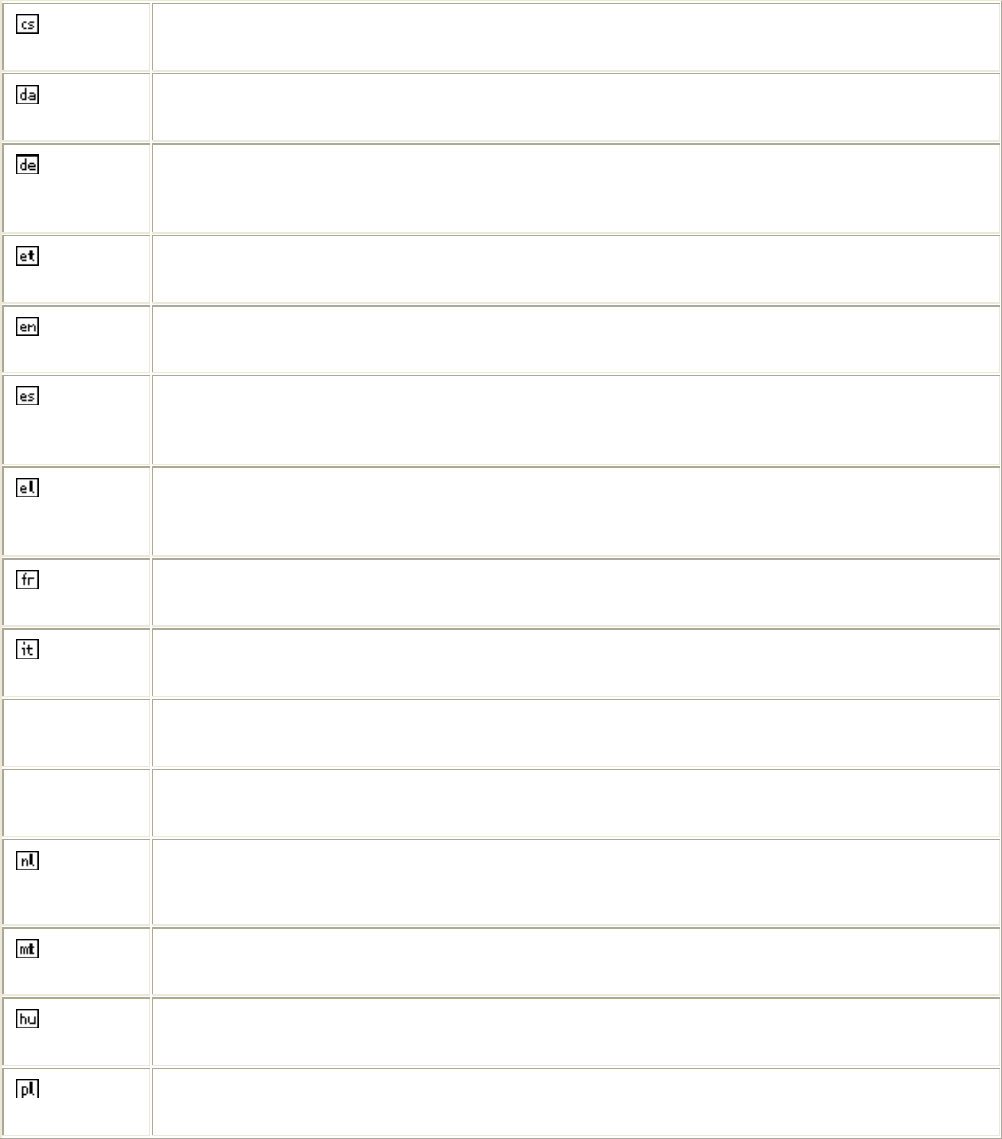
Česky
[Czech]
[D-Link Corporation] tímto prohlašuje, že tento [DSR-500N] je ve shodě se základními
požadavky a dalšími příslušnými ustanoveními směrnice 1999/5/ES.
Dansk
[Danish]
Undertegnede [D-Link Corporation] erklærer herved, at følgende udstyr [DSR-500N] overholder
de væsentlige krav og øvrige relevante krav i direktiv 1999/5/EF.
Deutsch
[German]
Hiermit erklärt [D-Link Corporation], dass sich das Gerät [DSR-500N] in Übereinstimmung mit
den grundlegenden Anforderungen und den übrigen einschlägigen Bestimmungen der Richtlinie
1999/5/EG befindet.
Eesti
[Estonian]
Käesolevaga kinnitab [D-Link Corporation] seadme [DSR-500N] vastavust direktiivi 1999/5/EÜ
põhinõuetele ja nimetatud direktiivist tulenevatele teistele asjakohastele sätetele.
English Hereby, [D-Link Corporation], declares that this [DSR-500N] is in compliance with the essential
requirements and other relevant provisions of Directive 1999/5/EC.
Español
[Spanish]
Por medio de la presente [D-Link Corporation] declara que el [DSR-500N] cumple con los
requisitos esenciales y cualesquiera otras disposiciones aplicables o exigibles de la Directiva
1999/5/CE.
Ελληνική
[Greek]
ΜΕ ΤΗΝ ΠΑΡΟΥΣΑ [D-Link Corporation] ΔΗΛΩΝΕΙ ΟΤΙ [DSR-500N] ΣΥΜΜΟΡΦΩΝΕΤΑΙ
ΠΡΟΣ ΤΙΣ ΟΥΣΙΩΔΕΙΣ ΑΠΑΙΤΗΣΕΙΣ ΚΑΙ ΤΙΣ ΛΟΙΠΕΣ ΣΧΕΤΙΚΕΣ ΔΙΑΤΑΞΕΙΣ ΤΗΣ ΟΔΗΓΙΑΣ
1999/5/ΕΚ.
Français
[French]
Par la présente [D-Link Corporation] déclare que l'appareil [DSR-500N] est conforme aux
exigences essentielles et aux autres dispositions pertinentes de la directive 1999/5/CE.
Italiano
[Italian]
Con la presente [D-Link Corporation] dichiara che questo [DSR-500N] è conforme ai requisiti
essenziali ed alle altre disposizioni pertinenti stabilite dalla direttiva 1999/5/CE.
Latviski
[Latvian]
Ar šo [D-Link Corporation] deklarē, ka [DSR-500N] atbilst Direktīvas 1999/5/EK būtiskajām
prasībām un citiem ar to saistītajiem noteikumiem.
Lietuvių
[Lithuanian]
Šiuo [D-Link Corporation] deklaruoja, kad šis [DSR-500N] atitinka esminius reikalavimus ir kitas
1999/5/EB Direktyvos nuostatas.
Nederlands
[Dutch]
Hierbij verklaart [D-Link Corporation] dat het toestel [DSR-500N] in overeenstemming is met de
essentiële eisen en de andere relevante bepalingen van richtlijn 1999/5/EG.
Malti
[Maltese]
Hawnhekk, [D-Link Corporation], jiddikjara li dan [DSR-500N] jikkonforma mal-ħtiġijiet essenzjali
u ma provvedimenti oħrajn relevanti li hemm fid-Dirrettiva 1999/5/EC.
Magyar
[Hungarian]
Alulírott, [D-Link Corporation] nyilatkozom, hogy a [DSR-500N] megfelel a vonatkozó alapvetõ
követelményeknek és az 1999/5/EC irányelv egyéb elõírásainak.
Polski
[Polish]
Niniejszym [D-Link Corporation] oświadcza, że [DSR-500N] jest zgodny z zasadniczymi
wymogami oraz pozostałymi stosownymi postanowieniami Dyrektywy 1999/5/EC.
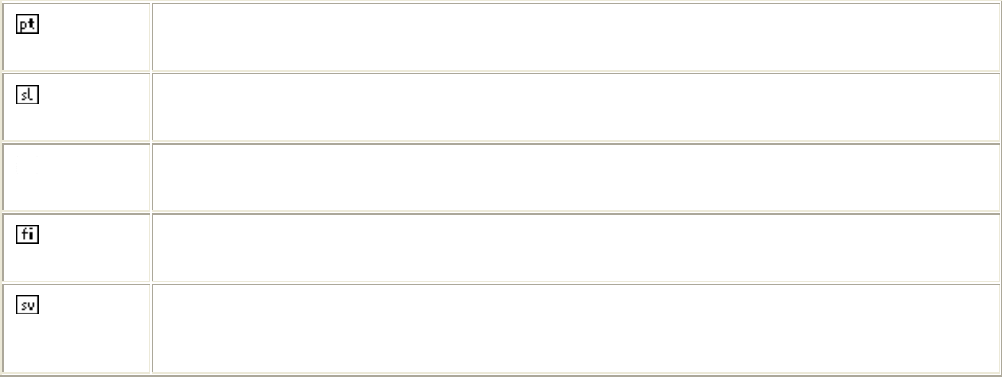
Português
[Portuguese]
[D-Link Corporation] declara que este [DSR-500N]está conforme com os requisitos essenciais
e outras disposições da Directiva 1999/5/CE.
Slovensko
[Slovenian]
[D-Link Corporation] izjavlja, da je ta [DSR-500N] v skladu z bistvenimi zahtevami in ostalimi
relevantnimi določili direktive 1999/5/ES.
Slovensky
[Slovak]
[D-Link Corporation] týmto vyhlasuje, že [DSR-500N] spĺňa základné požiadavky a všetky
príslušné ustanovenia Smernice 1999/5/ES.
Suomi
[Finnish]
[D-Link Corporation] vakuuttaa täten että [DSR-500N] tyyppinen laite on direktiivin 1999/5/EY
oleellisten vaatimusten ja sitä koskevien direktiivin muiden ehtojen mukainen.
Svenska
[Swedish]
Härmed intygar [D-Link Corporation] att denna [DSR-500N] står I överensstämmelse med de
väsentliga egenskapskrav och övriga relevanta bestämmelser som framgår av direktiv
1999/5/EG.